Samsung Electronics Co SCX4729FW Mono Laser Printer User Manual batian basic english
Samsung Electronics Co Ltd Mono Laser Printer batian basic english
Contents
- 1. Users Manual 1
- 2. Users Manual 2
Users Manual 2
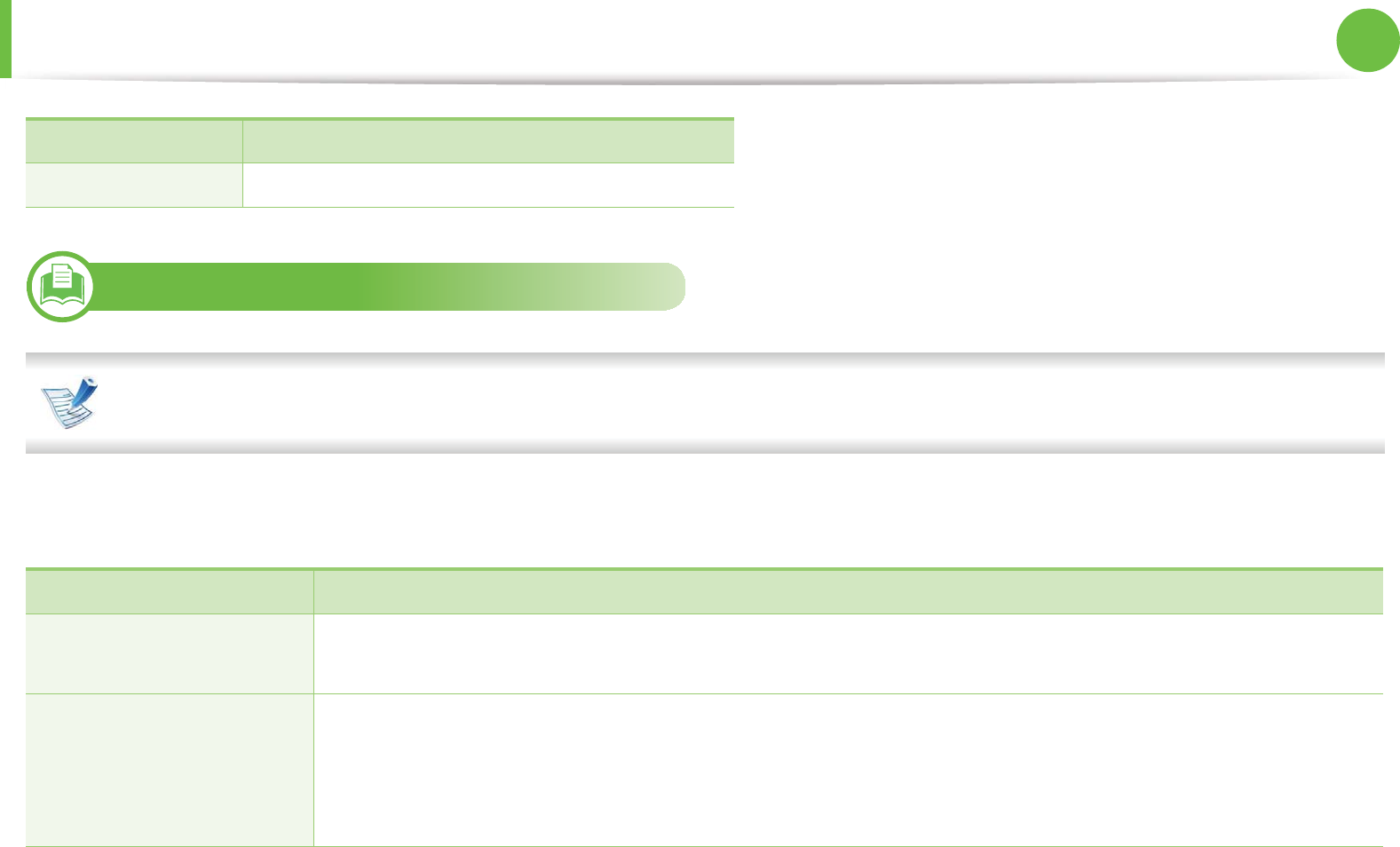
Specifications 101
5. Appendix
4
Network environment
Network and wireless models only (see "Features by models" on page 6)
You need to set up the network protocols on the machine to use it as your network machine. The following table shows the network
environments supported by the machine.
Free HDD space Up to 100 MB
Items Specifications
Network interface • Ethernet 10/100 Base-TX Wired Lan
• 802.11b/g/n Wireless LAN
Network operating system • Windows 2000/Server 2003 /Server 2008/XP/Vista/7/Server 2008 R2
•Various Linux OS
• Mac OS X 10.4 ~ 10.6
•Unix
Items Requirements
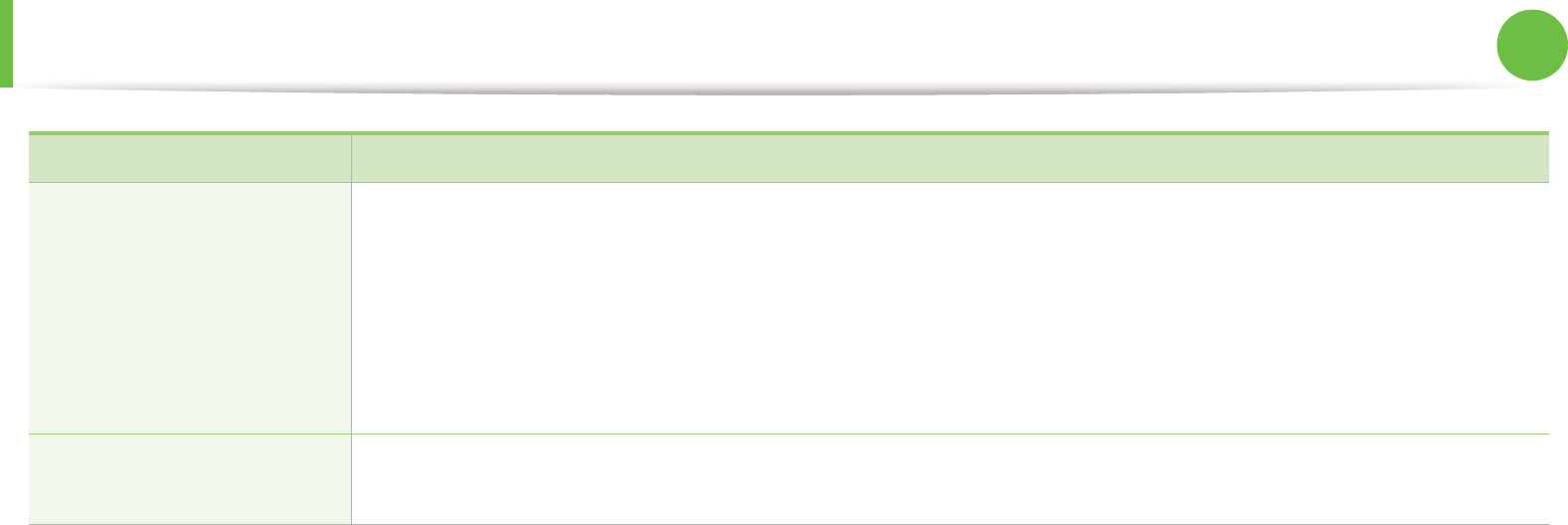
Specifications 102
5. Appendix
Network protocols •TCP/IPv4
• DHCP, BOOTP
• DNS, WINS, Bonjour, SLP, UPnP
• Standard TCP/IP Printing (RAW), LPR, IPP, WSD
• SNMPv 1/2/3, HTTP, IPSec
• TCP/IPv6 (DHCP, DNS, RAW, LPR, SNMPv 1/2/3, HTTP, IPSec)
Wireless security • Authentication: Open System, Shared Key, WPA Personal, WPA2 Personal (PSK)
• Encryption: WEP64, WEP128, TKIP, AES
Items Specifications
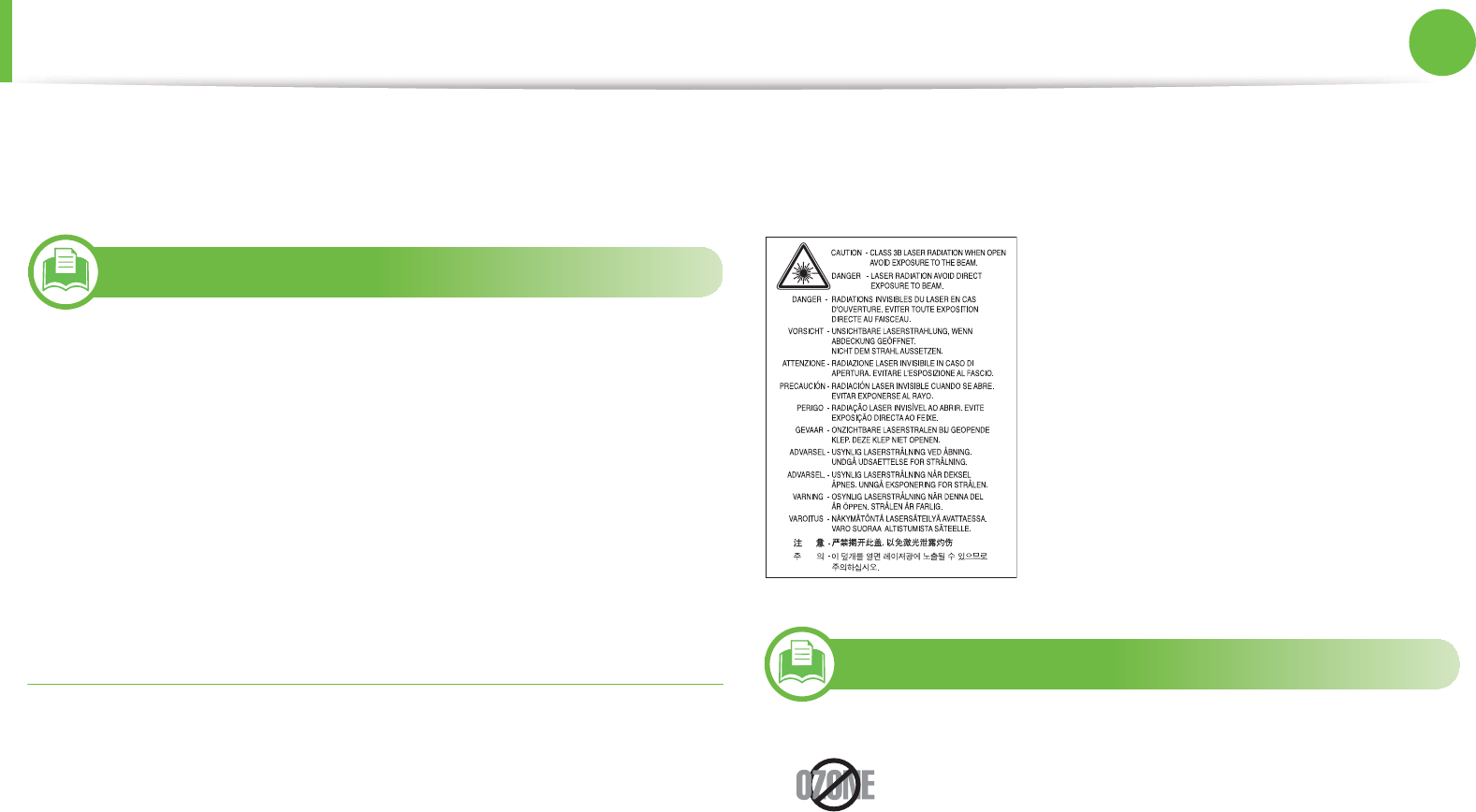
103
5. Appendix
Regulatory information
This machine is designed for a normal work environment and
certified with several regulatory statements.
5
Laser safety statement
The printer is certified in the U.S. to conform to the requirements of
DHHS 21 CFR, chapter 1 Subchapter J for Class I(1) laser products,
and elsewhere is certified as a Class I laser product conforming to the
requirements of IEC 60825-1 : 2007.
Class I laser products are not considered to be hazardous. The laser
system and printer are designed so there is never any human access
to laser radiation above a Class I level during normal operation, user
maintenance or prescribed service condition.
Warning
Never operate or service the printer with the protective cover
removed from laser/scanner assembly. The reflected beam,
although invisible, can damage your eyes.
When using this product, these basic safety precautions should
always be followed to reduce risk of fire, electric shock, and injury to
persons:
6
Ozone safety
This product’s ozone emission rate is under 0.1 ppm.
Because ozone is heavier than air, keep the product in
a place with good ventilation.
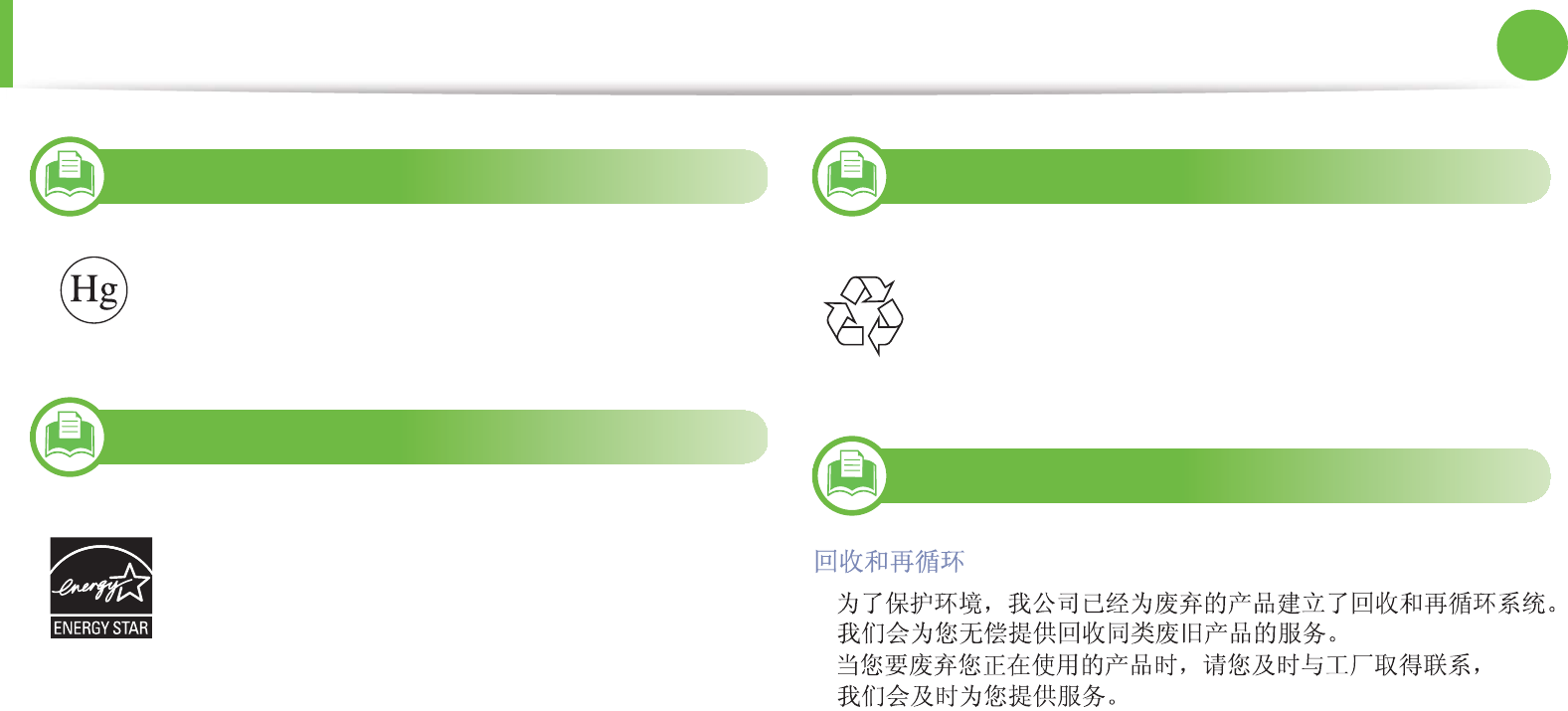
Regulatory information 104
5. Appendix
7
Mercury Safety
8
Power saver
9
Recycling
10
China only
Contains Mercury, Dispose According to Local, State or
Federal Laws.(U.S.A. only)
This printer contains advanced energy conservation
technology that reduces power consumption when it is
not in active use.
When the printer does not receive data for an extended
period of time, power consumption is automatically
lowered.
ENERGY STAR and the ENERGY STAR mark are
registered U.S. marks.
For more information on the ENERGY STAR program
see http://www.energystar.gov
Recycle or dispose of the packaging material for this
product in an environmentally responsible manner.
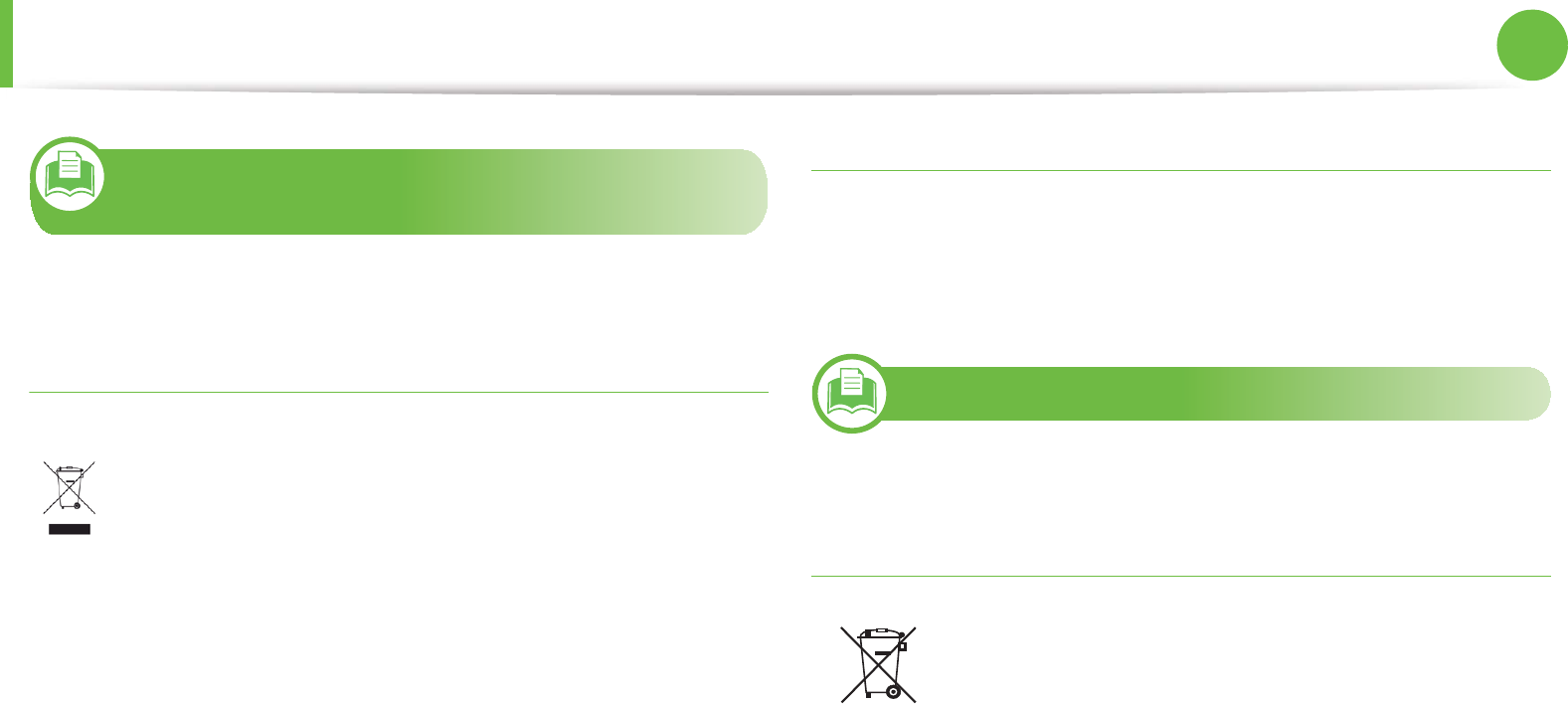
Regulatory information 105
5. Appendix
11
Correct disposal of this product (Waste
electrical & electronic equipment)
(Applicable in the european union and other
european countries with separate collection
systems)
(The United States of America only)
Dispose unwanted electronics through an approved recycler. To find
the nearest recycling location, go to our website:
www.samsung.com/recyclingdirect Or call, (877) 278 - 0799
12
Correct disposal of batteries in this product
(Applicable in the European Union and other
European countries with separate battery return
systems.)
This marking on the product, accessories or literature
indicates that the product and its electronic accessories (e.g.
charger, headset, USB cable) should not be disposed of with
other household waste at the end of their working life. To
prevent possible harm to the environment or human health
from uncontrolled waste disposal, please separate these
items from other s of waste and recycle them responsibly to
promote the sustainable reuse of material resources.
Household users should contact either the retailer where they
purchased this product, or their local government office, for
details of where and how they can take these items for
environmentally safe recycling.
Business users should contact their supplier and check the
terms and conditions of the purchase contract. This product
and its electronic accessories should not be mixed with other
commercial wastes for disposal.
This marking on the battery, manual or packaging
indicates that the batteries in this product should not be
disposed with other household waste at the end of their
working life. Where marked, the chemical symbols Hg, Cd
or Pb indicate that the battery contains mercury, cadmium
or lead above the reference levels in EC Directive 2006/66.
If batteries are not properly disposed of, these substances
can cause harm to human health or the environment. To
protect natural resources and to promote material reuse,
please separate batteries from other s of waste and recycle
them through your local, free battery return system.
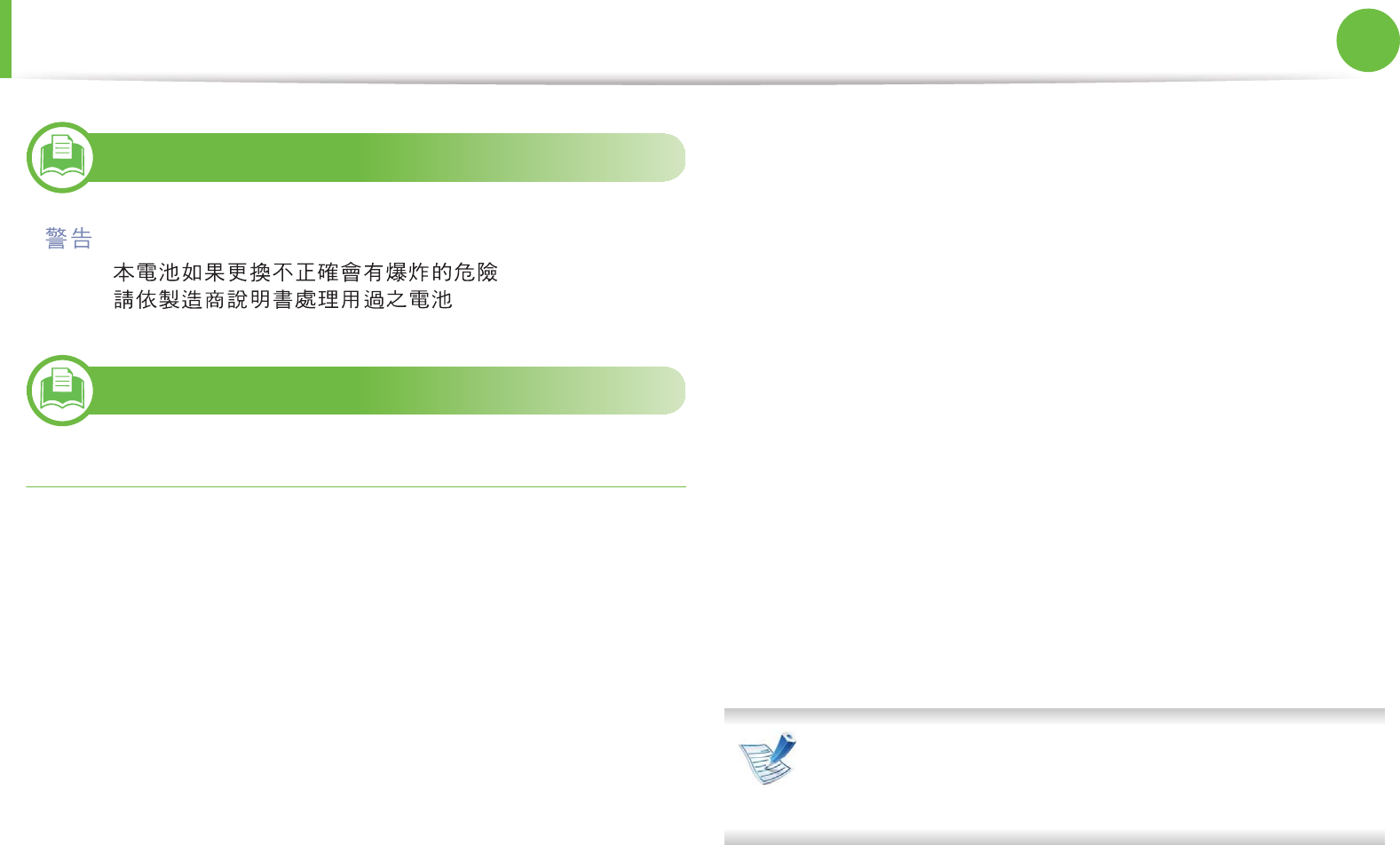
Regulatory information 106
5. Appendix
13
Taiwan only
14
Radio frequency emissions
FCC information to the user
This device complies with Part 15 of the FCC Rules. Operation is
subject to the following two conditions:
• This device may not cause harmful interference, and
• This device must accept any interference received, including
interference that may cause undesired operation.
This equipment has been tested and found to comply with the limits
for a Class B digital device, pursuant to Part 15 of the FCC Rules.
These limits are designed to provide reasonable protection against
harmful interference in a residential installation. This equipment
generates, uses and can radiate radio frequency energy and, if not
installed and used in accordance with the instructions, may cause
harmful interference to radio communications. However, there is no
guarantee that interference will not occur in a particular installation.
If this equipment does cause harmful interference to radio or
television reception, which can be determined by turning the
equipment off and on, the user is encouraged to try to correct the
interference by one or more of the following measures:
• Reorient or relocate the receiving antenna.
• Increase the separation between the equipment and receiver.
• Connect the equipment into an outlet on a circuit different from
that to which the receiver is connected.
• Consult the dealer or experienced radio TV technician for help.
Change or modifications not expressly approved by the
manufacturer responsible for compliance could void the
user's authority to operate the equipment.
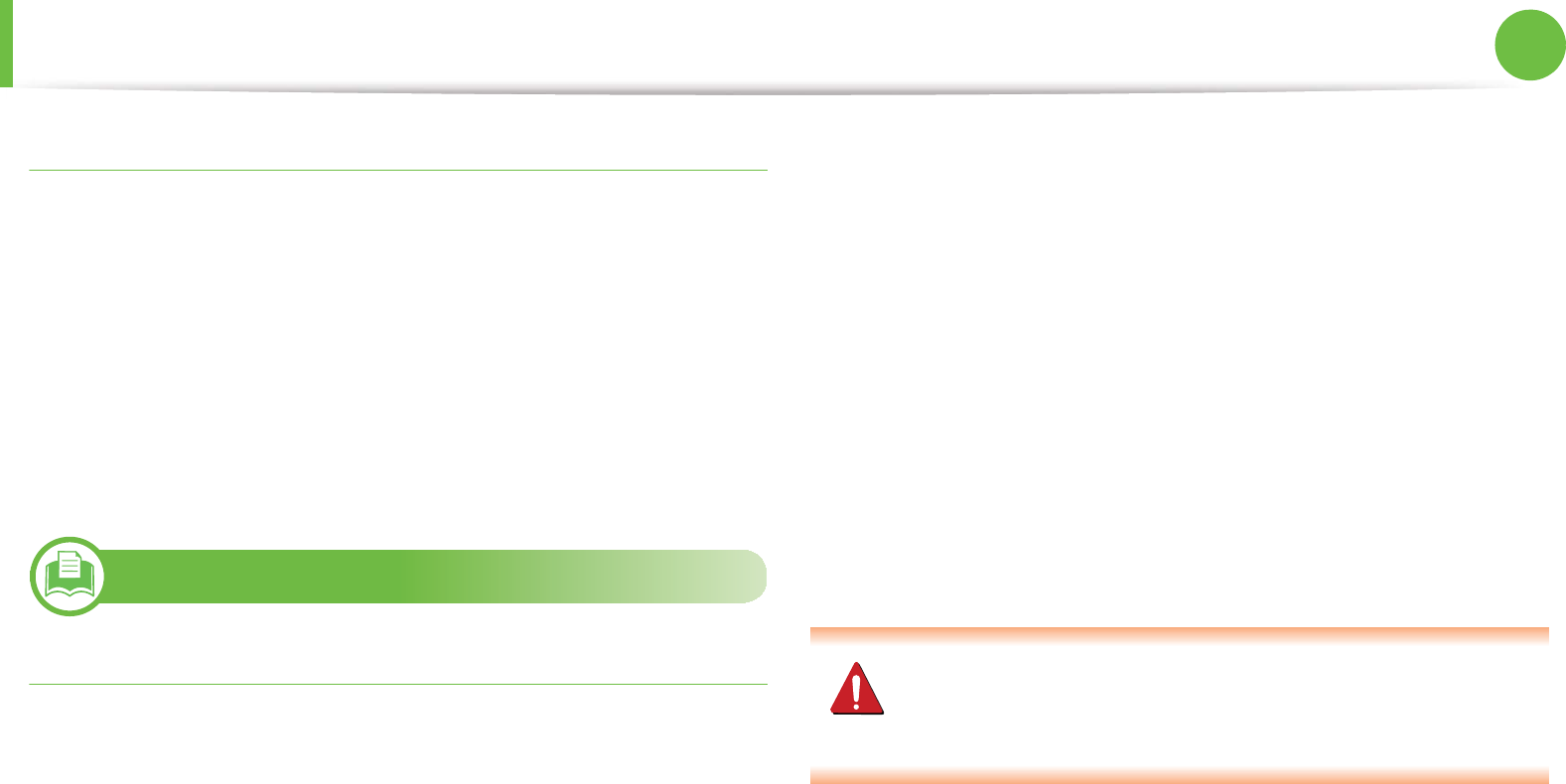
Regulatory information 107
5. Appendix
Canadian radio interference regulations
This digital apparatus does not exceed the Class B limits for radio
noise emissions from digital apparatus as set out in the interference-
causing equipment standard entitled “Digital Apparatus”, ICES-003
of the Industry and Science Canada.
Cet appareil numérique respecte les limites de bruits
radioélectriques applicables aux appareils numériques de Classe B
prescrites dans la norme sur le matériel brouilleur: “Appareils
Numériques”, ICES-003 édictée par l’Industrie et Sciences Canada.
15
United States of America
Federal Communications Commission (FCC)
ŹIntentional emitter per FCC Part 15
Low power, Radio LAN devices (radio frequency (RF) wireless
communication devices), operating in the 2.4 GHz/5 GHz Band, may
be present (embedded) in your printer system. This section is only
applicable if these devices are present. Refer to the system label to
verify the presence of wireless devices.
Wireless devices that may be in your system are only qualified for use
in the United States of America if an FCC ID number is on the system
label.
The FCC has set a general guideline of 20 cm (8 inches) separation
between the device and the body, for use of a wireless device near
the body (this does not include extremities). This device should be
used more than 20 cm (8 inches) from the body when wireless
devices are on. The power output of the wireless device (or devices),
which may be embedded in your printer, is well below the RF
exposure limits as set by the FCC.
This transmitter must not be collocated or operation in conjunction
with any other antenna or transmitter.
Operation of this device is subject to the following two conditions:
(1) This device may not cause harmful interference, and (2) this
device must accept any interference received, including interference
that may cause undesired operation of the device.
Wireless devices are not user serviceable. Do not modify
them in any way. Modification to a wireless device will void
the authorization to use it. Contact manufacturer for service.
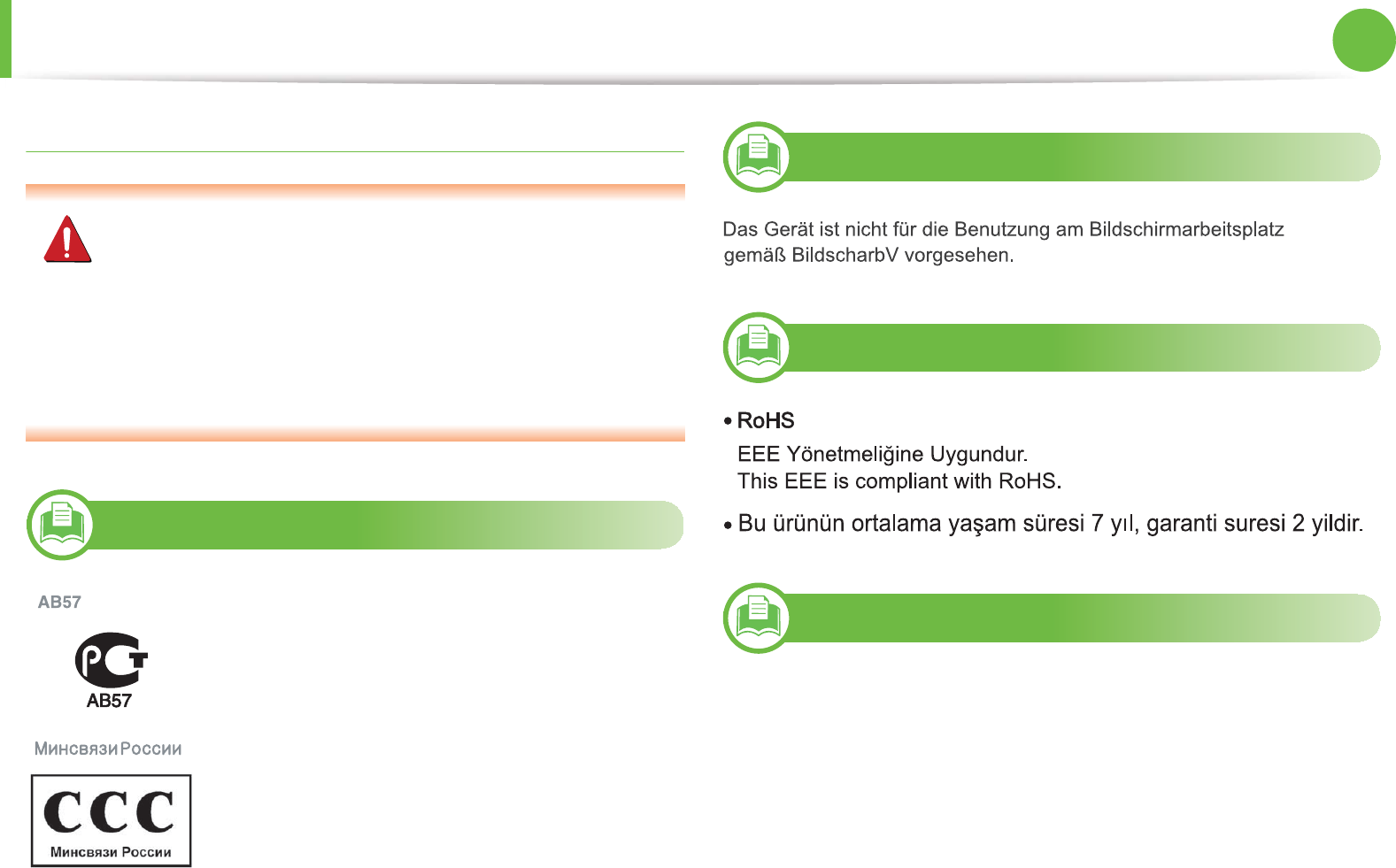
Regulatory information 108
5. Appendix
FCC Statement for Wireless LAN use:
While installing and operating this transmitter and antenna
combination the radio frequency exposure limit of 1m W/
cm2 may be exceeded at distances close to the antenna
installed. Therefore, the user must maintain a minimum
distance of 20cm from the antenna at all times. This device
cannot be colocated with another transmitter and
transmitting antenna.
16
Russia only
17
Germany only
18
Turkey only
19
Canada only
This product meets the applicable Industry Canada technical
specifications. / Le present materiel est conforme aux specifications
techniques applicables d’Industrie Canada.

Regulatory information 109
5. Appendix
The Ringer Equivalence Number (REN) is an indication of the
maximum number of devices allowed to be connected to a
telephone interface. The termination of an interface may consist of
any combination of devices subject only to the requirement that the
sum of the RENs of all the devices not exceed five. / L’indice
d’equivalence de la sonnerie (IES) sert a indiquer le nombre maximal
de terminaux qui peuvent etre raccordes a une interface
telephonique. La terminaison d’une interface peut consister en une
combinaison quelconque de dispositifs, a la seule condition que la
somme d’indices d’equivalence de la sonnerie de tous les dispositifs
n’excede pas cinq.
20
Fax Branding
The Telephone Consumer Protection Act of 1991 makes it unlawful
for any person to use a computer or other electronic device to send
any message via a telephone facsimile machine unless such message
clearly contains in a margin at the top or bottom of each transmitted
page or on the first page of the transmission the following
information:
1 the date and time of transmission
2 identification of either business, business entity or individual
sending the message; and
3 telephone number of either the sending machine, business,
business entity or individual.
The Telephone Company may make changes in its communications
facilities, equipment operations or procedures where such action is
reasonably required in the operation of its business and is not
inconsistent with the rules and regulations in FCC Part 68. If such
changes can be reasonably expected to render any customer
terminal equipment incompatible with telephone company
communications facilities, or require modification or alteration of
such terminal equipment, or otherwise materially affect its use or
performance, the customer shall be given adequate notice in
writing, to allow the customer an opportunity to maintain
uninterrupted service
21
Ringer Equivalence Number
The Ringer Equivalence Number and FCC Registration Number for
this machine may be found on the label located on the bottom or
rear of the machine. In some instances you may need to provide
these numbers to the telephone company.
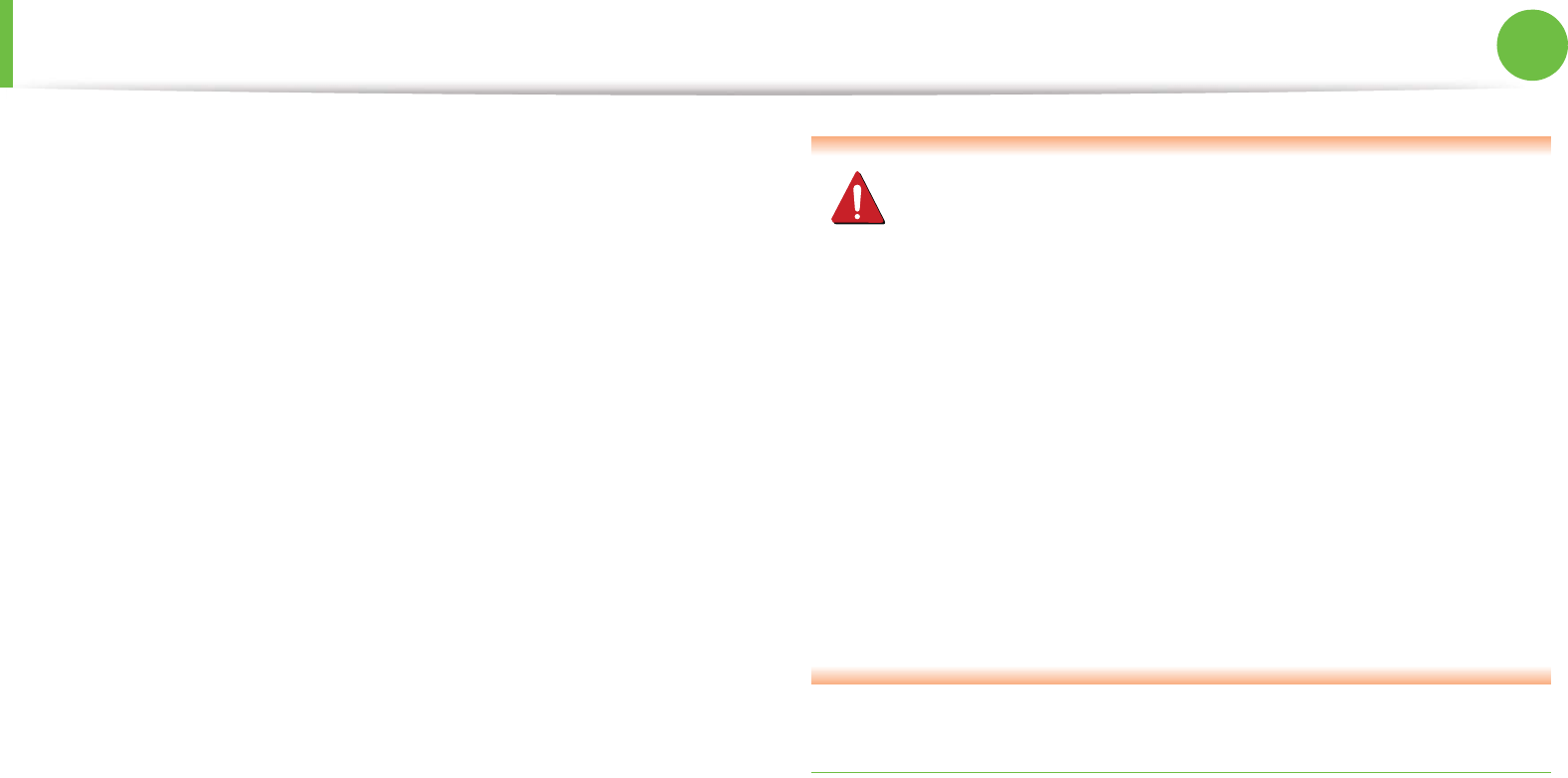
Regulatory information 110
5. Appendix
The Ringer Equivalence Number (REN) is a measure of the electrical
load placed on the telephone line, and is useful for determining
whether you have “overloaded” the line. Installing several s of
equipment on the same telephone line may result in problems
making and receiving telephone calls, especially ringing when your
line is called. The sum of all Ringer Equivalence Numbers of the
equipment on your telephone line should be less than five in order
to assure proper service from the telephone company. In some cases,
a sum of five may not be usable on your line. If any of your telephone
equipment is not operating properly, you should immediately
remove it from your telephone line, as it may cause harm to the
telephone network.
The equipment complies with Part 68 of the FCC rules and the
requirements adopted by the ACTA. On the rear of this equipment is
a label that contains, among other information, a product identifier
in the format US:AAAEQ##TXXXX. If requested, this number must be
provided to the telephone company.
FCC Regulations state that changes or modifications to this
equipment not expressly approved by the manufacturer
could void the user’s authority to operate this equipment. In
the event that terminal equipment causes harm to the
telephone network, the telephone company should notify
the customer that service may be stopped. However, where
prior notice is impractical, the company may temporarily
cease service, providing that they:
a promptly notify the customer.
b give the customer an opportunity to correct the
equipment problem.
c inform the customer of the right to bring a complaint to
the Federal Communication Commission pursuant to
procedures set out in FCC Rules and Regulations Subpart E
of Part 68.
You should also know that:
• Your machine is not designed to be connected to a digital PBX
system.
• If you intend to use a computer modem or fax modem on the
same phone line as your machine, you may experience
transmission and reception problems with all the equipment. It is
recommended that no other equipment, except for a regular
telephone, share the line with your machine.
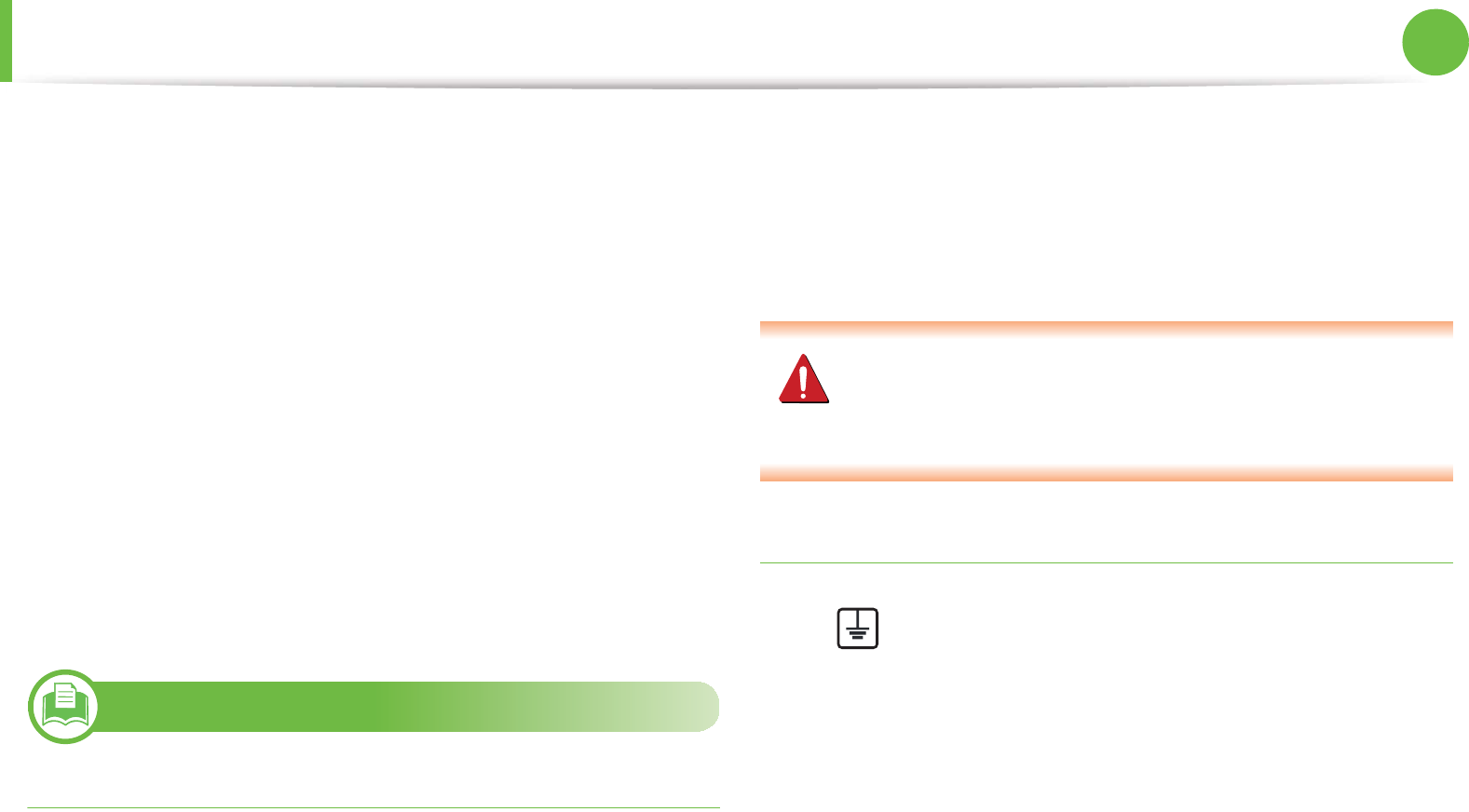
Regulatory information 111
5. Appendix
• If your area experiences a high incidence of lightning or power
surges, we recommend that you install surge protectors for both
the power and the telephone lines. Surge protectors can be
purchased from your dealer or telephone and electronic
specialty stores.
• When programming emergency numbers and/or making test
calls to emergency numbers, use a non-emergency number to
advise the emergency service dispatcher of your intentions. The
dispatcher will give you further instructions on how to actually
test the emergency number.
• This machine may not be used on coin service or party lines.
• This machine provides magnetic coupling to hearing aids.
You may safely connect this equipment to the telephone network by
means of a standard modular jack, USOC RJ-11C.
22
Replacing the Fitted Plug (for UK Only)
Important
The mains lead for this machine is fitted with a standard (BS 1363) 13
amp plug and has a 13 amp fuse. When you change or examine the
fuse, you must re-fit the correct 13 amp fuse. You then need to
replace the fuse cover. If you have lost the fuse cover, do not use the
plug until you have another fuse cover.
Contact the people from you purchased the machine.
The 13 amp plug is the most widely used in the UK and should be
suitable. However, some buildings (mainly old ones) do not have
normal 13 amp plug sockets. You need to buy a suitable plug
adaptor. Do not remove the moulded plug.
If you cut off the moulded plug, get rid of it straight away.
You cannot rewire the plug and you may receive an electric
shock if you plug it into a socket.
Important warning:
If the wires in the mains lead do not match the colors marked in your
plug, do the following:
You must connect the green and yellow wire to the pin marked by
the letter “E” or by the safety ‘Earth symbol’ or colored green and
yellow or green.
You must earth this machine.
The wires in the mains lead have the following color code:
•Green and Yellow: Earth
•Blue: Neutral
•Brown: Live
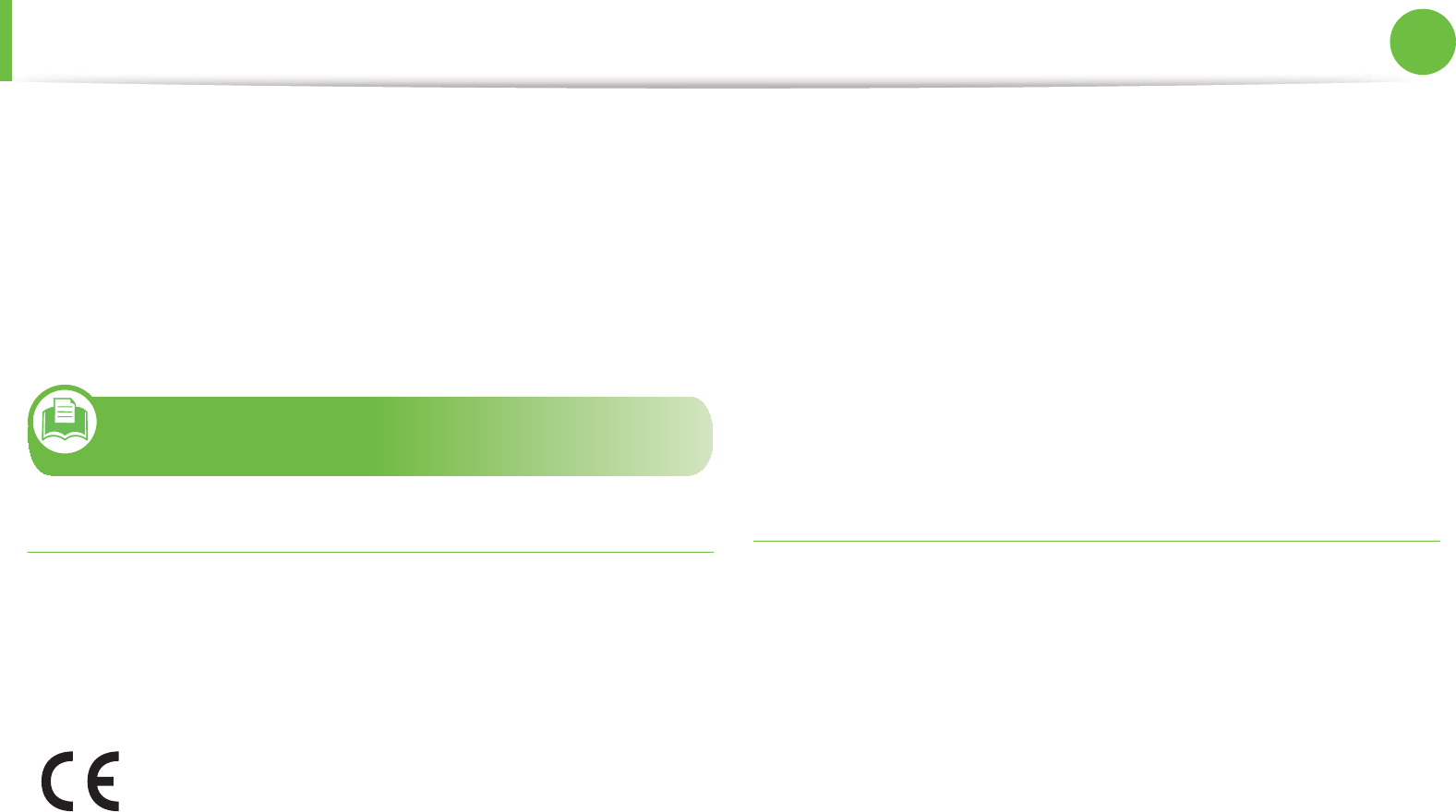
Regulatory information 112
5. Appendix
You must connect the blue wire to the pin which is marked with the
letter “N” or colored black.
You must connect the brown wire to the pin which is marked with
the letter “L” or colored red.
You must have a 13 amp fuse in the plug, adaptor, or at the
distribution board.
23
Declaration of conformity (European
countries)
Approvals and Certifications
January 1, 1995: Council Directive 2006/95/EC Approximation of
the laws of the member states related to low voltage equipment.
January 1, 1996: Council Directive 2004/108/EC, approximation of
the laws of the Member States related to electromagnetic
compatibility.
March 9, 1999: Council Directive 1999/5/EC on radio equipment
and telecommunications terminal equipment and the mutual
recognition of their conformity. A full declaration, defining the
relevant Directives and referenced standards can be obtained from
your Samsung Electronics Co., Ltd. representative.
EC Certification
Certification to 1999/5/EC Radio Equipment & Telecommunications
Terminal Equipment Directive (FAX)
This Samsung product has been self-certified by Samsung for pan-
European single terminal connection to the analogue public
switched telephone network (PSTN) in accordance with Directive
1999/5/EC. The product has been designed to work with the national
PSTNs and compatible PBXs of the European countries:
In the event of problems, you should contact the Euro QA Lab of
Samsung Electronics Co., Ltd. in the first instance.
• Hereby, Samsung Electronics, declares that this [SCX-
472xFD Series, SCX-472xFH Series] is in compliance with
the essential requirements and other relevant provisions
of R&TTE Directive 1999/5/EC.
• Hereby, Samsung Electronics, declares that this [SCX-
472xFW Series] is in compliance with the essential
requirements and other relevant provisions of R&TTE
Directive 1999/5/EC.
The declaration of conformity may be consulted at
www.samsung.com/printer, go to Support > Download
center and enter your printer (MFP) name to browse the
EuDoC.
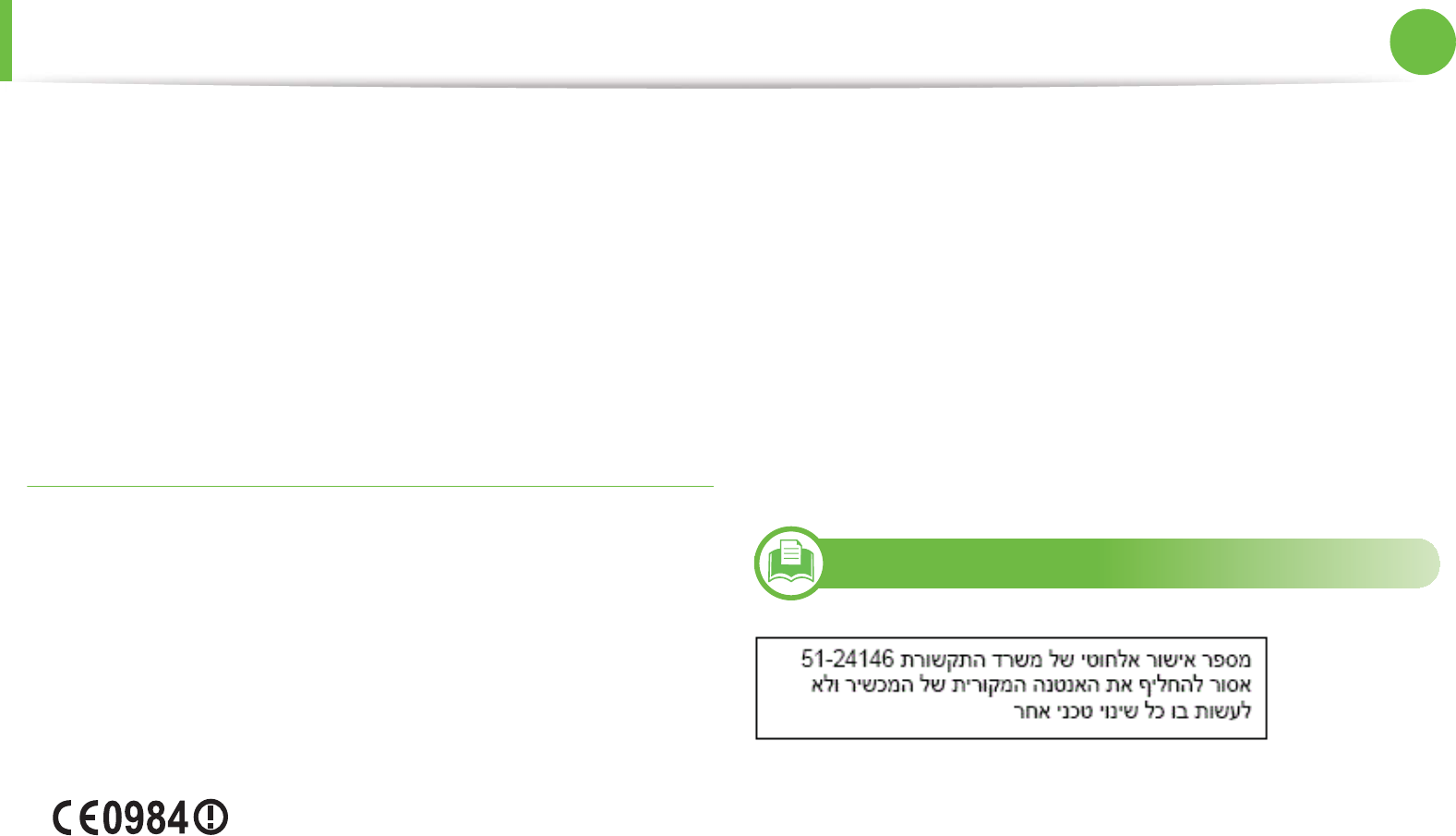
Regulatory information 113
5. Appendix
The product has been tested against TBR21. To assist in the use and
application of terminal equipment which complies with this
standard, the European Telecommunication Standards Institute
(ETSI) has issued an advisory document (EG 201 121) which contains
notes and additional requirements to ensure network compatibility
of TBR21 terminals. The product has been designed against, and is
fully compliant with, all of the relevant advisory notes contained in
this document.
European radio approval information (for products
fitted with EU-approved radio devices)
Low power, Radio LAN type devices (radio frequency (RF) wireless
communication devices), operating in the 2.4 GHz/5 GHz band, may
be present (embedded) in your printer system which is intended for
home or office use. This section is only applicable if these devices are
present. Refer to the system label to verify the presence of wireless
devices.
The power output of the wireless device or devices that may be
embedded in you printer is well below the RF exposure limits as set
by the European Commission through the R&TTE directive.
ŹEuropean states qualified under wireless approvals:
EU countries
ŹEuropean states with restrictions on use:
EU
In France, the frequency range is restricted to 2454-2483.5 MHz for
devices above 10 mW transmitting power such as wireless
EEA/EFTA countries
No limitations at this time
24
Israel only
Wireless devices that may be in your system are
only qualified for use in the European Union or
associated areas if a CE mark with a Notified
Body Registration Number and the Alert
Symbol is on the system label.
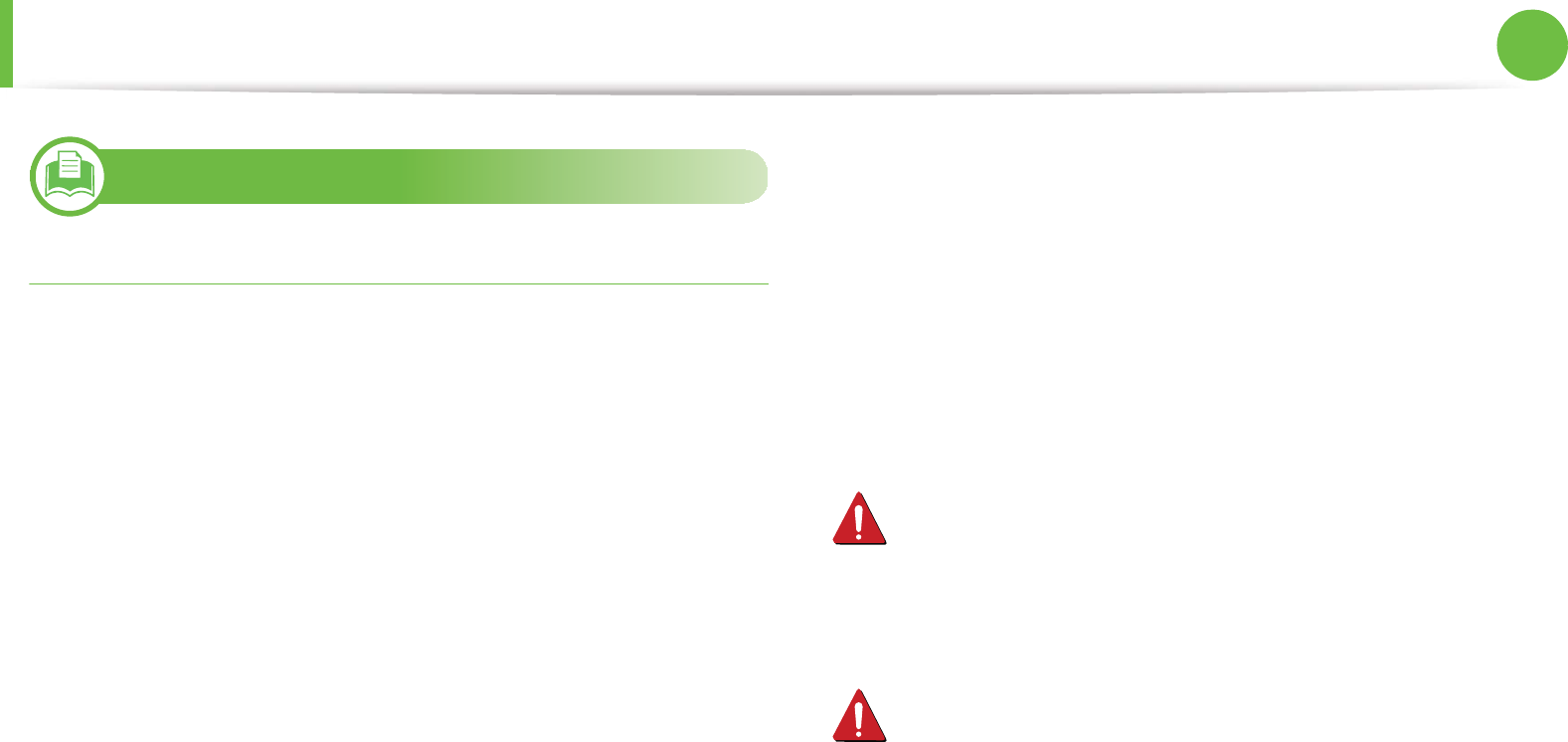
Regulatory information 114
5. Appendix
25
Regulatory compliance statements
Wireless guidance
Low power, Radio LAN devices (radio frequency (RF) wireless
communication devices), operating in the 2.4 GHz/5 GHz Band, may
be present (embedded) in your printer system. The following section
is a general overview of considerations while operating a wireless
device.
Additional limitations, cautions, and concerns for specific countries
are listed in the specific country sections (or country group sections).
The wireless devices in your system are only qualified for use in the
countries identified by the Radio Approval Marks on the system
rating label. If the country you will be using the wireless device in, is
not listed, contact your local Radio Approval agency for
requirements. Wireless devices are closely regulated and use may
not be allowed.
The power output of the wireless device or devices that may be
embedded in your printer is well below the RF exposure limits as
known at this time. Because the wireless devices (which may be
embedded into your printer) emit less energy than is allowed in
radio frequency safety standards and recommendations,
manufacturer believes these devices are safe for use. Regardless of
the power levels, care should be taken to minimize human contact
during normal operation.
As a general guideline, a separation of 20 cm (8 inches) between the
wireless device and the body, for use of a wireless device near the
body (this does not include extremities) is typical. This device should
be used more than 20 cm (8 inches) from the body when wireless
devices are on and transmitting.
This transmitter must not be collocated or operation in conjunction
with any other antenna or transmitter.
Some circumstances require restrictions on wireless devices.
Examples of common restrictions are listed below:
Radio frequency wireless communication can interfere with
equipment on commercial aircraft. Current aviation
regulations require wireless devices to be turned off while
traveling in an airplane. IEEE 802.11 (also known as wireless
Ethernet) and Bluetooth communication devices are
examples of devices that provide wireless communication.
In environments where the risk of interference to other
devices or services is harmful or perceived as harmful, the
option to use a wireless device may be restricted or
eliminated. Airports, Hospitals, and Oxygen or flammable gas
laden atmospheres are limited examples where use of
wireless devices may be restricted or eliminated. When in
environments where you are uncertain of the sanction to use
wireless devices, ask the applicable authority for
authorization prior to use or turning on the wireless device.
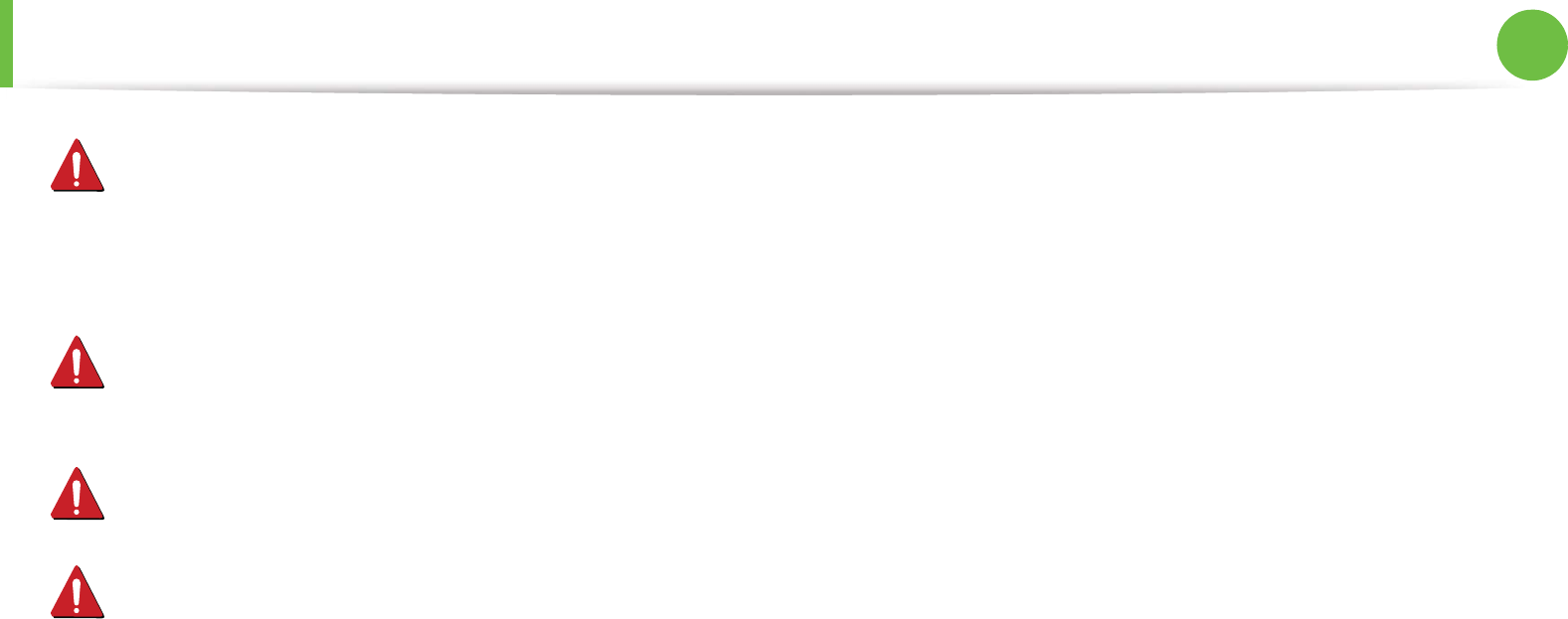
Regulatory information 115
5. Appendix
Every country has different restrictions on the use of wireless
devices. Since your system is equipped with a wireless device,
when traveling between countries with your system, check
with the local Radio Approval authorities prior to any move or
trip for any restrictions on the use of a wireless device in the
destination country.
If your system came equipped with an internal embedded
wireless device, do not operate the wireless device unless all
covers and shields are in place and the system is fully
assembled.
Wireless devices are not user serviceable. Do not modify them
in any way. Modification to a wireless device will void the
authorization to use it. Contact manufacturer for service.
Only use drivers approved for the country in which the device
will be used. See the manufacturer System Restoration Kit, or
contact manufacturer Technical Support for additional
information.
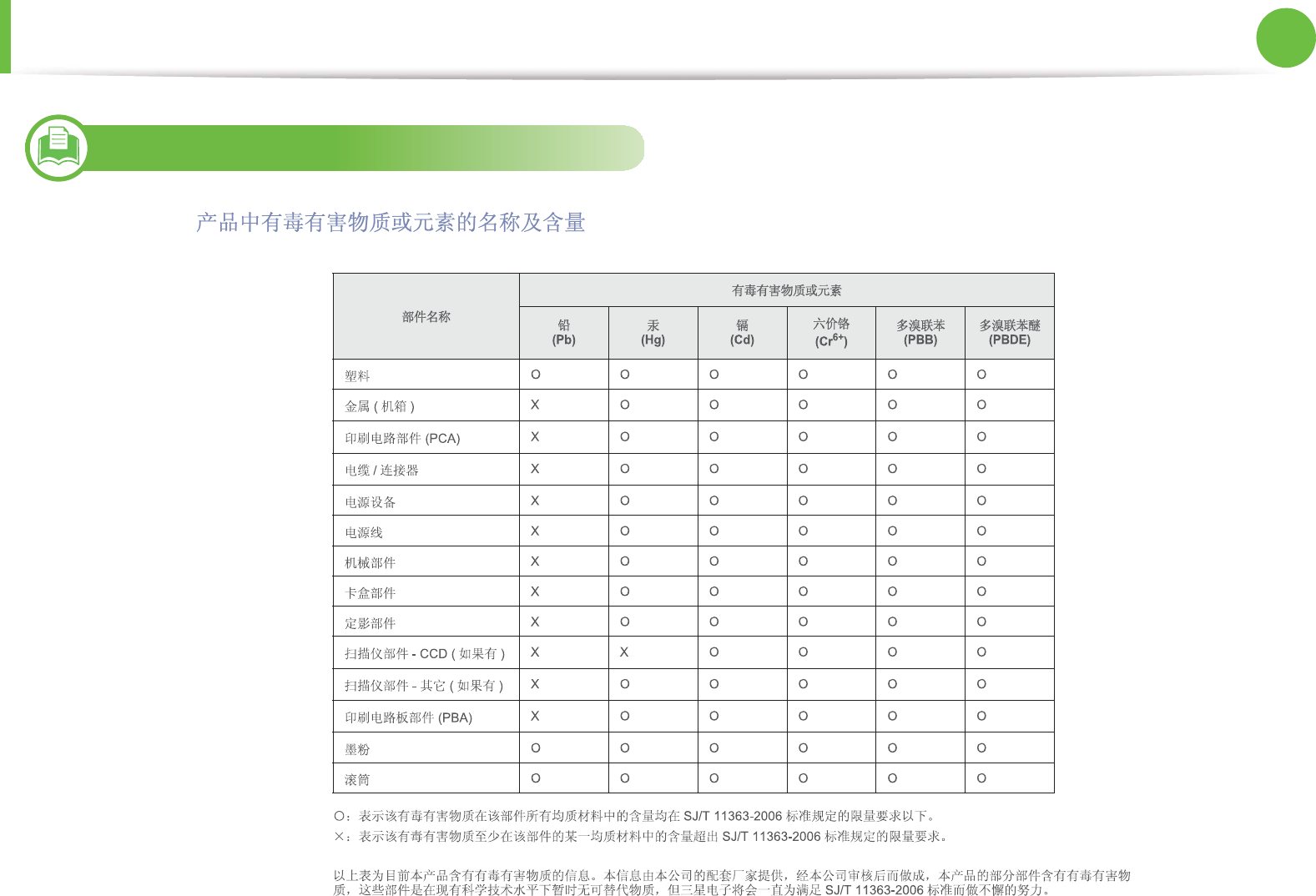
Regulatory information 116
5. Appendix
26
China only

117
5. Appendix
Copyright
© 2010 Samsung Electronics Co., Ltd. All rights reserved.
This user’s guide is provided for information purposes only. All information included herein is subject to change without notice.
Samsung Electronics is not responsible for any direct or indirect damages, arising from or related to use of this user’s guide.
• Samsung and the Samsung logo are trademarks of Samsung Electronics Co., Ltd.
• Microsoft, Windows, Windows Vista, Windows 7, and Windows Server 2008 R2 are either registered trademarks or trademarks of Microsoft
Corporation.
• True, LaserWriter, and Macintosh are trademarks of Apple Computer, Inc.
• All other brand or product names are trademarks of their respective companies or organizations.
Refer to the 'LICENSE.txt' file in the provided CD-ROM for the open source license information.
REV. 0.98

118
Index
C
cleaning
insideG70
outsideG70
pickup rollerG72
scan unitG73
cleaning a machineG70
control panelG19
conventionG8
copy buttonG19
copying
basic copyingG52
reducing or enlarging copiesG53
D
default settings
tray settingG42
E
eco printingG49
error messageG87
F
favorites settings, for printingG48
fax sending
multi sendingG58
faxing
adjusting darknessG60
adjusting resolutionG59
preparing to faxG57
receiving in Fax modeG59
featuresG4
print media featureG95
front viewG16
G
general iconsG8
I
id copyG54
ID copy buttonG19
J
jam
clearing original documentG76
clearing paperG80
tips for avoiding paper jamsG75
L
Linux
system requirementsG100
loading
paper in manual feeder/multi-purpose trayG
35
paper in the tray1G34
special mediaG36
loading originalsG43
M
Macintosh
system requirementsG99
maintenance partsG64
manual feeder/multi-purpose tray
loadingG35
menu overviewG25
multi-purpose tray
tips on usingG35
using special mediaG36
N
network
installing environmentG101
numeric keypadG19
O
on hook dial buttonG20
optional tray

Index 119
loading paperG34
P
preparing originals typeG42
print media
card stockG41
envelopeG38
labelsG40
output supportG95
preprinted paperG41
setting the paper sizeG42
setting the paper typeG42
special mediaG36
transparencyG39
PrintingG46
printing
printing a document
WindowsG46
R
rear viewG18
redial/pause buttonG20
regulatiory informationG103
resolution
faxingG59
S
safety
informationG9
symbolsG9
scan buttonG20
scanning
for local connectionG56
specificationsG93
print mediaG95
start buttonG20
statusG20
stop/clear buttonG20
supplies
available suppliesG63
monitoring the supplies lifeG68
orderingG63
replacing toner cartridgeG66
T
toner cartridge
redistributing tonerG65
replacing the cartridgeG66
tray
adjusting the width and lengthG32
changing the tray sizeG32
loading paper in manual
feeder/multi-purpose trayG35
setting the paper size and typeG42
U
understanding the status LEDG85
Unix
system requirementsG100
USB cable
driver installationG22SG23
using helpG49
W
Windows
driver installation for USB cable connectedG
22SG 23
system requirementsG98

SCX-472x Series
User’s Guide
Advanced
imagine the possibilities
This guide provides information about installation, advanced configuration, operation and
troubleshooting on various OS environments.
Some features may not be available depending on models or countries.
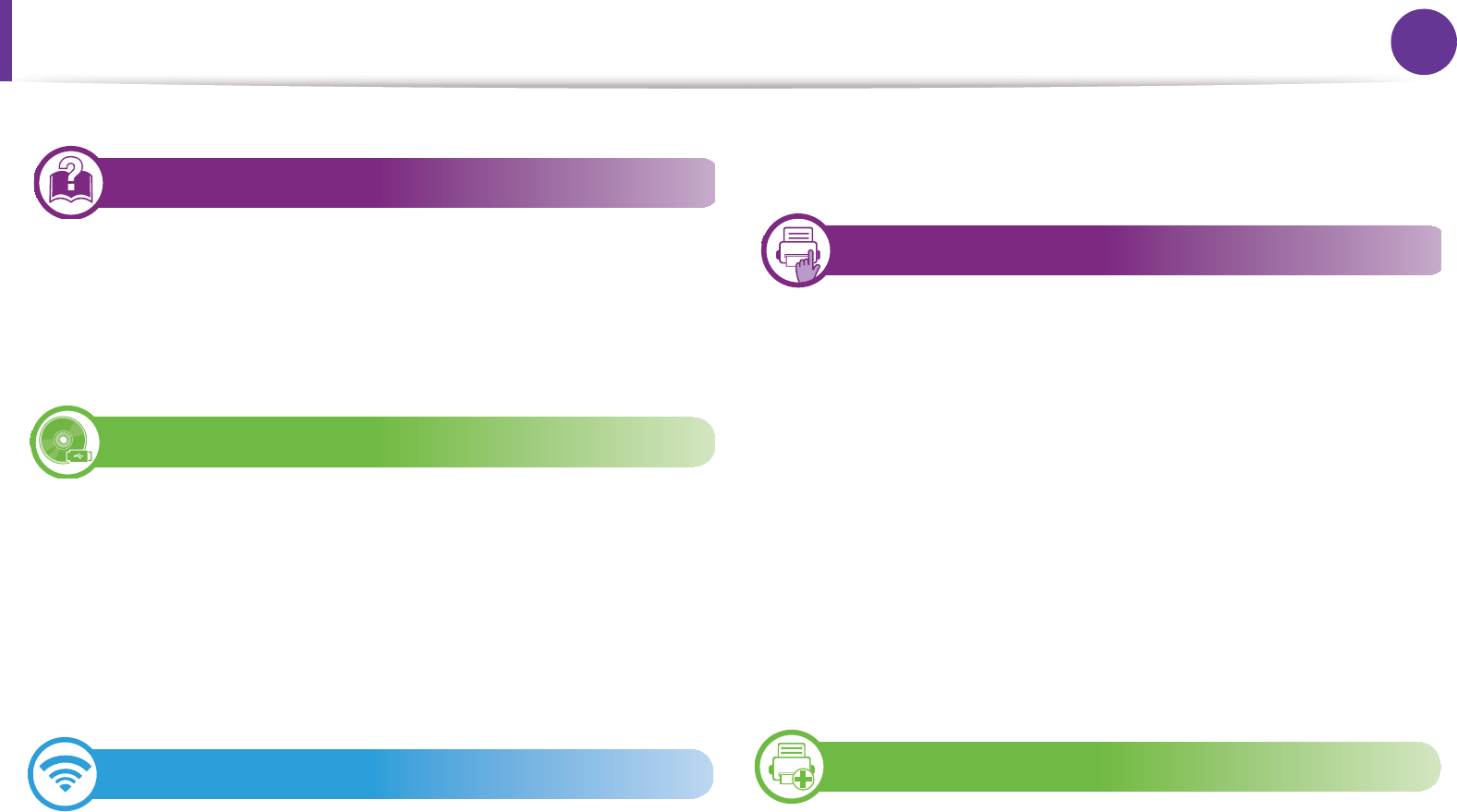
2
Contents
1. Software installation
5Installation for Macintosh
7Reinstallation for Macintosh
8Installation for Linux
10 Reinstallation for Linux
2. Using a network-connected
machine
12 Useful network programs
13 Wired network setup
17 Installing driver over the network
28 IPv6 configuration
31 Wireless network setup
3. Useful setting menus
60 Print menu
61 Copy menu
66 Fax menu
69 Scan menu
71 System setup
82 Admin setup
83 Custom setup
4. Special features
85 Altitude adjustment
86 Changing the font setting
87 Storing email address
89 Entering various characters
90 Setting up the address book
93 Registering authorized users
94 Printing features
111 Fax features
114 Scan features
123 Using shared folder features
124 Using memory/hard drive features
5. Maintenance
126 Storing the toner cartridge
128 Tips for moving & storing your machine
129 Useful management tools
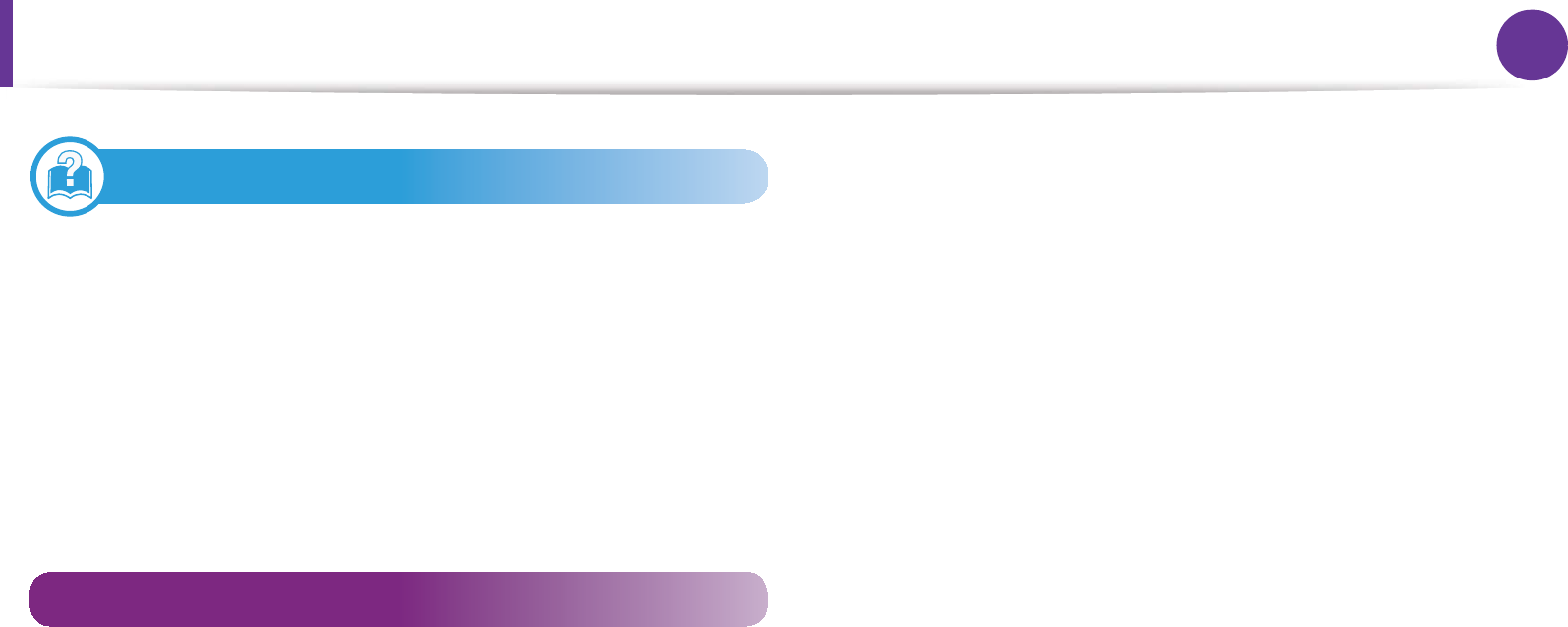
Contents 3
6. Troubleshooting
143 Paper feeding problems
144 Power and cable connecting problems
145 Printing problems
149 Printing quality problems
157 Copying problems
158 Scanning problems
160 Faxing problems
162 Operating system problems
Contact SAMSUNG worldwide
Glossary
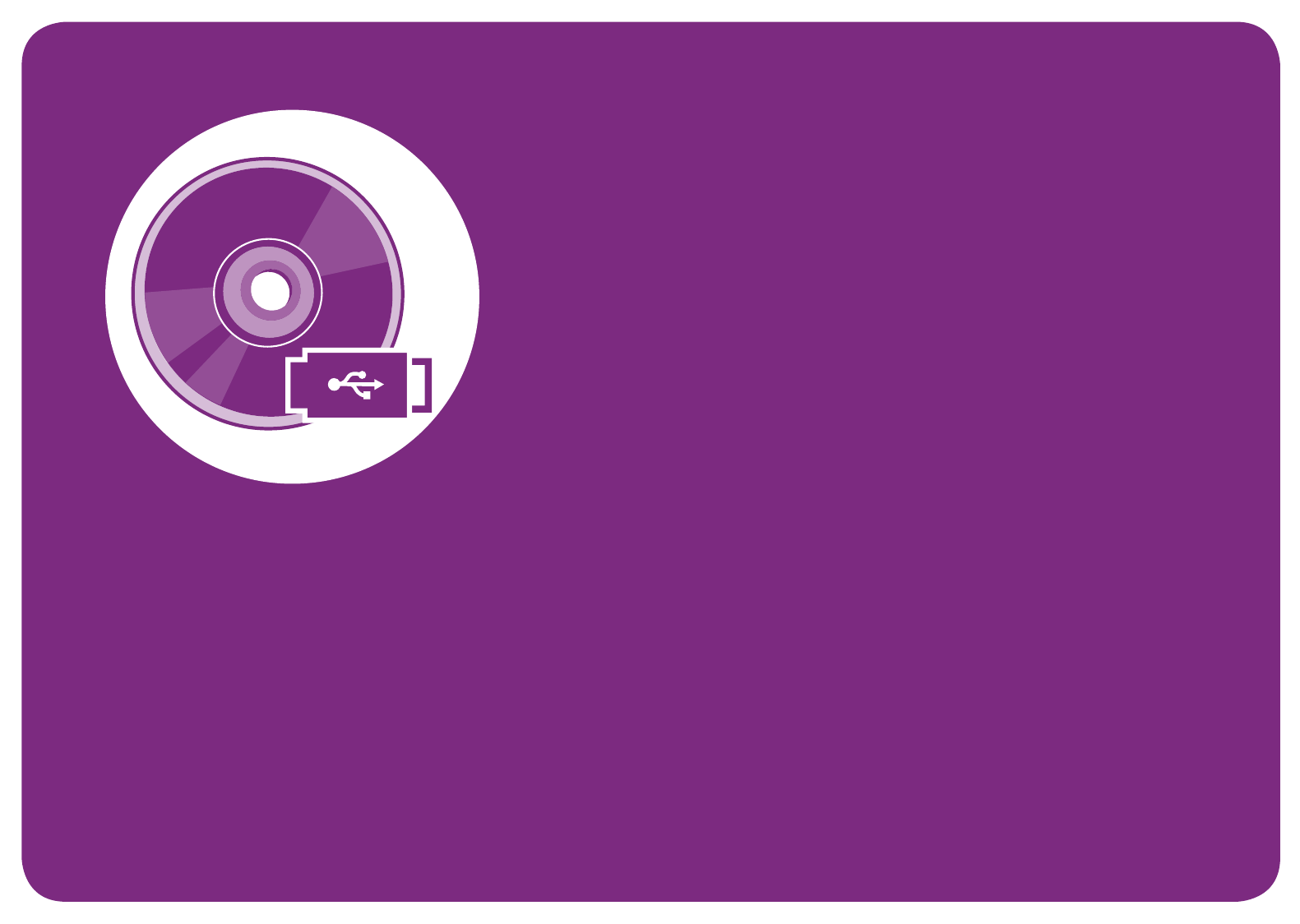
1. Software installation
This chapter provides instructions for installing essential and helpful software
for use in an environment where the machine is connected via a cable. A locally
connected machine is a machine directly attached to your computer using the
cable. If your machine is attached to a network, skip the following steps below
and go on to installing a network connected machine’s driver (see "Installing
driver over the network" on page 17).
• Installation for Macintosh 5
• Reinstallation for Macintosh 7
• Installation for Linux 8
• Reinstallation for Linux 10
• If you are a Windows OS user, refer to the Basic Guide for installing the
machine’s driver.
• Only use a USB cable no longer then 3 meter (118 inches).

5
1. Software installation
Installation for Macintosh
1Make sure that the machine is connected to your computer
and powered on.
2 Insert the supplied software CD into your CD-ROM drive.
3 Double-click the CD-ROM icon that appears on your
Macintosh desktop.
4 Double-click the MAC_Installer folder > Installer OS X icon.
5 Click Continue.
6 Read the license agreement and click Continue.
7 Click Agree to agree to the license agreement.
8 When the message that warns that all applications will close
on your computer appears, click Continue.
9 Click Continue on the User Options Pane.
10 Click Install. All components necessary for machine
operations will be installed.
If you click Customize, you can choose individual
components to install.
11 Enter the password and click OK.
12 Installing software requires you to restart your computer. Click
Continue Installation.
13 After the installation is finished, click Restart.
14 Open the Applications folder > Utilities > Print Setup
Utility.
• For Mac OS X 10.5 -10.6, open the Applications folder >
System Preferences and click Print & Fax.
15 Click Add on the Printer List.
• For Mac OS X 10.5 -10.6, click the “+” folder icon; a display
window will pop up.
16 Click Default Browser and find the USB connection.
• For Mac OS X 10.5-10.6, click Default and find the USB
connection.
17 For Mac OS X 10.4, if Auto Select does not work properly, select
Samsung in Print Using and your machine name in Model.
• For Mac OS X 10.5-10.6, if Auto Select does not work
properly, select Select a driver to use... and your machine
name in Print Using.
Your machine appears on the Printer List, and is set as the
default machine.

Installation for Macintosh 6
1. Software installation
18 Click Add.
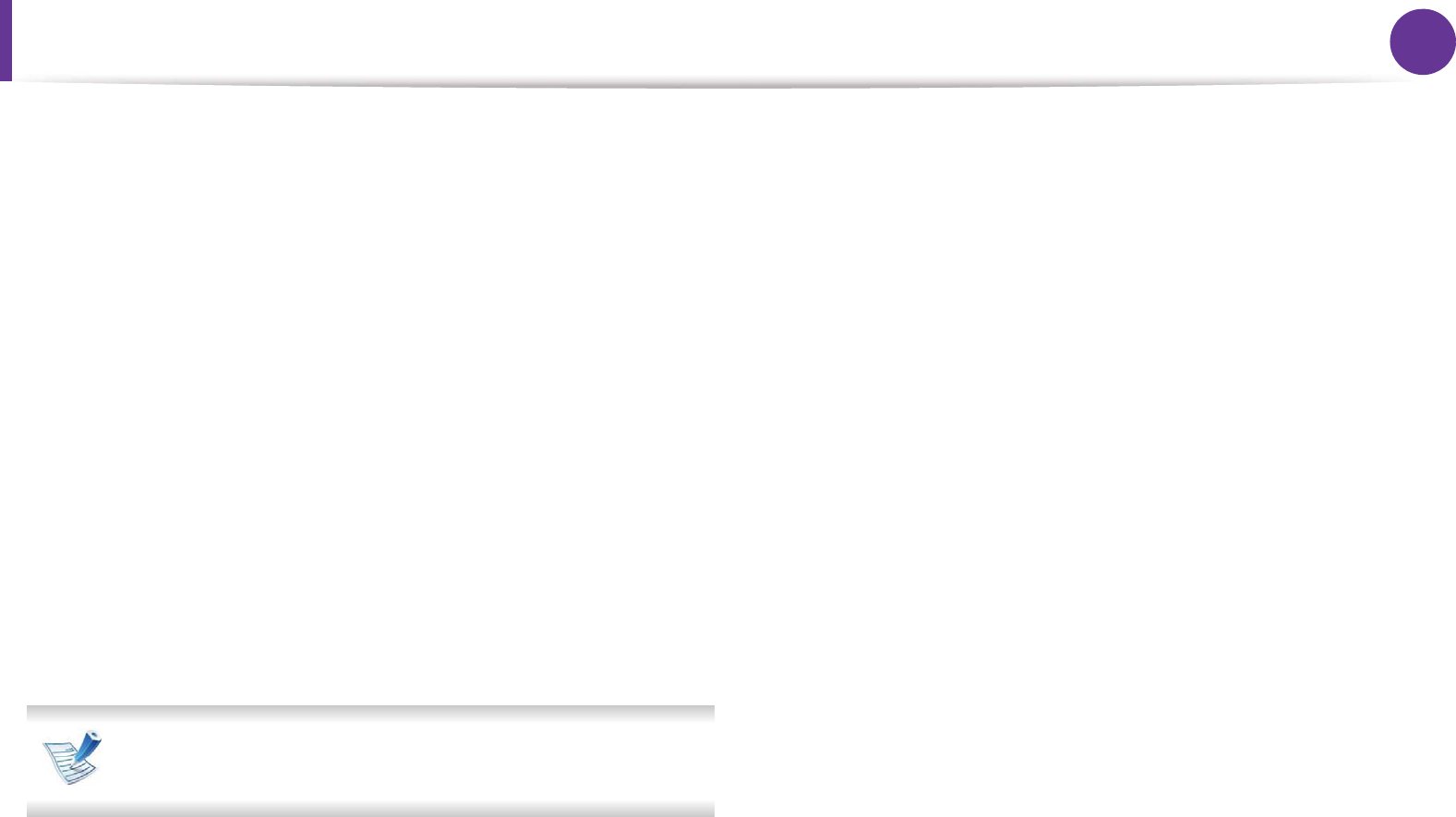
7
1. Software installation
Reinstallation for Macintosh
If the printer driver does not work properly, uninstall the driver and
reinstall it.
1Make sure that the machine is connected to your computer
and powered on.
2 Insert the supplied software CD into your CD-ROM drive.
3 Double-click the CD-ROM icon that appears on your
Macintosh desktop.
4 Double-click the MAC_Installer folder > Uninstaller OS X
icon.
5 Enter the password and click OK.
6 When the uninstall is done, click OK.
If a machine has already been added, delete it from the Print
Setup Utility or Print & Fax.
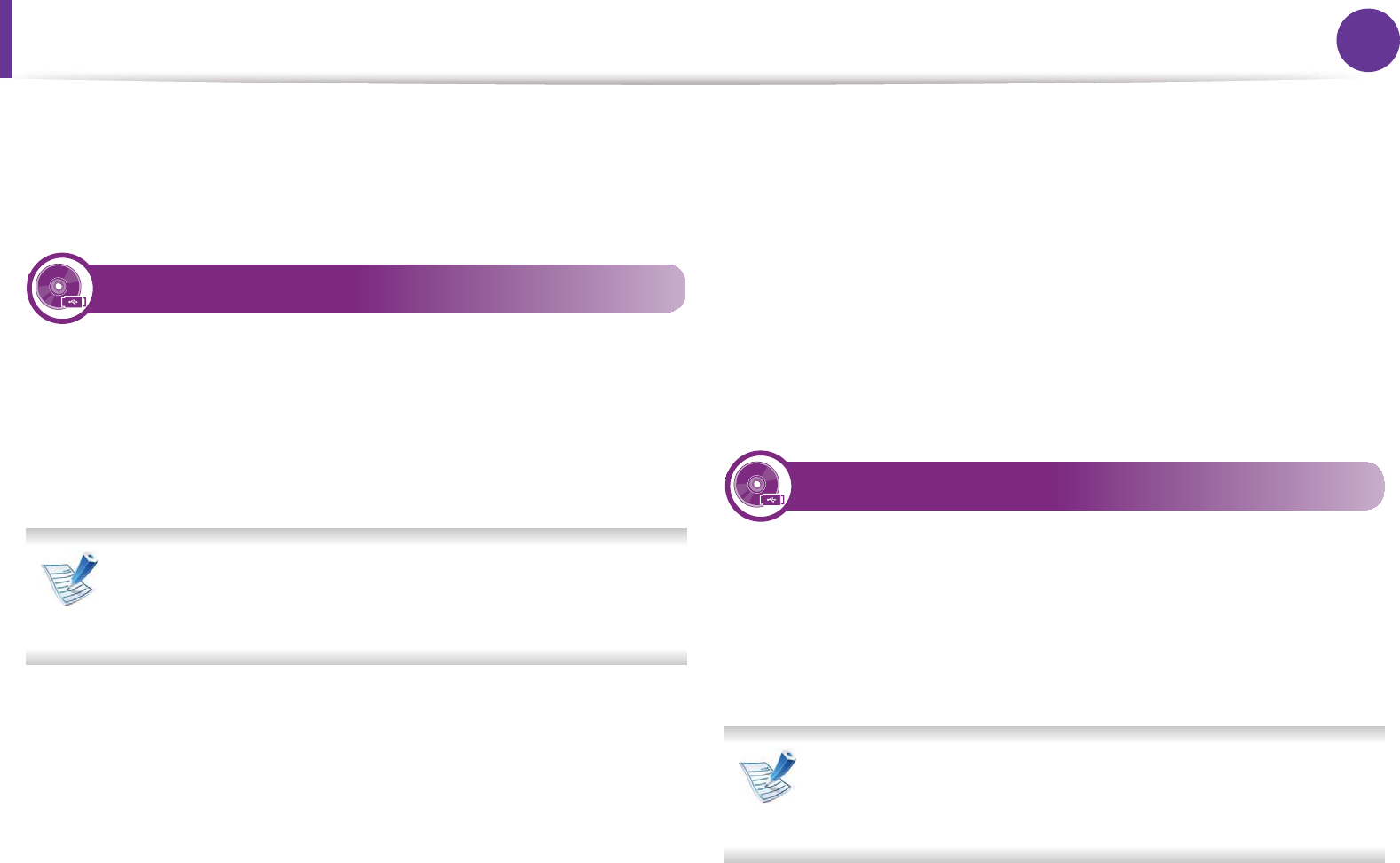
8
1. Software installation
Installation for Linux
You need to download Linux software packages from the Samsung
website to install the printer software (http://www.samsung.com/
printer).
1
Installing the Unified Linux Driver
1Make sure that the machine is connected to your computer
and powered on.
2 When the Administrator Login window appears, type “root”
in the Login field and enter the system password.
You must log in as a super user (root) to install the machine
software. If you are not a super user, ask your system
administrator.
3 From the Samsung website, download the Unified Linux
Driver package to your computer.
4 Right-click the Unified Linux Driver package and extract the
package.
5 Double click cdroot > autorun.
6 When the welcome screen appears, click Next.
7 When the installation is complete, click Finish.
The installation program added the Unified Driver Configurator
desktop icon and the Unified Driver group to the system menu for
your convenience. If you have any difficulties, consult the on-screen
help that is available through your system menu or from the driver
package Windows applications, such as Unified Driver
Configurator or Image Manager.
2
Installing the Smart Panel
1Make sure that the machine is connected to your computer
and powered on.
2 When the Administrator Login window appears, type in root
in the Login field and enter the system password.
You must log in as a super user (root) to install the machine
software. If you are not a super user, ask your system
administrator.
3 From the Samsung website, download the Smart Panel
package to your computer.
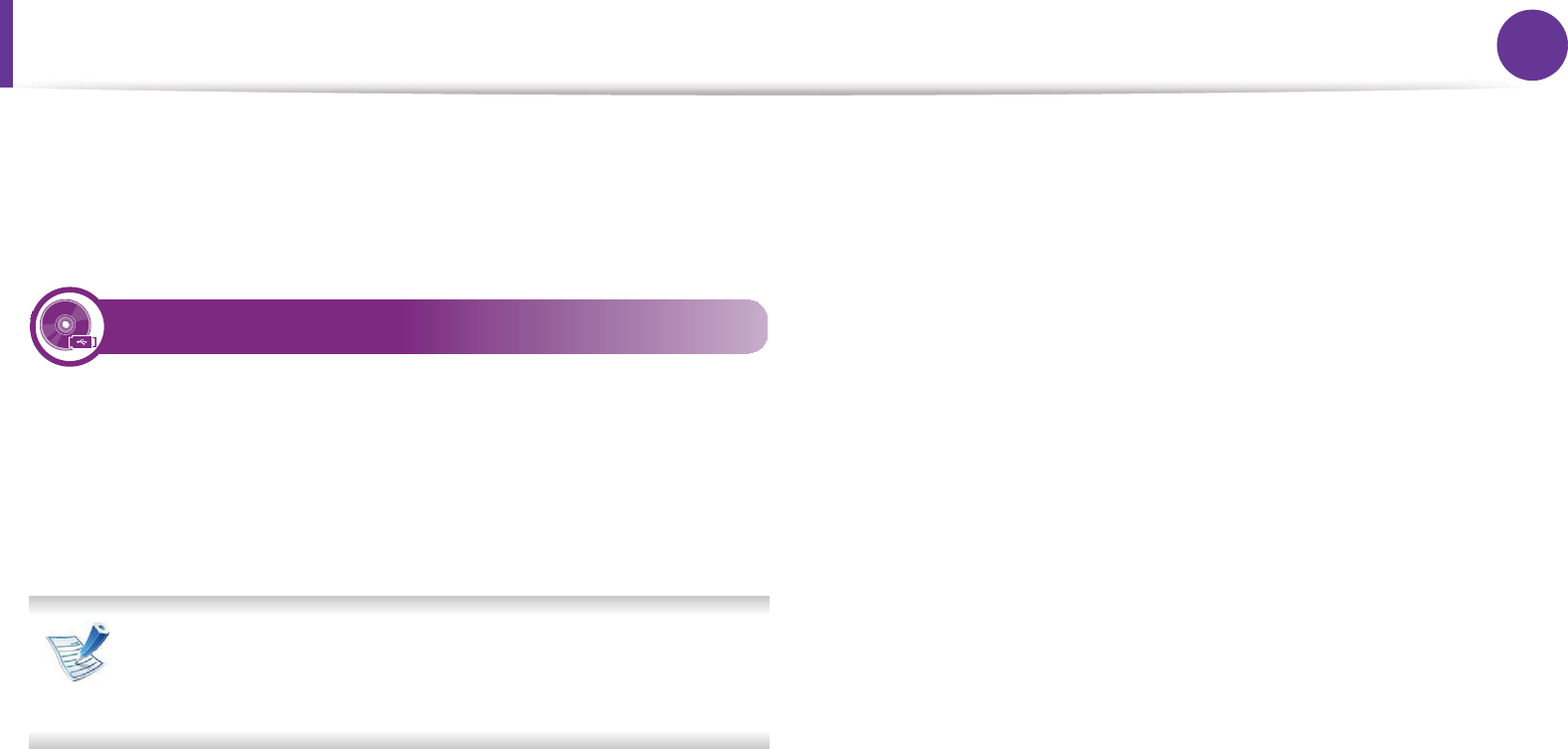
Installation for Linux 9
1. Software installation
4 Right-click the Smart Panel package and extract the package.
5 Double click cdroot > Linux > smartpanel > install.sh.
3
Installing the Printer Settings Utility
1Make sure that the machine is connected to your computer
and powered on.
2 When the Administrator Login window appears, type “root”
in the Login field and enter the system password.
You must log in as a super user (root) to install the machine
software. If you are not a super user, ask your system
administrator.
3 From the Samsung website, download the Printer Settings
Utility package to your computer.
4 Right-click the Printer Settings Utility package and extract
the package.
5 Double click cdroot > Linux > psu > install.sh.

10
1. Software installation
Reinstallation for Linux
If the printer driver does not work properly, uninstall the driver and
reinstall it.
1Make sure that the machine is connected to your computer
and powered on.
2 When the Administrator Login window appears, type “root”
in the Login field and enter the system password.
You must log in as a super user (root) to uninstall the printer
driver. If you are not a super user, ask your system
administrator.
3 Click the icon at the bottom of the desktop. When the
Terminal screen appears, type in the following.
[root@localhost root]#cd /opt/Samsung/mfp/uninstall/
[root@localhost uninstall]#./uninstall.sh
4 Click Uninstall.
5 Click Next.
6 Click Finish.
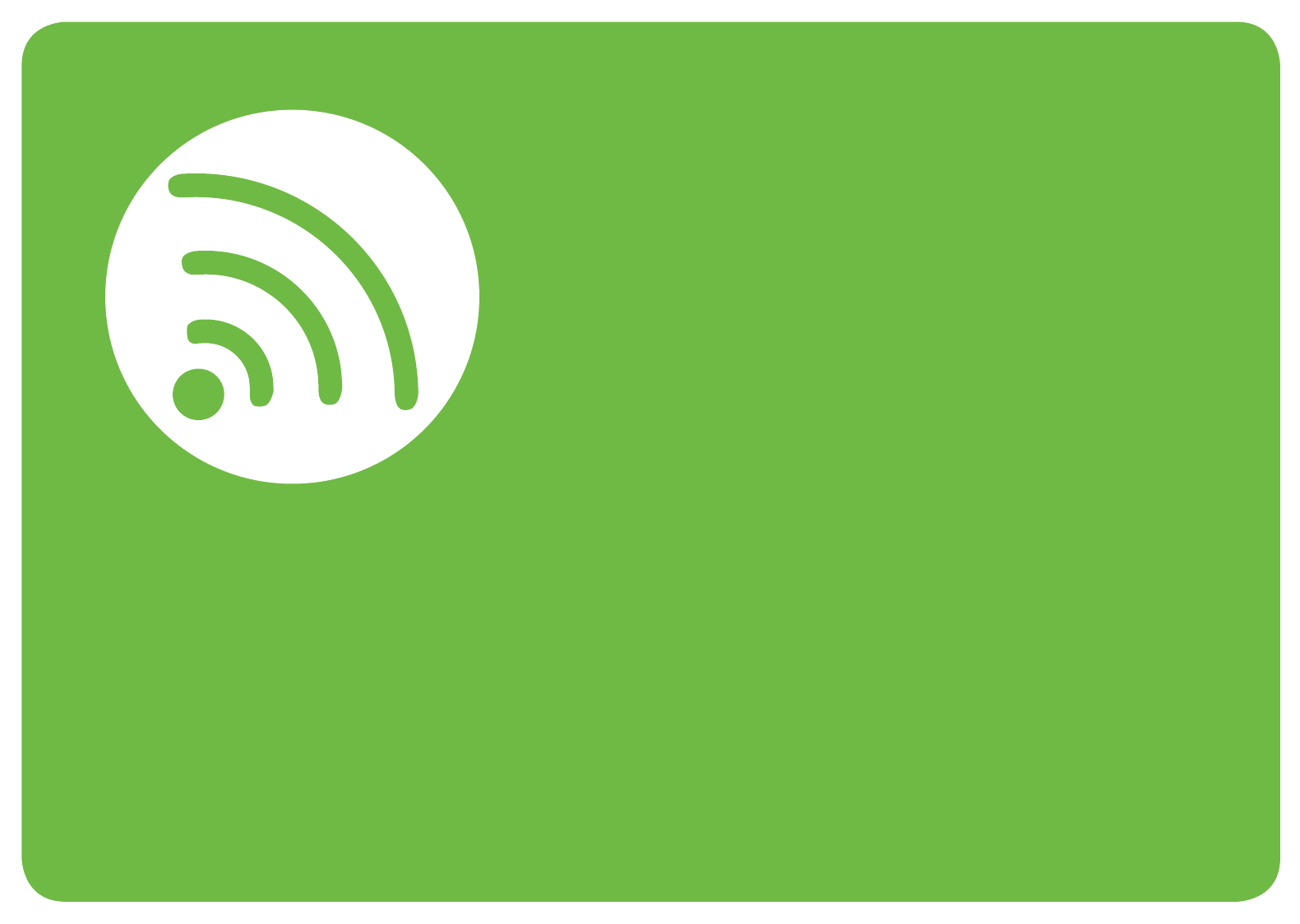
2. Using a network-connected
machine
This chapter gives you step-by-step instructions for setting up a network
connected machine and software.
• Useful network programs 12
• Wired network setup 13
• Installing driver over the network 17
• IPv6 configuration 28
• Wireless network setup 31
Supported optional devices and features may differ according to your
model.
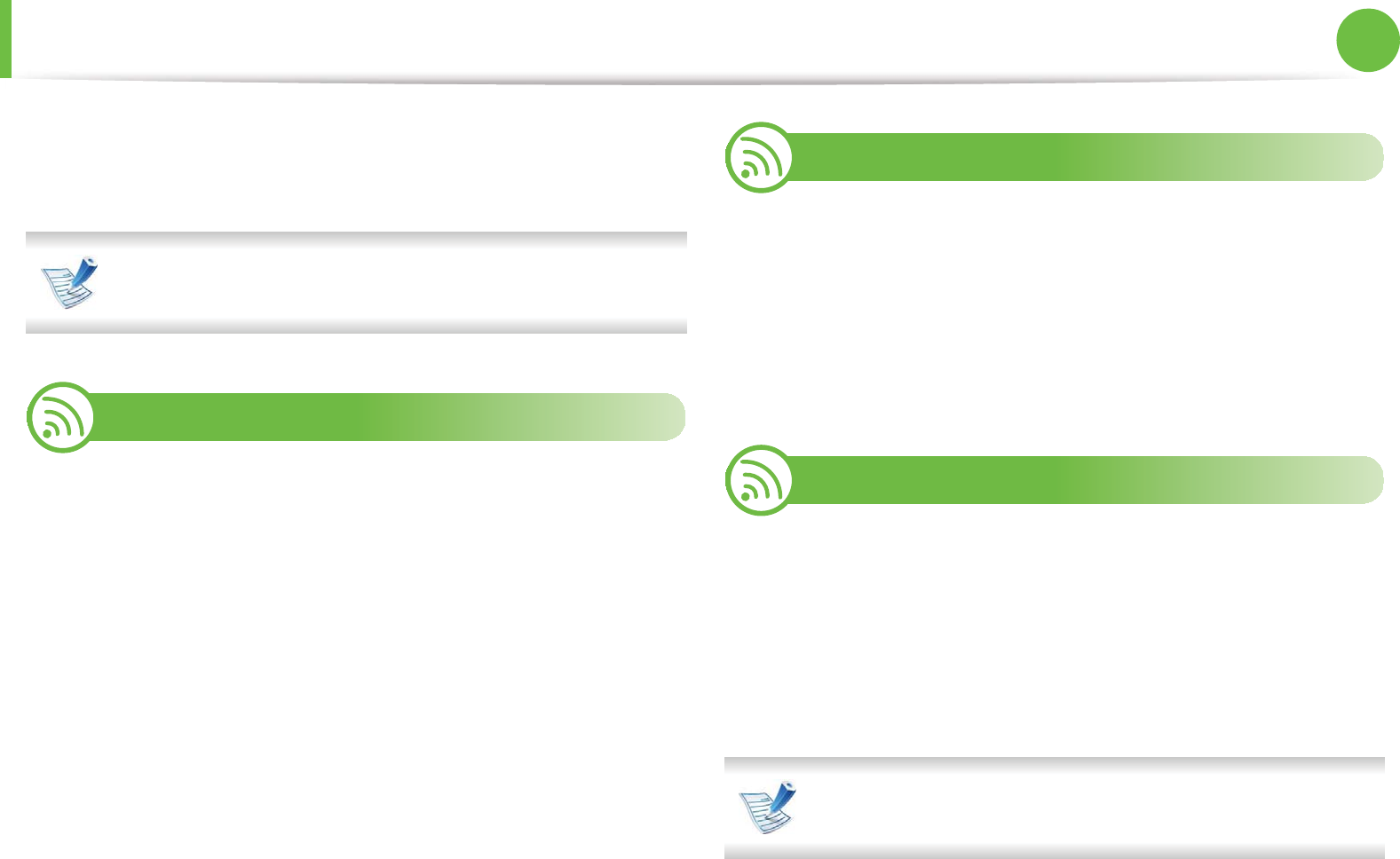
12
2. Using a network-connected machine
Useful network programs
There are several programs available to setup the network settings
easily in a network environment. For the network administrator
especially, managing several machines on the network is possible.
Before using the programs below, set the IP address first.
1
SyncThru™ Web Service
The web server embedded on your network machine allows you to
do the following tasks (see "Using SyncThru™ Web Service" on page
130):
• Check the supplies information and status.
• Customize machine settings.
• Set the email notification option. When you set this option, the
machine status (toner cartridge shortage or machine error) will
be sent to a certain person's email automatically.
• Configure the network parameters necessary for the machine to
connect to various network environments.
2
SyncThru™ Web Admin Service
Web-based machine management solution for network
administrators. SyncThru™ Web Admin Service provides you with an
efficient way of managing network devices and lets you remotely
monitor and troubleshoot network machines from any site with
corporate internet access. Download this program from http://
solution.samsungprinter.com.
3
SetIP Wired network setup
This utility program allows you to select a network interface and
manually configure the IP addresses for use with the TCP/IP protocol.
• See "IPv4 configuration using SetIP (Windows)" on page 13.
• See "IPv4 configuration using SetIP (Macintosh)" on page 14.
• See "IPv4 configuation using SetIP (Linux)" on page 15.
TCP/IPv6 is not supported by this program.
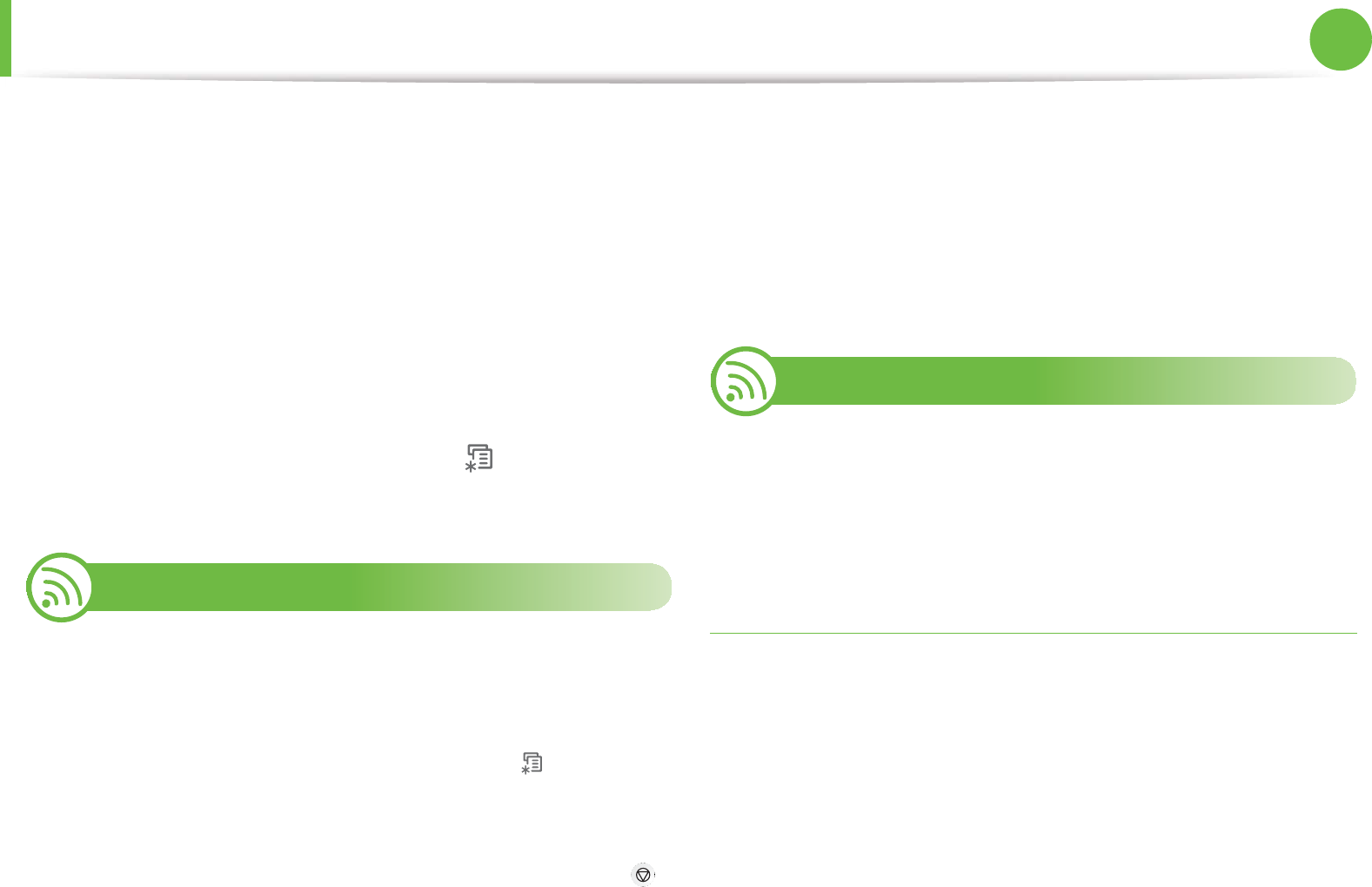
13
2. Using a network-connected machine
Wired network setup
You must set up the network protocols on your machine to use it on
your network.
You can use network after connecting network cable to a
corresponding port on your machine.
• For models that do not have the display screen on the control
panel, use the SyncThru™ Web Service or SetIP program.
- See "Using SyncThru™ Web Service" on page 130.
- See "Setting IP address" on page 13.
• For models that have the display screen on the control panel,
configure the network setting by pressing (Menu) button >
Network on the control panel (see "Network setup" on page 80).
4
Printing a network configuration report
You can print Network Configuration Report from the machine’s
control panel that will show the current machine’s network settings.
This will help you to set up a network.
•The machine has the display screen: Press the (Menu)
button on the control panel and select Network > Network
Conf. (Network Configuration) > Yes.
•The machine does not have the display screen: Press the
(Cancel or Stop/Clear) button for more than five seconds on the
control panel.
Using this Network Configuration Report, you can find your
machine’s MAC address and IP address.
For example:
• MAC Address: 00:15:99:41:A2:78
• IP Address: 192.0.0.192
5
Setting IP address
First, you have to set up an IP address for network printing and
managements. In most cases a new IP address will be automatically
assigned by a DHCP (Dynamic Host Configuration Protocol) server
located on the network.
IPv4 configuration using SetIP (Windows)
Before using the SetIP program, disable the computer firewall from
Control Panel > Security Center > Windows Firewall.
1Install this program from the supplied CD-ROM by double-
click Application > SetIP > Setup.exe.
2 Follow the instructions in the installation window.
3 Connect your machine to the network with a network cable.
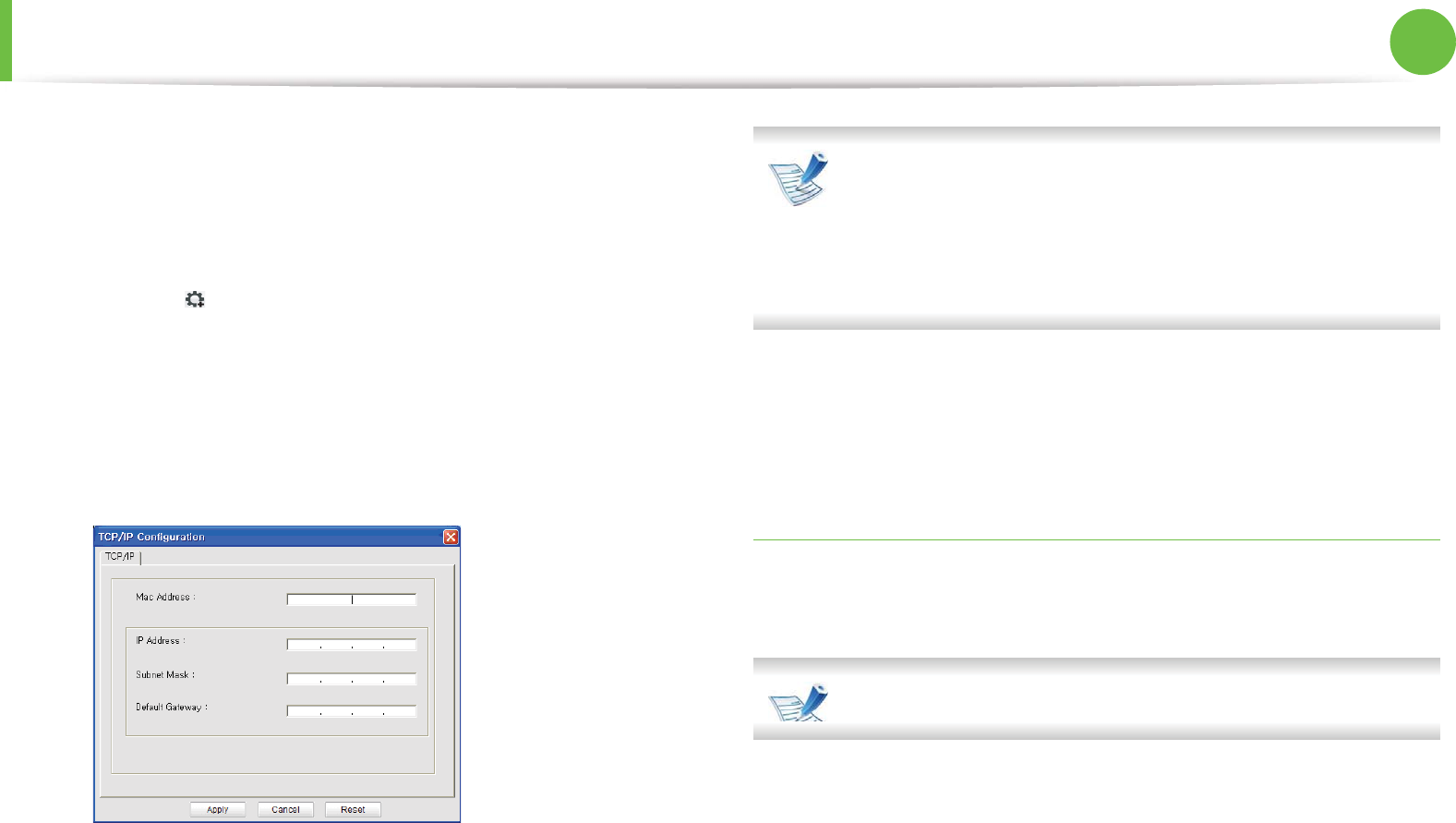
Wired network setup 14
2. Using a network-connected machine
4 Turn on the machine.
5 From the Windows Start menu, select All Programs >
Samsung Printers > SetIP > SetIP.
6 Click the icon (third from left) in the SetIP window to open
the TCP/IP configuration window.
7 Enter the machine’s new information into the configuration
window as follows. In a corporate intranet, you may need to
have this information assigned by a network manager before
proceeding.
Find the machine’s MAC address from the Network
Configuration Report (see "Printing a network
configuration report" on page 13) and enter it without the
colons. For example, 00:15:99:29:51:A8 becomes
0015992951A8.
8 Click Apply, and then click OK. The machine will automatically
print the Network Configuration Report. Confirm that all the
settings are correct.
IPv4 configuration using SetIP (Macintosh)
Before using the SetIP program, disable the computer firewall from
System Preferences > Security > Firewall.
The following instructions may vary from your model.
1Connect your machine to the network with a network cable.
2 Insert the Installation CD-ROM, and open the disk window,
select MAC_Installer > MAC_Printer > SetIP >
SetIPapplet.html.
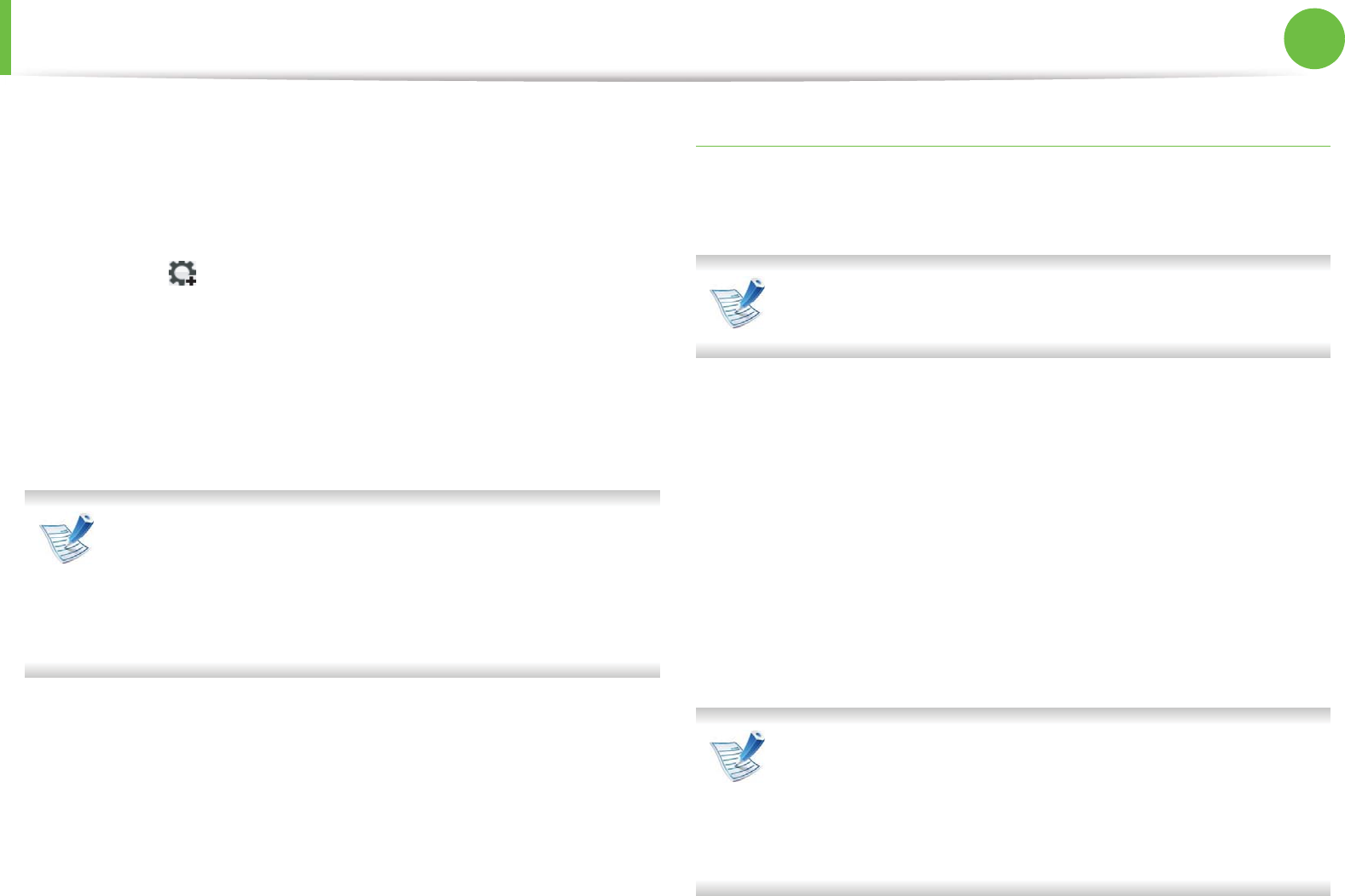
Wired network setup 15
2. Using a network-connected machine
3 Double-click the file and Safari will automatically open, then
select Trust. The browser will open the SetIPapplet.html
page that shows the printer’s name and IP address
information.
4 Click the icon (third from left) in the SetIP window to open
the TCP/IP configuration window.
5 Enter the machine’s new information into the configuration
window. In a corporate intranet, you may need to have this
information assigned by a network manager before
proceeding.
Find the machine’s MAC address from the Network
Configuration Report (see "Printing a network
configuration report" on page 13) and enter it without the
colons. For example, 00:15:99:29:51:A8 becomes
0015992951A8.
6 Select Apply, then OK, and OK again.
7 Quit Safari.
IPv4 configuation using SetIP (Linux)
Before using the SetIP program, disable the computer firewall from
System Preferences or Administrator.
The following instructions may vary from your model or
operating systems.
1Open /opt/Samsung/mfp/share/utils/.
2 Double-click the SetIPApplet.html file.
3 Click to open the TCP/IP configuration window.
4 Enter the machine’s new information into the configuration
window. In a corporate intranet, you may need to have this
information assigned by a network manager before
proceeding.
Find the machine’s MAC address from the Network
Configuration Report (see "Printing a network
configuration report" on page 13) and enter it without the
colons. For example, 00:15:99:29:51:A8 becomes
0015992951A8.

Wired network setup 16
2. Using a network-connected machine
5 The machine will automatically print the Network
Configuration Report.
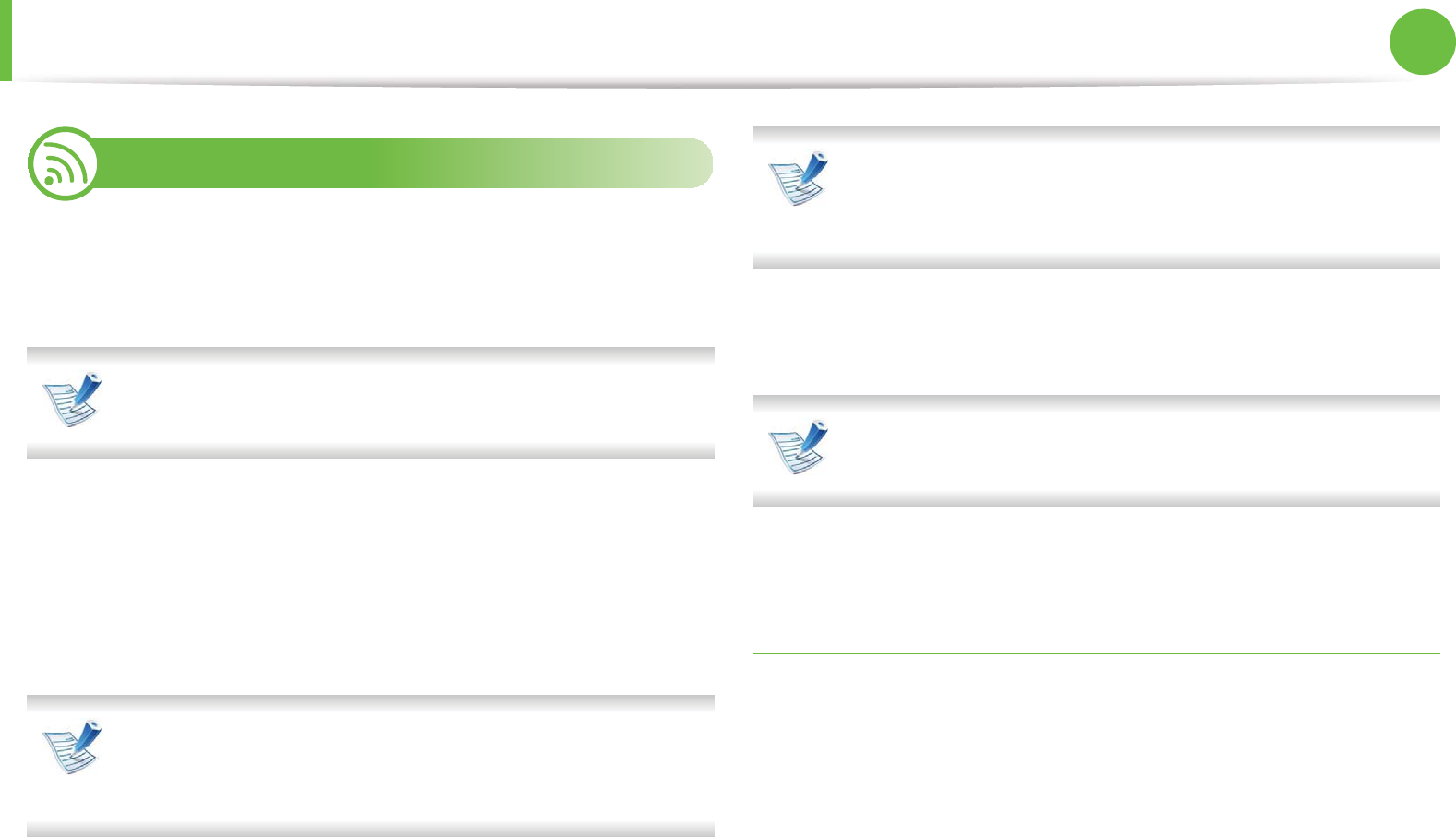
17
2. Using a network-connected machine
Installing driver over the network
6
Windows
1Make sure that the machine is connected to the network and
powered on. Also, your machine’s IP address should have
been set (see "Setting IP address" on page 13).
If the “Found New Hardware Wizard” appears during the
installation procedure, click Cancel to close the window.
2 Insert the supplied software CD into your CD-ROM drive.
The software CD should automatically run and an installation
window will appear.
3 Select Install Now.
The Custom Installation allows you to select the machine’s
connection and choose individual components to install.
Follow the instructions on the window.
4 Read License Agreement, and select I accept the terms of
the License Agreement. Then, click Next.
The program searches for the machine.
If your machine is not found on the network or locally, an
error message appears. Select the option you want and click
Next.
5 The searched machines will be shown on the screen. Select
the one you wish to use and click OK.
If the driver searched only one machine, the confirmation
window appears.
6 Follow the instructions in the installation window.
Silent installation Mode
Silent installation mode is an installation method that does not
require any user intervention. Once you start the installation, the
machine driver and software are automatically installed on you
computer. You can start the silent installation by typing /s or /S in the
command window.
ŹCommand-line Parameters
Following table shows commands that can be used in the command
window.
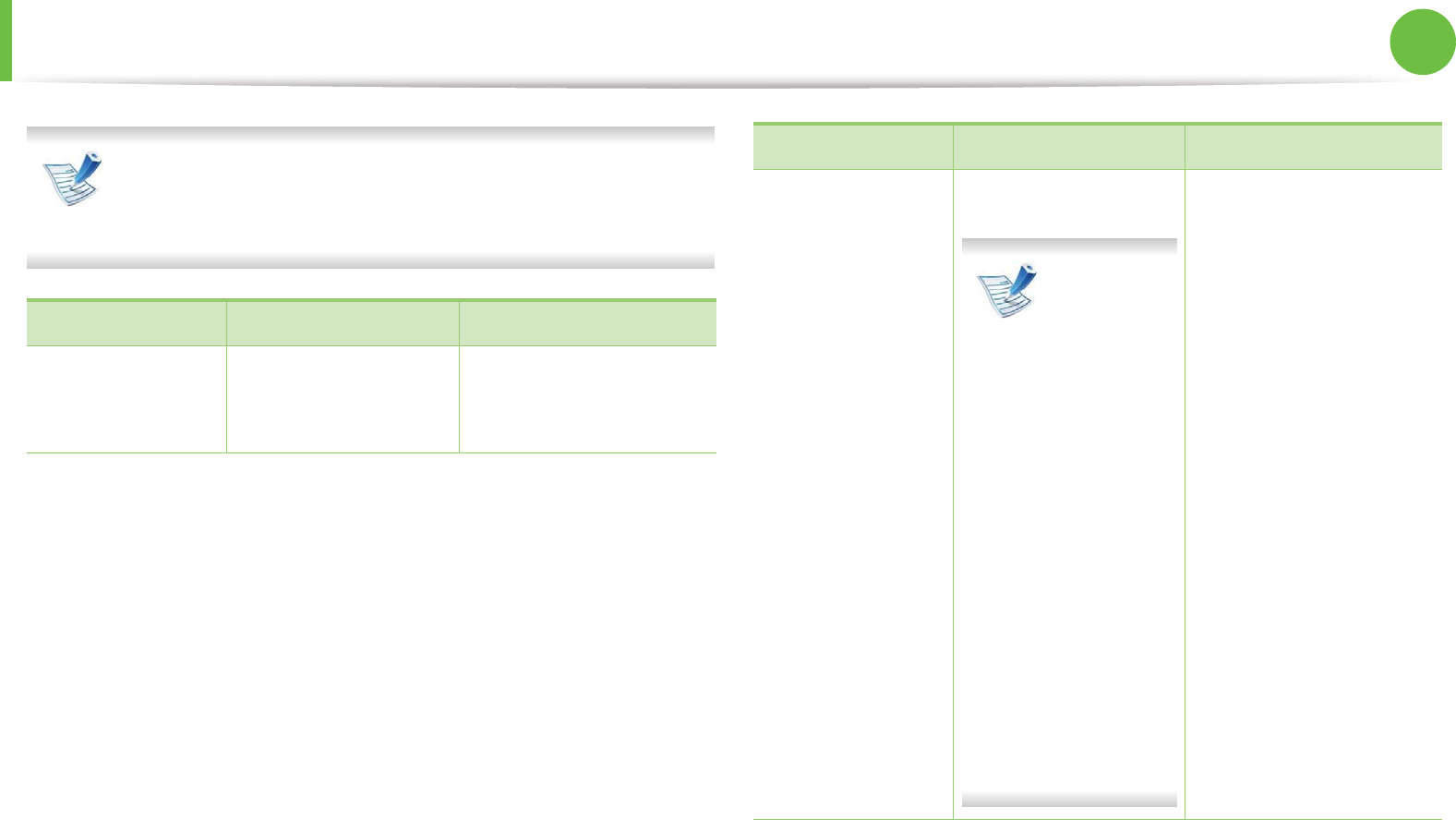
Installing driver over the network 18
2. Using a network-connected machine
Following command-line are effective and operated when
command is used with /s or /S. But /h, /H or /? are exceptional
commands that can be operated solely.
Command- line Definition Description
/s or
/S
Starts silent
installation.
Installs machine drivers
without prompting any
UIs or user intervention.
/p”<port name>”
or
/P”<port name>”
Specifies printer port.
Network
Port will be
created by
use of
Standard
TCP/IP Port
monitor.
For local
port, this
port must
exist on
system
before
being
specified
by
command.
Printer port name can be
specified as IP address,
hostname, USB local
port name or IEEE1284
port name.
For example
• /p”xxx.xxx.xxx.xxx” in
where,
“xxx.xxx.xxx.xxx”
means IP address for
network printer. /
p”USB001”, /P”LPT1:”,
/p”hostname”
• When installing the
driver silently in
Korean, type in-
Setup.exe /s /
L"0x0012” or
Setup.exe /s /L"18” .
Command- line Definition Description
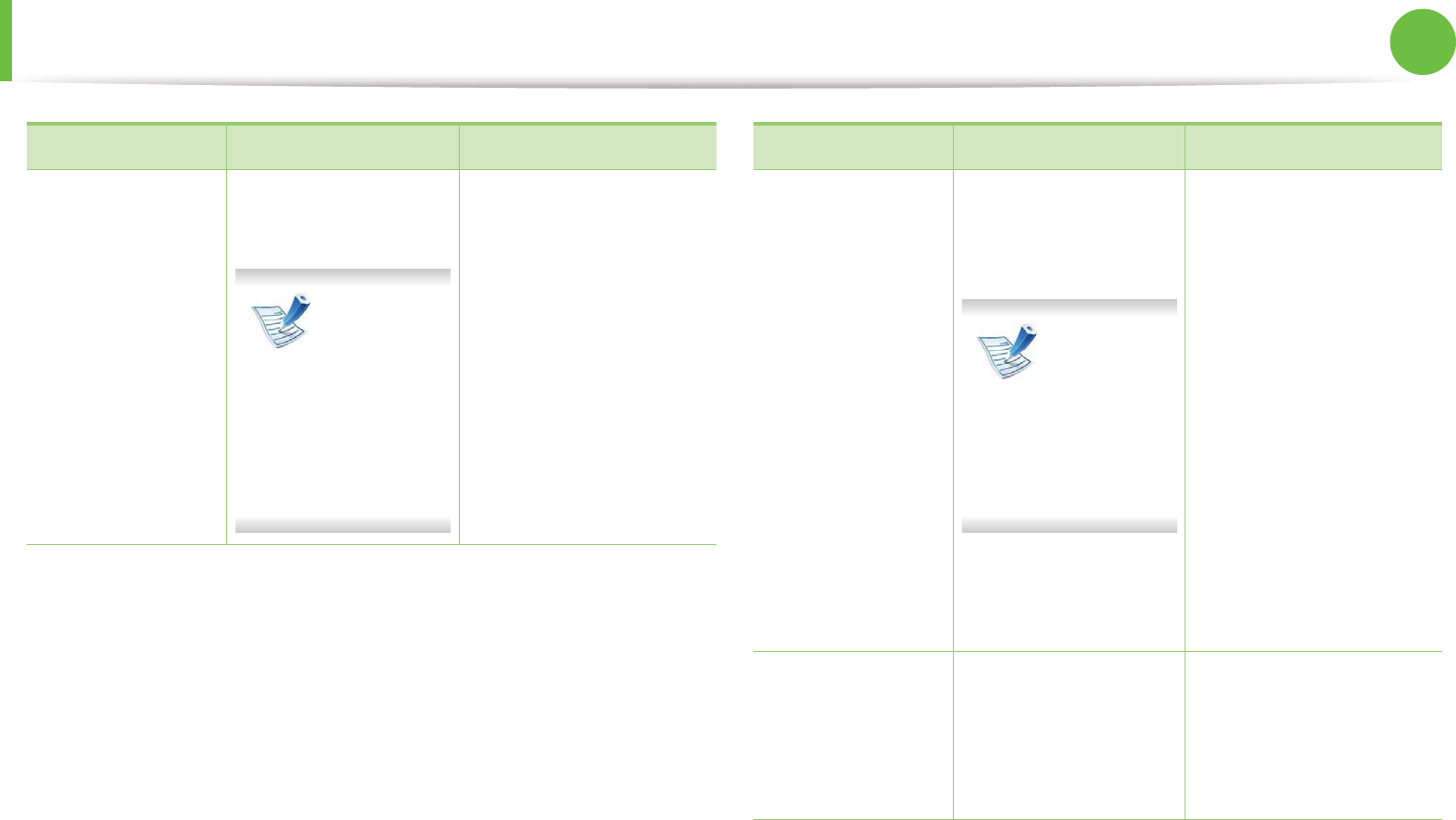
Installing driver over the network 19
2. Using a network-connected machine
/a”<dest_path>”
or
/A”<dest_path>”
Specifies destination
path for installation.
The
destination
path
should be a
fully
qualified
path.
Since machine drivers
should be installed on
the OS specific location,
this command applies to
only application
software.
Command- line Definition Description
/i”<script
filename>” or
/I”<script
filename>”
Specifies customized
install script file for
custom operation.
The script
filename
should be a
fully
qualified
filename.
Customized script file
can be assigned for
customized silent
installation. This script
file can be created or
modified through
provided installer
customizing utility or by
text editor.
Note: This customized
script file is prior than
default installer setting
in setup package but not
prior than command-
line parameters.
/n”<Printer
name>” or
/N”<Printer
name>”
Specifies printer
name. Printer
instance shall be
created as specified
printer name.
With this parameter, you
can add printer
instances as your wishes.
Command- line Definition Description

Installing driver over the network 20
2. Using a network-connected machine
/nd or
/ND
Commands not to set
the installed driver as
a default machine
driver.
It indicates installed
machine driver will not
be the default machine
driver on your system if
there are one or more
printer drivers installed.
If there is no installed
machine driver on your
system, then this option
won’t be applied
because Windows OS
will set installed printer
driver as a default
machine driver.
/x or
/X
Uses existing
machine driver files to
create printer
instance if it is already
installed.
This command provides
a way to install a printer
instance that uses
installed printer driver
files without installing
an additional driver.
Command- line Definition Description
/up”<printer
name>” or
/UP”<printer
name>”
Removes only
specified printer
instance and not the
driver files.
This command provides
a way to remove only
specified printer
instance from your
system without
effecting other printer
drivers. It will not
remove printer driver
files from your system.
/d or
/D
Uninstalls all device
drivers and
applications from
your system.
This command will
remove all installed
device drivers and
application software
from your system.
/v”<share name>”
or
/V”<share name>”
Shares installed
machine and add
other available
platform drivers for
Point & Print.
It will install all
supported Windows OS
platform’s machine
drivers to system and
share it with specified
<share name> for point
and print.
/o or
/O
Opens Printers and
Faxes folder after
installation.
This command will open
Printers and Faxes
folder after the silent
installation.
Command- line Definition Description
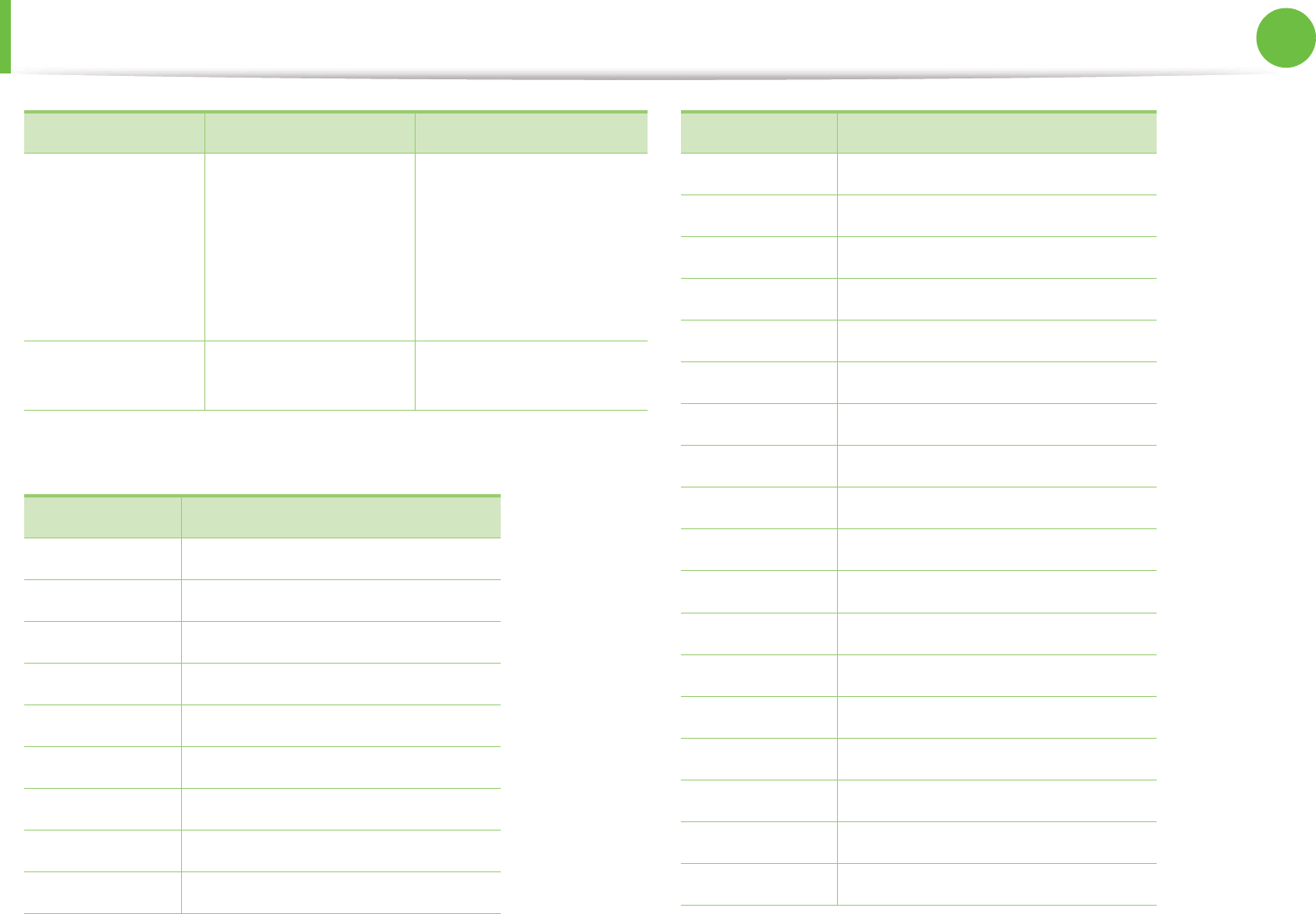
Installing driver over the network 21
2. Using a network-connected machine
ŹLanguage code
/f”<log filename>”
or
/F”<log
filename>”
Specifies log
filename.
The default log file is
created in the system
temp folder if not
specified.
It will create a log file to a
specified folder.
/h, /H or /? Shows Command-line
Usage.
Code Language
0X0009 English
0X0012 Korean
0X0804 Simplified Chinese
0X0404 Traditional Chinese
0x040c French
0X0007 German
0X0010 Italian
0X000a Spanish
0X0013 Dutch
Command- line Definition Description
0X001D Swedish
0X0006 Danish
0X000b Finnish
0X0014 Norwegian
0X0019 Russian
0X0005 Czech
0X000e Hungarian
0X0008 Greek
0X0816 Standard Portuguese
0X0416 Brazilian Portuguese
0X0015 Polish
0X001F Turkish
0X0001 Arabic
0X000D Hebrew
0x0424 Slovenian
0X0418 Romanian
0X0402 Bulgarian
0X041A Croatian
Code Language
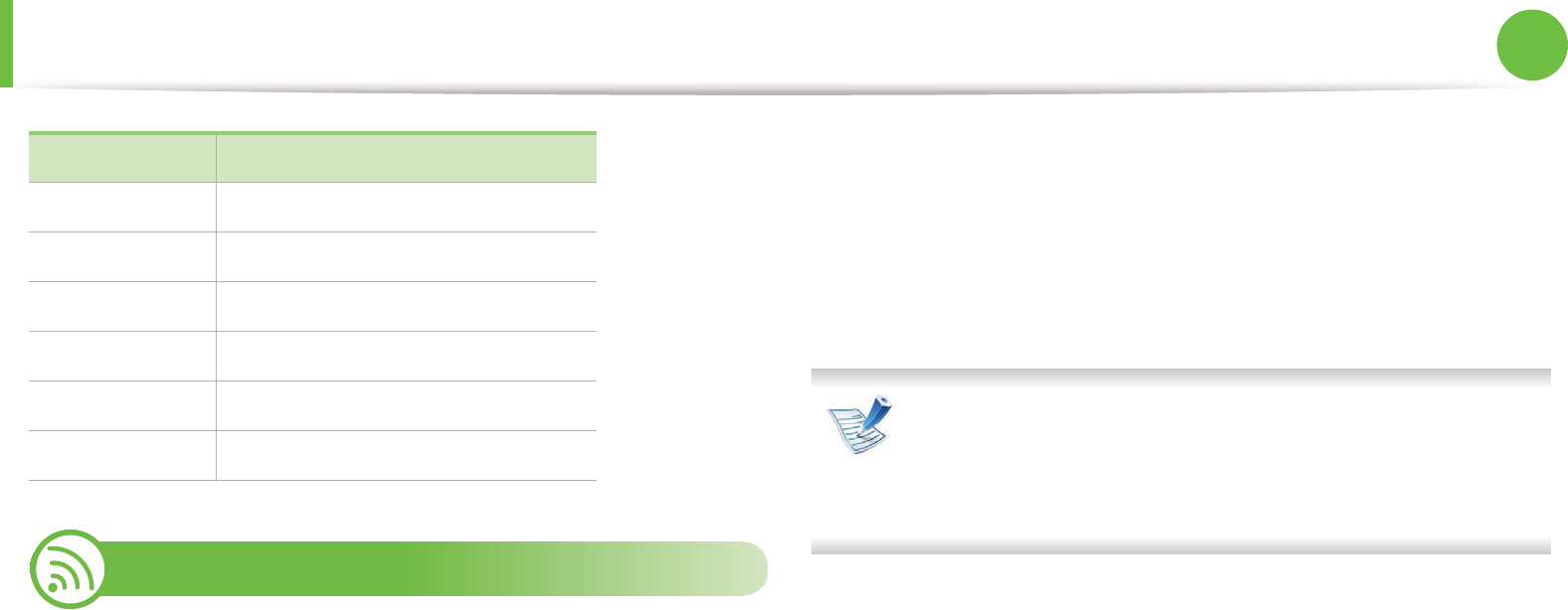
Installing driver over the network 22
2. Using a network-connected machine
7
Macintosh
1Make sure that the machine is connected to your network and
powered on.
2 Insert the supplied software CD into your CD-ROM drive.
3 Double-click the CD-ROM icon that appears on your
Macintosh desktop.
4 Double-click the MAC_Installer folder > Installer OS X icon.
5 Click Continue.
6 Read the license agreement and click Continue.
7 Click Agree to agree to the license agreement.
8 When the message which warns that all applications will close
on your computer appears, click Continue.
9 Click Continue on the User Options Pane.
If you have not set the IP address yet, click Set IP address and
refer to "IPv4 configuration using SetIP (Macintosh)" on page
14. If you want to set the wireless setting, refer to "Setup
using Macintosh" on page 46.
10 Click Install. All components necessary for machine
operations will be installed.
If you click Customize, you can choose individual
components to install.
11 Enter the password and click OK.
12 Installing software requires you to restart your computer. Click
Continue Installation.
13 After the installation is finished, click Restart.
0X081A Serbian
0X0422 Ukraine
0X041B Slovakia
0X0421 Indonesian
0x041E Thai
0X0429 Farsi
Code Language
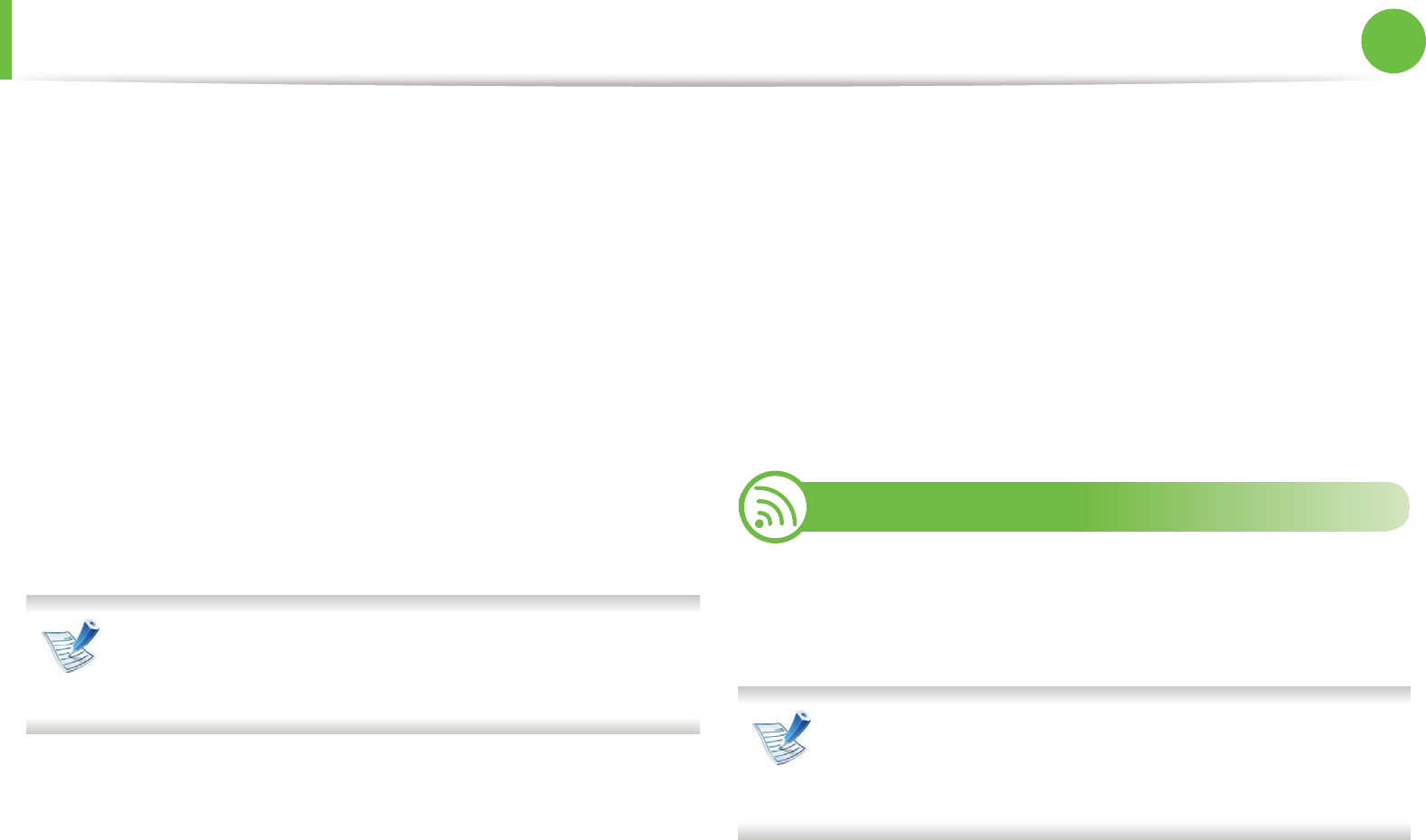
Installing driver over the network 23
2. Using a network-connected machine
14 Open the Applications folder > Utilities > Print Setup
Utility.
• For Mac OS X 10.5-10.6, open the Applications folder >
System Preferences and click Print & Fax.
15 Click Add on the Printer List.
• For Mac OS X 10.5-10.6, click the “+” icon. A display window
will pop up.
16 For Mac OS X 10.4, click IP Printer.
• For Mac OS X 10.5-10.6, click IP.
17 Select HP Jetdirect - Socket in Protocol.
When printing a document containing many pages, printing
performance may be enhanced by choosing Socket for
Printer Type option.
18 Enter the machine’s IP address in the Address input field.
19 Enter the queue name in the Queue input field. If you cannot
determine the queue name for your machine server, try using
the default queue first.
20 For Mac OS X 10.4, if Auto Select does not work properly, select
Samsung in Print Using and your machine name in Model.
• For Mac OS X 10.5-10.6, if Auto Select does not work
properly, choose Select Printer Software and your
machine name in Print Using.
21 Click Add.
Your machine appears in the Printer List, and is set as the
default machine.
8
Linux
You need to download Linux software packages from the Samsung
website to install the printer software (http://www.samsung.com/
printer).
To install other software:
• See "Installing the Smart Panel" on page 8.
• See "Installing the Printer Settings Utility" on page 9.

Installing driver over the network 24
2. Using a network-connected machine
Install the Linux driver and add network printer
1Make sure that the machine is connected to your network and
powered on. Also, your machine’s IP address should have
been set.
2 Download the Unified Linux Driver package from the
Samsung website.
3 Extract the UnifiedLinuxDriver.tar.gz file and open the new
directory.
4 Double-click the Linux folder > install.sh icon.
5 The Samsung installer window opens. Click Continue.
6 The add printer wizard window opens. Click Next.
7 Select network printer and click Search button.
8 The machine’s IP address and model name appears on list
field.
9 Select your machine and click Next.
10 Input the printer description and Next.
11 After the machine is added, click Finish.
12 When installation is done, click Finish.
Add a network printer
1Double-click the Unified Driver Configurator.
2 Click Add Printer.
3 The Add printer wizard window opens. Click Next.
4 Select Network printer and click the Search button.
5 The printer’s IP address and model name appears on list field.
6 Select your machine and click Next.
7 Enter the printer description and click Next.
8 After the machine is added, click Finish.
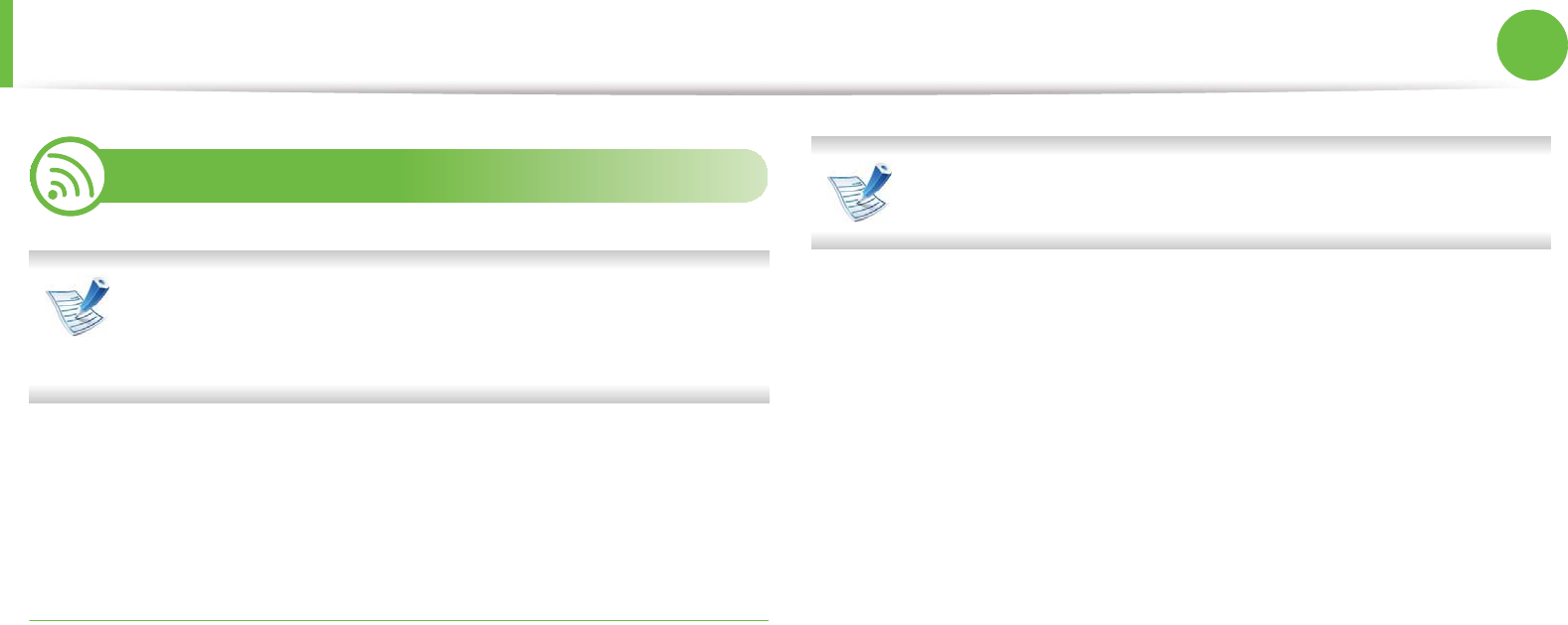
Installing driver over the network 25
2. Using a network-connected machine
9
UNIX
Make sure your machine supports the UNIX operating
system before installing the UNIX printer driver (see basic
guide)
To use the UNIX printer driver, you have to install the UNIX printer
driver package first, then setup the printer. You can download the
UNIX printer driver package from the Samsung website.
Installing the UNIX printer driver package
The installation procedure is common for all variants of UNIX OS
mentioned.
1From the Samsung website, download and unpack the UNIX
Printer Driver package to your computer.
2 Acquire root privileges.
su -
3 Copy the appropriate driver archive to the target UNIX
computer.
See administration guide of your UNIX OS for details.
4 Unpack the UNIX printer driver package.
For example, on IBM AIX, use the following commands
(without “”).
gzip -d < "package name" | tar xf -
5 Go to the unpacked directory.
6 Run the install script.
./install
install is the installer script file which is used to install or
uninstall the UNIX Printer Driver package.
Use “chmod 755 install” command to give the permission to
the installer script.
7 Execute the “. /install –c” command to verify installation
results.
8 Run ‘installprinter’ from the command line. This will bring up
the Add Printer Wizard window. Setup the printer in this
window referring to the following procedures.
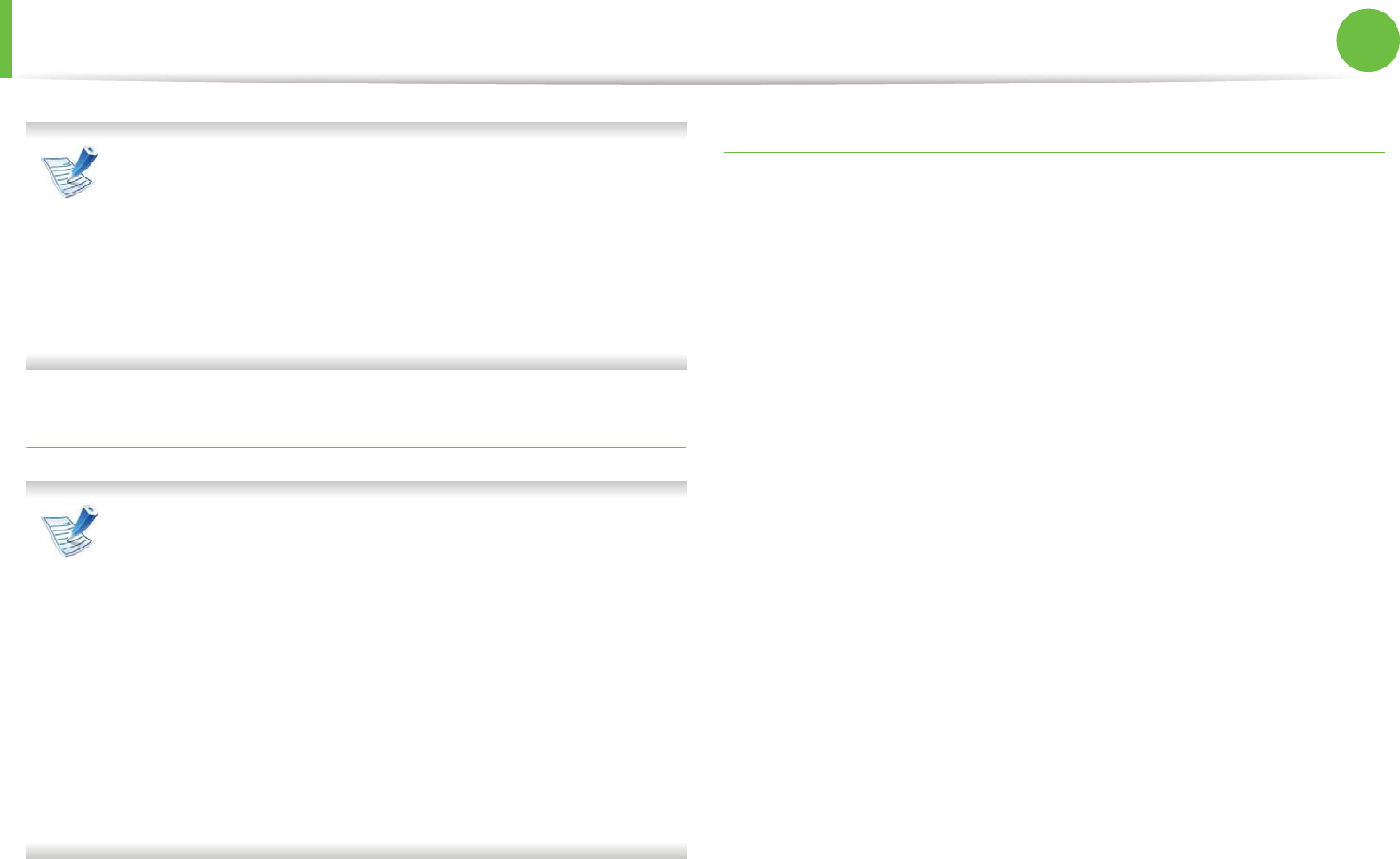
Installing driver over the network 26
2. Using a network-connected machine
On some UNIX OS, for example on Solaris 10, just added
printers may not be enabled and/or may not accept jobs. In
this case run the following two commands on the root
terminal:
accept <printer_name>
enable <printer_name>
Uninstalling the printer driver package
The utility should be used to delete the printer installed in
the system.
a Run “uninstallprinter” command from the terminal.
It will open the Uninstall Printer Wizard.
The installed printers are listed in the drop-down list.
b Select the printer to be deleted.
c Click Delete to delete the printer from the system.
d Execute the “. /install –d” command to uninstall the whole
package.
e To verify removal results, execute the “. /install –c”
command.
To re-install it, use the command “. /install” to reinstall the binaries.
Setting up the printer
To add the printer to your UNIX system, run ‘installprinter’ from the
command line. This will bring up the Add Printer Wizard window.
Setup the printer in this window according to the following steps:
1Type the name of the printer.
2 Select the appropriate printer model from the model list.
3 Enter any description corresponding to the type of the printer
in the Type field. This is optional.
4 Specify any printer description in the Description field. This is
optional.
5 Specify the printer location in the Location field.
6 Type the IP address or DNS name of the printer in the Device
textbox for network-connected printers. On IBM AIX with
jetdirect Queue type, only the DNS name is possible-numeric
IP address is not allowed.
7 Queue type shows the connection as lpd or jetdirect in the
corresponding list box. Additionally, usb type is available on
Sun Solaris OS.

Installing driver over the network 27
2. Using a network-connected machine
8 Select Copies to set the number of copies.
9 Check the Collate option to receive copies already sorted.
10 Check the Reverse Order option to receive copies in the
reverse order.
11 Check the Make Default option to set this printer as default.
12 Click OK to add the printer.
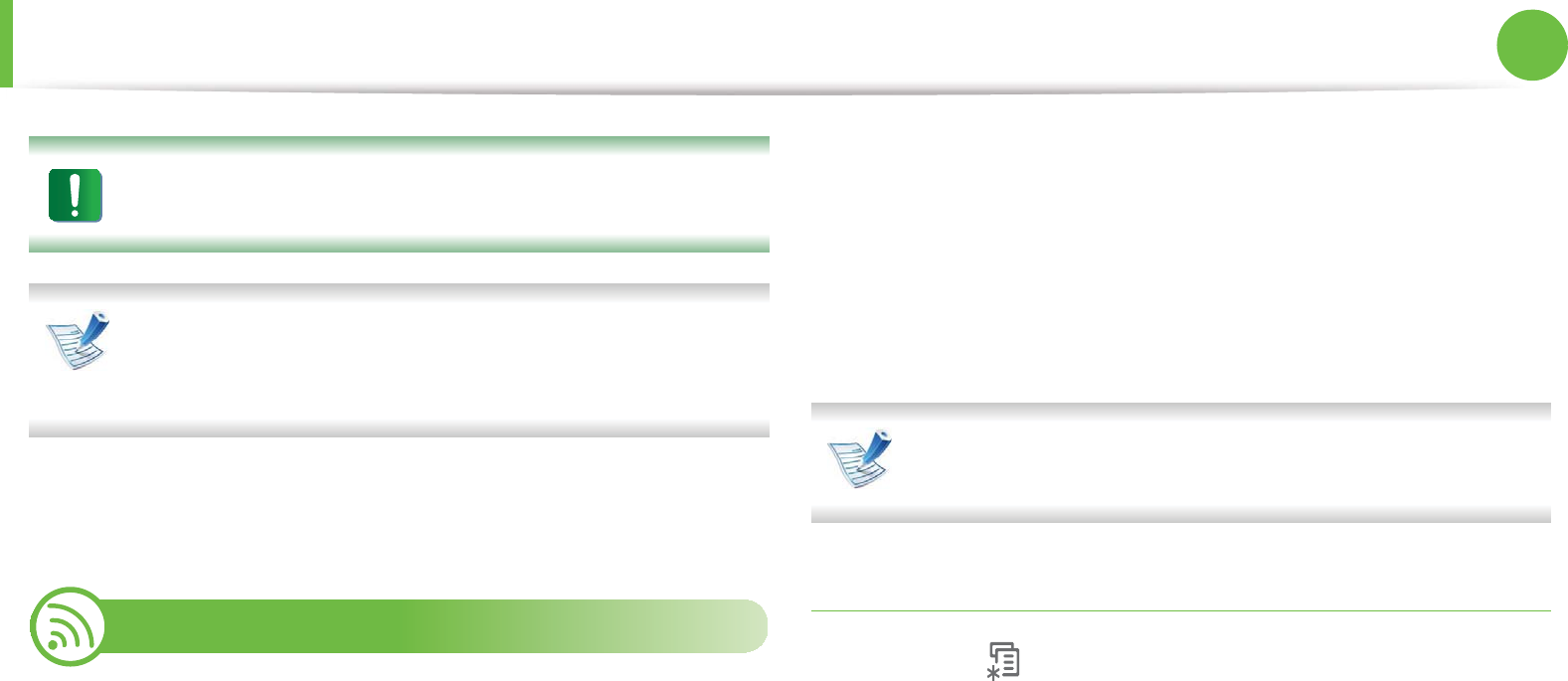
28
2. Using a network-connected machine
IPv6 configuration
IPv6 is supported properly only in Windows Vista or higher.
If the IPv6 network seems to not be working, set all the
network setting to the factory defaults and try again using
Clear Setting.
In the IPv6 network environment, follow the next procedure to use
the IPv6 address.
10
From the control panel
1Connect your machine to the network with a network cable.
2 Turn on the machine.
3 Print a Network Configuration Report that will check IPv6
addresses (see "Printing a network configuration report" on
page 13).
4 Select Start > Control Panel > Printers and Faxes.
5 Click Add a printer in the left pane of the Printers and Faxes
windows.
6 Click Add a local printer in the Add Printer windows.
7 The Add Printer Wizard window appears. Follow the
instructions in the window.
If the machine does not work in the network environment,
activate IPv6. Refer to the next section followed by.
Activating IPv6
1Press the (Menu) button on the control panel.
2 Press Network > TCP/IP (IPv6) > IPv6 Activate.
3 Select On and press OK.
4 Turn the machine off and turn it on again.
5 Reinstall your printer driver.
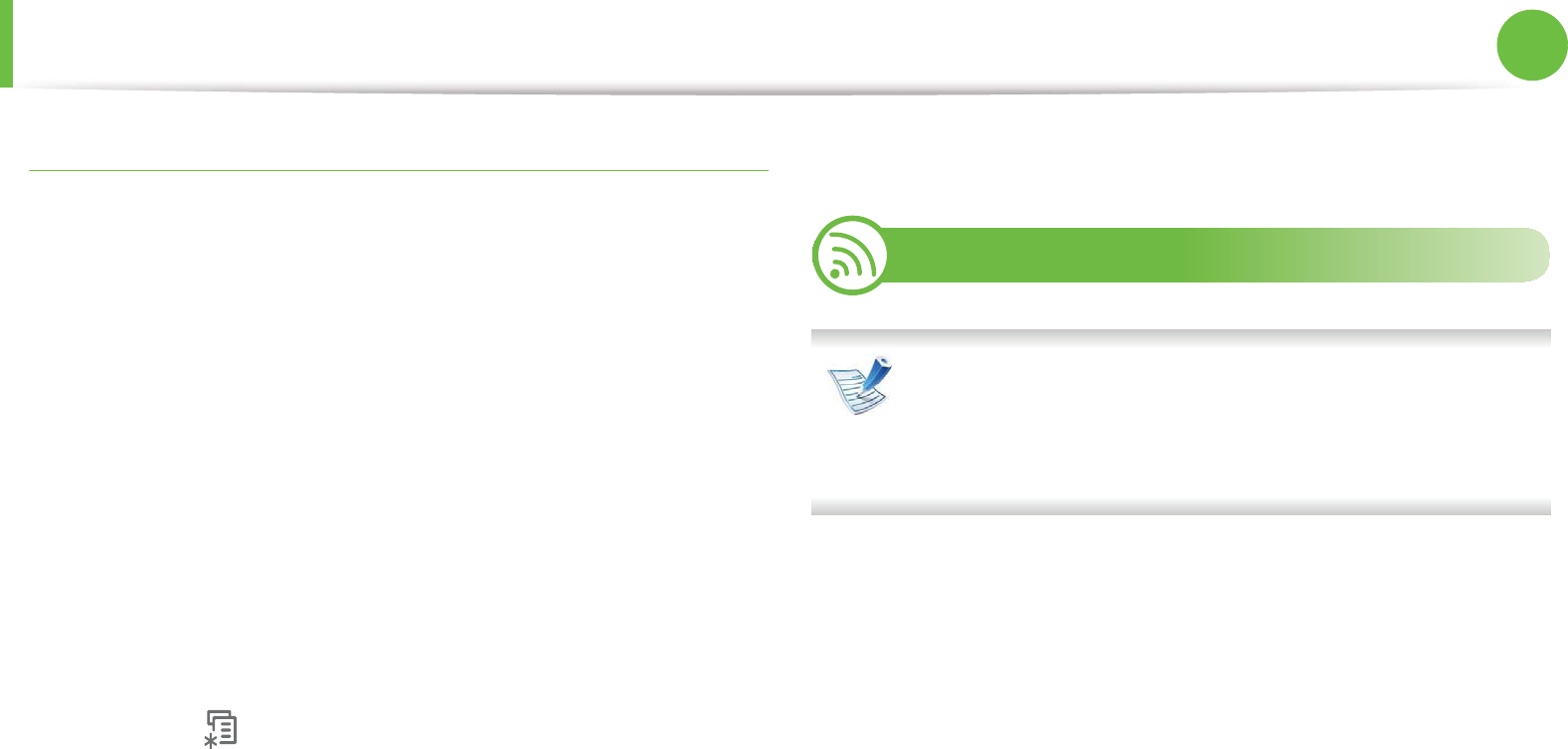
IPv6 configuration 29
2. Using a network-connected machine
Setting IPv6 addresses
The machine supports the following IPv6 addresses for network
printing and managements.
•Link-local Address: Self-configured local IPv6 address (Address
starts with FE80).
•Stateless Address: Automatically configured IPv6 address by a
network router.
•Stateful Address: IPv6 address configured by a DHCPv6 server.
•Manual Address: Manually configured IPv6 address by a user.
ŹDHCPv6 address configuration (Stateful)
If you have a DHCPv6 server on your network, you can set one of the
following options for default dynamic host configuration.
1Press the (Menu) button on the control panel.
2 Press Network > OK > TCP/IP (IPv6) > OK > DHCPv6 Config.
3 Press OK to select the required value you want.
•DHCPv6 Addr.: Always use DHCPv6 regardless of router
request.
•DHCPv6 Off: Never use DHCPv6 regardless of router
request.
•Router: Use DHCPv6 only when requested by a router.
11
From the SyncThru™ Web Service
For models that do not have the display screen on the
control panel, you need to access SyncThru™ Web Service
first using the IPv4 address and follow the below procedure
to use IPv6.
1Access a web browser, such as Internet Explorer, from
Windows.GEnter the machine IP address (http://
xxx.xxx.xxx.xxx) in the address field and press the Enter key or
click Go.
2 If it’s your first time logging into SyncThru™ Web Service you
need to log-in as an administrator.GTGGGG
GpkGGU
•ID: admin
•Password: sec00000
3 When the SyncThru™ Web Service window opens, move the
mouse cursor over the Settings of the top menu bar and then
click Network Settings.

IPv6 configuration 30
2. Using a network-connected machine
4 Click TCP/IPv6 on the left pane of the website.
5 Check the IPv6 Protocol check box to activate IPv6.
6 Check the Manual Address check box. Then, the Address/
Prefix text box is activated.
7 Enter the rest of the address (e.g.,:3FFE:10:88:194::AAAA. “A” is
the hexadecimal 0 through 9, A through F).
8 Choose the DHCPv6 configuration.
9 Click the Apply button.
Using SyncThru™ Web Service
1Start a web browser, such as Internet Explorer, that supports
IPv6 addressing as a URL.
2 Select one of the IPv6 addresses (Link-local Address,
Stateless Address, Stateful Address, Manual Address) from
Network Configuration Report (see "Printing a network
configuration report" on page 13).
3 Enter the IPv6 addresses (e.g.,: http://
[FE80::215:99FF:FE66:7701]).
Address must be enclosed in '[ ]' brackets.
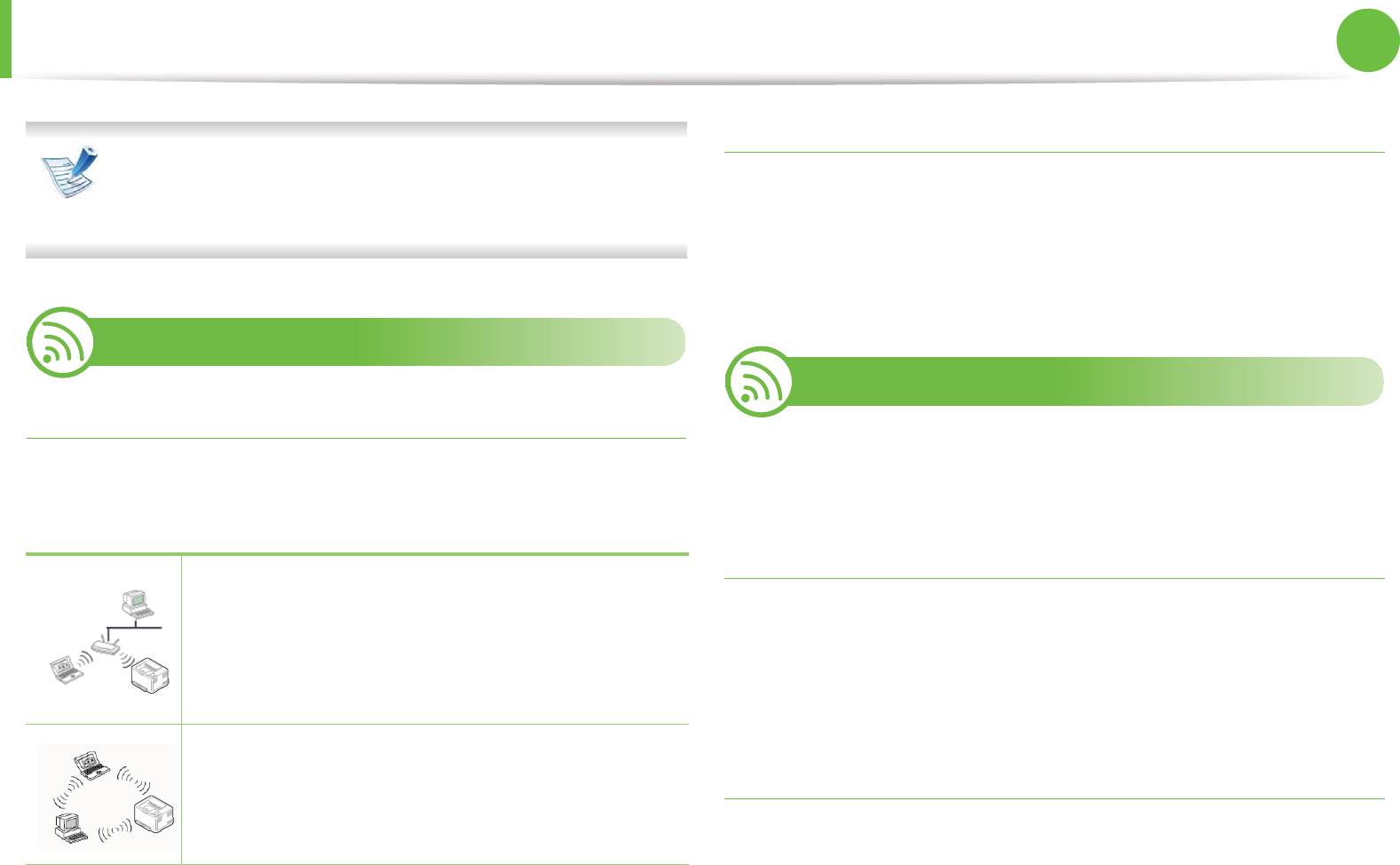
31
2. Using a network-connected machine
Wireless network setup
Make sure your machine supports a wireless network.
Wireless network may not be available depending on the
model.
12
Getting started
Understanding your network type
Typically, you can only have one connection between your
computer and the machine at a time.
Wireless network name and network key
Wireless networks require higher security, so when an access point is
first set up, a network name (SSID), the type of security used, and a
Network Key are created for the network. Locate this information
before proceeding with the machine installation.
13
Choosing the installation type
You can install a wireless network from the machine’s control panel
or the computer.
From the control panel
You can configure wireless parameters with the control panel.
• See "Using the WPS button" on page 32.
• See "Using the menu button" on page 36.
From the computer
From the computer, we recommend using a USB cable with the
program provided in the supplied software CD
• See "Setup using Windows" on page 38.
• See "Setup using Macintosh" on page 46.
Infrastructure mode
This is an environment generally used for homes and
SOHOs (Small Office/ Home Office). This mode uses
an access point to communicate with the wireless
machine.
Ad hoc mode
This mode does not use an access point. The wireless
computer and wireless machine communicates
directly.
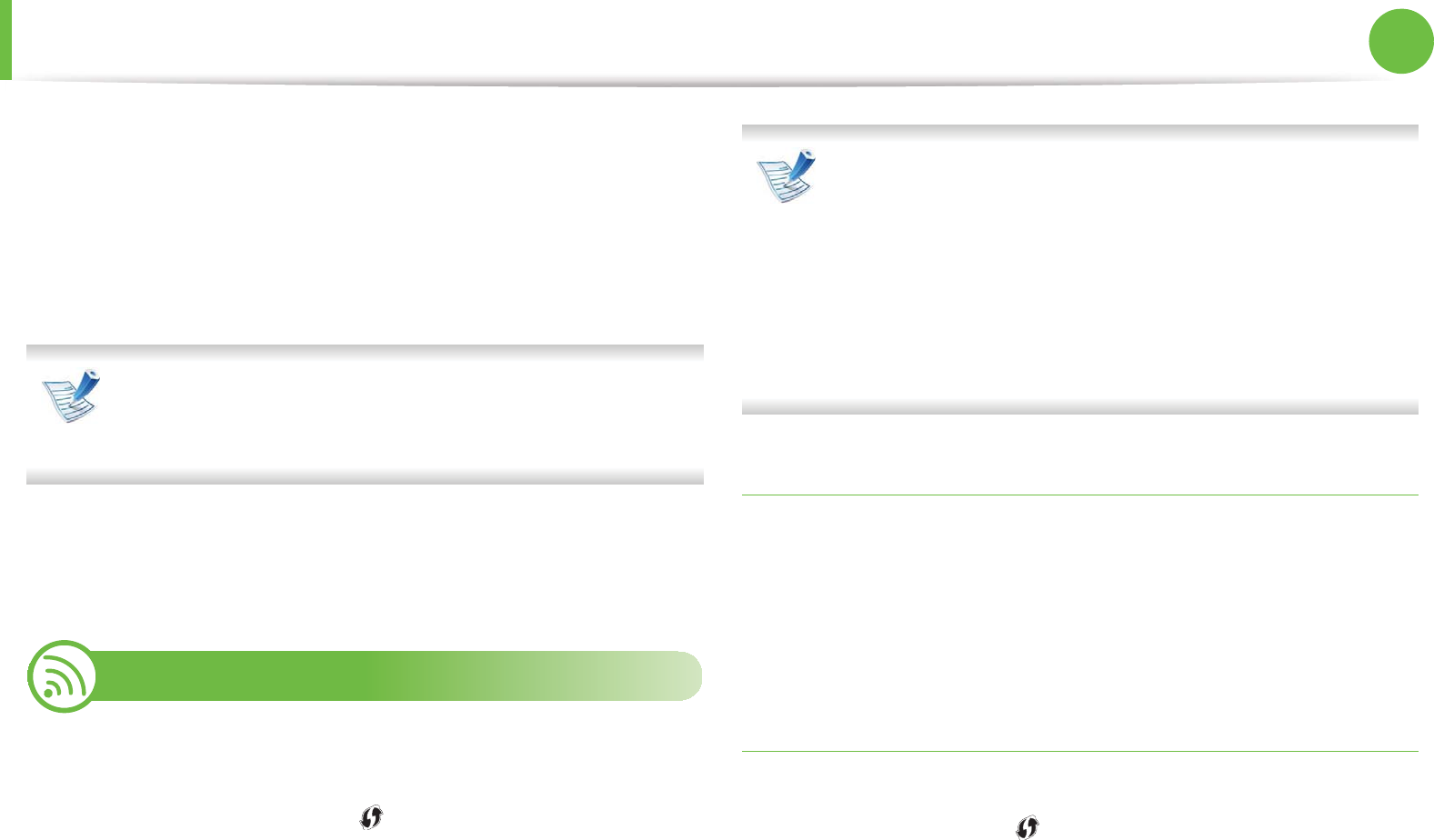
Wireless network setup 32
2. Using a network-connected machine
•With a USB cable: You can simply set up a wireless network
using the program on the supplied software CD. Only Windows
and Macintosh operating systems are supported (see "Setup
using Windows" on page 38 or "Setup using Macintosh" on page
46).
You can also install a wireless network in Printer Settings
Utility with a USB cable after installing the driver (Windows
and Macintosh operating systems are supported).
•With a network cable: You can set up a wireless network using
the SyncThru™ Web Service program (see "Using a network
cable" on page 52).
14
Using the WPS button
If your machine and an access point (or wireless router) support Wi-
Fi Protected Setup™ (WPS), you can easily configure the wireless
network settings by pressing the (WPS) button on the control
panel without a computer.
If you want to use the wireless network using the
infrastructure mode, make sure that the network cable is
disconnected from the machine. Using the WPS (PBC)
button or entering the PIN from the computer to connect to
the access point (or wireless router) varies depending on the
access point (or wireless router) you are using. Refer to the
user's guide of the access point (or wireless router) you are
using.
Items to prepare
• Check if the access point (or wireless router) supports Wi-Fi
Protected Setup™ (WPS).
• Check if your machine supports Wi-Fi Protected Setup™ (WPS).
• Networked computer (PIN mode only)
Choosing your type
There are two methods available to connect your machine to a
wireless network using the (WPS) button on the control panel.
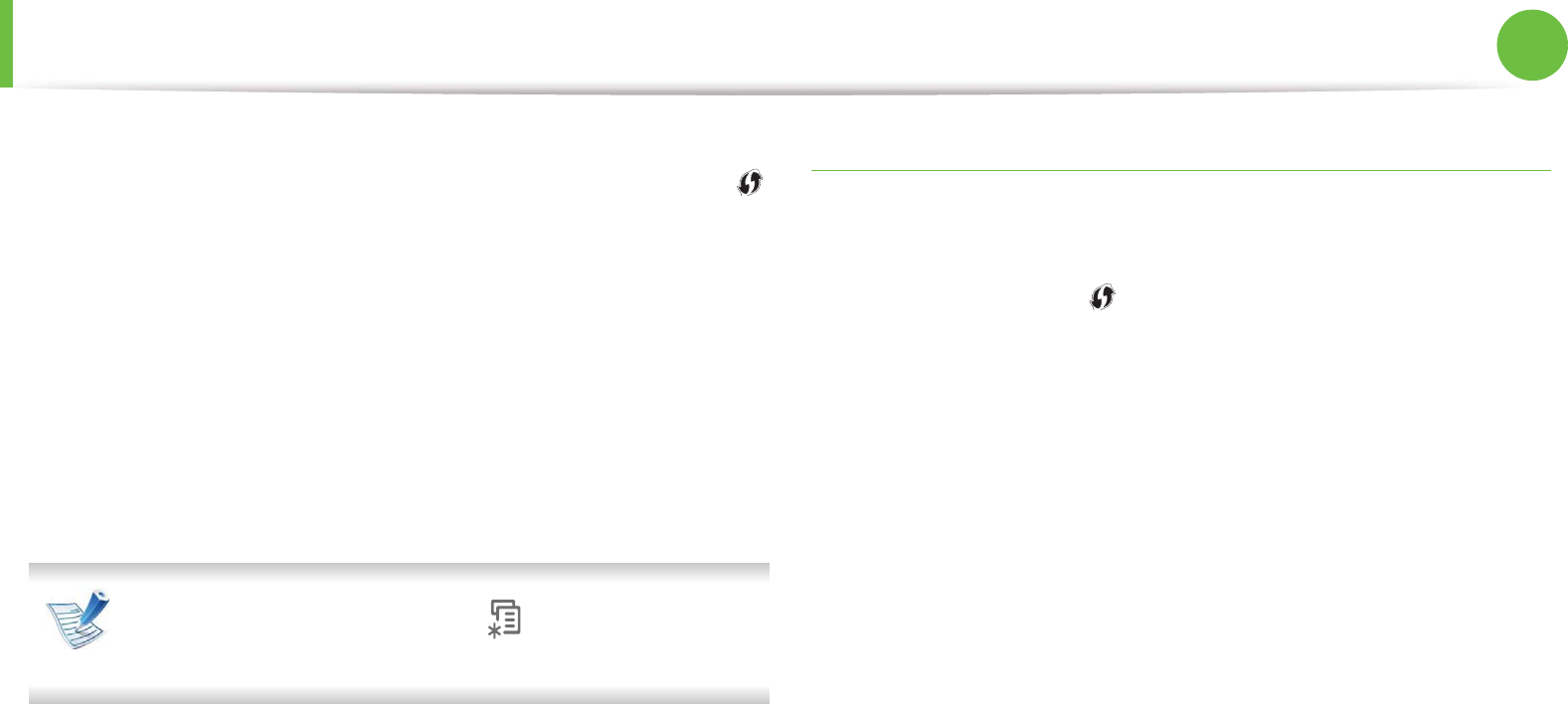
Wireless network setup 33
2. Using a network-connected machine
The Push Button Configuration (PBC) method allows you to
connect your machine to a wireless network by pressing both the
(WPS) button on the control panel of your machine and the WPS
(PBC) button on a Wi-Fi Protected Setup™ (WPS)-enabled access
point (or wireless router) respectively.
The Personal Identification Number (PIN) method helps you
connect your machine to a wireless network by entering the
supplied PIN information on a Wi-Fi Protected Setup™ (WPS)-
enabled access point (or wireless router).
Factory default in your machine is PBC mode, which is
recommended for a typical wireless network environment.
To changeGthe WPS mode , press (Menu) > NetworkG>G
Wireless > OK > WPS Setting.
Machines with an display screen
ŹConnecting in PBC mode
1Press and hold the (WPS) button on the control panel for
more than 2 seconds.
The machine starts waiting for up to two minutes until you
press the WPS (PBC) button on the access point (or wireless
router).
2 Press the WPS (PBC) button on the access point (or wireless
router).
The messages are displayed on the display screen in the order
below:
a Connecting: The machine is connecting to the access
point (or wireless router).
b Connected: When the machine is successfully connected
to the wireless network, the WPS LED light stays on.
c AP SSID: After completing the wireless network
connection process, the AP’s SSID information appears on
the display.

Wireless network setup 34
2. Using a network-connected machine
ŹConnecting in PIN mode
1Press and hold the (WPS) button on the control panel for
more than 2 seconds.
2 The eight-digit PIN appears on the display.
You need to enter the eight-digit PIN within two minutes to
the computer which is connected to the access point (or
wireless router).
The messages are displayed on the display screen in the order
below:
a Connecting: The machine is connecting to the wireless
network.
b Connected: When the machine is successfully connected
to the wireless network, the WPS LED light stays on.
c AP SSID: After completing the wireless network
connection process, the AP’s SSID information is diplayed
on the LCD display.
Machines without an display screen
ŹConnecting in PBC mode
1Press and hold the (WPS) button on the control panel for
about 2 - 4 seconds until the status LED blinks quickly.
The machine starts connecting to the wireless network. The
LED blinks slowly for up to two minutes until you press the PBC
button on the access point (or wireless router).
2 Press the WPS (PBC) button on the access point (or wireless
router).
a The light blinks fast on the WPS LED. The machine is
connecting to the access point (or wireless router).
b When the machine is successfully connected to the
wireless network, the WPS LED light stays on.
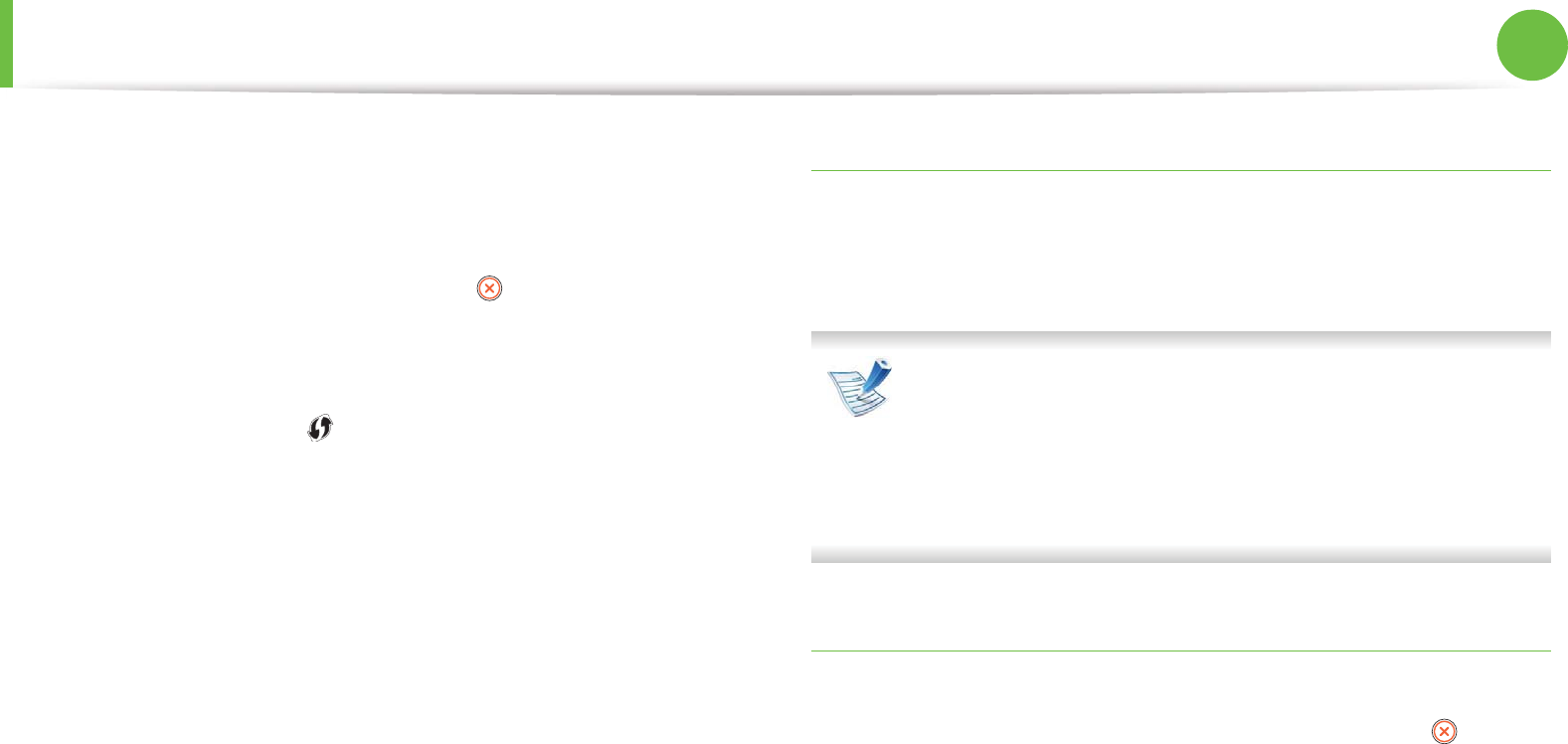
Wireless network setup 35
2. Using a network-connected machine
ŹConnecting in PIN mode
1The network configuration report, including PIN, must be
printed.
In ready mode, press and hold the (Cancel or Stop/Clear)
button on the control panel for about 5 seconds. You can find
your machine’s PIN number.
2 Press and hold the (WPS) button on the control panel for
more than 4 seconds until the status LED stays on.
The machine starts connecting to the access point (or wireless
router).
3 You need to enter the eight-digit PIN within two minutes on
the computer that is connected to the access point (or
wireless router).
The LED blinks slowly for up to two minutes until you enter the
eight-digit PIN.
The WPS LED blinks in the order below:
a The light blinks fast on the WPS LED. The machine is
connecting to the access point (or wireless router).
b When the machine is successfully connected to the
wireless network, the WPS LED light stays on.
Re-connecting to a network
When the wireless function is off, the machine automatically tries to
re-connect to the access point (or wireless router) with the
previously used wireless connection settings and address.
In the following cases, the machine automatically re-
connects to the wireless network:
• The machine is turned off and on again.
• The access point (or wireless router) is turned off and on
again.
Canceling the connection process
To cancel the wireless network connection when the machine is
connecting to the wireless network, press and release the (Cancel
or Stop/Clear) button on the control panel. You need to wait 2
minuites to re-connect to the wireless network.
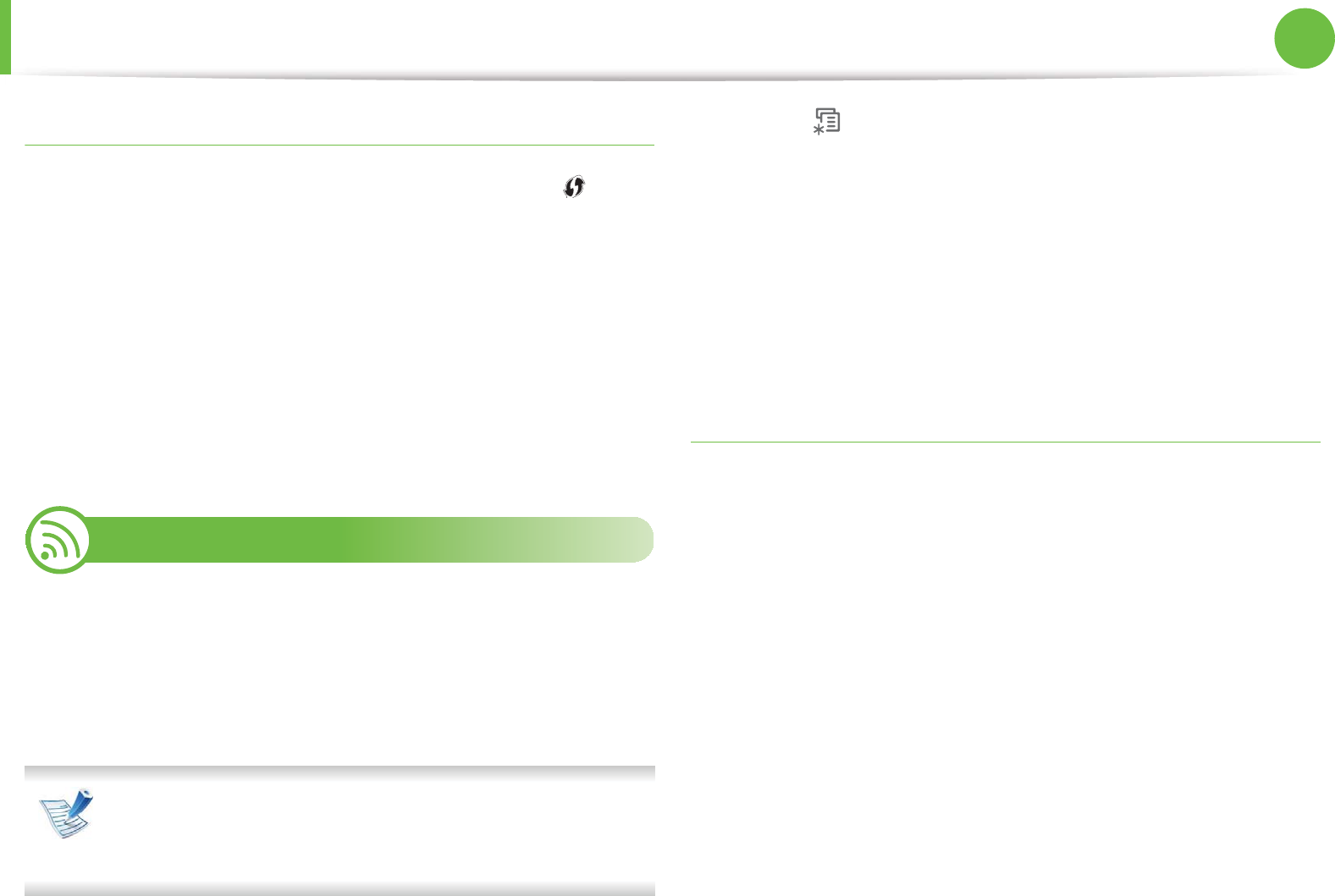
Wireless network setup 36
2. Using a network-connected machine
Disconnecting from a network
To disconnect the wireless network connection, press the (WPS)
button on the control panel for more than two seconds.
•When the Wi-Fi network is in idle mode: The machine is
immediately disconnected from the wireless network, and the
WPS LED is off.
•When the Wi-Fi network is being used: While the machine
waits until the current job is finished, the light blinks fast on the
WPS LED. Then, the wireless network connection is automatically
disconnected. The WPS LED is off.
15
Using the menu button
Before starting, you will need to know the network name (SSID) of
your wireless network and the network key if it is encrypted. This
information was set when the access point (or wireless router) was
installed. If you do not know about your wireless environment,
please ask the person who set up your network.
After completing the wireless network connection, you need
to install a machine driver to print from an application (see
"Installing driver over the network" on page 17).
1Select (Menu) > Network > OK > Wireless > OK > WLAN
Settings > OK on the control panel.
2 Press the OK to select the setup method you want.
•Wizard: The wireless network interface card in your
machine searches for wireless networks in the area and
shows the results.
•Custom: You can configure the according to your needs.
Wizard mode
1The wireless network interface card on your machine searches
for wireless networks in the area and shows the results.
2 Press Search List > OK > select the network > OK.
You can select a network using SSID.
3 Press WLAN Security > OK > None > OK.
If you see another message, go to the next step.

Wireless network setup 37
2. Using a network-connected machine
4 According to the network you selected, the WLAN security
encryption type will be WEP or WPA.
• In case of WEP, press the Open System or SharedKey.
-Open System: Authentication is not used, and
Encryption may or may not be used, depending on the
need for data security. Enter the WEP Key after
selecting Open System.
-SharedKey: Authentication is used. A device that has
a proper WEP Key can access the network. Enter the
WEP Key after selecting SharedKey.
•In case of WPA, enter the WPA Key. The key length should
be between 8 and 63 characters long.
5 Press OK.
Custom mode
1Enter the SSID when Edit SSID appears on the top line of the
display, the name that identifies a wireless network. SSID is
case-sensitive so you need to enter it carefully. Press OK.
2 Select the type of wireless connections.
3 Press OK to select the method of Operation Mode.
•Ad-hoc: Allows wireless devices to communicate directly
with each other in a peer-to-peer environment. Go to step
4.
•Infrastructure: Allows wireless devices to communicate
with each other through an access point. Go to step 5.
4 Press OK to select the method of Channel.
If you select Auto, the wireless network interface card on your
machine will automatically adjust the channels.
5 Press OK to select the method of WLAN Security.
•None: This is used when the validation of a wireless
device’s identity and data encryption are not required for
your network. Open system is used for IEEE 802.11
authentication.
•Static WEP: This uses the WEP (Wired Equivalent Privacy)
algorithm suggested by IEEE 802.11 standard for security.
Static WEP security mode requires a proper WEP key for
data encryption, decryption, and IEEE 802.11
authentication. Press OK to select the setup method in
Authentication
-Open System: Authentication is not used, and
encryption may or may not be used, depending on the
need for data security. Enter the WEP Key.
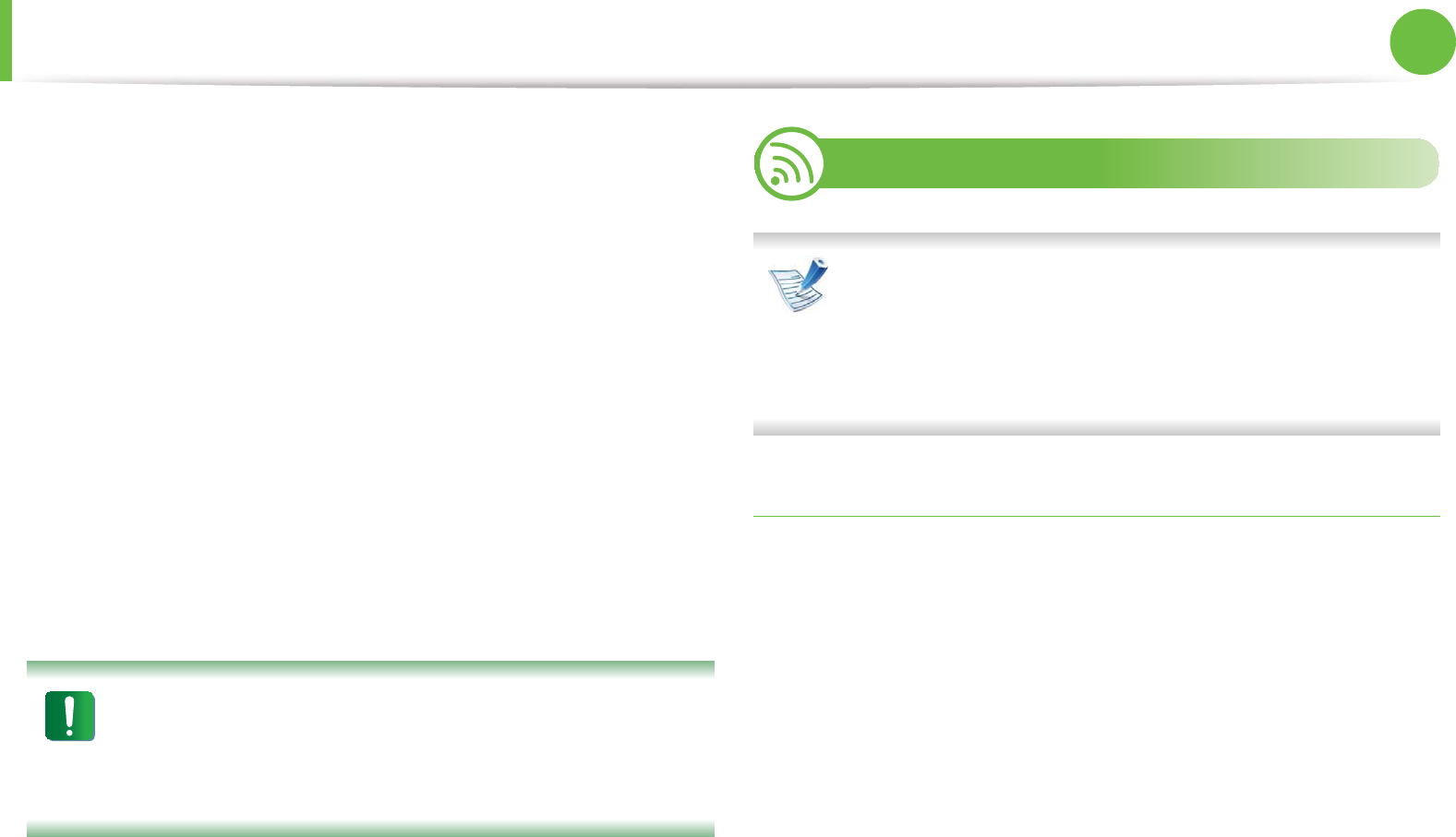
Wireless network setup 38
2. Using a network-connected machine
-SharedKey: Authentication is used. Enter the WEP
Key after selecting SharedKey.
•WPA-PSK or WPA2-PSK: You can select WPA-PSK or
WPA2-PSK to authenticate the print server based on WPA
Pre-Shared Key. This uses a shared secret key (generally
called Pre-Shared Key passphrase), which is manually
configured on the access point and each of its clients.
a Press OK when WPA-PSK or WPA2-PSK appears of on
the display.
b Press OK to select TKIP or AES in Encryption. If you
select WPA2-PSK, press OK to select AES or TKIP +
AES in Encryption.
c Enter the WPA Key.
6 Press OK.
Disconnect the network cable (standard or crossover). Your
machine should then start communicating wirelessly with
the network. In case of Ad-hoc mode, you can use a wireless
LAN and wired LAN simultaneously.
16
Setup using Windows
Shortcut to Wireless Setting program without CD: If you
have installed the printer driver once, you can access the
Wireless Setting program without CD. From the Start menu,
select Programs or All Programs > Samsung Printers >
your printer driver name > Wireless Setting Program.
Access point via USB cable
ŹItems to prepare
•Access point
• Network-connected computer
• Software CD that was provided with your machine
• The machine installed with a wireless network interface
•USB cable
ŹCreating the infrastructure network
1Check whether the USB cable is connected to the machine.
2 Turn on your computer, access point, and machine.
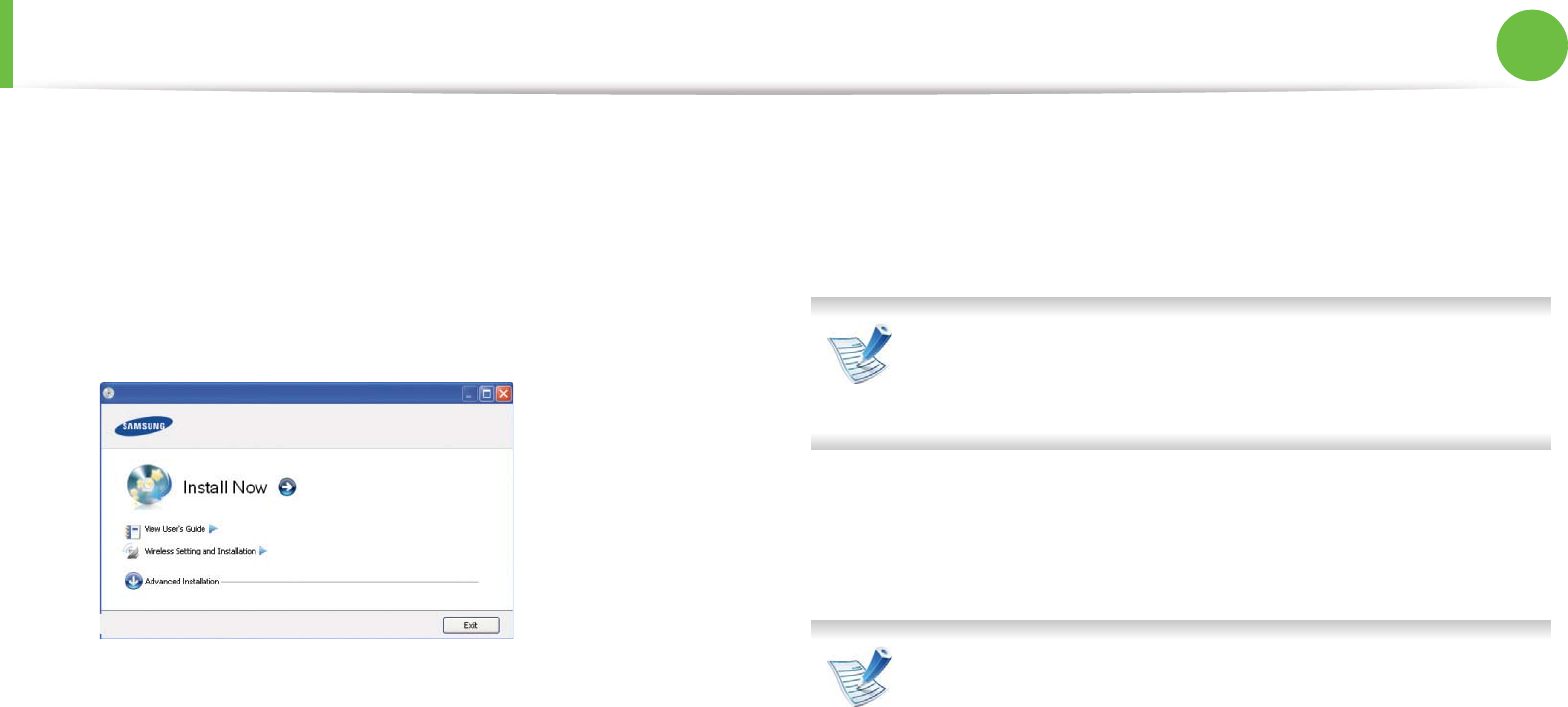
Wireless network setup 39
2. Using a network-connected machine
3 Insert the supplied software CD into your CD-ROM drive.
Click Start > All programs > Accessories > Run.
Type X:\Setup.exe replacing “X” with the letter, which
represents your CD-ROM drive and click OK.
4 Select the Wireless Setting and Installation option.
•Install Now: If you have already set up the wireless
network, click this button to install the machine’s driver to
use the wireless network machine. If you have not set up
the wireless network, click the Wireless Setting and
Installation button to set up the wireless network before
you click this button.
•Wireless Setting and Installation: Configure the wireless
network settings of your machine with a USB cable then
install the machine driver. This is only for users who have
not set up the wireless connection before.
5 Read the License Agreement, and select I accept the terms
of the License Agreement. Then, click Next.
6 The software searches the wireless network.
If the search has failed, you may check if the USB cable is
properly connected between the computer and machine,
and follow the instructions on the window.
7 After searching, the window shows the wireless network
devices. Select the name (SSID) of the access point you are
using and click Next.
If you cannot find the network name you want to choose, or
if you want to set the wireless configuration manually, click
Advanced Setting.
•Enter the wireless Network Name: Enter the SSID of
access point you want (SSID is case-sensitive).
•Operation Mode: Select Infrastructure.

Wireless network setup 40
2. Using a network-connected machine
•Authentication: Select an authentication type.
Open System: Authentication is not used, and encryption
may or may not be used, depending on the need for data
security.
Shared Key: Authentication is used. A device that has a
proper WEP key can access the network.
WPA Personal or WPA2 Personal: Select this option to
authenticate the print server based on WPA Pre-Shared
Key. This uses a shared secret key (generally called Pre-
Shared Key pass phrase) which is manually configured on
the access point and each of its clients.
•Encryption: Select the encryption (None, WEP64,
WEP128, TKIP, AES, TKIP AES).
•Network Key: Enter the encryption network key value.
•Confirm Network Key: Confirm the encryption network
key value.
•WEP Key Index: If you are using WEP Encryption, select
the appropriate WEP Key Index.
The wireless network security window appears when the
access point has security settings.
The wireless network security window appears. The window
may differ according to its security mode: WEP, or WPA.
•WEP
Select Open System or Shared Key for the authentication
and enter the WEP security key. Click Next.
WEP (Wired Equivalent Privacy) is a security protocol
preventing unauthorized access to your wireless network.
WEP encrypts the data portion of each packet exchanged
on a wireless network using a 64-bit or 128-bit WEP
encryption key.
•WPA
Enter the WPA shared key and click Next.
WPA authorizes and identifies users based on a secret key
that changes automatically at regular intervals. WPA also
uses TKIP (Temporal Key Integrity Protocol) and AES
(Advanced Encryption Standard) for data encryption.

Wireless network setup 41
2. Using a network-connected machine
8 The window shows the wireless network settings and checks
if the settings are correct. Click Next.
• For the DHCP method
If the IP address assignment method is DHCP, check if
DHCP is shown in the window. If it shows Static, click
Change TCP/IP to change the assignment method to
DHCP.
• For the Static method
If the IP address assignment method is Static, check if
Static is shown in the window. If it shows DHCP, click
Change TCP/IP to enter the IP address and other network
configuration values for the machine. Before entering the
IP address for the machine, you must know the computer’s
network configuration information. If the computer is set
to DHCP, you must contact the network administrator to
get the static IP address.
For example:
If the computer’s network information is as shown below:
- IP address: 169.254.133.42
- Subnet Mask: 255.255.0.0
Then, the machine’s network information should be as
follows:
- IP address: 169.254.133.43
- Subnet Mask: 255.255.0.0 (Use the computer’s subnet
mask.)
- Gateway: 169.254.133.1
9 When the wireless network setting is completed, disconnect
the USB cable between the computer and machine. Click
Next.
10 The Wireless Network Setting Complete window appears.
Select Yes if you accept the current settings and continue the
setup procedure.
Select No if you want to return to the beginning screen.
Then, click Next.
11 Click Next when the Confirm Printer Connection window
appears.
12 Select the components to be installed. Click Next.
13 After selecting the components, you can also change the
machine name, set the machine to be shared on the network,
set the machine as the default machine, and change the port
name of each machine. Click Next.

Wireless network setup 42
2. Using a network-connected machine
14 After the installation is finished, a window asking you to print
a test page appears. If you want to print a test page, click Print
a test page.
Otherwise, just click Next and go to step 16.
15 If the test page prints out correctly, click Yes.
If not, click No to reprint it.
16 To register as a user of the machine in order to receive
information from Samsung, click On-line Registration.
17 Click Finish.
Ad hoc via USB cable
If you do not have an access point (AP), you may still connect the
machine wirelessly to your computer by setting up an ad-hoc
wireless network by following the simple steps below.
ŹItems to prepare
• Network-connected computer
• Software CD that was provided with your machine
• The machine installed with a wireless network interface
•USB cable
ŹCreating the ad hoc network in Windows
1Check whether the USB cable is connected to the machine.
2 Turn on your computer and the wireless network machine.
3 Insert the supplied software CD into your CD-ROM drive.
Click Start > All programs > Accessories > Run.
Type X:\Setup.exe replacing “X” with the letter, which
represents your CD-ROM drive and click OK.
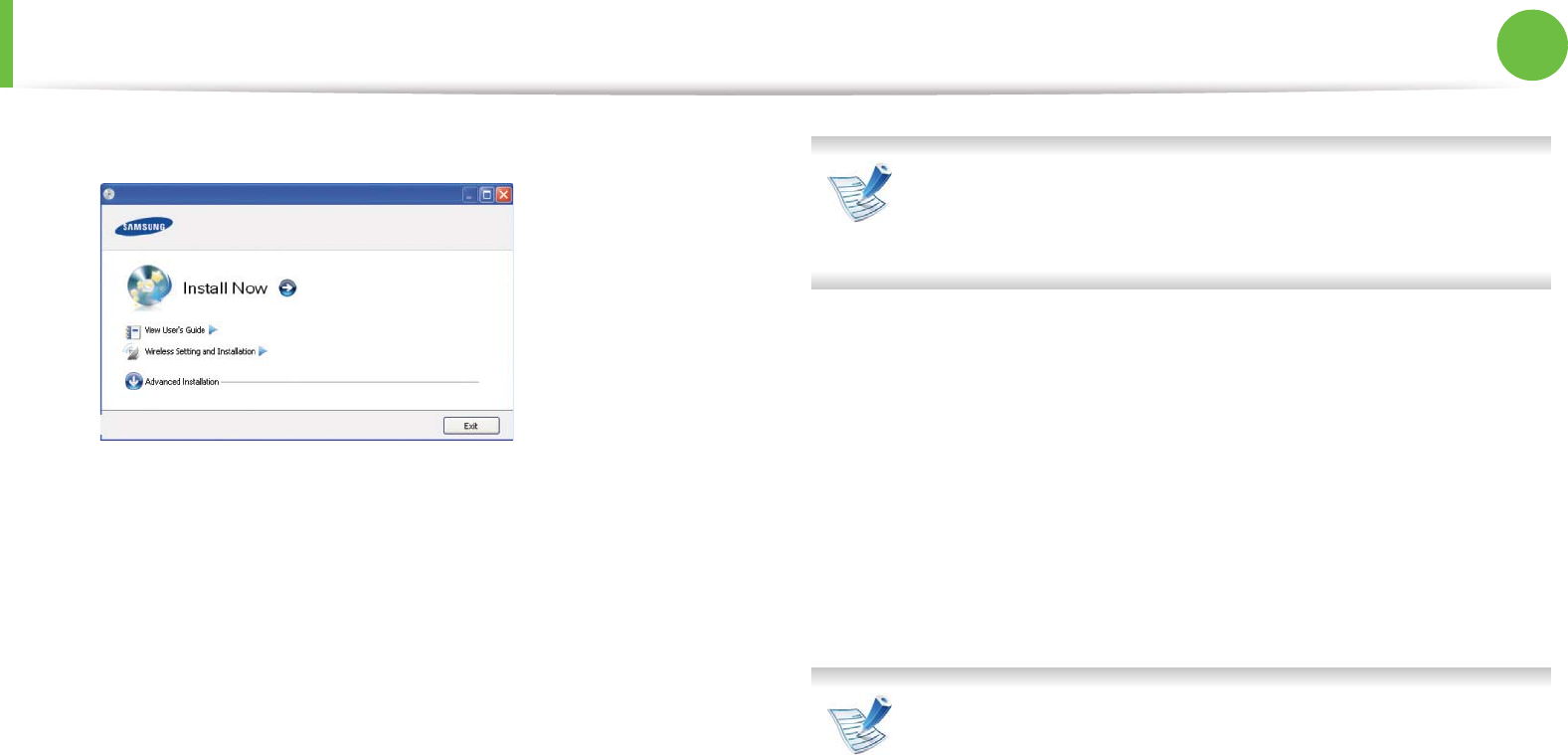
Wireless network setup 43
2. Using a network-connected machine
4 Select the Wireless Setting and Installation option.
•Install Now: If you have set the wireless network, click this
button to install the machine’s driver to use the wireless
network machine. If you have not set the wireless network,
click Wireless Setting and Installation button to set the
wireless network before you click this button.
•Wireless Setting and Installation: Configure the wireless
network settings of your machine’s with a USB cable then
install the machine driver. This only for users who have not
set up the wireless connection before.
5 Read the License Agreement, and select I accept the terms
of the License Agreement. Then, click Next.
6 The software searches the wireless network.
If the software has failed to search the network, check if the
USB cable is connected properly between the computer and
machine, and follow the instruction in the window.
7 After searching the wireless networks, a list of wireless
networks your machine has searched appears.
If you want to use the Samsung default ad hoc setting, select
the last wireless network on the list, Network Name(SSID) is
portthru and Signal is Printer Self Network.
Then, click Next.
If you want to use other ad hoc settings, select another
wireless network from the list.
If you want to change ad hoc settings click the Advanced
Setting button.
•Enter the wireless Network Name: Enter the SSID name
you want (SSID is case-sensitive).
•Operation Mode: Select ad hoc.
•Channel: Select the channel. (Auto Setting or 2412 MHz
to 2467 MHz).
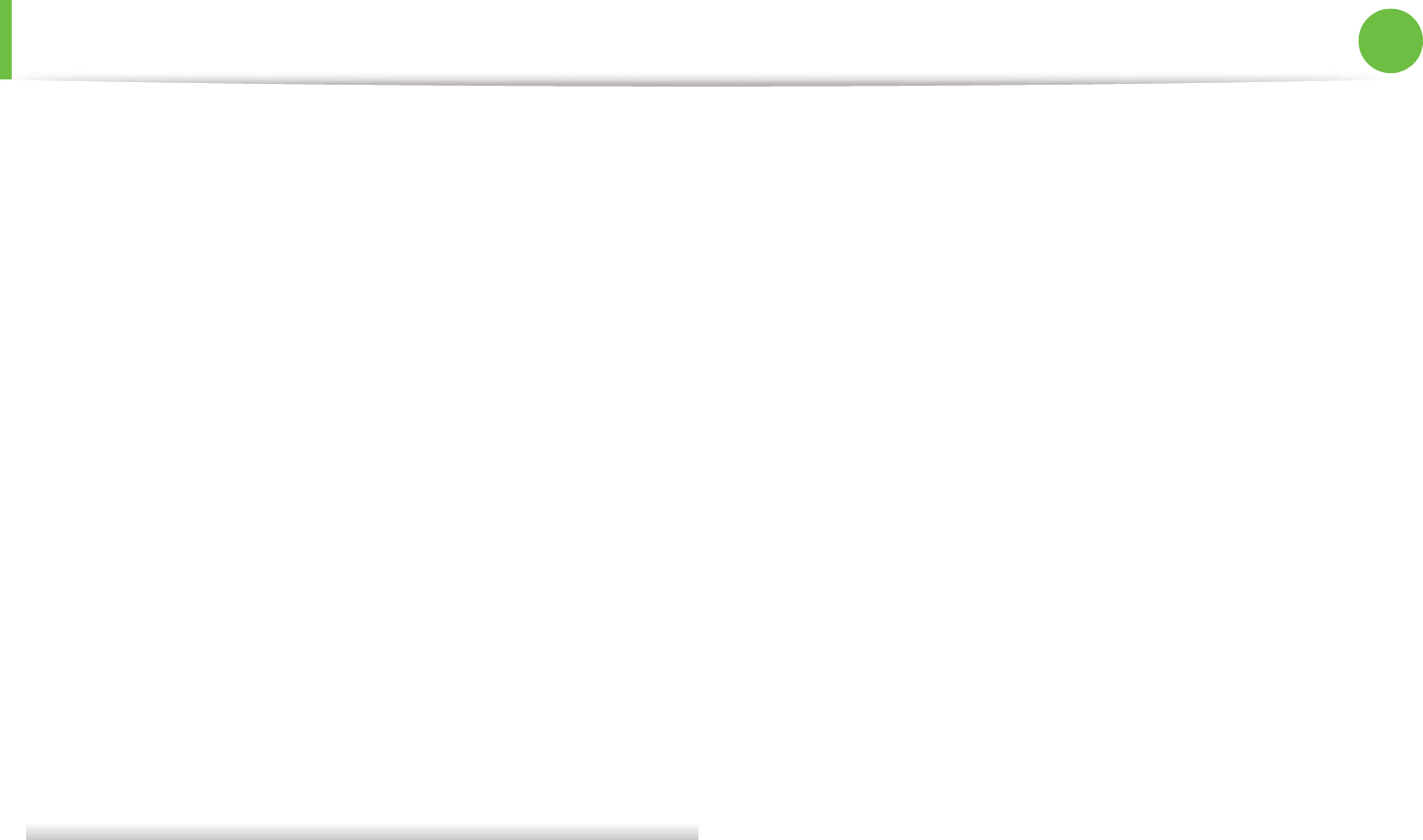
Wireless network setup 44
2. Using a network-connected machine
•Authentication: Select an authentication type.
Open System: Authentication is not used, and encryption
may or may not be used, depending on the need for data
security.
Shared Key: Authentication is used. A device that has a
proper WEP key can access the network.
•Encryption: Select the encryption (None, WEP64,
WEP128).
•Network Key: Enter the encryption network key value.
•Confirm Network Key: Confirm the encryption network
key value.
•WEP Key Index: If you are using WEP Encryption, select
the appropriate WEP Key Index.
The wireless network security window appears when the ad
hoc network has security setting.
The wireless network security window appears. Select Open
System or Shared Key for the authentication and click Next.
• WEP (Wired Equivalent Privacy) is a security protocol
preventing unauthorized access to your wireless network.
WEP encrypts the data portion of each packet exchanged
on a wireless network using a 64-bit or 128-bit WEP
encryption key.
8 The window showing the wireless network setting appears.
Check the settings and click Next.
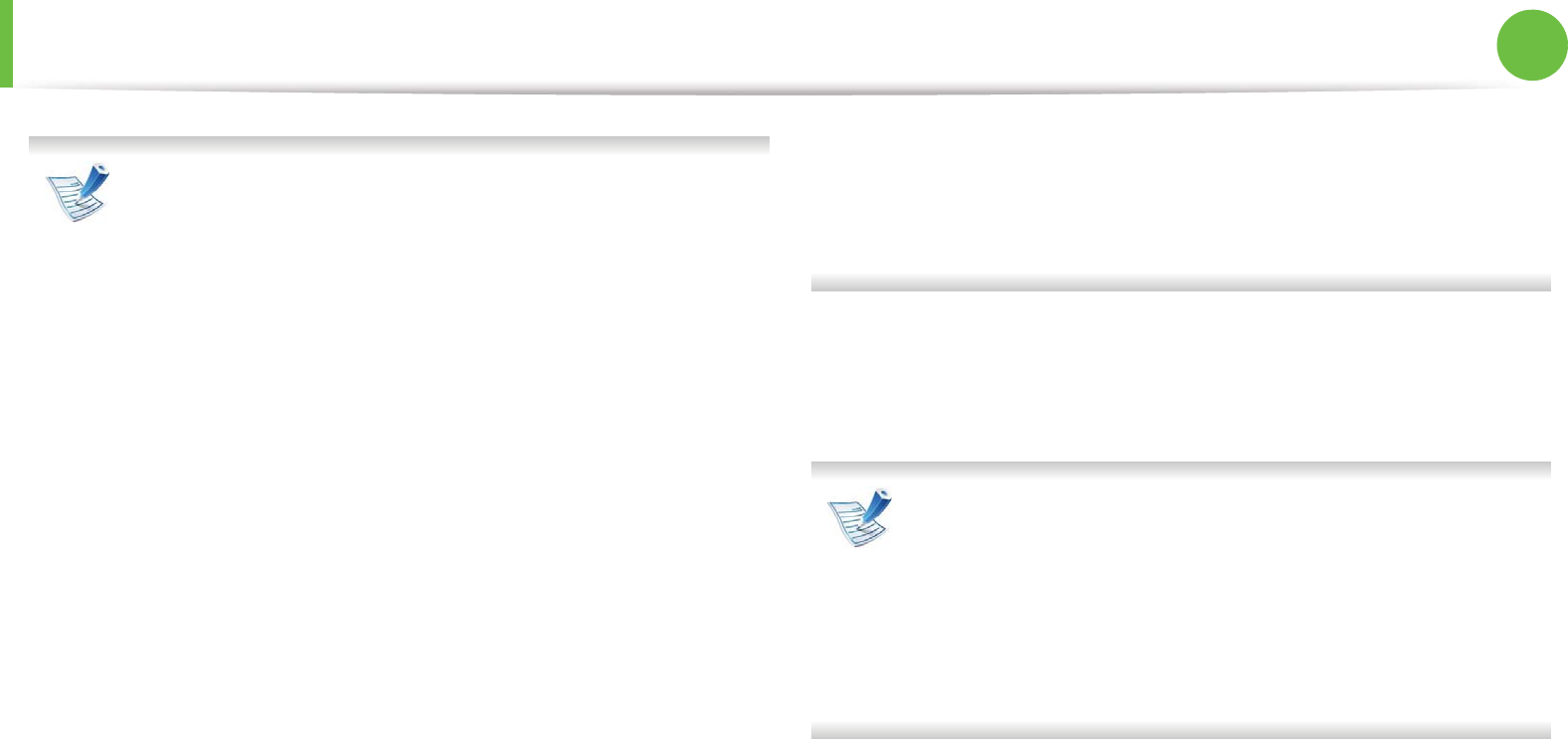
Wireless network setup 45
2. Using a network-connected machine
Before entering the IP address for the machine, you must
know the computer’s network configuration information. If
the computer’s network configuration is set to DHCP, the
wireless network setting should also be DHCP. Likewise, if
the computer’s network configuration is set to Static, the
wireless network setting should also be Static.
If your computer is set to DHCP and you want to use the
Static wireless network setting, you must contact the
network administrator to get the static IP address.
•For the DHCP method
If the IP address assignment method is DHCP, check if
DHCP is shown in the Wireless Network Setting Confirm
window. If it shows Static, click Change TCP/IP to change
the assignment method to Receive IP address
automatically (DHCP).
•For the Static method
If the IP address assignment method is Static, check if
Static is shown in the Wireless Network Setting Confirm
window. If it shows DHCP, click Change TCP/IP to enter
the IP address and other network configuration values for
the machine.
For example:
If the computer’s network information is as shown follows:
- IP address: 169.254.133.42
- Subnet Mask: 255.255.0.0
Then, the machine’s network information should be as
below:
- IP address: 169.254.133.43
- Subnet Mask: 255.255.0.0 (Use the computer’s subnet
mask.)
- Gateway: 169.254.133.1
9 When the wireless network settings are completed,
disconnect the USB cable between the computer and
machine. Click Next.
If the Change PC Network Setting window appears, follow
the steps in the window.
Click Next if you are finished with the computer’s wireless
network settings.
If you set the computer’s wireless network on DHCP, it will
take several minutes to receive the IP address.
10 The Wireless Network Setting Complete window appears.
Select Yes if you accept the current settings and continue the
setup procedure.
Select No if you want to return to the beginning screen.
Then, click Next.
11 Click Next when the Confirm Printer Connection window
appears.
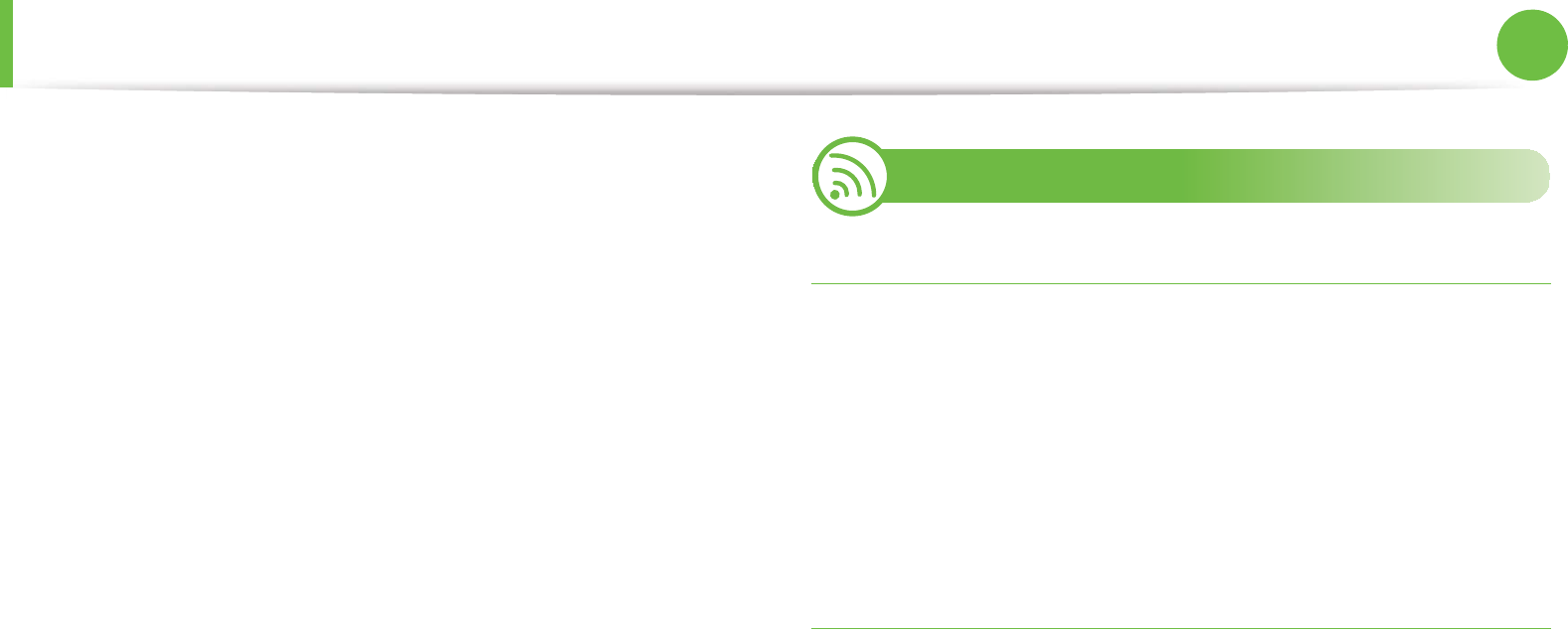
Wireless network setup 46
2. Using a network-connected machine
12 Select the components to be installed. Click Next.
After selecting the components, you can also change the
machine name, set the machine to be shared on the network,
set the machine as the default machine, and change the port
name of each machine. Click Next.
13 After the installation is finished, a window asking you to print
a test page appears. If you want to print a test page, click Print
a test page.
Otherwise, just click Next and go to step 15.
14 If the test page prints out correctly, click Yes.
If not, click No to reprint it.
15 To register as a user of the machine in order to receive
information from Samsung, click On-line Registration.
16 Click Finish.
17
Setup using Macintosh
Items to prepare
•Access point
• Network-connected computer
• Software CD that was provided with your machine
• The machine installed with a wireless network interface
•USB cable
Access point via USB cable
1Check whether the USB cable is connected to the machine.
2 Turn on your computer, access point, and machine.
3 Insert the supplied software CD into your CD-ROM drive.
4 Double-click the CD-ROM icon that appears on your
Macintosh desktop.
5 Double-click the MAC_Installer folder.
6 Double-click the Installer OS X icon.
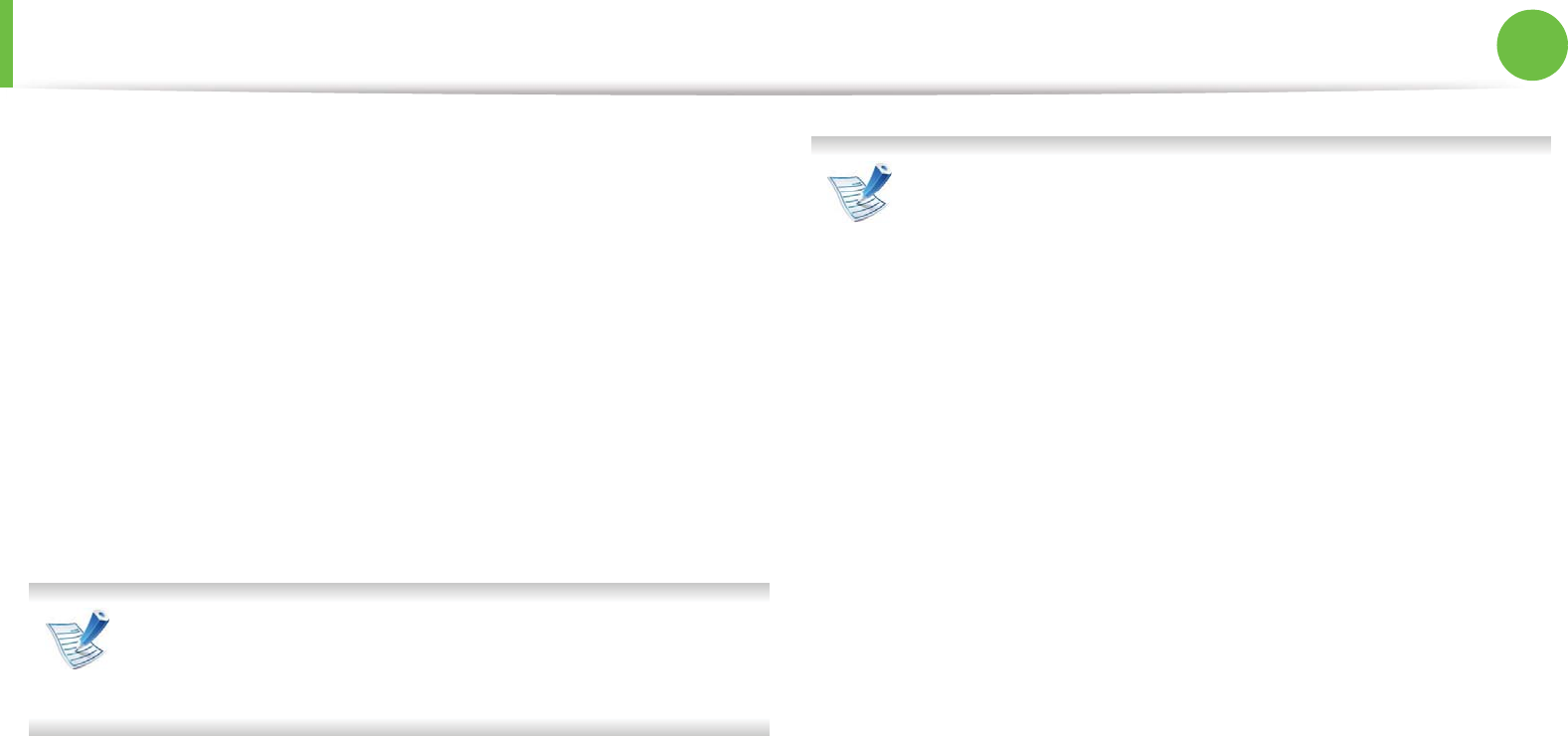
Wireless network setup 47
2. Using a network-connected machine
7 Click Continue.
8 Read the license agreement and click Continue.
9 Click Agree to agree to the license agreement.
10 When the message that warns that all applications will close
on your computer appears, click Continue.
11 Select the Wireless Network Setting.
12 The software searches the wireless network.
If the search has failed, you may check if the USB cable is
connected between the computer and machine properly,
and follow the instructions in the window.
13 After searching, the window shows the wireless network
devices. Select the name (SSID) of the access point you are
using and click Next.
When you set the wireless configuration manually, click
Advanced Setting.
•Enter the wireless Network Name: Enter the SSID of the
access point you want with (SSID is case-sensitive).
•Operation Mode: Select Infrastructure.
•Authentication: Select an authentication type.
Open System: Authentication is not used, and encryption
may or may not be used, depending on the need for data
security.
Shared Key: Authentication is used. A device that has a
proper WEP key can access the network.
WPA Personal or WPA2 Personal: Select this option to
authenticate the print server based on WPA Pre-Shared
Key. This uses a shared secret key (generally called Pre-
Shared Key pass phrase) that is manually configured on
the access point and each of its clients.
•Encryption: Select the encryption. (None, WEP64,
WEP128, TKIP, AES, TKIP, AES)
•Network Key: Enter the encryption network key value.
•Confirm Network Key: Confirm the encryption network
key value.
•WEP Key Index: If you are using WEP Encryption, select
the appropriate WEP Key Index.

Wireless network setup 48
2. Using a network-connected machine
The wireless network security window appears when the
access point has security setting.
The wireless network security window appears. The window
may differ according to its security mode: WEP or WPA.
•WEP
Select Open System or Shared Key for the authentication
and enter the WEP security key. Click Next.
WEP (Wired Equivalent Privacy) is a security protocol
preventing unauthorized access to your wireless network.
WEP encrypts the data portion of each packet exchanged
on a wireless network using a 64-bit or 128-bit WEP
encryption key.
•WPA
Enter the WPA shared key and click Next.
WPA authorizes and identifies users based on a secret key
that changes automatically at regular intervals. WPA also
uses TKIP (Temporal Key Integrity Protocol) and AES
(Advanced Encryption Standard) for data encryption.
14 The window shows the wireless network settings and check if
settings are right. Click Next.
•For the DHCP method
If the IP address assignment method is DHCP, check if
DHCP is shown in the window. If it shows Static, click
Change TCP/IP to change the assignment method to
DHCP.
•For the Static method
If the IP address assignment method is Static, check if
Static is shown in the window. If it shows DHCP, click
Change TCP/IP to enter the IP address and other network
configuration values for the machine. Before entering the
IP address for the machine, you must know the computer’s
network configuration information. If the computer is set
to DHCP, you must contact the network administrator to
get the static IP address.
For example:
If the computer’s network information is as shown follows:
- IP address: 169.254.133.42
- Subnet Mask: 255.255.0.0
Then, the machine’s network information should be as
follows:
- IP address: 169.254.133.43

Wireless network setup 49
2. Using a network-connected machine
- Subnet Mask: 255.255.0.0 (Use the computer’s subnet
mask.)
- Gateway: 169.254.133.1
15 The wireless network connects according to the network
configuration.
16 When the wireless network settings are completed,
disconnect the USB cable between the computer and
machine.
17 Follow the instructions on the screen to complete the
installation. After the installation is finished, click Quit or
Restart.
Ad hoc via USB cable
If you do not have an access point (AP), you may still connect the
machine wirelessly to your computer by setting up an ad hoc
wireless network by following these simple directions.
ŹItems to prepare
• Network-connected computer
• Software CD that provided with your machine
• The machine installed with a wireless network interface
•USB cable
ŹCreating the ad hoc network in Macintosh
1Check whether the USB cable is connected to the machine.
2 Turn on your computer and machine.
3 Insert the supplied software CD into your CD-ROM drive.
4 Double-click the CD-ROM icon that appears on your
Macintosh desktop.
5 Double-click the MAC_Installer folder > Installer OS X icon.
6 Click Continue.
7 Read the license agreement and click Continue.
8 Click Agree to agree to the license agreement.
9 When the message that warns that all applications will close
on your computer appears, click Continue.
10 Click Wireless Network Setting and Installation.
11 The software searches the wireless network devices.
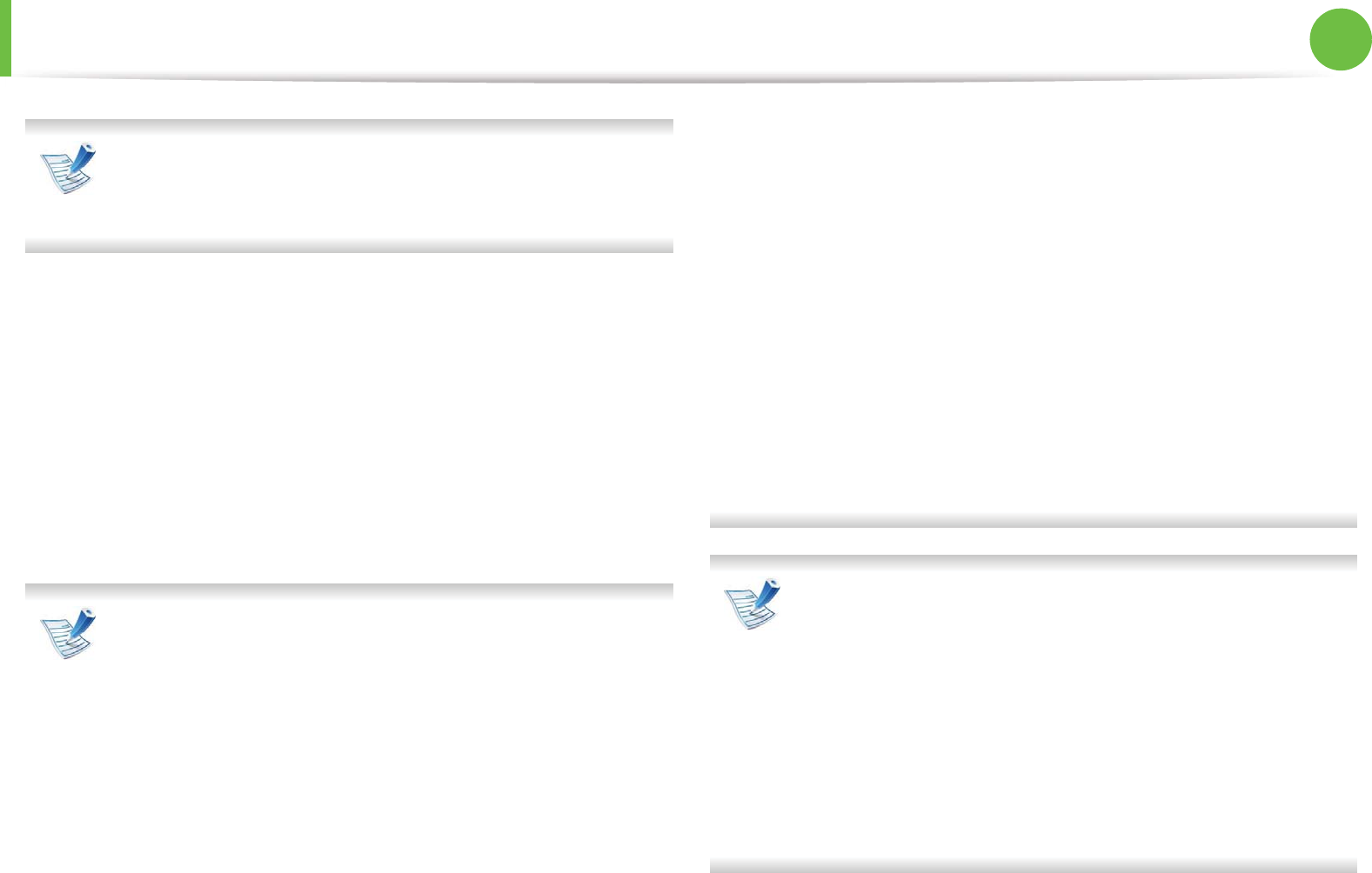
Wireless network setup 50
2. Using a network-connected machine
If the search has failed, check if the USB cable is connected
between the computer and machine properly, and follow
the instructions in the window.
12 After searching the wireless networks, a list of wireless
networks your machine has searched appears.
If you want to use the Samsung default ad hoc setting, select
the last wireless network on the list, which Network
Name(SSID) is portthru and Signal is Printer Self Network.
Then, click Next.
If you want to use other ad hoc settings, select another
wireless network from the list.
If you want to change ad hoc settings click the Advanced
Setting button.
•Enter the wireless Network Name: Enter the SSID name
you want (SSID is case-sensitive).
•Operation Mode: Select ad hoc.
•Channel: Select the channel (Auto Setting or 2412 MHz
to 2467 MHz).
•Authentication: Select an authentication type.
Open System: Authentication is not used, and encryption
may or may not be used, depending on the need for data
security.
Shared Key: Authentication is used. A device that has a
proper WEP key can access the network.
•Encryption: Select the encryption (None, WEP64,
WEP128).
•Network Key: Enter the encryption network key value.
•Confirm Network Key: Confirm the encryption network
key value.
•WEP Key Index: If you are using WEP Encryption, select
the appropriate WEP Key Index.
The wireless network security window appears when the ad
hoc network has security setting.
The wireless network security window appears. Select Open
System or Shared Key for the authentication and click Next.
• WEP (Wired Equivalent Privacy) is a security protocol
preventing unauthorized access to your wireless network.
WEP encrypts the data portion of each packet exchanged
on a wireless network using a 64-bit or 128-bit WEP
encryption key.

Wireless network setup 51
2. Using a network-connected machine
13 The window showing the wireless network settings appears.
Check the settings and click Next.
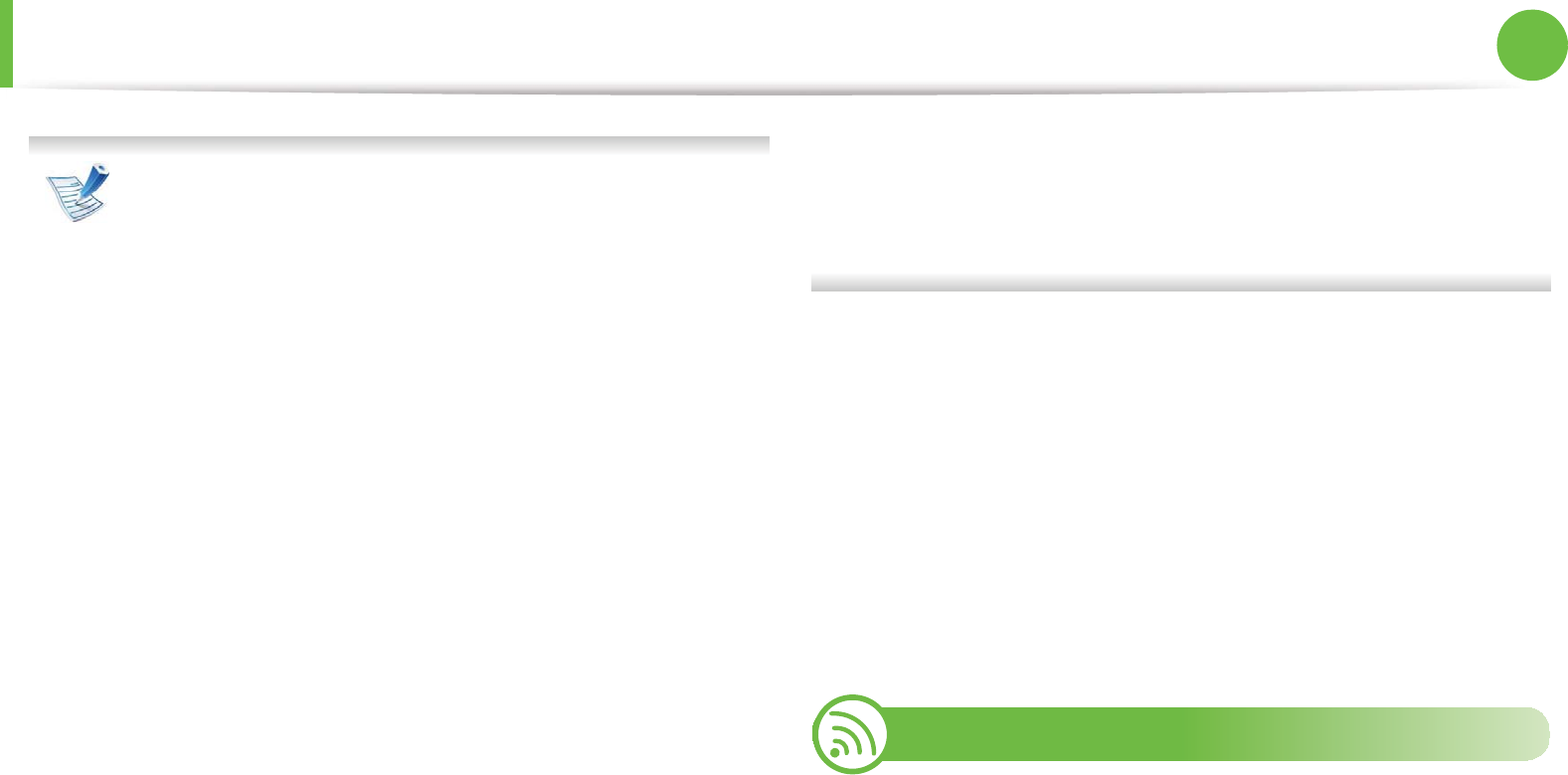
Wireless network setup 52
2. Using a network-connected machine
Before entering the IP address for the machine, you must
know the computer’s network configuration information. If
the computer’s network configuration is set to DHCP, the
wireless network setting should also be DHCP. Likewise, if
the computer’s network configuration is set to Static, the
wireless network setting should also be Static.
If your computer is set to DHCP and you want to use Static
wireless network setting, you must contact the network
administrator to get the static IP address.
•For the DHCP method
If the IP address assignment method is DHCP, check if
DHCP is shown in the Wireless Network Setting Confirm
window. If it shows Static, click Change TCP/IP to change
the assignment method to Receive IP address
automatically (DHCP).
•For the Static method
If the IP address assignment method is Static, check if
Static is shown in the Wireless Network Setting Confirm
window. If it shows DHCP, click Change TCP/IP to enter
the IP address and other network configuration values for
the machine.
For example:
If the computer’s network information is as shown follows:
- IP address: 169.254.133.42
- Subnet Mask: 255.255.0.0
Then, the machine’s network information should be as
below:
- IP address: 169.254.133.43
- Subnet Mask: 255.255.0.0 (Use the computer’s subnet
mask.)
- Gateway: 169.254.133.1
14 The wireless network connects according to the network
configuration.
15 When the wireless network setting is completed, disconnect
the USB cable between the computer and machine.
16 Follow the instructions on the screen to complete the
installation. After the installation is finished, click Quit or
Restart.
18
Using a network cable
Your machine is a network compatible machine. To enable your
machine to work with your network, you will need to perform some
configuration procedures.

Wireless network setup 53
2. Using a network-connected machine
• After completing the wireless network connection, you
need to install a machine driver to print from an
application (See "Installing driver over the network" on
page 17).
• See your network administrator, or the person that set up
your wireless network, for information about your
network configuration.
Items to prepare
•Access point
• Network-connected computer
• Software CD that was provided with your machine
• The machine installed with a wireless network interface
•Network cable
Printing a network configuration report
You can identify the network settings of your machine by printing a
network configuration report.
See "Printing a network configuration report" on page 13.
IP setting using SetIP Program (Windows)
This program is used to manually set the network IP address of your
machine using its MAC address to communicate with the machine.
The MAC address is the hardware serial number of the network
interface and can be found in the Network Configuration Report.
See "Setting IP address" on page 13.
Configuring the machine’s wireless network
Before starting you will need to know the network name (SSID) of
your wireless network and the network key if it is encrypted. This
information was set when the access point (or wireless router) was
installed. If you do not know about your wireless environment,
please ask the person who set up your network.
To configure wireless parameters, you can use SyncThru™ Web
Service.
Using SyncThru™ Web Service
Before starting wireless parameter configuration, check the cable
connection status.
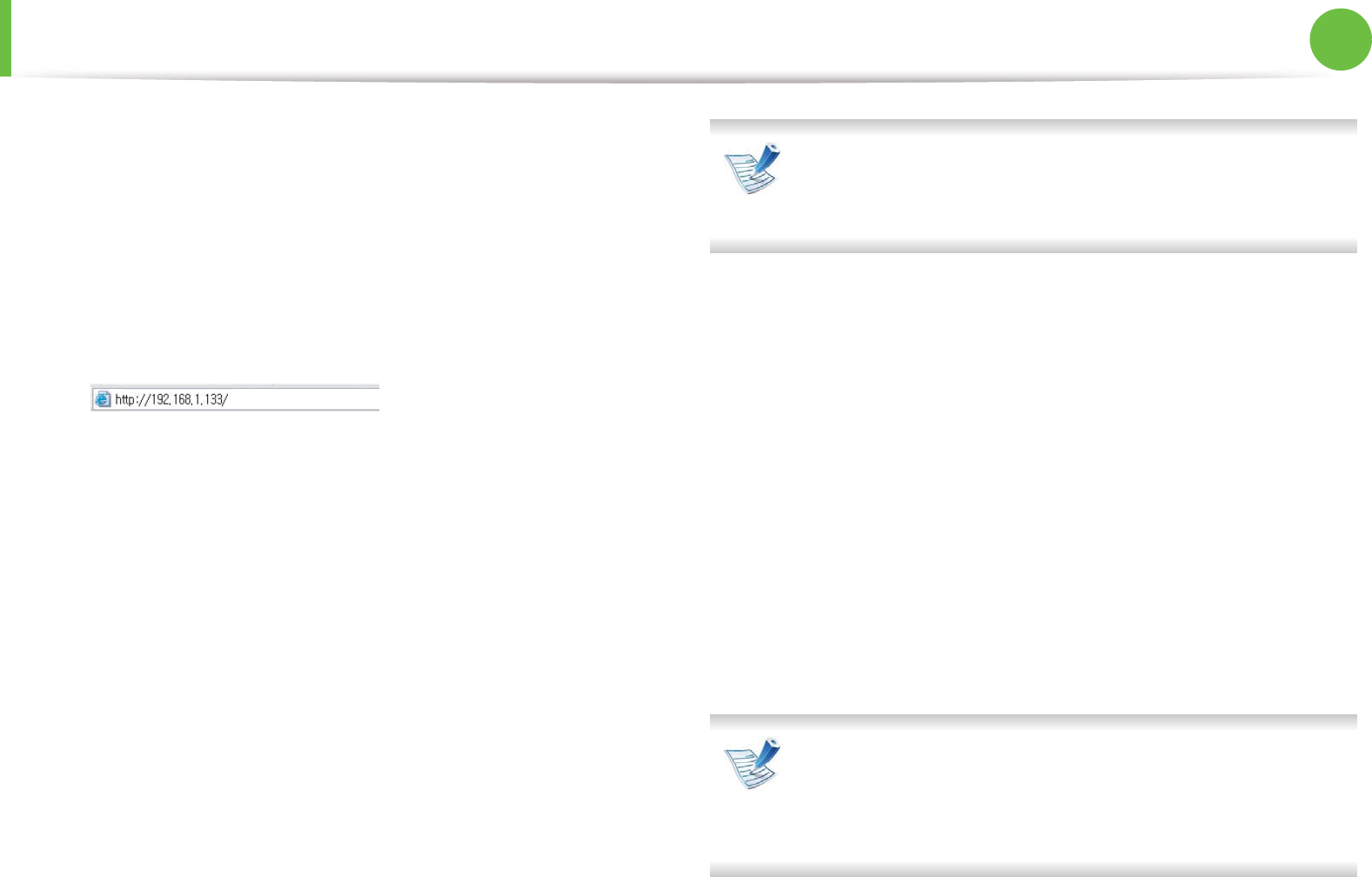
Wireless network setup 54
2. Using a network-connected machine
1Check whether or not the network cable is connected to the
machine. If not, connect the machine with a standard network
cable.
2 Start a web browser such as Internet Explorer, Safari or Firefox
and enter your machine’s new IP address in the browser
window.
For example,
3 Click Login on the upper right of the SyncThru™ Web Service
website.
4 Type in the ID and Password then click Login.
•ID: admin
•Password: sec00000
5 When the SyncThru™ Web Service window opens, click
Network Settings.
6 Click Wireless > Wizard.
Wizard will help you setup the wireless network
configuration. However, if you want to set the wireless
network directly, select Custom.
7 Select the one Network Name(SSID) in the list.
•SSID: SSID (Service Set Identifier) is a name that identifies a
wireless network, access points, and wireless devices
attempting to connect to a specific wireless network must
use the same SSID. The SSID is case-sensitive.
•Operation Mode: Operation Mode refers to the type of
wireless connections (See "Wireless network name and
network key" on page 31).
-Ad-hoc: Allows wireless devices to communicate
directly with each other in a peer-to-peer environment.
-Infrastructure: Allows wireless devices to
communicate with each other through an access point.
If your network’s Operation Mode is Infrastructure, select
the SSID of the access point. If the Operation Mode is Ad-
hoc, select the machine’s SSID. Note that “portthru” is the
default SSID of your machine.
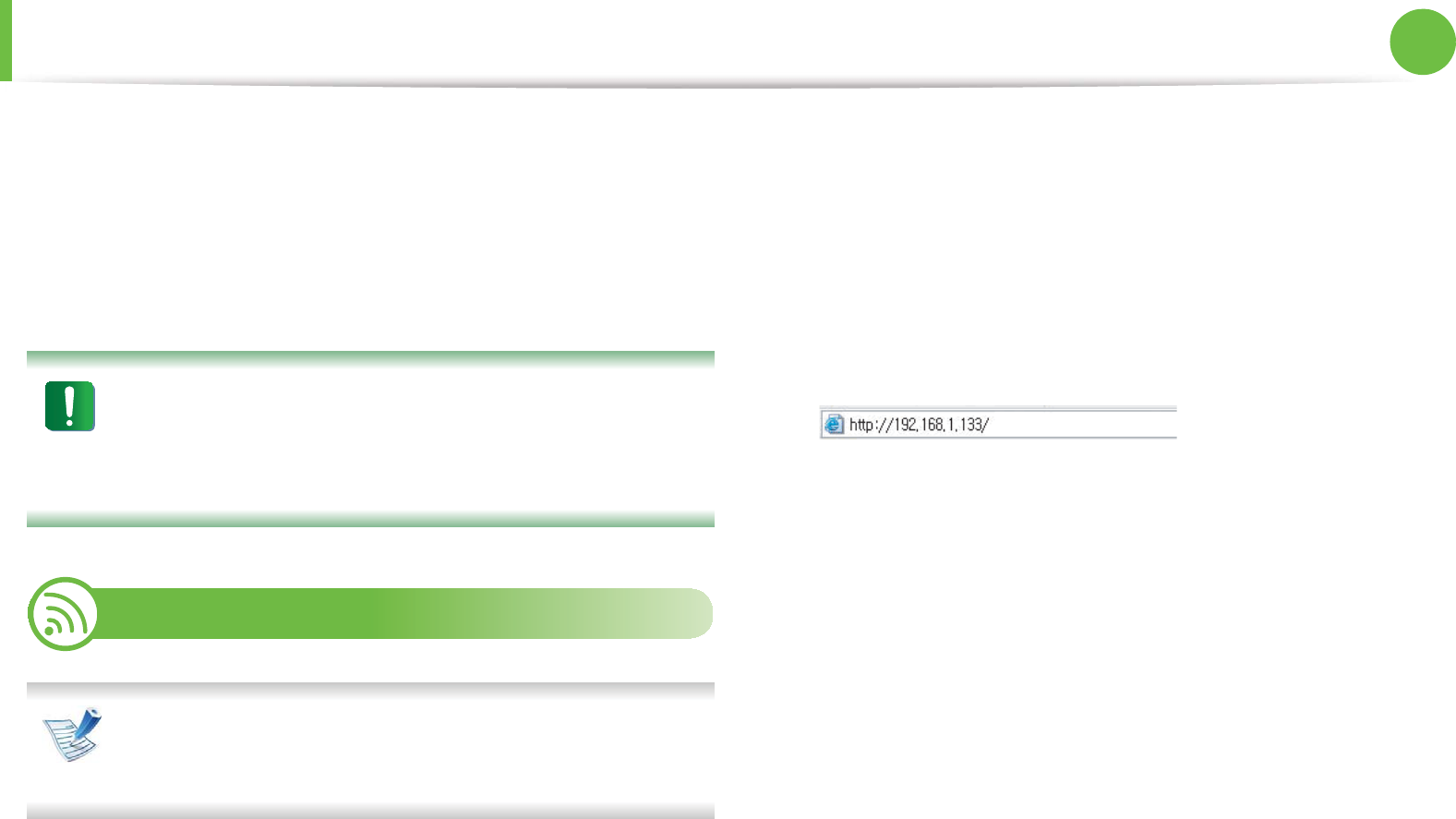
Wireless network setup 55
2. Using a network-connected machine
8 Click Next.
If the wireless security setting window appears, enter the
registered password (network key) and click Next.
9 The confirmation window appears, please check your wireless
setup. If the setup is right, click Apply.
Disconnect the network cable (standard or network). Your
machine should then start communicating wirelessly with
the network. In case of Ad-hoc mode, you can use a wireless
LAN and wired LAN simultaneously.
19
Turning the Wi-Fi network on/off
You can also turn on/off the Wi-Fi from the machine’s control
panel using the Network menu.
1Check whether the network cable is connected to the
machine. If not, connect the machine with a standard network
cable.
2 Start a web browser such as Internet Explorer, Safari or Firefox
and enter your machine’s new IP address in the browser
window.
For example,
3 Click Login on the upper right of the SyncThru™ Web Service
website.
4 Type in the ID and Password then click Login.
•ID: admin
•Password: sec00000
5 When the SyncThru™ Web Service window opens, click
Network Settings.
6 Click Wireless > Custom.
You can also turn the Wi-Fi network on/off.

Wireless network setup 56
2. Using a network-connected machine
20
Troubleshooting
Problems during setup or driver installation
ŹPrinters Not Found
• Your machine may not be turned on. Turn on your computer and
the machine.
• USB cable is not connected between your computer and
machine. Connect machine to your computer using the USB
cable.
• The machine does not support a wireless network. Check the
machine's user's guide included on the software CD supplied
with your machine and prepare a wireless network machine.
ŹConnecting Failure - Not Found SSID
• The machine is unable to search the network name (SSID) you
have selected or entered. Check the network name (SSID) on your
access point and try connecting again.
• Your access point is not turned on. Turn on your access point.
ŹConnecting Failure - Invalid Security
• You configured security incorrectly. Check the configured
security on your access point and machine.
ŹConnecting Failure - General Connection Error
• Your computer is not receiving a signal from your machine.
Check the USB cable and your machine’s power.
ŹConnecting Failure - Connected Wired Network
• Your machine is connected with a wired network cable. Remove
the wired network cable from your machine.
ŹPC Connection Error
• The configured network address is unable to connect between
your computer and machine.
- For a DHCP network environment
The receives the IP address automatically (DHCP) when
computer is configured to DHCP.
- For a Static network environment
The machine uses the static address when the computer is
configured to static address.
For example:
If the computer’s network information is as shown below:
ƒIP address: 169.254.133.42
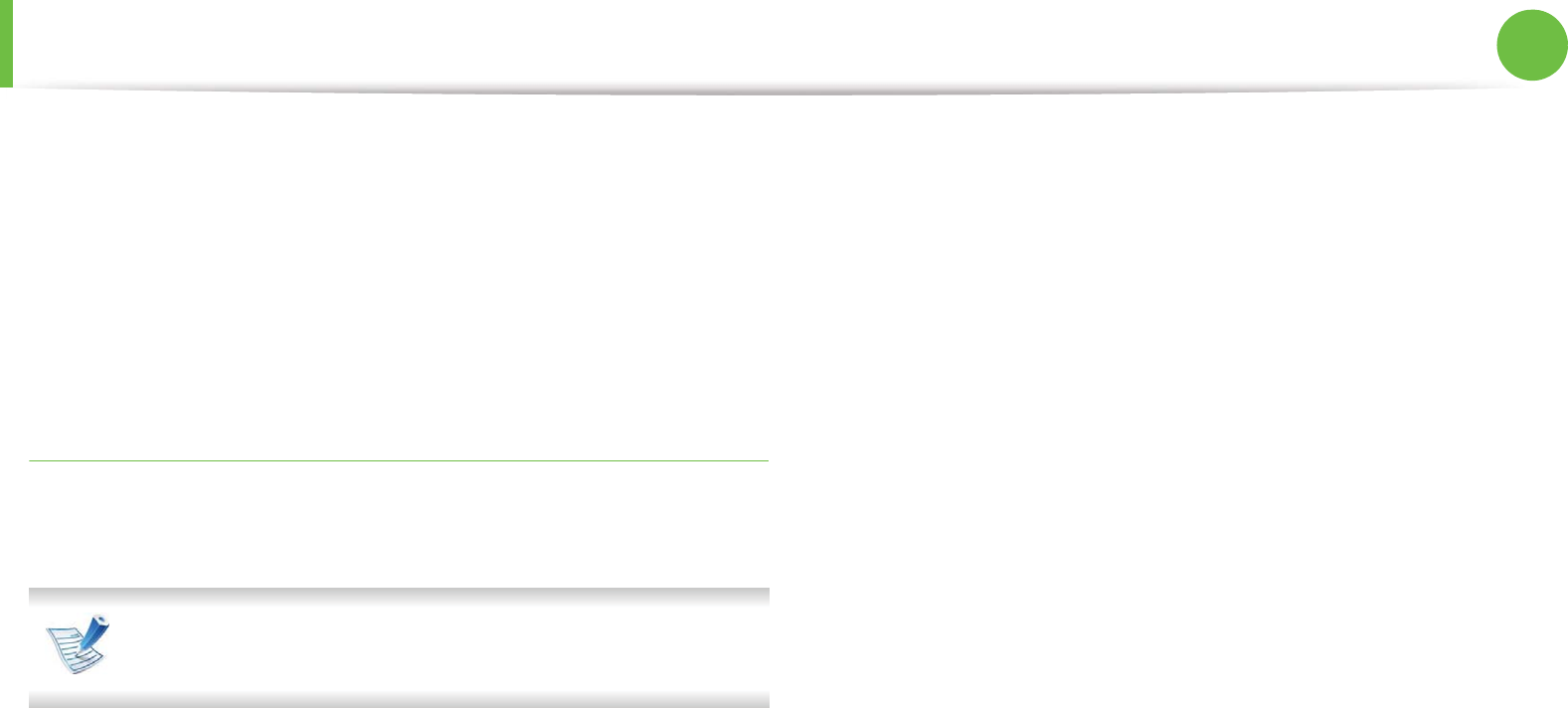
Wireless network setup 57
2. Using a network-connected machine
ƒSubnet Mask: 255.255.0.0
Then, the machine’s network information should be as below:
ƒIP address: 169.254.133.43
ƒSubnet Mask: 255.255.0.0 (Use the computer’s subnet
mask.)
ƒGateway: 169.254.133.1
Other problems
If problems occur while using the machine on a network, check the
following:
For information on the access point (or wireless router), refer
to its own user's guide.
• Your computer, access point (or wireless router), or machine may
not be turned on.
• Check the wireless reception around the machine. If the router is
far from the machine or there is an obstacle, you might have
difficulty receiving the signal.
• Cycle the power for the access point (or wireless router), machine,
and computer. Sometimes cycling the power can recover
network communication.
• Check whether firewall software (V3 or Norton) is blocking the
communication.
If the computer and the machine are connected on the same
network and it cannot be found when searching, firewall
software might be blocking the communication. Refer to the
user's guide for the software to turn it off and try searching for the
machine again.
• Check whether the machine's IP address is allocated correctly.
You can check the IP address by printing the network
configuration report.
• Check whether the access point (or wireless router) has a
configured security (password). If it has a password, refer to the
access point (or wireless router) administrator.
• Check the machine's IP address. Reinstall the machine driver and
change the settings to connect to the machine on the network.
Due to the characteristics of DHCP, the allocated IP address could
change if the machine is not used for a long time or if the access
point has been reset.
• Check the wireless environment. You might not be able to
connect to the network in the infrastructure environment where
you need to type in a user's information before connecting to
access point (or wireless router).
• This machine only supports IEEE 802.11 b/g/n and Wi-Fi. Other
wireless communication types (e.g., Bluetooth) are not
supported.

Wireless network setup 58
2. Using a network-connected machine
• When using the ad hoc mode, in operating systems such as
Windows Vista, you might need to set the wireless connection
setting every time you use the wireless machine.
• You cannot use Infrastructure mode and Ad hoc mode at the
same time for Samsung wireless network machines.
• The machine is within the range of the wireless network.
• The machine is located away from obstacles that could block the
wireless signal.
Remove any large metal objects between the access point (or
wireless router) and the machine.
Make sure the machine and wireless access point (or wireless
router) are not separated by poles, walls, or support columns
containing metal or concrete.
• The machine is located away from other electronic devices that
may interfere with the wireless signal.
Many devices can interfere with the wireless signal, including a
microwave oven and some Bluetooth devices.
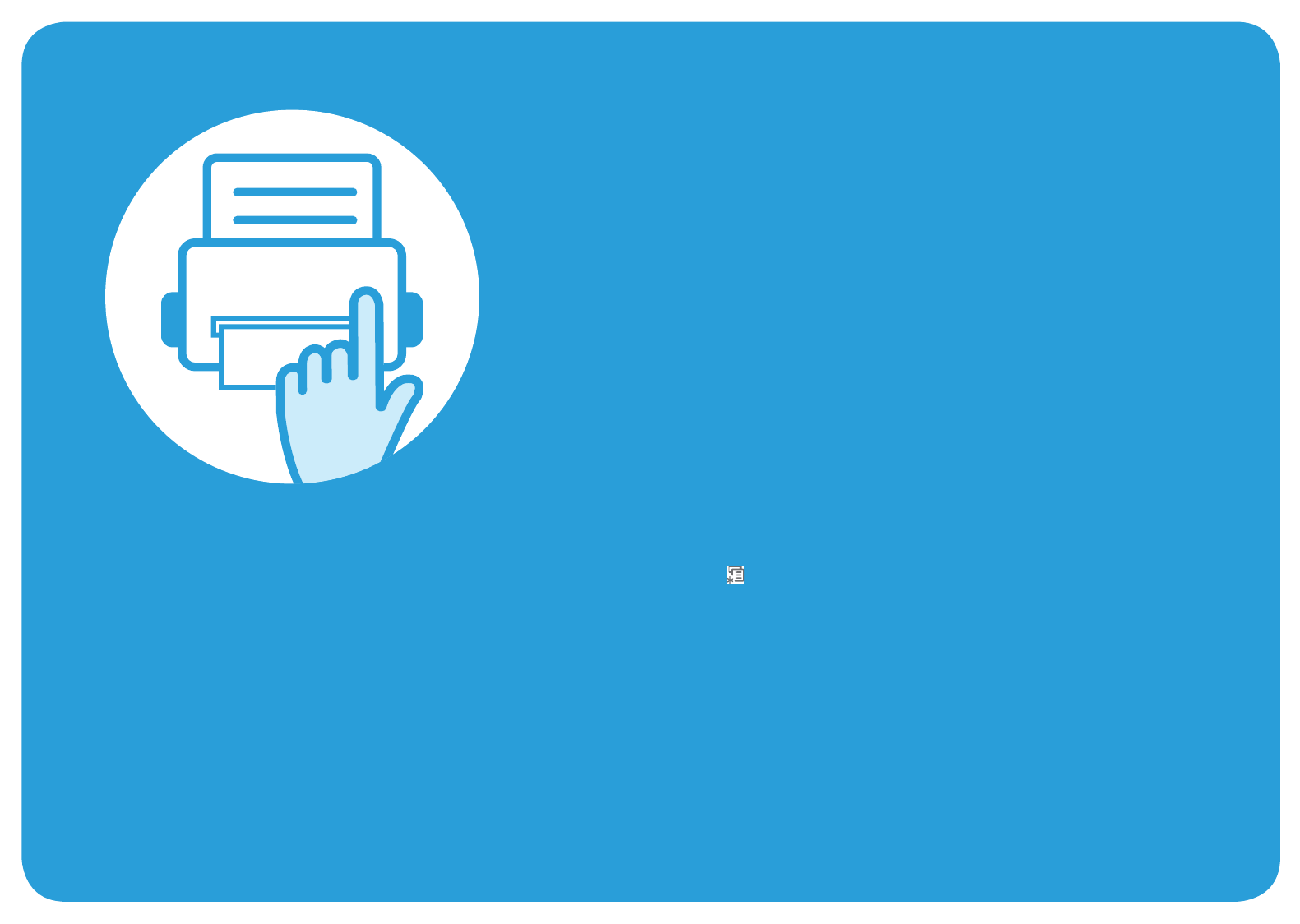
3. Useful setting menus
This chapter explains how to browse the current status of your machine, and the
method of setting for advanced machine setup.
• Print menu 60
•Copy menu 61
•Fax menu 66
• Scan menu 69
• System setup 71
•Admin setup 82
• Custom setup 83
The control panel provides access to various menus to set up the
machine or use the machine’s functions. These menus can be accessed
by pressing (Menu).
• An asterisk (*) appears next to the currently selected menu.
• Some menus may not appear on the display depending on options or
models. If so, it is not applicable to your machine.
• For models that do not have the display screen on the control panel,
this feature is not applicable.
• Some menu names may differ from your machine depending on its
options or the models.
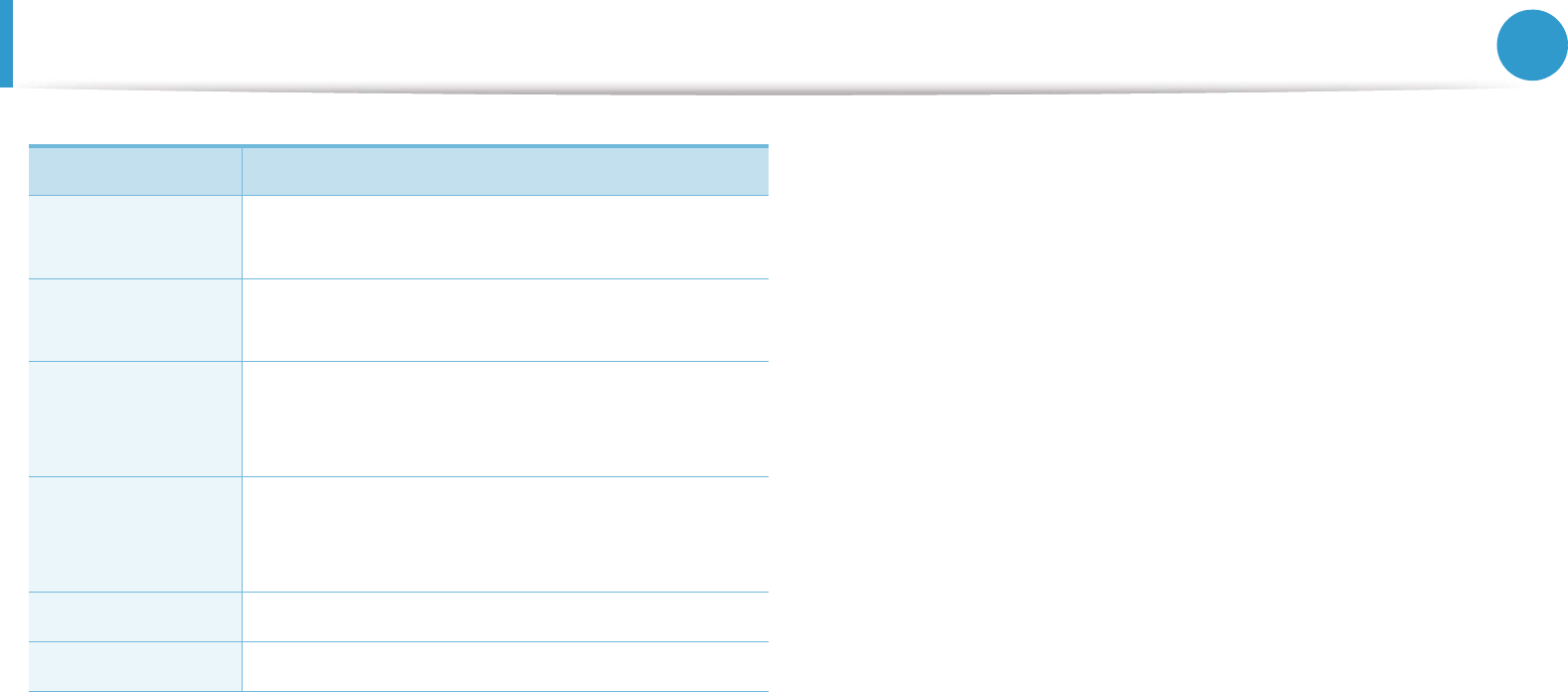
60
3. Useful setting menus
Print menu
Item Description
Orientation Selects the direction in which information is
printed on a page.
Copies You can enter the number of copies using the
number keypad.
Resolution
Specifies the number of dots printed per inch
(dpi). The higher the setting, the sharper printed
characters and graphics.
Darkness
Lightens or darkens the print on the page. The
Normal setting usually produces the best result.
Use the Light toner density setting to save toner.
Darken Text Prints text darker than on a normal document.
Emulation Sets the emulation type and option.
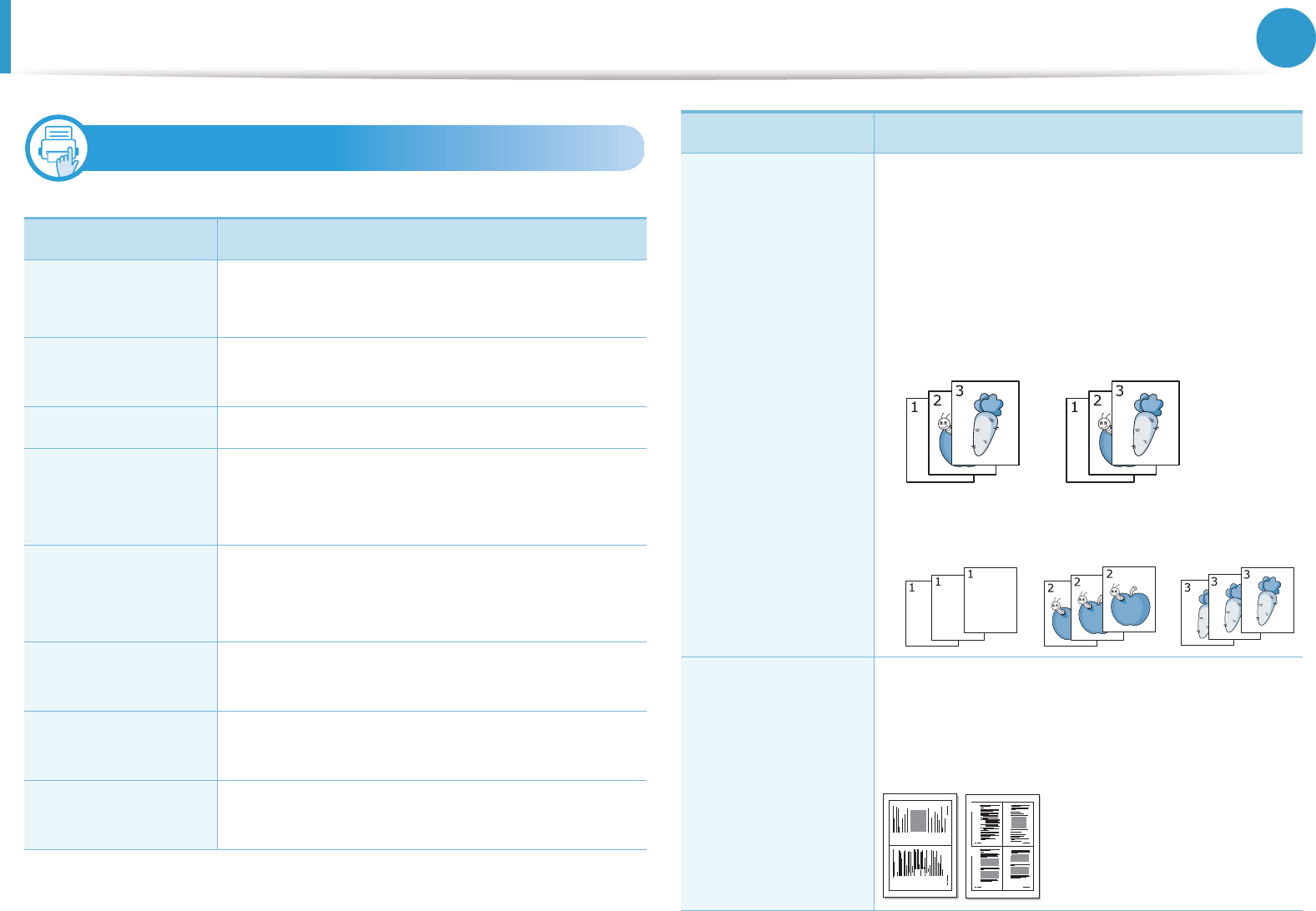
61
3. Useful setting menus
Copy menu
1
Copy Feature
Item Description
Scan Size
Original Size
Sets the image size.
Copies You can enter the number of copies using the
number keypad.
Reduce/Enlarge Reduces or enlarges the size of a copied image.
Darkness
Adjusts the brightness level to make a copy
that is easier to read, when the original
contains faint markings and dark images.
Contrast
Adjusts the contrast level to scan an original
that is easier to read, when the original
contains too faint or too dark contents.
Original Type Improves the copy quality by selecting the
document type for the current copy job.
Original
Orientation
Sets the original image’s orientation.
Layout Adjusts the layout format such as poster, clone,
ID copy, 2/4-up, booklet, etc.
Copy Collation
Collate Copy
Set the machine to sort the copy job. For
example, if you make 2 copies of a 3 page
original, one complete 3 page document will
print followed by a second complete
document.
•On: Prints output in sets to match the
sequence of originals.
•Off: Prints output sorted into stacks of
individual pages.
2-up or 4-up
Copying
N-up Copy
Reduces the size of the original images and
prints 2 or 4 pages onto one sheet of paper.
This copy feature is available only when you
load originals into the document feeder.
Item Description
1 2
1 2
3 4
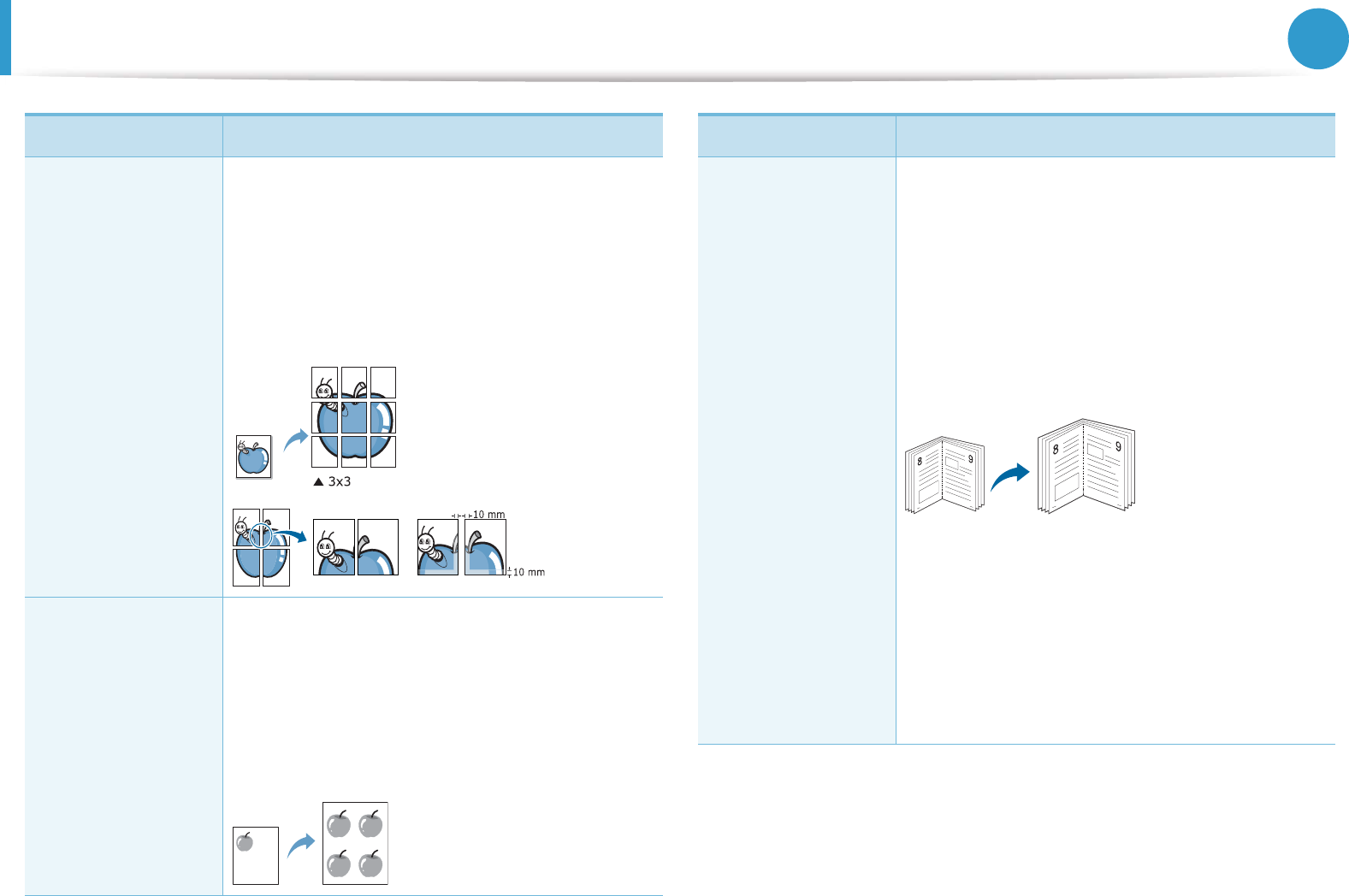
Copy menu 62
3. Useful setting menus
Poster Copy
Prints a single-page document onto 4 (Poster
2x2), 9 (Poster 3x3), or 16 (Poster 4x4) sheets of
paper, for the purpose of pasting the sheets
together to form one poster-size document.
This copy feature is available only when you
place originals on the scanner glass.
Clone Copy
Prints multiple original images on a single
page. The number of images is automatically
determined by the original image and the
paper size.
This copy feature is available only when you
place originals on the scanner glass.
Item Description
Book Copy
The Book Copy feature allows you to copy an
entire book. If the book is too thick, lift the
cover until its hinges are caught by the stopper
and then close the cover. If the book or
magazine is thicker than 30 mm, start copying
with the cover open.
This copy feature is available only when you
place originals on the scanner glass.
•Off: Does not use this feature.
•Left Page: Use this option to print left page
of the book.
•Right Page: Use this option to print right
page of the book.
•Both Page: Use this option to print both
pages of the book.
Item Description
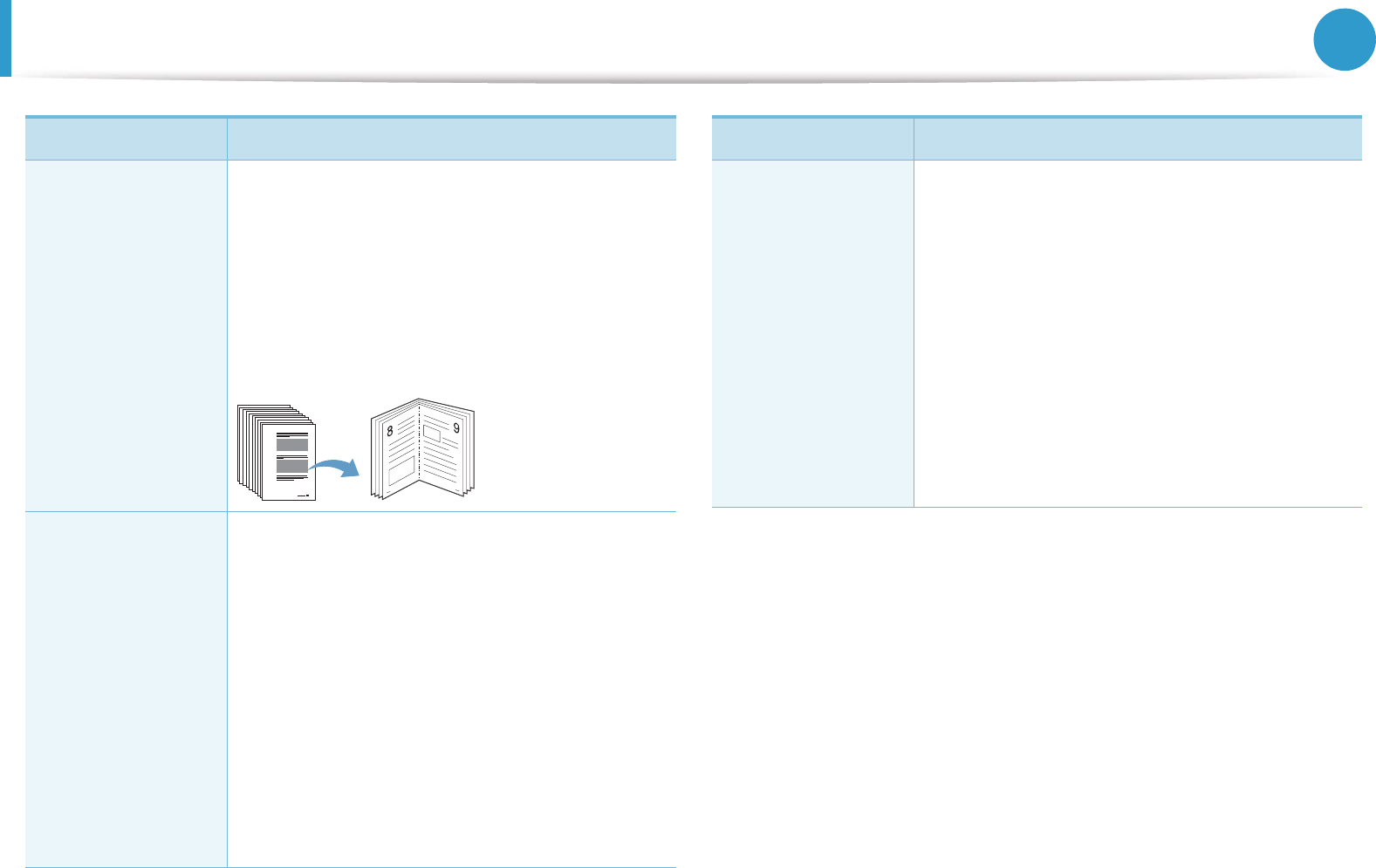
Copy menu 63
3. Useful setting menus
Booklet
The machine automatically prints on one or
both sides of the paper, which are then folded
to produce a booklet with all of the pages in the
correct sequence.
The machine will reduce and correctly adjust
the position of each image to fit on the selected
paper.
Adjust Bkgd
Prints an image without its background. This
copy feature removes the background color
and can be helpful when copying an original
containing color in the background, such as a
newspaper or a catalog.
•Off: Does not use this feature.
•Auto: Optimizes the background.
•Enhance Lev.1~2: The higher the number is,
the more vivid the background is.
•Erase Lev.1~4: The higher the number is,
the lighter the background is.
Item Description
Margin Shift
copying
Allows you to create a binding edge for the
document. The image can be adjusted up or
down on the page and/or shifted to the right or
left.
•Off: Does not use this feature.
•Auto Center: Automatically copy in the
center of the paper. This feature is available
only when you place originals on the
scanner glass.
•Custom Margin: Enter the left, right, top,
bottom margin using Number keypad.
Item Description
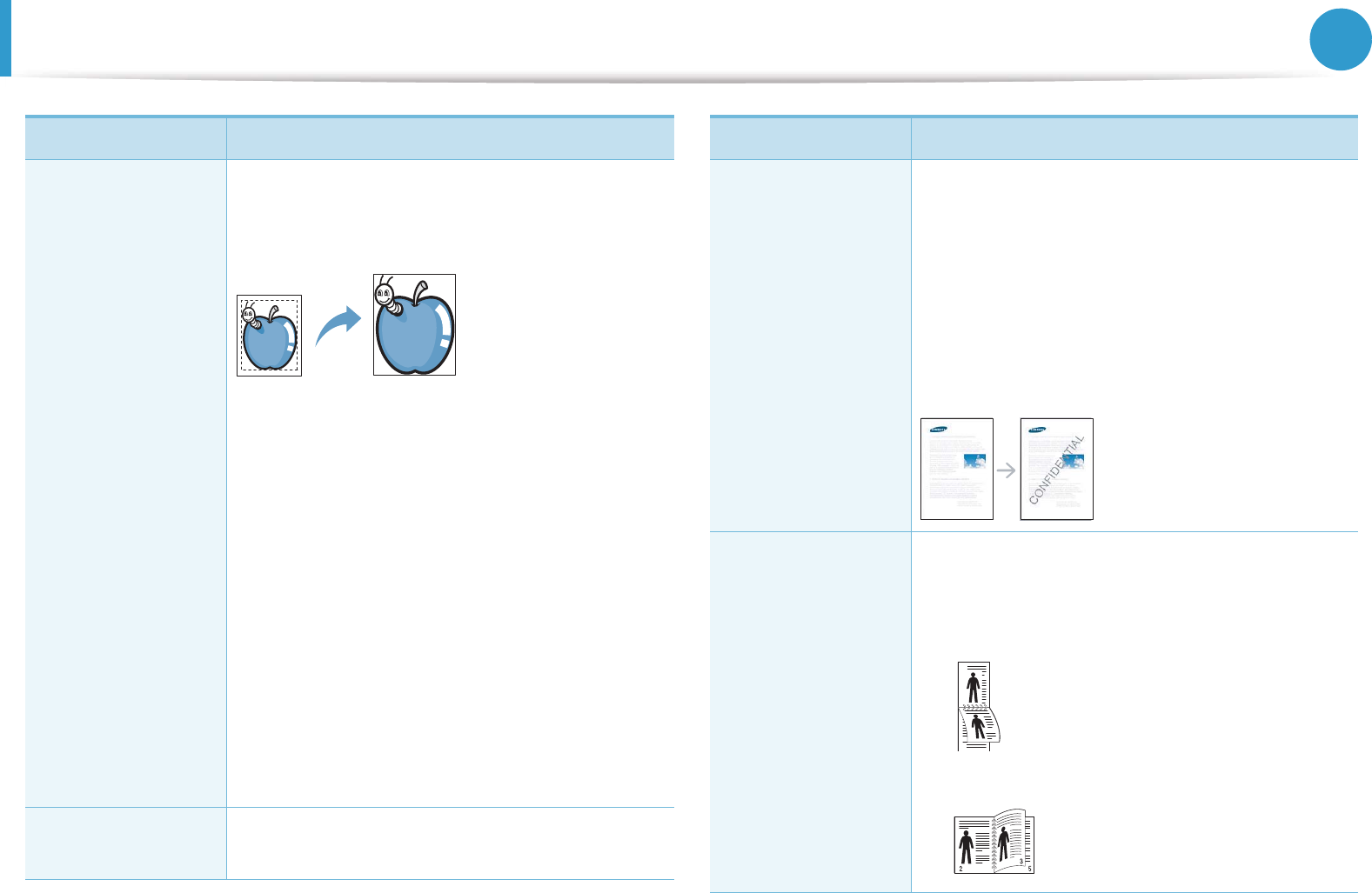
Copy menu 64
3. Useful setting menus
Edge Erase
copying
Allows you to erase spots, drill holes, fold
creases and staple marks along any of the four
edges of a document.
•Off: Does not use this feature.
•Small Original: rases the edge of the
original if it is small. This feature is available
only when you place originals on the
scanner glass.
•Hole Punch: Erases the marks of
bookbinding holes.
•Book Center: Erases the middle part of the
paper which is black and horizontal, when
you copy a book. This feature is available
only when you place originals on the
scanner glass.
•Border Erase: Enter the left, right, top,
bottom margin using Number keypad.
Gray Eenhance
copying
When you make a copy in gray scale, use this
feature to get better quality of copy-output.
Item Description
Watermark
copying
The watermark option allows you to print text
over an existing document. For example, you
use it when you want to have large gray letters
reading “DRAFT” or “CONFIDENTIAL” printed
diagonally across the first page or all pages of a
document. Enter a text message in the
Message option, and assign the page on which
you want to print.
Duplex
print copies on both sides of paper.
•Off: Prints in normal mode.
•1->2Side Short
•1->2Side Long
Item Description
2
5
3
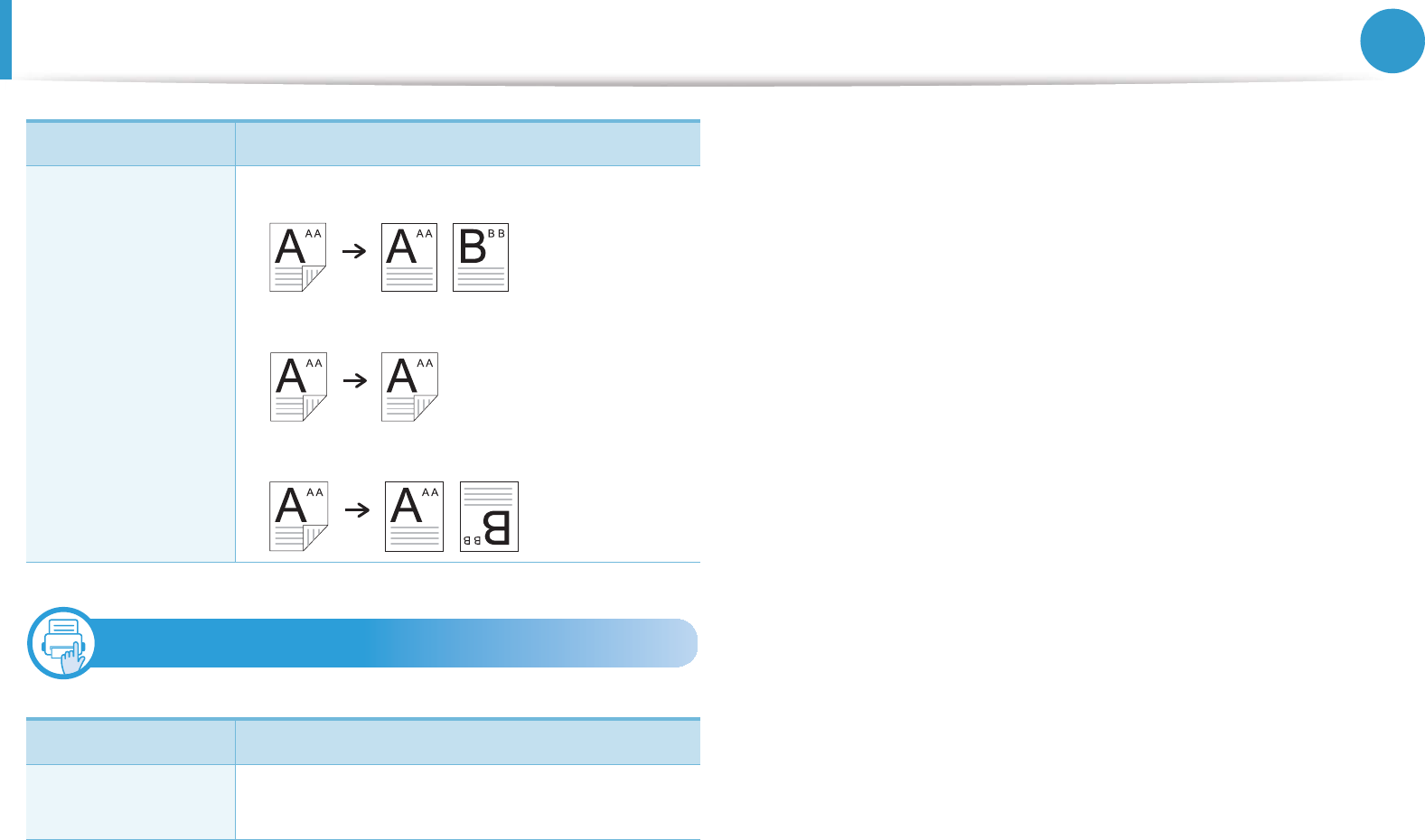
Copy menu 65
3. Useful setting menus
2
Copy Setup
Duplex (continue)
•2->1Side
•2->2Side
•2->1Side ROT2
Item Description
Change Default Resets the value or setting to the printer’s out-
of-box state.
Item Description
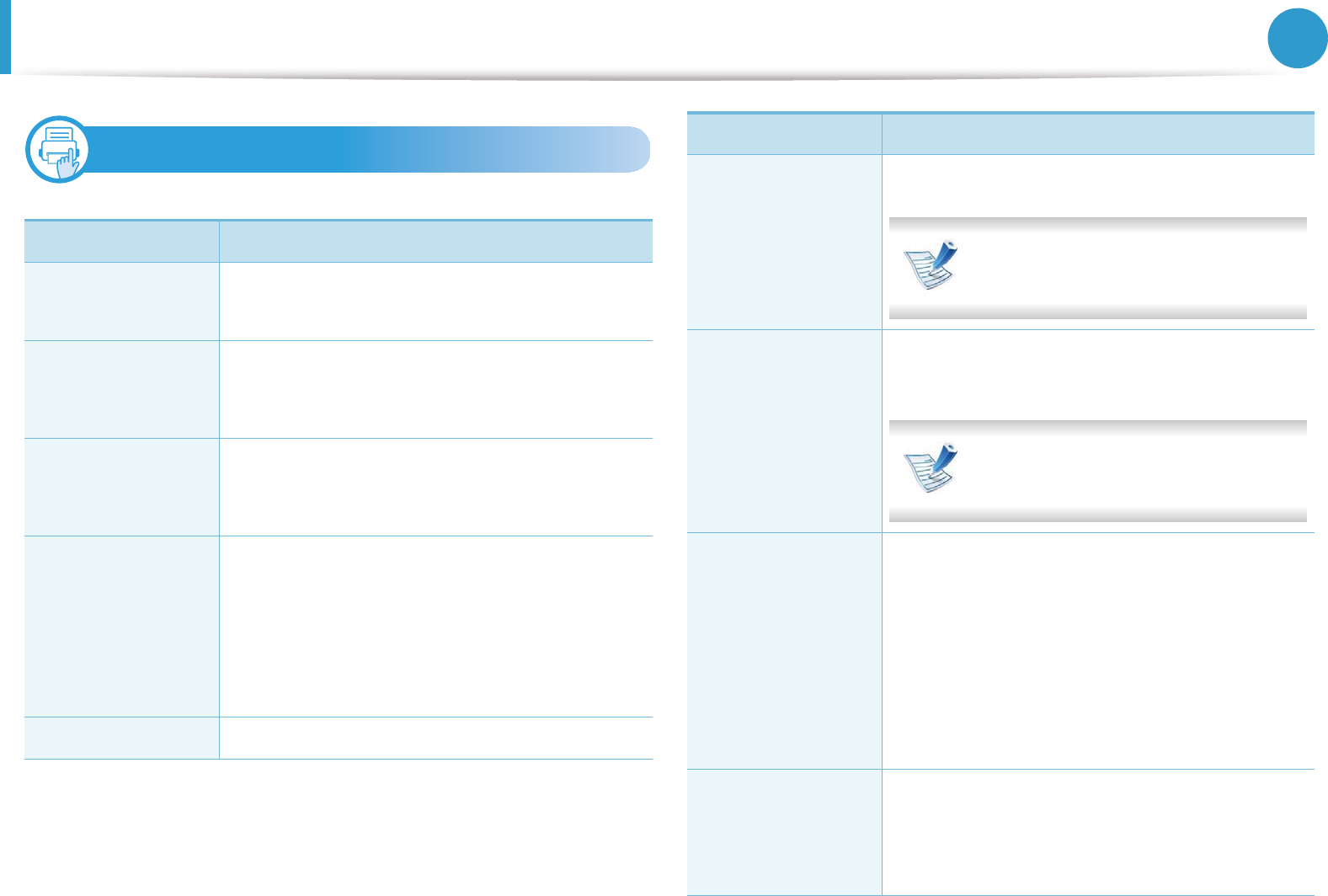
66
3. Useful setting menus
Fax menu
3
Fax Feature
Item Description
Scan Size
Original Size
Sets the image size.
Contrast
Adjusts the contrast level to scan an original
that is easier to read, when the original
contains too faint or too dark contents.
Darkness
Adjusts the brightness level to scan an original
that is easier to read, when the original
contains faint markings and dark images.
Resolution
The default document settings proceduce
good results when using typical text-based
originals. However, if you send originals that
are of poor quality, or contain photographs,
you can adjust the resolution to produce a
higher quality fax.
Duplex prints the received fax on both sides of paper.
Multi Send
Sends a fax to multiple destinations.
You cannot send a color fax using
this feature.
Delay Send
Sets your machine to send a fax at a later time
when you will not be present.
You cannot send a color fax using
this feature.
Priority Send
Scans the original into memory and
immediately transmits it when the current
operation is finished. Priority transmission will
interrupt a sending to multiple destinations
between stations (example, when the
transmission to station A ends, before
transmission to station B begins) or between
redial attempts.
Forward
Forwards the received or sent fax to other
destination by a fax, an email or a server. If you
are out of office but have to receive the fax, this
feature may be useful.
Item Description

Fax menu 67
3. Useful setting menus
4
Sending Setup
5
Receiving Setup
Secure Receive
Stores the received fax in memory without
printing out. To print received documents, you
need to enter the password. You can prevent
your received faxes from being accessed by
unauthorized people.
Add Page Adds additional documents to a reserved delay
fax job.
Cancel Job Cancels the delayed fax job which is saved in
memory.
Item Description
Redial Times Sets the number of redial attempts. If you enter
0, the machine will not redial.
Redial Term Sets the time interval before automatic
redialling.
Prefix Dial
Sets a prefix of up to five digits. This number
dials before any automatic dial number is
started. It is useful for accessing a PABX
exchange.
Item Description
ECM Mode
Sends faxes using error correction mode (ECM)
to makes sure the faxes are sent smoothly
without any error. It may take more time.
Send Report
Prints a confirmation report showing whether a
transmission was successful, how many pages
were sent, and more.
Image TCR Prints a transmission report with a minimized
image of the first page of the fax sent.
Dial Mode
Sets the dialing mode to either tone or pulse.
This setting may not be available depending on
your country.
Toll Save
Sends faxes at a preset toll-saving time to save
on call costs. This setting may not be available
depending on your country.
Setup Wizard Makes it easy to configure the necessary fax
options such as Machine ID, Fax Number, etc.
Item Description
Receive Mode Selects the default fax receiving mode.
Item Description
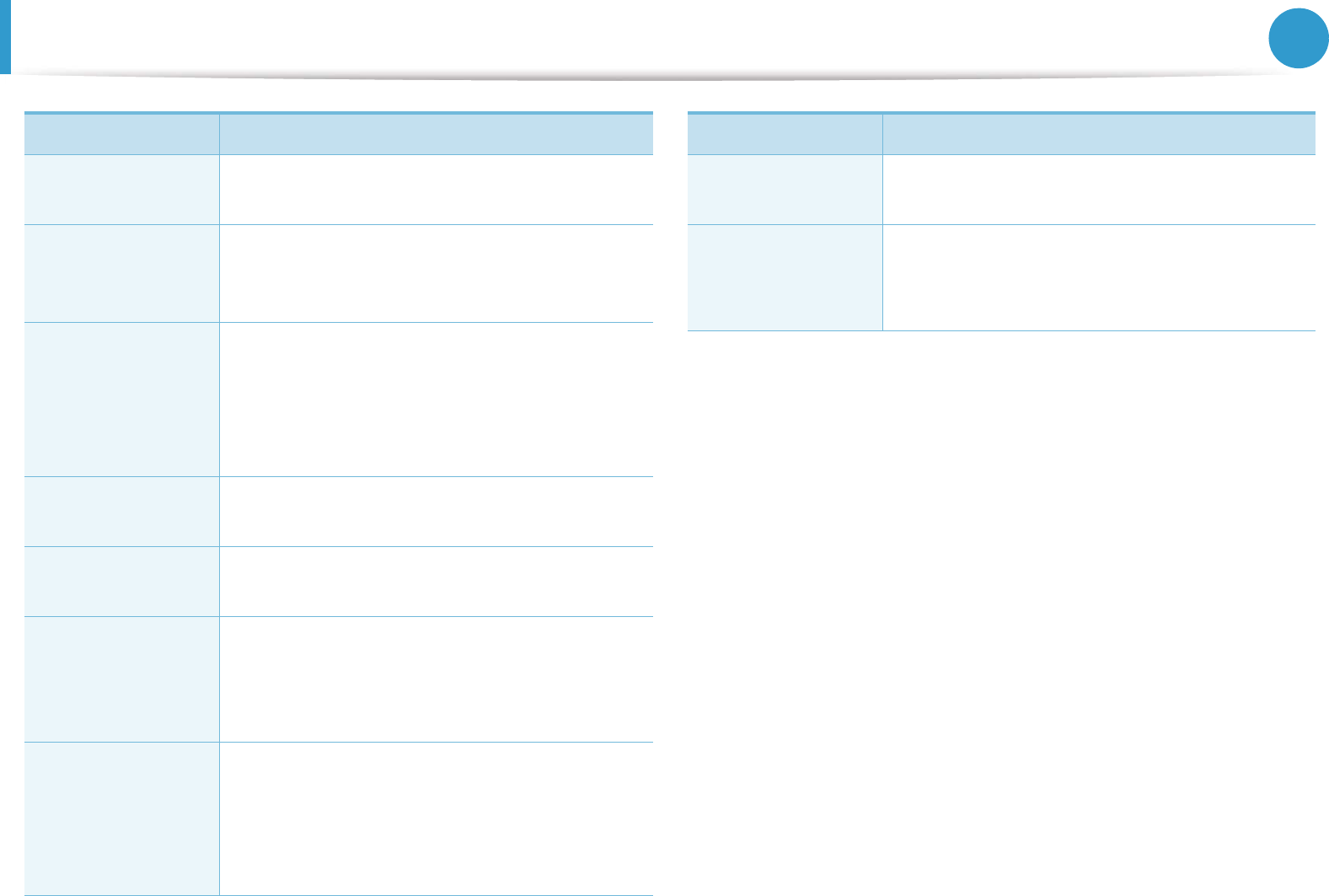
Fax menu 68
3. Useful setting menus
Ring To Answer Specifies the number of times the machine
rings before answering an incoming call.
Stamp RCV Name
Stamp Rcvd Name
Automatically prints the page number, and the
date and time of reception at the bottom of
each page of a received fax.
Rcv Start Code
Initiates fax reception from an extension phone
plugged into the EXT socket on the back of the
machine. If you pick up the extension phone
and hear fax tones, enter the code. It is preset to
*9* at the factory.
Auto Reduction Automatically reduces an incoming fax page to
fit the size of the paper loaded in the machine.
Discard Size Discards a specific length from the end of the
received fax.
Junk Fax Setup
Blocks any unwanted faxes that you stored in
the memory as junk fax numbers. This setting
may not be available depending on your
country.
DRPD Mode
Enables a user to use a single telephone line to
answer several different telephone numbers.
You can set the machine to recognize different
ring patterns for each number. This setting may
not be available depending on your country.
Item Description
Duplex Print Prints the received fax data on both sides of the
paper. You can save the paper usage.
Doc Box Saving
Document Box
Saving
Stores received faxes in the common box. This
menu only appears when an optional hard disk
drive has been installed.
Item Description
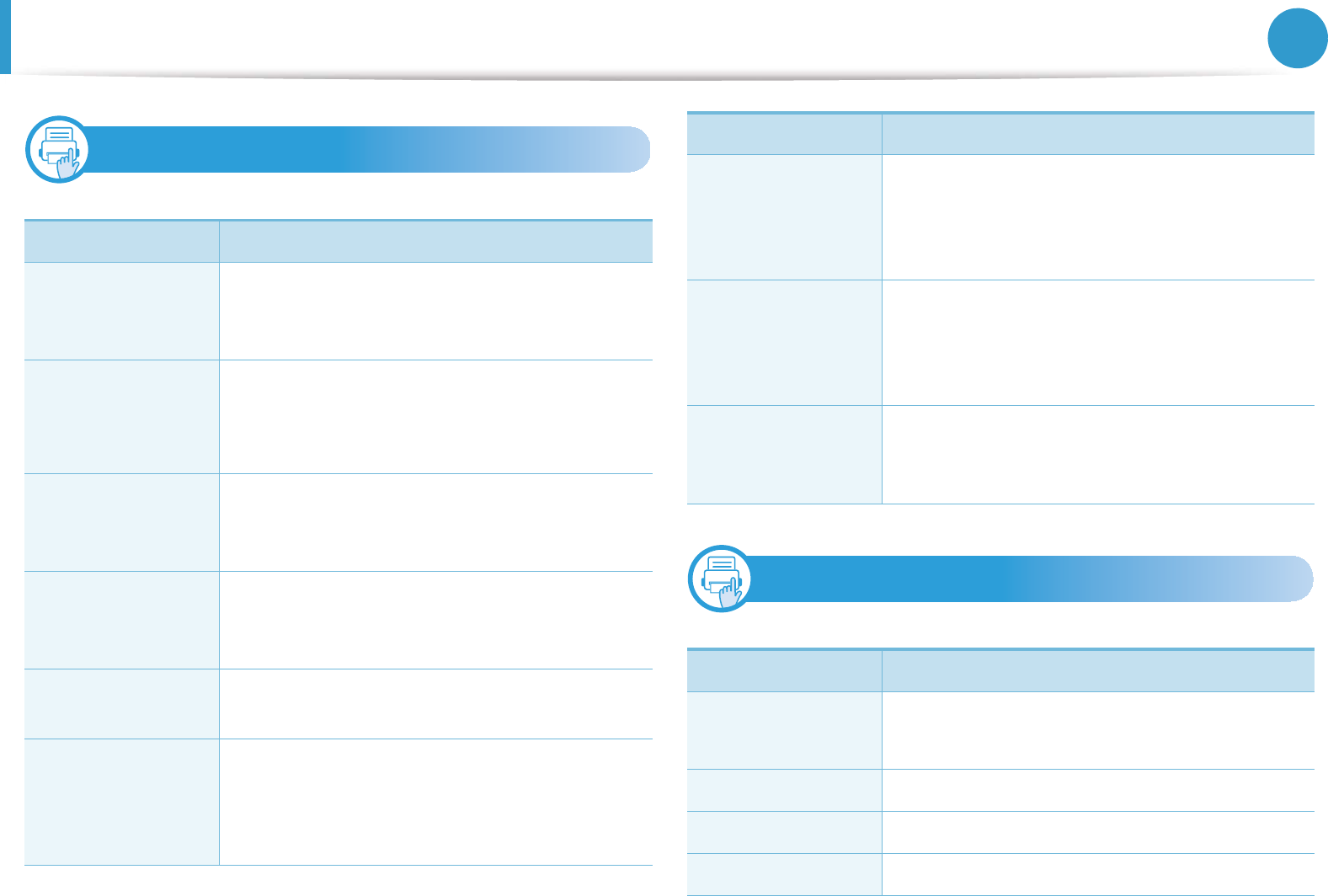
69
3. Useful setting menus
Scan menu
6
Scan Feature
7
Scan Setup
Item Description
USB Default
USB
Sets scan destination to a USB. You scan the
originals and save the scanned image to a USB
device.
Email Default
Send Email
Custom Email
Sets scan destination to an email. You scan the
originals and email the scanned image to
destinations.
FTP Default
FTP
Sets scan destination to an FTP server. You scan
the originals and send the scanned image to an
FTP server.
SMB Default
SMB
Sets scan destination to an SMB server. You
scan the originals and send the scanned image
to an SMB server.
Send Report Prints a confirmation report showing whether
the scanned image sending was successful.
Local PC
Sets scan destination to a usb-connected
computer. You scan the originals and save the
scanned image to a directory such as My
Documents.
Network PC
Sets scan destination to a network-connected
computer. You scan the originals and save the
scanned image to a directory such as My
Documents.
Document Box
Sets scan destination to a Document Box. You
scan the originals and send the scanned image
to the storage which called Document Box in
the machine.
Shared Boxes
Sets scan destination to a shared folder. You
can create and use the shared folder (see
"Using shared folder features" on page 123).
Item Description
Scan Size
Original Size
Sets the image size.
Original Type Sets the original document’s type.
Resolution Sets the image resolution.
Color Mode Sets the color mode.
Item Description

Scan menu 70
3. Useful setting menus
File Format
Sets the file format in which the image is to be
saved. If you select BMP, JPEG, TIFF, or PDF, you
can select to scan multiple pages.
Darkness Adjusts the brightness level to scan.
Contrast Adjust the contrast level to scan lighter or
darker than the original.
Item Description

71
3. Useful setting menus
System setup
8
Machine Setup
Item Description
Machine ID Sets the machine ID which will be printed at the
top of each fax page that you send.
Fax Number Sets the fax number which will be printed at the
top of each fax page that you send.
Date & Time Sets the date and time.
Clock Mode Selects the format for displaying time between
12 hr and 24 hr.
Form Menu
•Off: Prints in normal mode.
•Single Form: Prints all page using the first
form.
•Double Form: Prints the front page using the
first form and the back page using the second
form.
Select Form
Form overlay is images stored on the printer’s
hard disk as a special file format that can be
printed in layers on any document.
HDD Spooling When On, stores documents on the hard disk
drive (HDD) for network printing.
Language Sets the language of the text that appears on the
control panel display.
Default Mode Sets the machine’s default mode among fax
mode, copy mode, or scan mode.
Default Paper
Size
You can set the default paper size to use.
Power Save
Sets how long the machine waits before going to
power save mode.
When the machine does not receive data for an
extended period of time, power consumption is
automatically lowered.
Scan PWR Save
Sets how long the machine’s scanner part waits
before going to power save mode.
When the scanner does not receive data for an
extended period of time, power consumption is
automatically lowered.
System Timeout
Sets the time that the machine remembers
previously used copy settings. After the timeout,
the machine restores the dafault copy settings.
Job Timeout
Sets the length of time the printer waits before
printing the last page of a print job that does not
end with a command to print the page.
Item Description
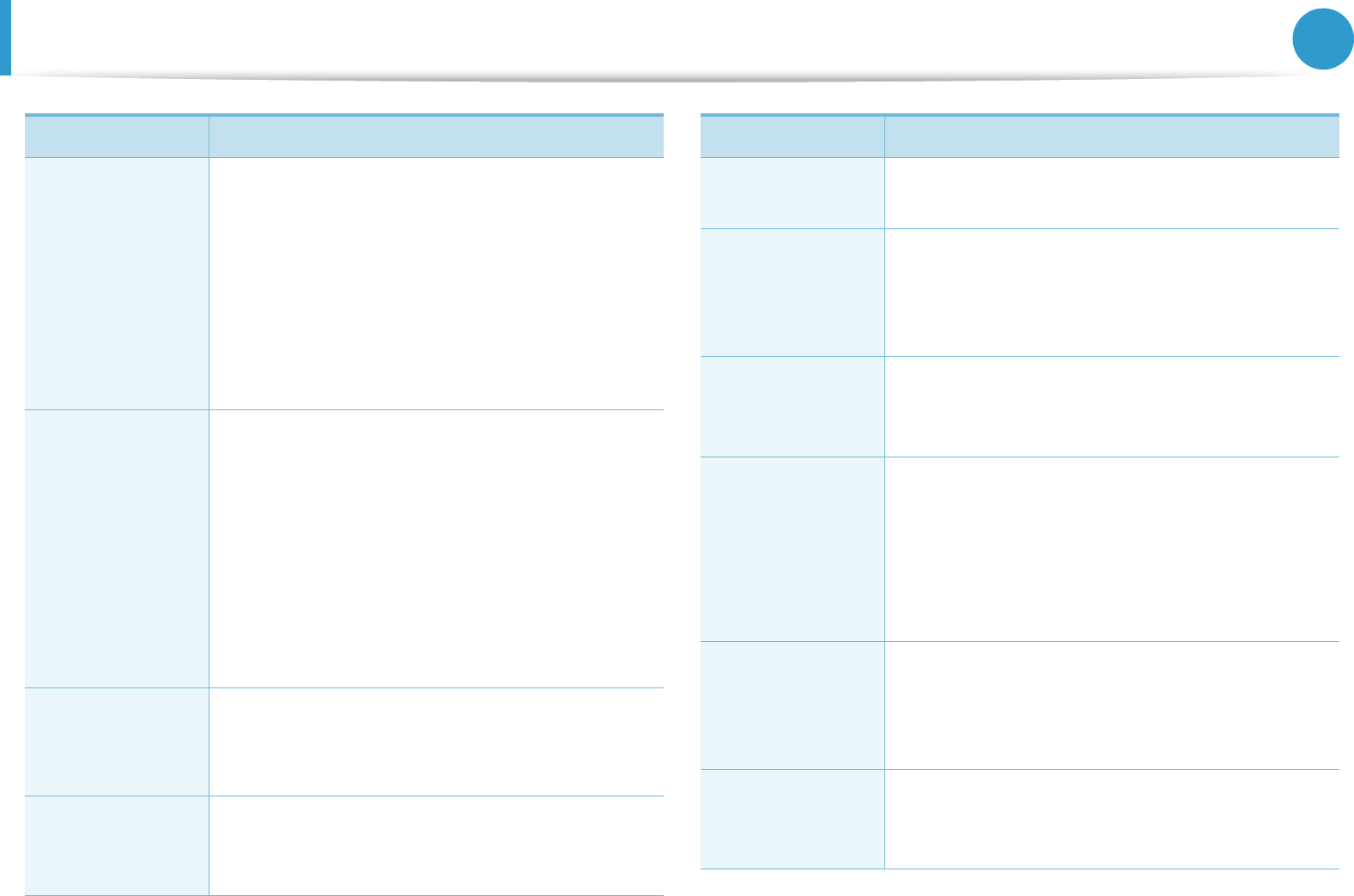
System setup 72
3. Useful setting menus
Wakeup Event
You can set the condition to wake up from
power-save mode. Set the item on.
•Button
G
Press: GWhen you press any button
except power button, the machine wake up
from the power save mode.
•Printer: When you open or close the paper
tray, the machine wake up from the power
save mode.
Auto Continue
Determine whether or not the machine
continues printing when it detects the paper
does not match the paper settings.
•Off: If a paper mismatch occurs, the machine
waits until you insert the correct paper.
•On: If a paper mismatch occurs, an error
message will display. The machine waits for
about 30 second, then automatically clear the
message and continue printing.
Altitude Adj.
Altitude
Adjustment
Optimize print quality according to the
machine’s altitude.
Auto CR
Allows you to append the required carriage
return to each line feed, which is useful for Unix
or DOS users.
Item Description
Firmware
Version
Shows the product’s firmware version.
AutoComplete
Provides sugestions while you type an email
address or fax number. This enables you to find
and select the data without typing it in
completely.
Tray Chaining
Auto Tray Switch
Determine whether or not the machine
continues printing when it detects the paper
does not match.
Paper
Substitution
Automatically substitutes the printer driver’s
paper size to prevent the paper mismatch
between Letter and A4. For example, if you have
A4 paper in the tray but you set the paper size to
Letter in the printer driver, the machine prints on
A4 paper and vice versa.
Paper Mismatch
Determine whether to disregard the paper
mismatch error or not. Select Off, then the
machine does not stop printing even if the paper
mismatches.
Print Blank Page
The printer detects the printing data from
computer whether a page is empty or not. You
can set to print or skip the blank page.
Item Description
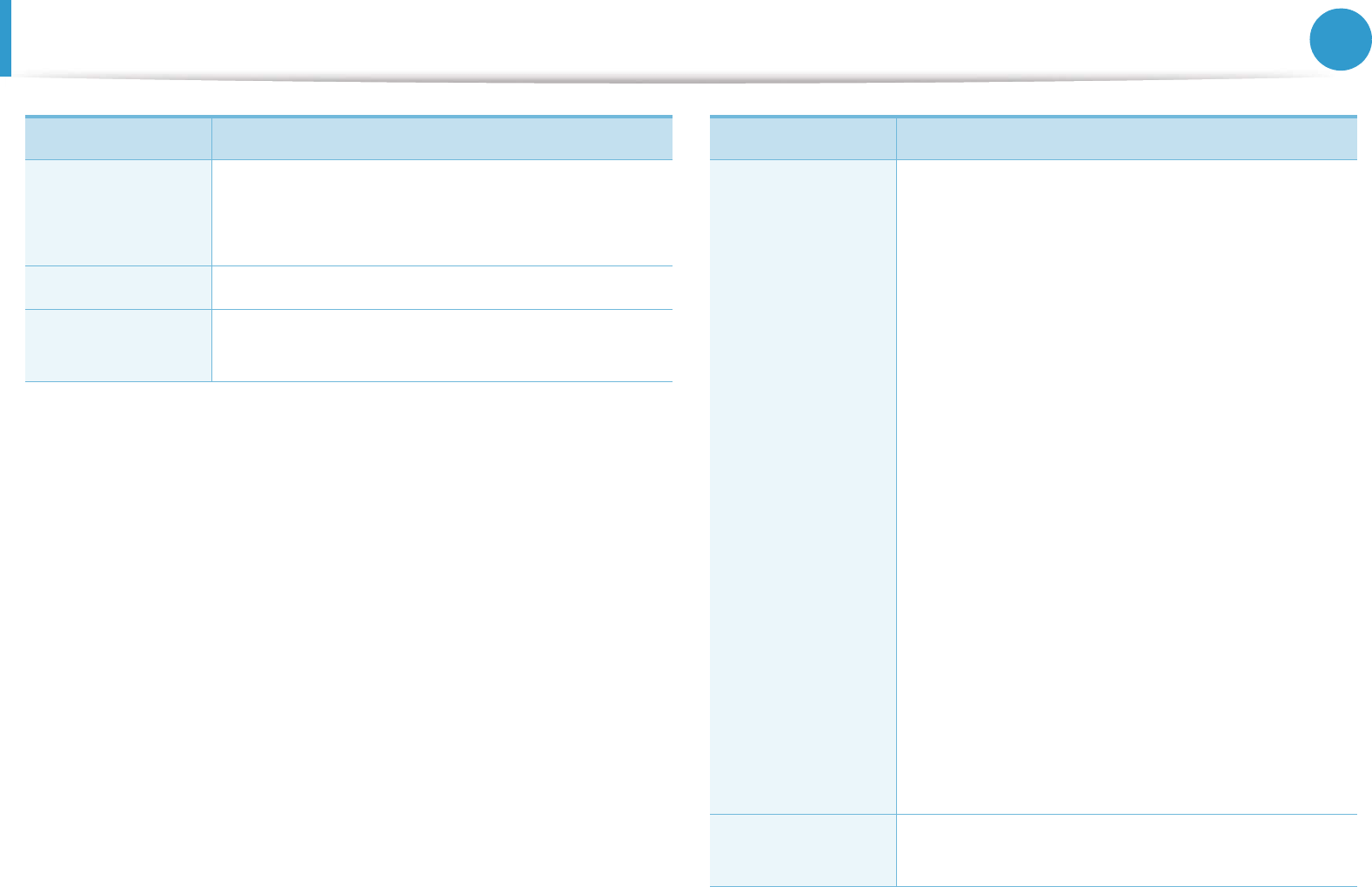
System setup 73
3. Useful setting menus
Multi-Bin
•Mode: Selects the mult-bin mode you want to
use.
•Default Bin: Selects the bin to use as a default.
Default Source Sets the tray to use as a default.
Address Book Views or prints the phonebook or email address
list.
Item Description
Maintenance
•Clean Drum: Cleans the OPC drum of the
cartridge by printing a sheet.
•Clean Fuser: Cleans the fuser by printing a
sheet.
•CLR Empty Msg.: This option appears only
when toner cartridge is empty.
•Supplies Info.: Allows you to check how
many pages are printed and how much toner
is left in the cartridge.
•TonerLow Alert: If toner in the cartridge has
run out, a message informing the user to
change the toner cartridge appears. You can
set the option for this message to appear or
not.
•Paper Stacking: If you use a machine in a
humid area, or you are using the damp print
media caused by a high humidity, the print-
outs on the output tray may be curled and
may not be stacked properly. In this case, you
can set the machine to use this function to let
print-outs stacked firmly. But, using this
function will make the print speed slow.
Import Setting Imports data stored on a USB memory stick to
the machine.
Item Description
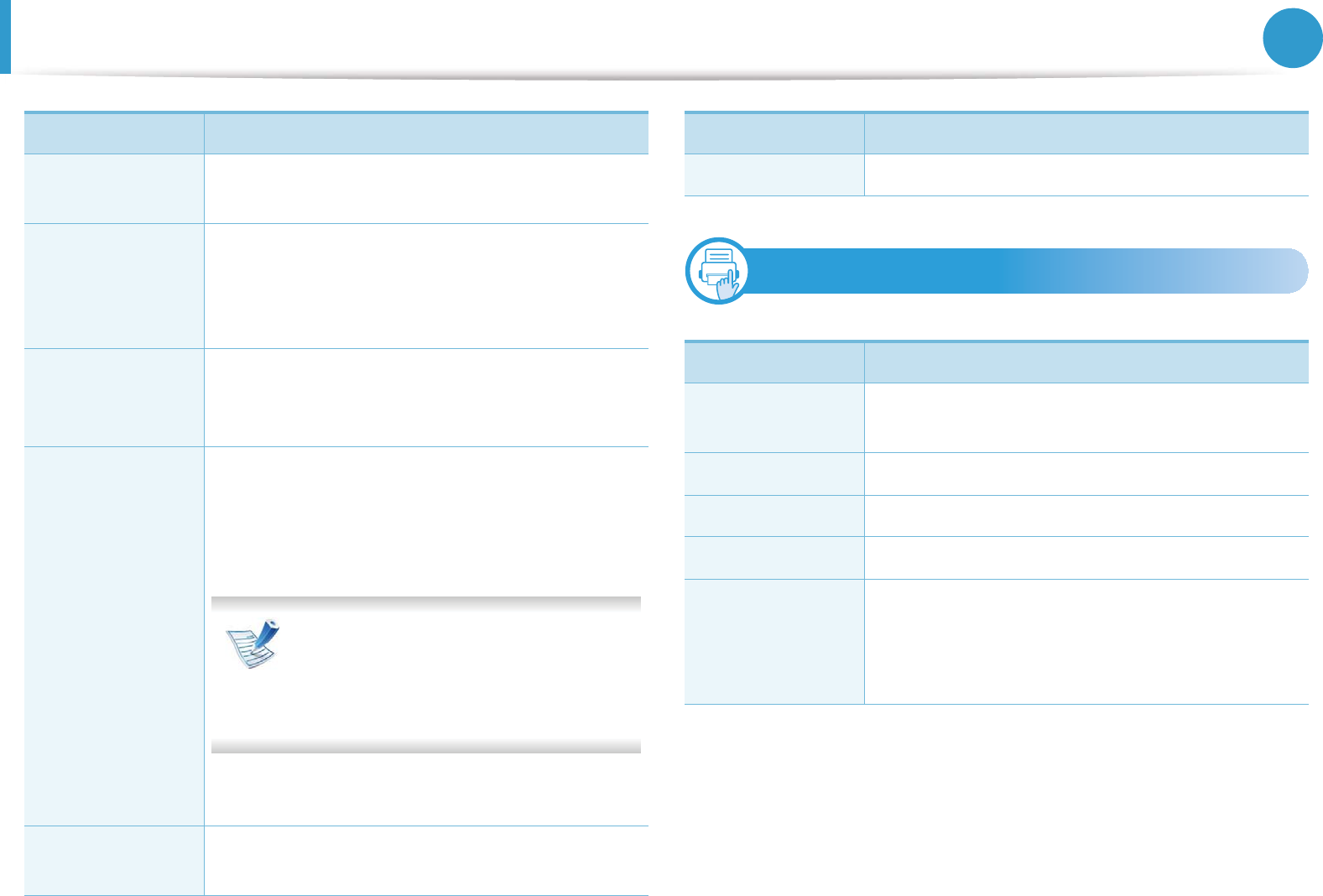
System setup 74
3. Useful setting menus
9
Paper Setup
Export Setting Exports data stored on a USB memory stick to the
machine.
Toner Save
Activating this mode extends the life of your
toner cartridge and reduces your cost per page
beyond what one would experience in the
normal mode, but it reduces print quality.
Quiet Mode
You can reduce the printing noise by turning this
menu on. However, the printing speed and
quality may be declined.
Eco
Eco Setup
Allows you to save print resources and enables
eco-friendly printing.
•Default Mode: Select whether to turn the Eco
mode on or off.
On force (On-Forced): Sets the Eco
mode on with password. If a user
wants to turn the Eco mode on/off, the
user needs to enter the password.
•Change Template: Selects the eco template
set from the SyncThru™ Web Service.
Barcode
FreeScape
You can set the freescape for barcodes. Enable
this option to set the freescape code.
Item Description
Clear Setting Restores the machine’s factory default settings.
Item Description
Paper Size Sets the paper size as A4, Letter, or other paper
sizes, according to your requirements.
Paper Type Chooses the type of the paper for each tray.
Paper Source Selects from which tray the paper is used.
Margin Sets the margins for the document.
Tray Confirm
Activates the tray confirmation message. If you
open and close a tray, a window asking you
whether to set the paper size and type for the
tray just opened appears.
Item Description
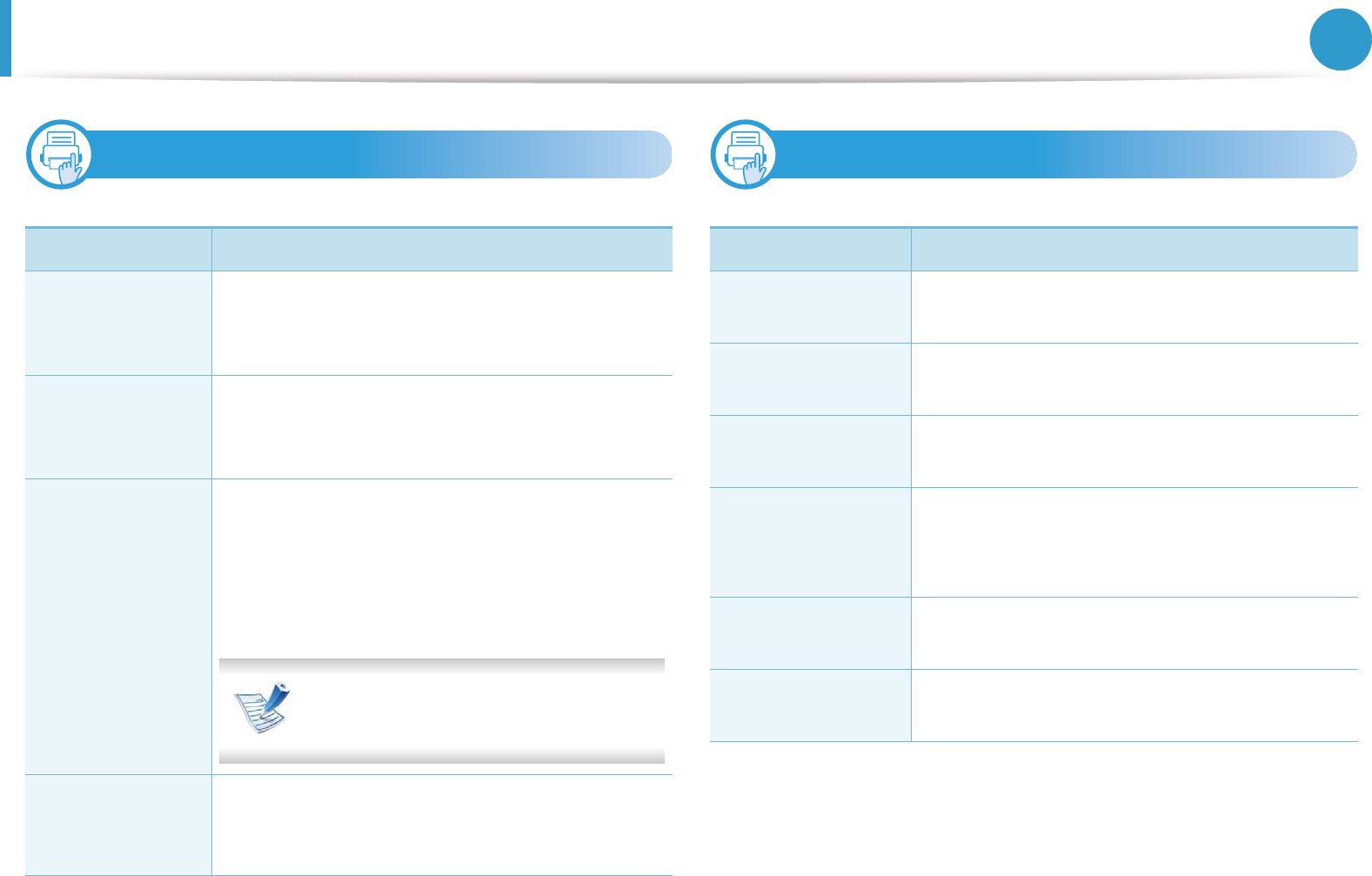
System setup 75
3. Useful setting menus
10
Sound / Volume
11
Report
Item Description
Key Sound
Turns the key sound on orGoff. With this option
set to on, a tone sounds each time a key is
pressed.
Alarm Sound
Turns the alarm sound on orGoff. With this option
set to on, an alarm tone sounds when an error
occurs or fax communication ends.
Speaker
Turns on or off the sounds from the telephone
line through the speaker, such as a dial tone or a
fax tone. With this option set to Comm. which
means the speaker is on until the remote
machine answers.
You can adjust the volume level using
On Hook Dial.
Ringer
Adjusts the ringer volume. For the ringer
volume, you can select off, low, middle, and high
level.
Item Description
Menu Map Prints the menu map which shows the layout
and current settings of this machine.
All Reports Prints all kinds of reports that this machine
provides.
Configuration Prints a report on the machine's overall
configuration.
Supplies Info.
Supplies
Information
Prints supplies’ information page.
Address Book Prints all of the email addresses currently
stored in the machine’s memory.
Demo Page Prints the demo page to check whether your
machine is printing properly or not.

System setup 76
3. Useful setting menus
Fax Send
Prints a transmission report including the fax
number, the number of pages, the elapsed
time of the job, the communication mode, and
the communication results for fax job. You can
set up your machine to automatically print a
transmission confirmation report after each fax
job.
Fax Sent
Prints information on the faxes you have
recently sent. You can set the machine to
automatically print this report every 50
communications.
Fax Received Prints information on the faxes you have
recently received.
Email Sent
Prints information on the emails you have
recently sent. You can set the machine to
automatically print this report every 50
communications.
Scheduled Jobs
Fax Scheduled
Jobs
Prints the document list currently stored for
delayed faxes along with the starting time and
type of each operation.
JunkFax Prints the fax numbers specified as junk fax
numbers.
Item Description
Network Conf.
Network
Configuration
Prints information on your machine’s network
connection and configuration.
User Auth
Local User
Authentication
Prints the authorized users who are allowed to
use the email function.
PCL Font Prints the PCL font list.
PS Font
PS3 Font
Prints the PS/PS3 font list.
EPSON Font Prints the EPSON font list.
KSC5843 Font Prints the KS font list.
KSC5895 Font Prints the KS5895 font list.
KSSM Font Prints the KSSM font list.
Net User Auth
Network User
Authentication
Prints the users and their IDs who logged in the
domain.
Usage Counter
Prints a u16
sage page. The usage page contains the total
number of pages printed.
Fax Options Prints the information of a fax reports.
Item Description
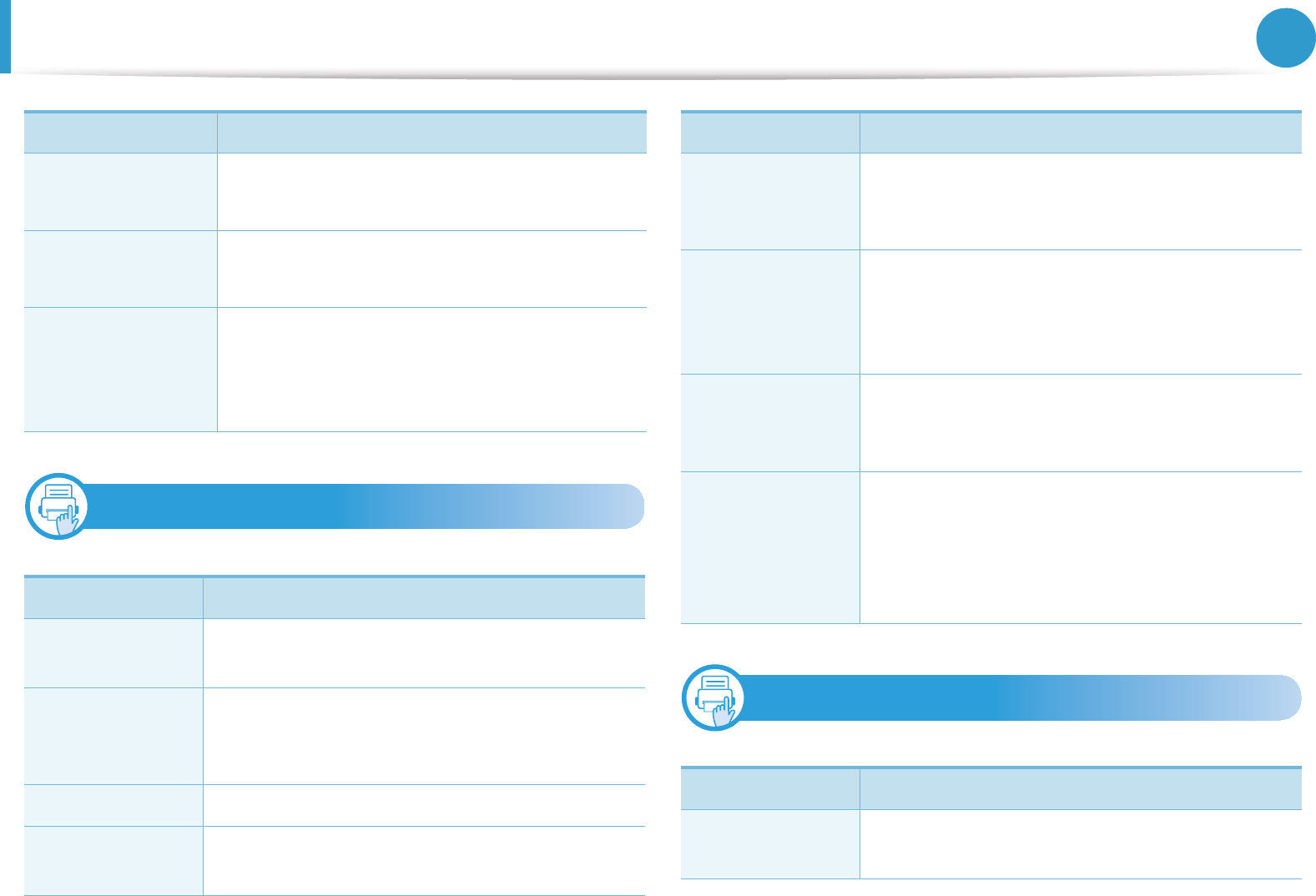
System setup 77
3. Useful setting menus
12
Maintenance
13
Clear Setting
Stored Job List
Stored Jobs
Prints jobs currently stored in the optional
memory or on a hard disk (HDD).
Completed Job
Completed Jobs
Prints list of completed jobs.
Accounting Report
Accounting
This is used only available when Job
Accounting is enabled from the SyncThru™
Web Admin Service. You can print a report of
printout counts for each user.
Item Description
CLR Empty Msg. When toner cartridge is empty, this option
appears. You can clear the empty message.
Ignore Toner
You can set the machine to ingore the toner
empty message and continue printing except
incoming faxes.
Supplies Life Shows the supply life indicators.
Toner Low Alert Customizes the level to alert toner low or toner
empty.
Item Description
Serial Number
Shows the machine’s serial number. When you
call for service or register as a user on the
Samsung website, you can find this.
Paper Stacking
Enables the automatic linking feature for trays.
when one tray is not available for paper empty or
mismatch, this option allows your printer to feed
paper from another available tray.
Color
Allows you to adjust the color setting such as
contrast level, color registration, color density,
etc.
Ram Disk
Sets some part of ram disk to the job storage
area. Using the storage area activates the job
manage menu (see "Job Manage" on page 78).
This allows the data from your computer to be
sent to the print queue of the ram disk.
Item Description
All Setting Clears all of the data stored in memory and resets
all of your settings to the factory default.
Item Description

System setup 78
3. Useful setting menus
14
Job Manage
Printer Setup Restores all of the printer options to the factory
default.
Paper Setup Restores all of the paper options to the factory
default.
Tray Behaviour Restores all of the tray behaviour settings to the
factory default.
Fax Setup
Fax Default
Restores all of the fax options to the factory
default.
Copy Setup
Copy Default
Restores all of the copy options to the factory
default.
Scan Setup
Scan Default
Restores all of the scan options to the factory
default.
System Setup Restores all of the system options to the factory
default.
Network Setup Restores all of the network options to the factory
default. (Reboot required.)
Address Book Clears all of the email address entries stored in
memory.
Fax Sent
Sent Report
Clears all records of sent faxes.
Item Description
Email Sent Clears all records of sent emails.
Fax Rcv Report
Rcvd Report
Clears all records of received faxes.
Item Description
Active Job Shows the print job lists that are waiting to be
printed.
Store Job Shows the print job lists that are stored on the
disk.
File Policy
If the memory already has the same name when
you entered a new file name, you can rename or
overwrite it.
Item Description
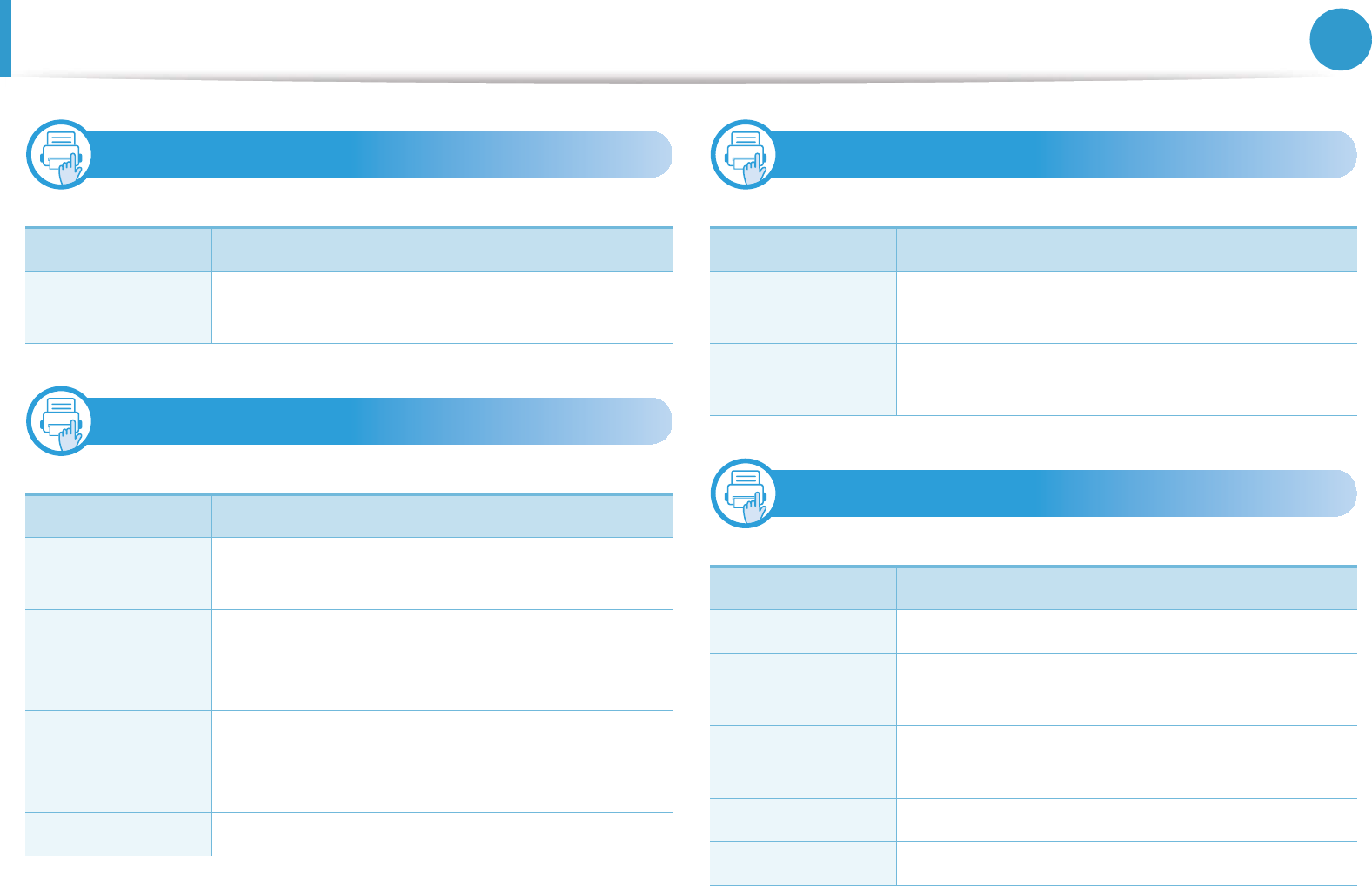
System setup 79
3. Useful setting menus
15
ImageOverwrite
16
USB setup
17
Emulation setup
18
Email setup
Item Description
Manual You can overwrite the embedded USB memory
to clear all of the data stored in.
Option Description
Print From Views the file list from the File Navigation.
Select a file to print.
Scan to USB
Sets scan destination to a USB. You scan the
originals and save the scanned image to a USB
device.
File Manage Views the file list from the File Navigation.
Select a file to delete. You can format the USB
device.
Show Space Shows the remaining space.
Item Description
Emulation Type The machine language defines how the
computer communicates with the machine.
Setup Sets the detailed settings for the selected
emulation type.
Option Description
SMTP Server Sets the SMTP server configuration.
Send to Self Sets to send the mail to yourself so that you can
back up the email or use as a reminder.
Default To
Address
Sets an email destination address as a default
one.
Default From Sets a sender’s email address as a default one.
Default Subject Sets an email’s subject as a default one.
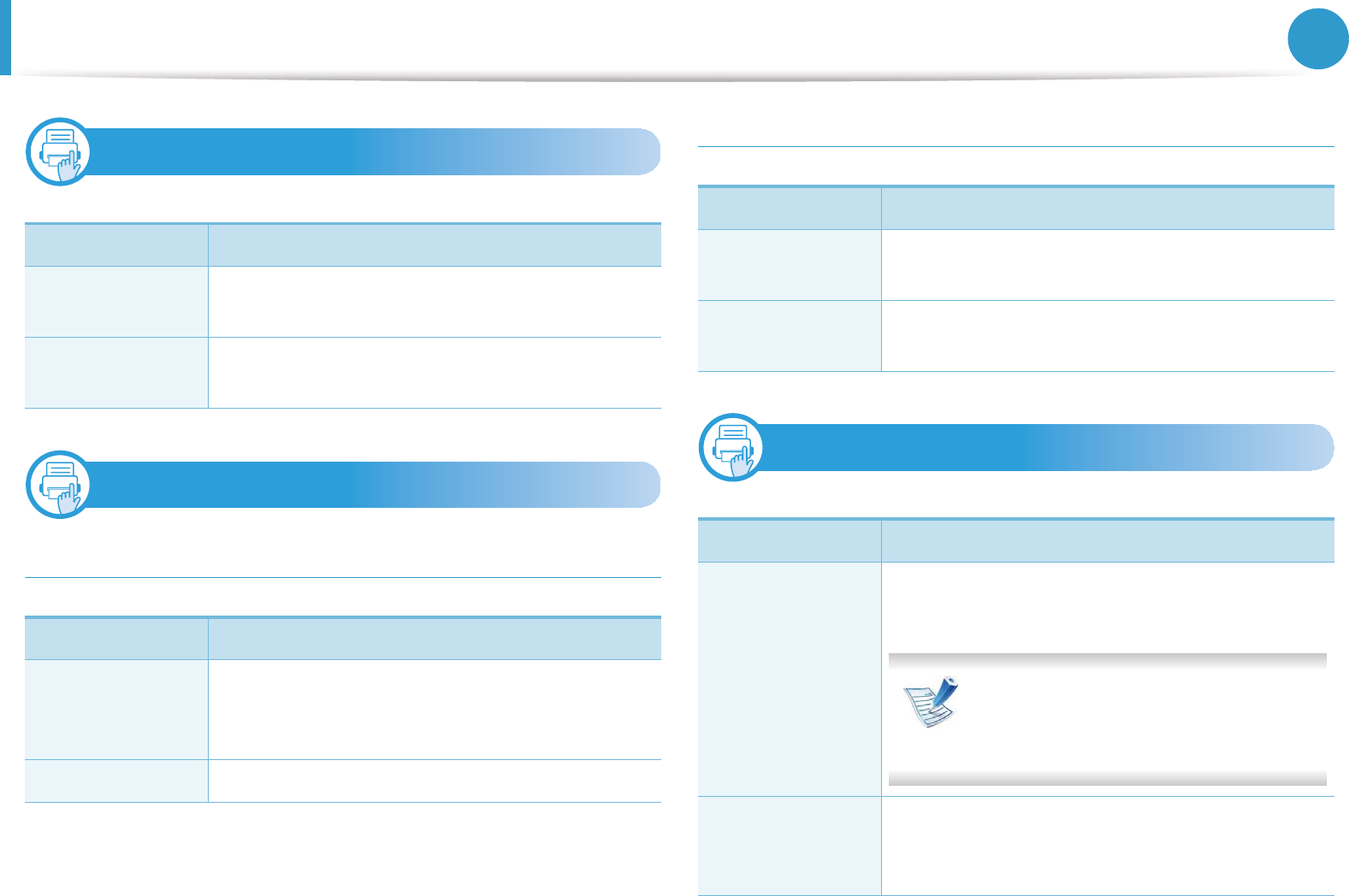
System setup 80
3. Useful setting menus
19
Address book setup
20
Document Box setup
Doc Box Feature
Doc Box Setup
21
Network setup
Option Description
PhoneBook Adds, views, prints or deletes the the phonebook
list. You also can create a group.
Email Adds, views, prints or deletes the the email list.
You also can create a group.
Option Description
Add From Scan Stores scanned documents in a box. The stored
file will be named automatically as
"yearmonthdayhourminutesecond".
Task From Box Prints a document from a box.
Option Description
Add From Scan Sets the default options for storing the
document to a box.
Task From Box Sets the default options for printing the
document from a box.
Option Description
TCP/IP (IPv4)
Selects the appropriate protocol and configure
parameters to use the network environment.
There are lots of parameters to be set.
If you are not sure, leave as is, or
consult the network administrator.
TCP/IP (IPv6)
Selects this option to use the network
environment through IPv6 (see "IPv6
configuration" on page 28).
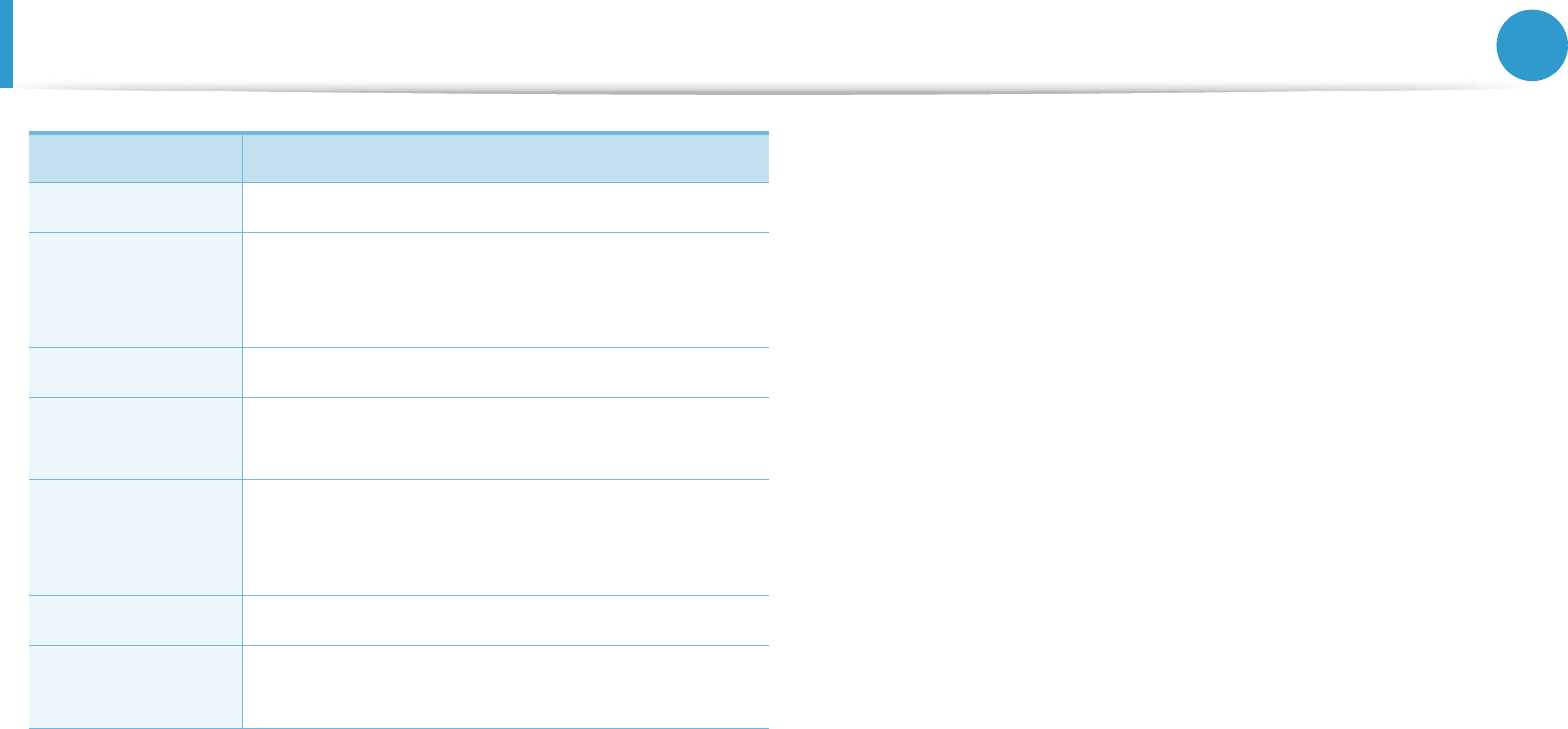
System setup 81
3. Useful setting menus
Ethernet Speed Configure the network transmission speed.
802.1x
You can selects the user authentication for
network communication. For detailed
information consult the network administrator.
Wireless Selects this option to use the wireless network.
Clear Setting Reverts the network settings to the default
values. (Reboot required.)
Network Conf.
(Network
Configuration)
This list shows information on your machine’s
network connection and configuration.
Net. Activate You can sets whether to use Ethernet on or off.
Http Activate You can sets whether to use SyncThru™ Web
Service or not.
Option Description
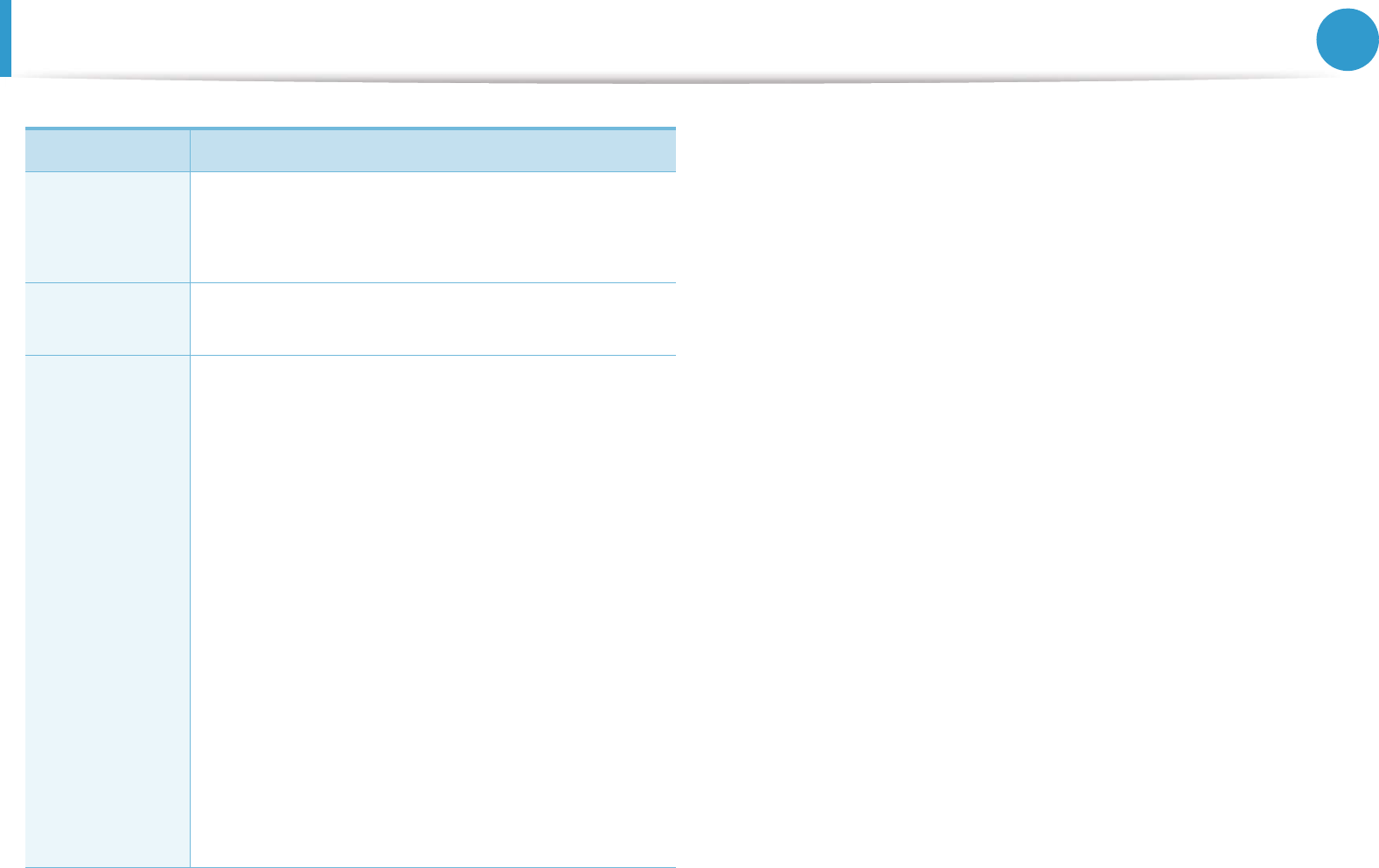
82
3. Useful setting menus
Admin setup
Item Description
Password
Protect
Sets the password to access the Admin
G
Setup
menu.GSelect On to use this option and enter the
passwordU
Change
Password
Changes the machine’s password for accessing the
Admin Setup.
Maintenance
•Clean Fuser: Cleans the fuser by printing a
sheet. The printed sheet has toner debris on it.
•CLR Empty Msg.: Prevents the TonerLow Alert
message from appearing on the display.
•Supplies Info.: Allows you to check how many
pages are printed and how much toner is left in
the cartridge.
•TonerLow Alert: If toner in the cartridge has run
out, a message informing the user to change the
toner cartridge appears. You can set the option
for this message to appear or not.
•Ram Disk: Enables/disables RAM disk to manage
jobs. Depending on the installed optional
memory size, you can set the RAM disk size to
between 32 and 64 MB. This option does not
appear if you have installed hard disk drive
(HDD).

83
3. Useful setting menus
Custom setup
This menu appears only when the XOA (eXtensible Open
Architecture) web application is installed. Contact the administrator
to use this menu.

4. Special features
This chapter explains special copying, scanning, faxing, and printing features.
• Altitude adjustment 85
• Changing the font setting 86
• Storing email address 87
• Entering various characters 89
• Setting up the address book 90
• Registering authorized users 93
• Printing features 94
• Fax features 111
• Scan features 114
• Using shared folder features 123
• Using memory/hard drive features 124
• The procedures in this chapter are mainly based on Windows 7.
• It may be necessary to press OK to navigate to lower-level menus for
some models.
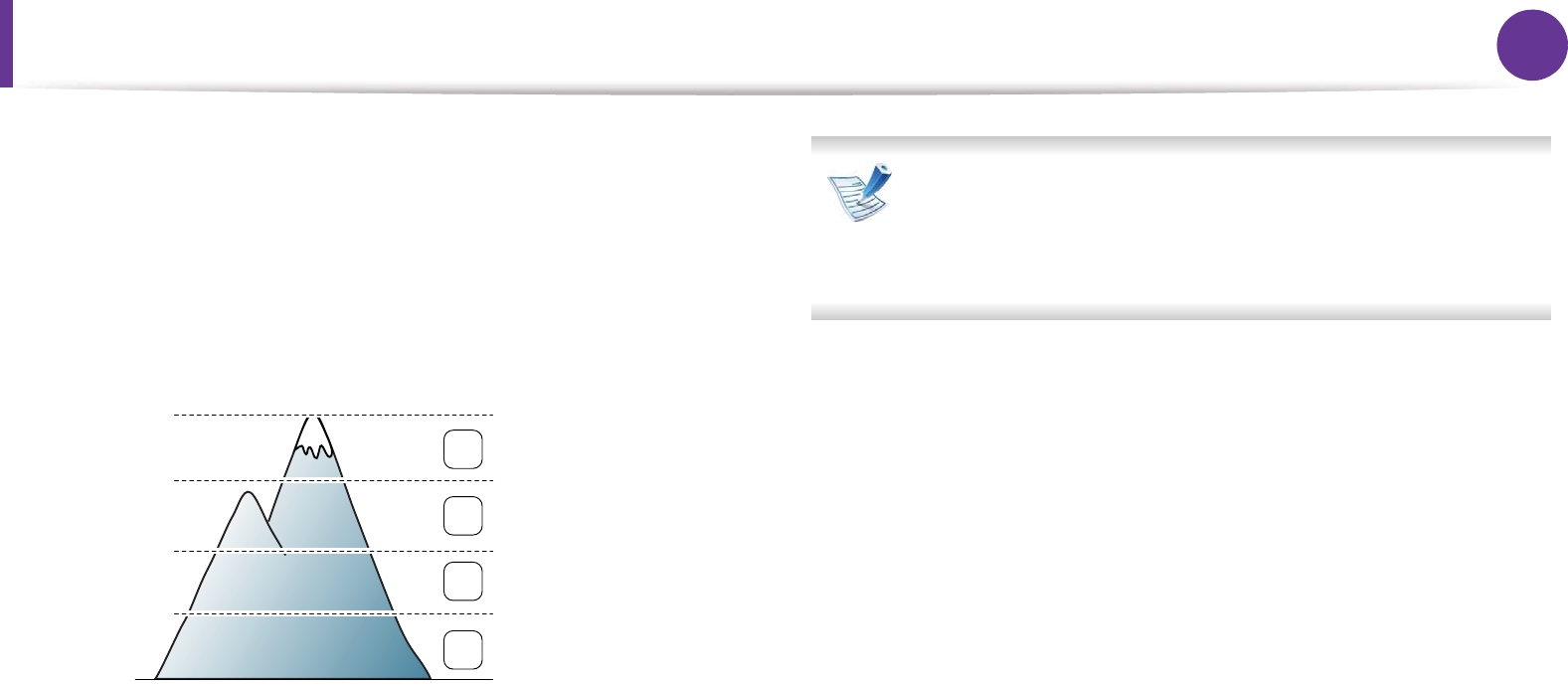
85
4. Special features
Altitude adjustment
Print quality is affected by atmospheric pressure, which is
determined by the height of the machine above sea level. The
following information will guide you on how to set your machine for
the best print quality.
Before you set the altitude value, determine the altitude where you
are.
You can set the altitude value from Device Settings or Machine
section in Printer Settings Utlity program.
• For Windows and Macintosh users, see "Device Settings" on page
135.
• For Linux users, see "Using Smart Panel ( Linux only)" on page
137.
• If your machine is connected to the network, you can set
the altitude via SyncThru™ Web Service.
• You can also set the altitude in System Setup option on
the machine’s display.
1High 3
2High 2
3High 1
4Normal
0
4,000 m
(13,123 ft)
3,000 m
(9,842 ft)
2,000 m
(6,561 ft)
1,000 m
(3,280 ft)
4
3
2
1
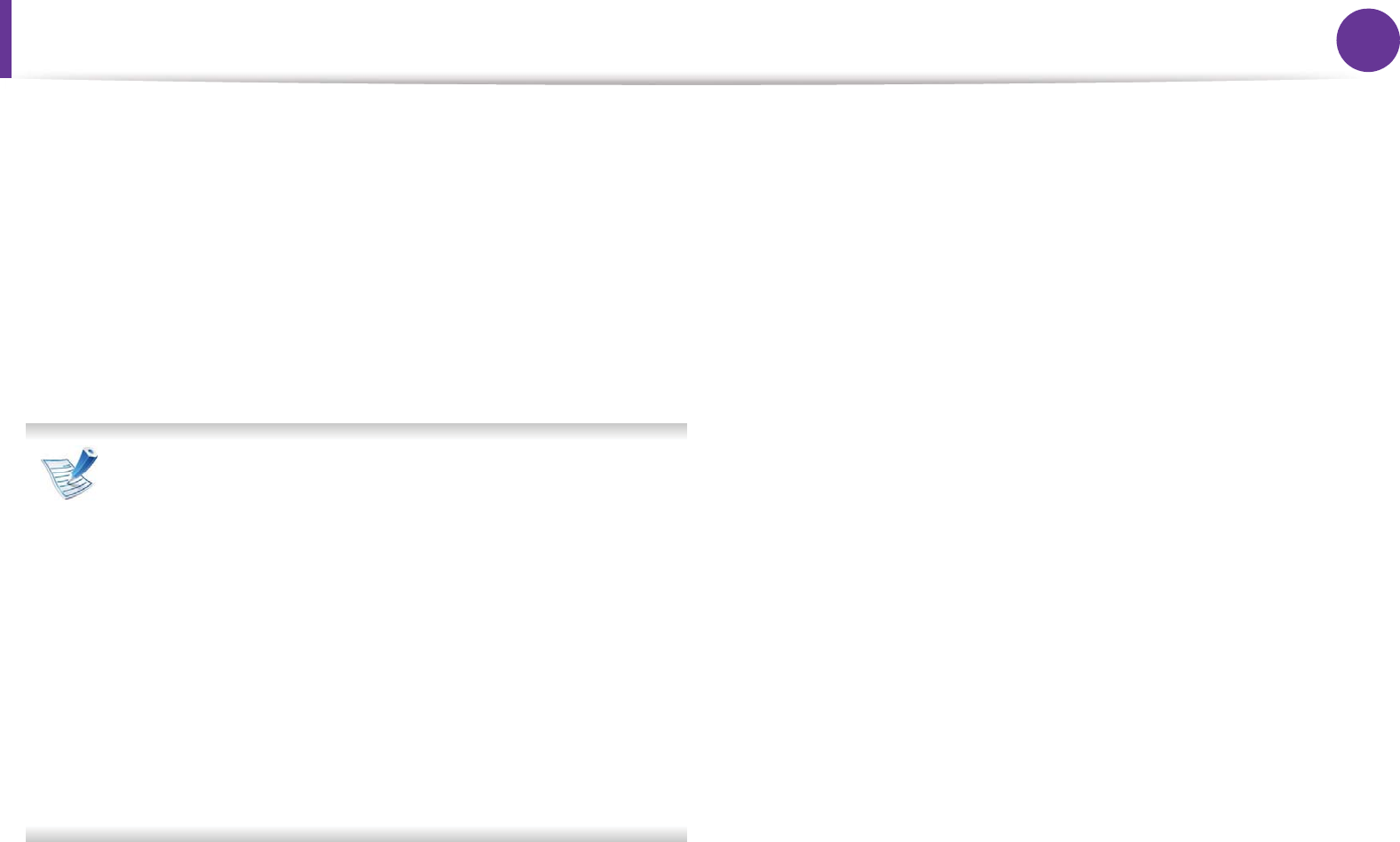
86
4. Special features
Changing the font setting
Your machine has preset the font for your region or country.
If you want to change the font or set the font for special condition,
such as the DOS environment, you can change the font setting from
Emulation section in Printer Settings Utility program.
• For Windows and Macintosh users, see "Advanced settings user
interface overview" on page 135.
• For Linux, or Unix OS users, see "Using Smart Panel ( Linux only)"
on page 137.
• If your machine is connected to the network, you can set
the font setting via SyncThru™ Web Service.
• You can also change the font setting in Emulation option
on the machine’s display.
• The following information shows the proper font list for
corresponding languages.
-Russian: CP866, ISO 8859/5 Latin Cyrillic
-Hebrew: Hebrew 15Q, Hebrew-8, Hebrew-7 (Israel only)
-Greek: ISO 8859/7 Latin Greek, PC-8 Latin/Greek
-Arabic & Farsi: HP Arabic-8, Windows Arabic, Code
Page 864, Farsi, ISO 8859/6 Latin Arabic
-OCR: OCR-A, OCR-B
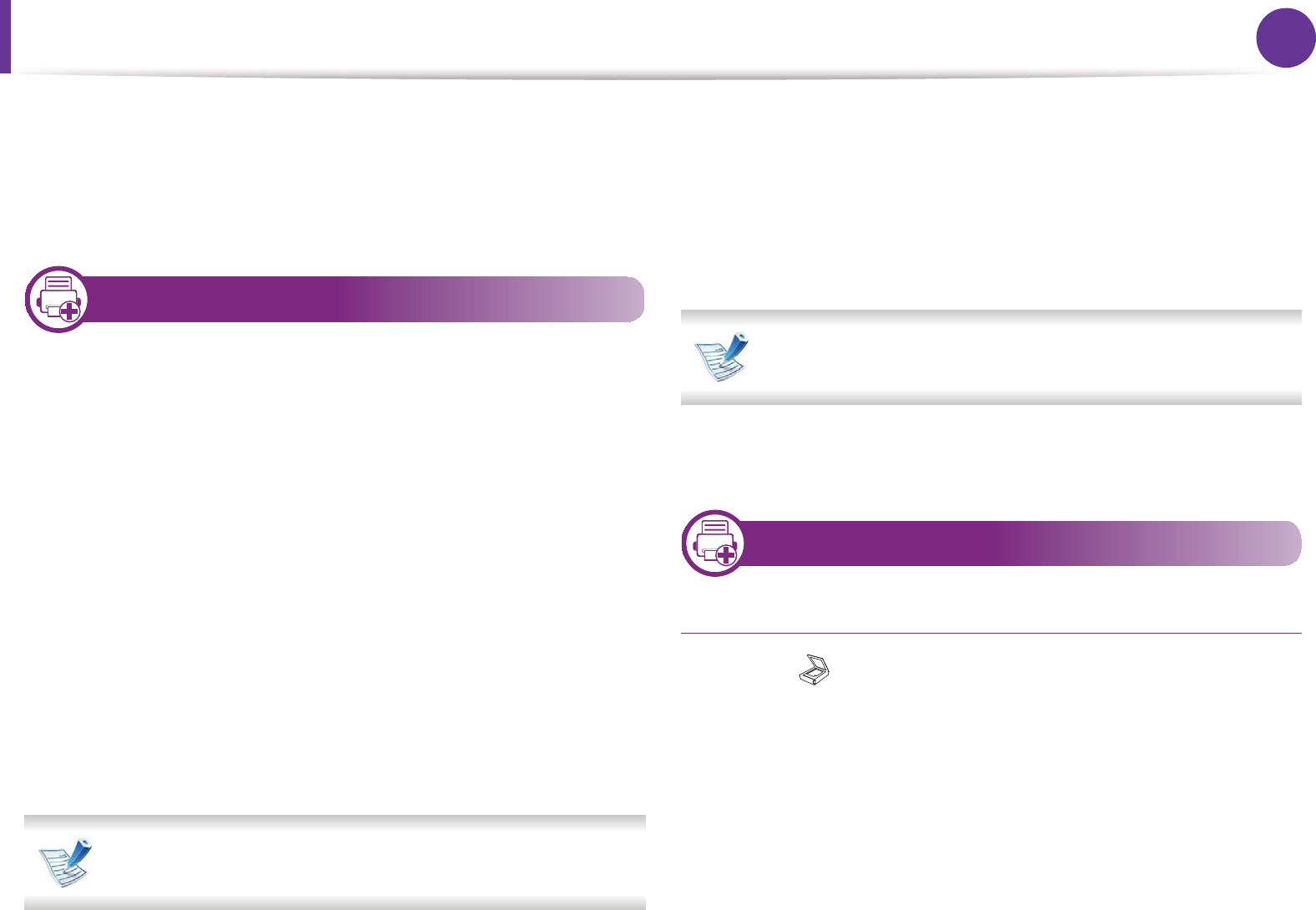
87
4. Special features
Storing email address
You can set up address book with the email addresses you use
frequently via SyncThru™ Web Service and then easily and quickly
enter email addresses by entering the location numbers assigned to
them in address book.
1
Storing on your local machine
1Access the SyncThru™ Web Service (see "Using SyncThru™
Web Service" on page 130).
2 Click Login on the upper right of the SyncThru™ Web Service
website.
3 Type in the ID and Password then click Login.
•ID: admin
•Password: sec00000
4 Click Address Book > Individual > Add.
5 Select the Speed No. and enter e-mail address and fax
number.
• If you need to set SMB or FTP sever information, check SMB
or FTP and set the information.
6 Click Apply.
7 If you make a group, click Address Book > E-mail Group >
Add Group.
8 Select the Speed No. and enter Group Name.
• You can easily add individual address if you check Yes for
Add individual(s) after this group is created.
9 Click Apply.
2
Searching for an address
Searching sequentially through memory
1Select (Scan) > Address Book > Search & Send > Select an
address group > All on the control panel.
Or select Setup > Machine Setup > Next > Address Book >
Email > View List > Individual or Group on the touch screen.
2 Search upwards or downwards through the entire memory in
index (numerical) order, and select the name and address you
want.

Storing email address 88
4. Special features
Searching with a particular first letter
1Select (Scan) > Address Book > Search & Send > Select an
address group > ID on the control panel.
2 Enter the first few letters of the name you want.
3 Search upwards or downwards, and select the name and
address you want.
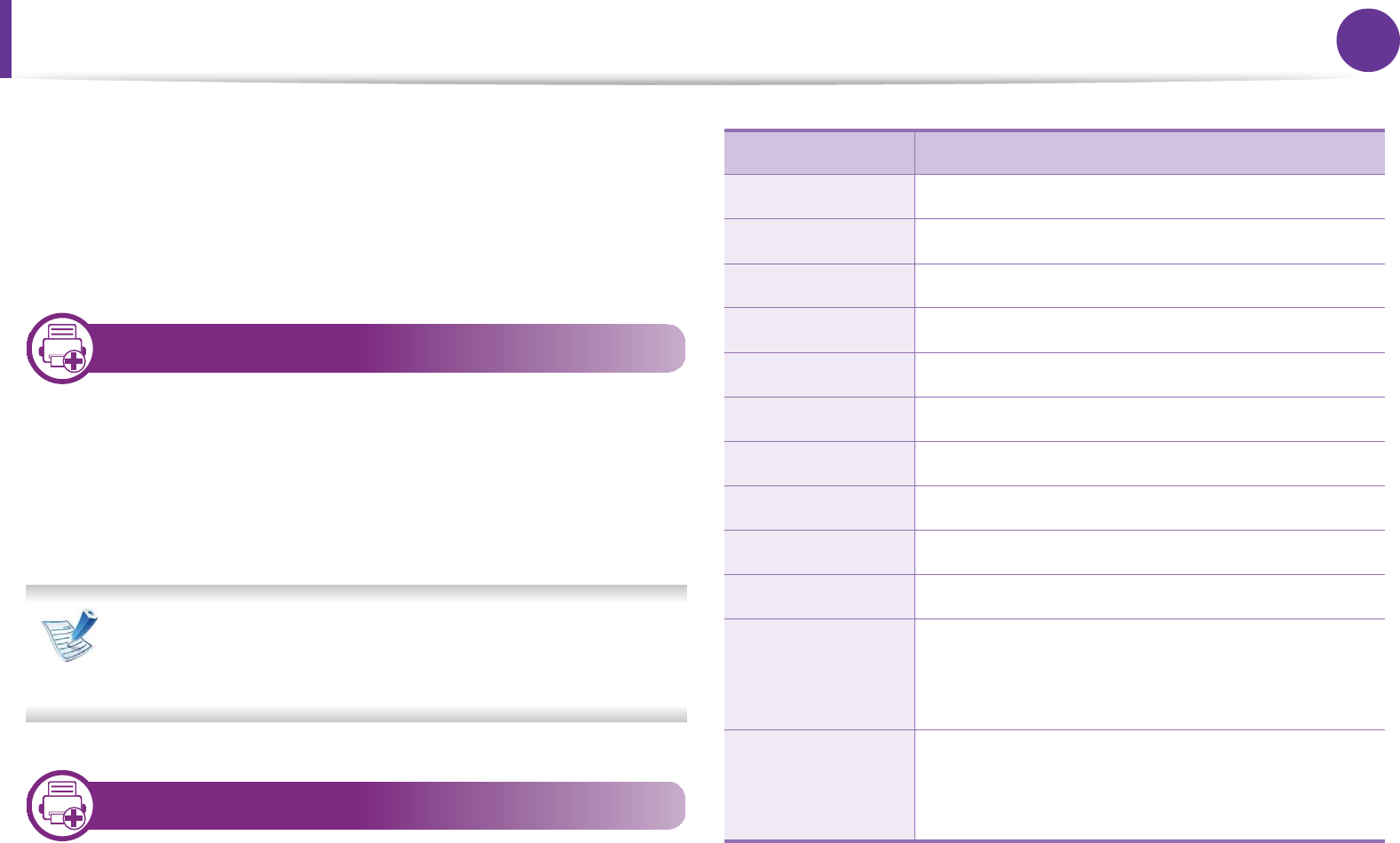
89
4. Special features
Entering various characters
As you perform various tasks, you may need to enter names and
numbers. For example, when you set up your machine, you enter
your name or your company’s name, and the fax number. When you
store fax numbers or email addresses in memory, you may also enter
the corresponding names.
3
Entering alphanumeric characters
Press the button until the correct letter appears on the display. For
example, to enter the letter O, press 6, labeled with MNO. Each time
you press 6, the display shows a different letter, M, N, O, m, n, o and
finally 6. To find the letter that you want to enter, see "Keypad letters
and numbers" on page 89.
• You can enter a space by pressing 1 twice.
• To delete the last digit or character, press the left/right or
up/down arrow button.
4
Keypad letters and numbers
Special character sets may differ from your machine depending on
its options or the models.
Key Assigned numbers, letters, or characters
1@ / . ‘ 1
2A B C a b c 2
3D E F d e f 3
4G H I g h i 4
5J K L j k l 5
6M N O m n o 6
7P Q R S p q r s 7
8T U V t u v 8
9W X Y Z w x y z 9
0& + - , 0
*
* % ^ _ ~ ! # $ ( ) [ ]
(These symbols are available when you type for
network authentication.)
#
# = | ? " : { } < > ;
(These symbols are available when you type for
network authentication.)
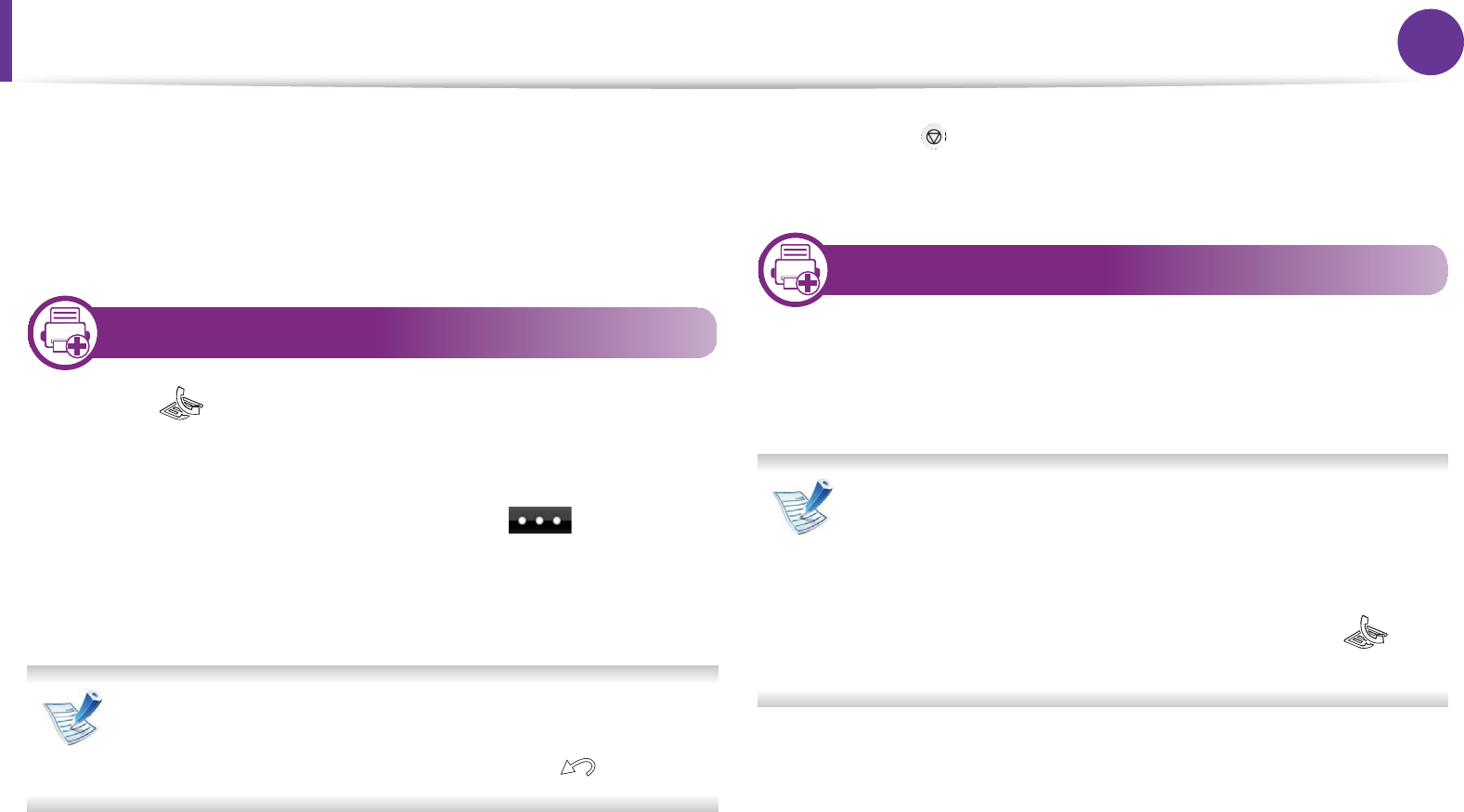
90
4. Special features
Setting up the address book
You can set up speed number with the fax numbers you use
frequently via SyncThru™ Web Service and then easily and quickly
enter fax numbers by entering the location numbers assigned to
them in address book.
5
Registering a speed dial number
1Select (Fax) > Address Book > New & Edit > Speed Dial
on the control panel.
Or select Setup > Machine Setup > Next > Address Book >
Phone Book > View List > Individual > (options) >
Add on the touch screen.
2 Enter a speed dial number and press OK.
If an entry is already stored in the number you choose, the
display shows the message to allow you to change it. To start
over with another speed dial number, press (Back).
3 Enter the name you want and press OK.
4 Enter the fax number you want and press OK.
5 Press the (Cancel or Stop/Clear) button to return to ready
mode.
6
Using speed dial numbers
When you are prompted to enter a destination number while
sending a fax, enter the speed dial number at which you stored the
number you want.
• For a one-digit (0-9) speed dial number, press and hold the
corresponding digit button on the number keypad.
• For a two- or three-digit speed dial number, press the first
digit button(s) and then hold down the last digit button.
• You can print the address book list by selecting (Fax)
> Address Book > Print.
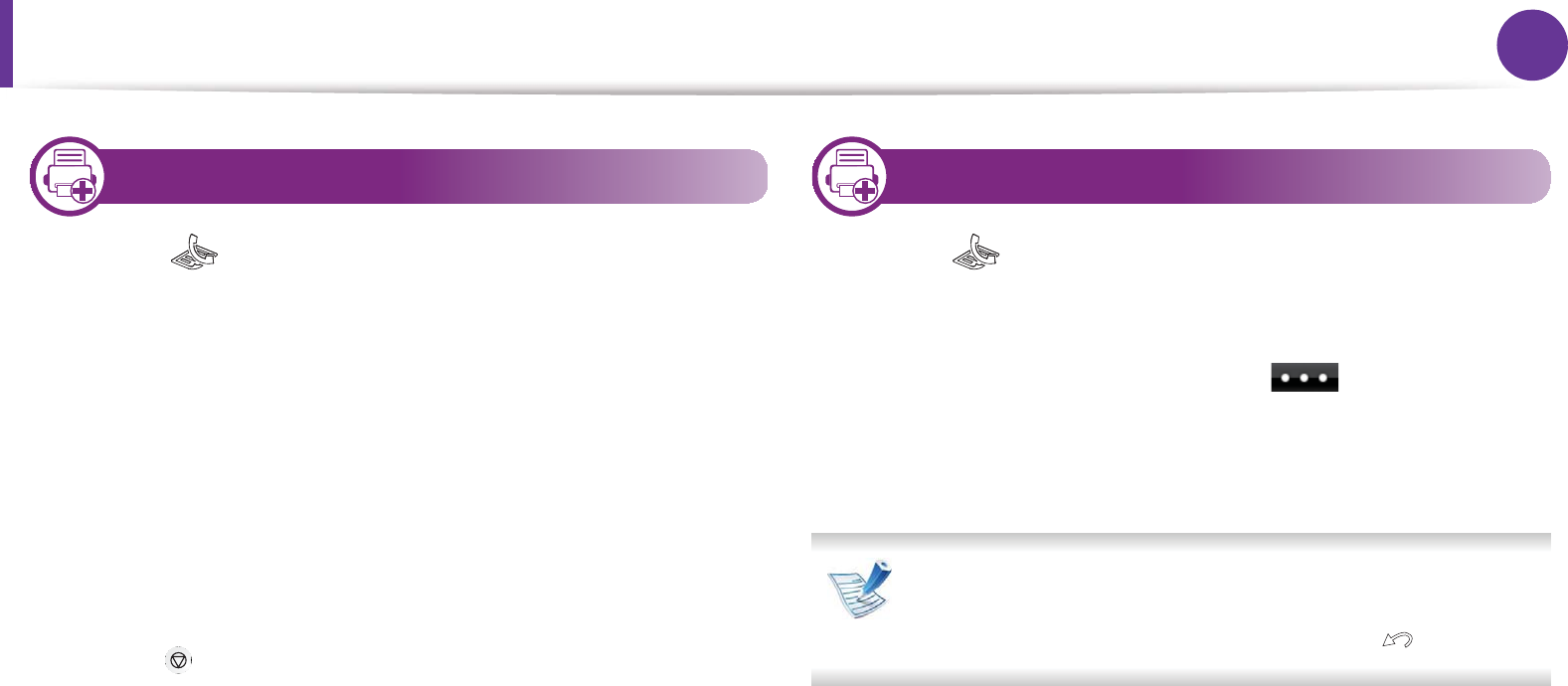
Setting up the address book 91
4. Special features
7
Editing speed dial numbers
1Select (Fax) > Address Book > New & Edit > Speed Dial
on the control panel.
Or select Setup > Machine Setup > Next > Address Book >
Phone Book > View List > Individual on the touch screen.
2 Enter the speed dial number you want to edit and press OK.
3 Change the name and press OK.
4 Change the fax number and press OK.
5 Press (Cancel or Stop/Clear) to return to ready mode.
8
Registering a group dial number
1Select (Fax) > Address Book > New & Edit > Group Dial
on the control panel.
Or select Setup > Machine Setup > Next >Address Book >
Phone Book > View List > Group> (options) > Add on
the touch screen.
2 Enter a group dial number and press OK.
If an entry is already stored in the number you choose, the
display shows the message to allow you to change it. To start
over with another speed dial number, press (Back).
3 Search by entering the first few letters of the speed dial’s
name to put in the group.
4 Select the name and number you want and press OK.
5 Select Yes when Another Number? appears.
6 Repeat step 3 to include other speed dial numbers into the
group.

Setting up the address book 92
4. Special features
7 When you have finished, select No when Another Number?
appears and press OK.
8 Press (Cancel or Stop/Clear) to return to ready mode.
9
Editing group dial numbers
1Select (Fax) > Address Book > New & Edit > Group Dial
on the control panel.
Or select Setup > Machine Setup > Next > Address Book >
Phone Book > View List > Group on the touch screen.
2 Enter the group dial number you want to edit and press OK.
3 Enter a new speed dial number to add and press OK, then
Add? appears.
Enter a speed dial number stored in the group and press OK,
Delete? appears.
4 Press OK to add or delete the number.
5 Repeat step 3 to add or delete more numbers.
6 Select No at the Another Number? and press OK.
7 Press (Cancel or Stop/Clear) to return to ready mode.

93
4. Special features
Registering authorized users
If you have connected your machine to a network and set up the
network parameters correctly, you can scan and send images over
the network. To send a scanned image through email or via network
server safely, you must register account information of authorized
users to your local machine using SyncThru™ Web Service.
1Access the SyncThru™ Web Service (see "Using SyncThru™
Web Service" on page 130).
2 Click Login on the upper right of the SyncThru™ Web Service
website.
3 Type in the ID and Password then click Login.
•ID: admin
•Password: sec00000
4 Click Security > User Access Control > Authentication.
5 Select Local Authentication in the the Authentication
Method, and click Apply.
6 Click OK in the confirmation pop-up window.
7 Click User Profile > Add.
8 Enter User Name, Login ID, Password, Confirm Password, E-
mail Address, and Fax Number.
You can easily add individual address if you check Yes for
Add individual(s) after this group is created.
9 Click Apply.
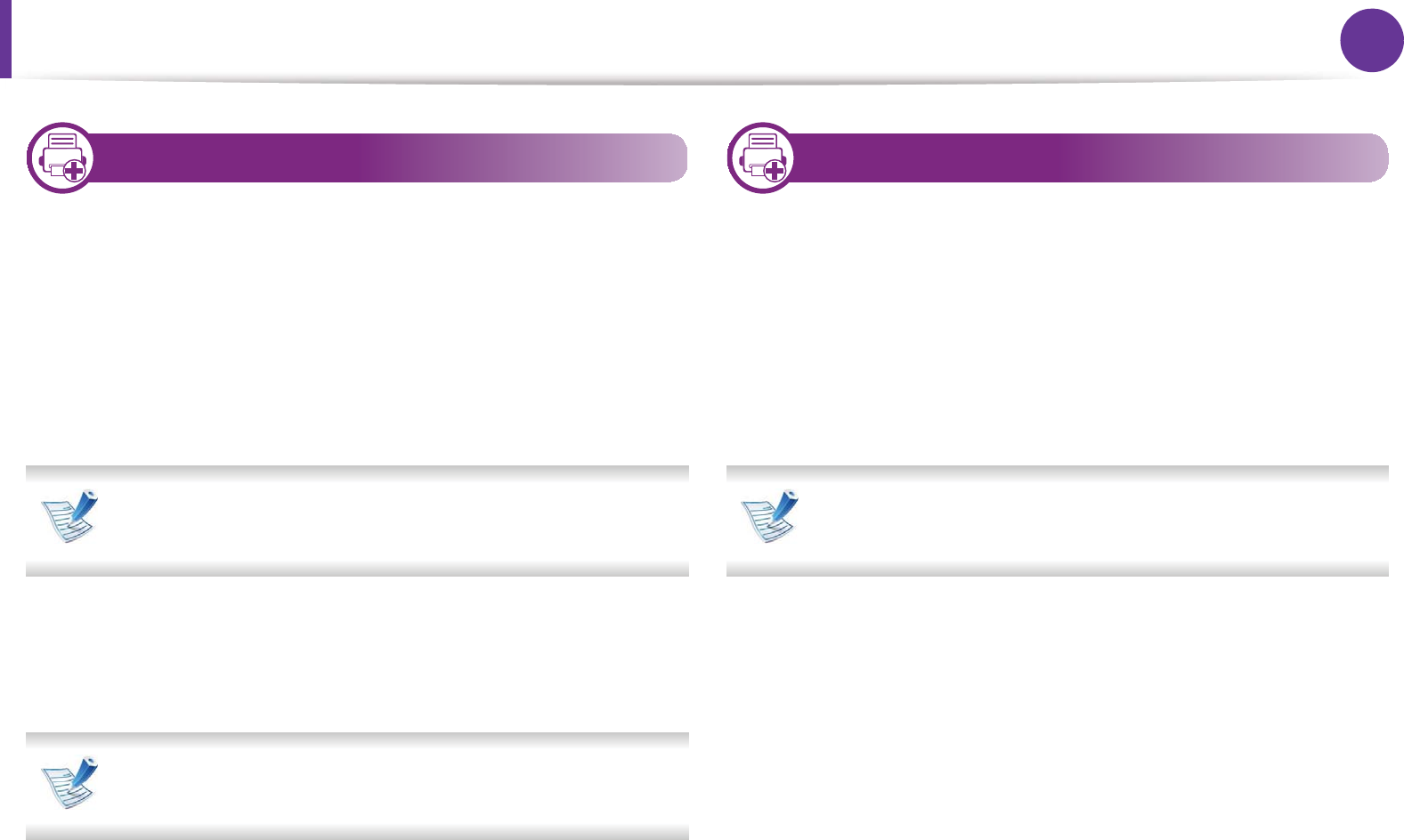
94
4. Special features
Printing features
10
Changing the default print settings
1Click the Windows Start menu.
2 Select Control Panel > Devices and Printers.
3 Right-click on your machine.
4 Select Printing preferences.
If Printing preferences has a ൘, you can select other printer
drivers connected to the selected printer.
5 Change the settings on each tab.
6 Click OK.
If you want to change the settings for each print job, change
it in Printing Preferences.
11
Setting your machine as a default machine
1Click the Windows Start menu.
2 Select Control Panel > Devices and Printers.
3 Select your machine.
4 Right-click your machine and select Set as Default Printer.
If Printing preferences has a ൘, you can select other printer
drivers connected to the selected printer.
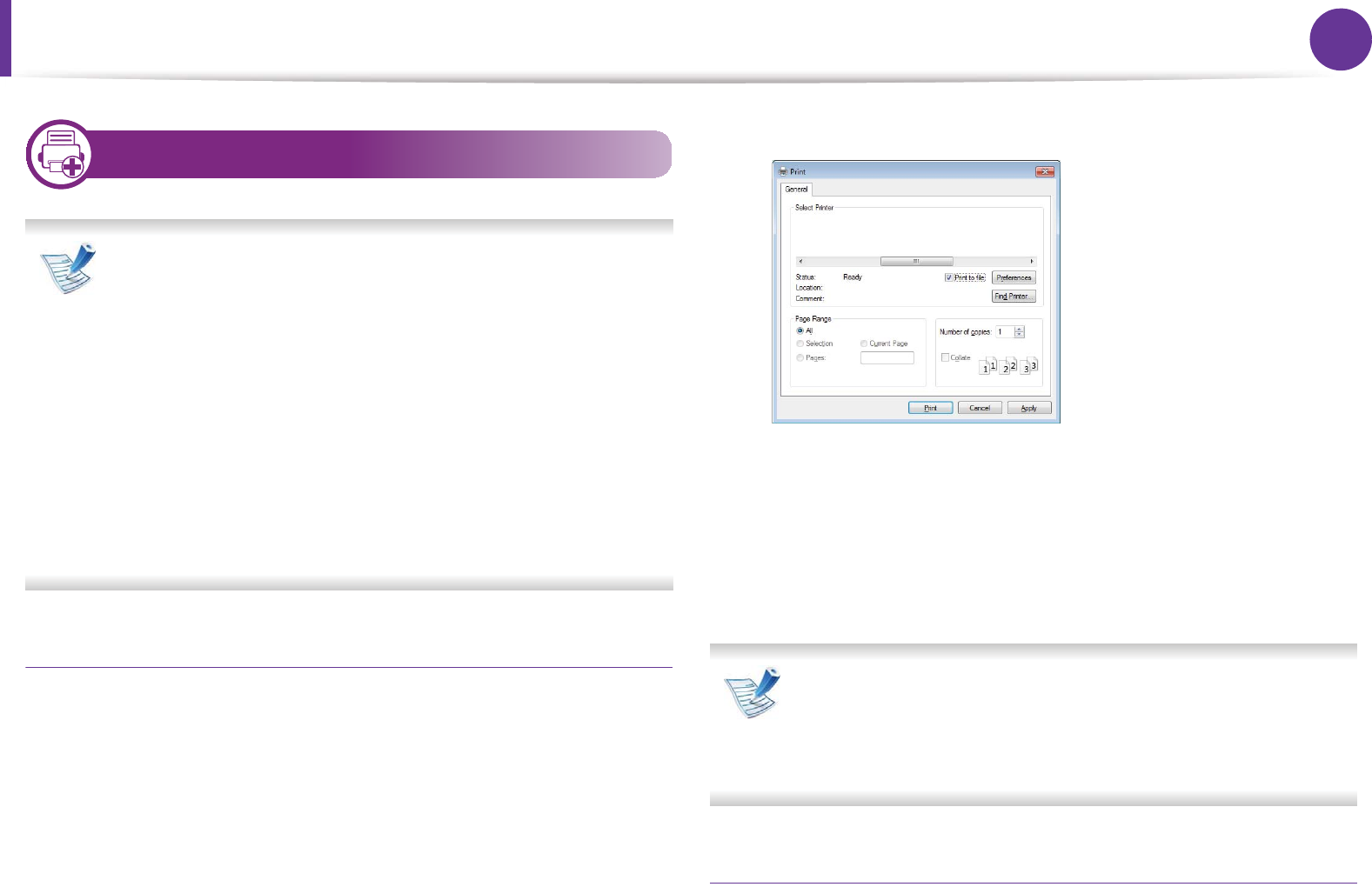
Printing features 95
4. Special features
12
Using advanced print features
XPS printer driver: used to print XPS file format.
• The XPS printer driver can be installed only on Windows
Vista OS or higher.
• You can install the XPS printer driver when you insert the
software CD into your CD-ROM drive. When the
installation window appears, select Advanced
Installation > Custom Installation. You can select the
XPS printer driver in the Select Software and Utilities to
Install window.
• Install optional memory when an XPS job does not print
because the printer is out of memory.
Printing to a file (PRN)
You will sometimes need to save the print data as a file.
1Check the Print to file box in the Print window.
2 Click Print.
3 Type in the destination path and the file name, and then click
OK.
For example, c:\Temp\file name.
If you type in only the file name, the file is automatically
saved in My Documents, Documents and Settings, or
Users. The saved folder may differ, depending on your
operating system or the application you are using.
Understanding special printer features
You can use advanced printing features when using your machine.
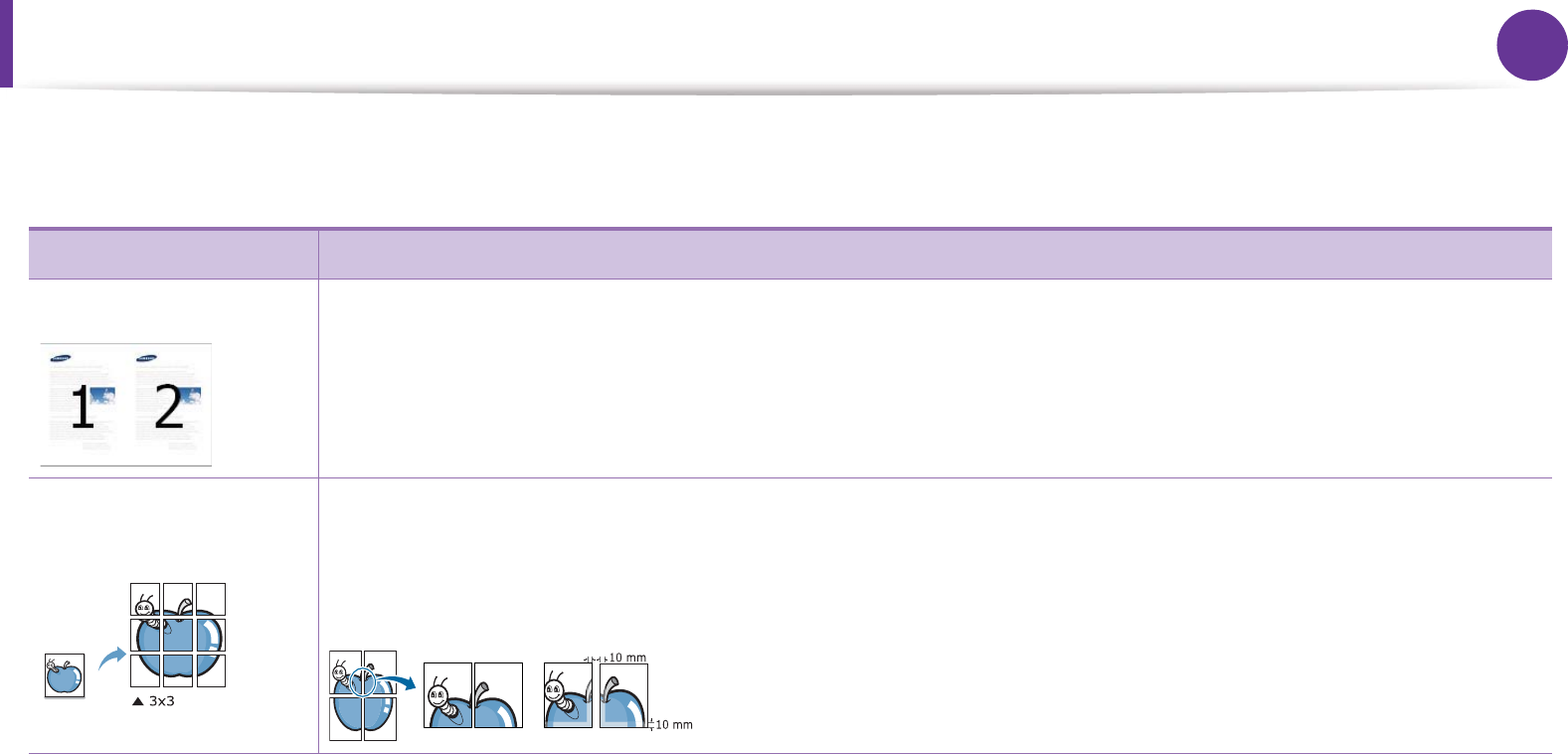
Printing features 96
4. Special features
To take advantage of the printer features provided by your printer driver, click Properties or Preferences in the application’s Print window
to change the print settings. The machine name, that appears in the printer properties window may differ depending on the machine in use.
Item Description
Multiple Pages per Side Selects the number of pages to print on a single sheet of paper. To print more than one page per sheet, the pages will
be reduced in size and arranged in the order you specify. You can print up to 16 pages on one sheet.
Poster Printing
Prints a single-page document onto 4 (Poster 2x2), 9 (Poster 3x3), or 16 (Poster 4x4) sheets of paper, for the purpose
of pasting the sheets together to form one poster-size document.
Select the Poster Overlap value. Specify Poster Overlap in millimeters or inches by selecting the radio button on the
upper right of Basic tab to make it easier to paste the sheets together.
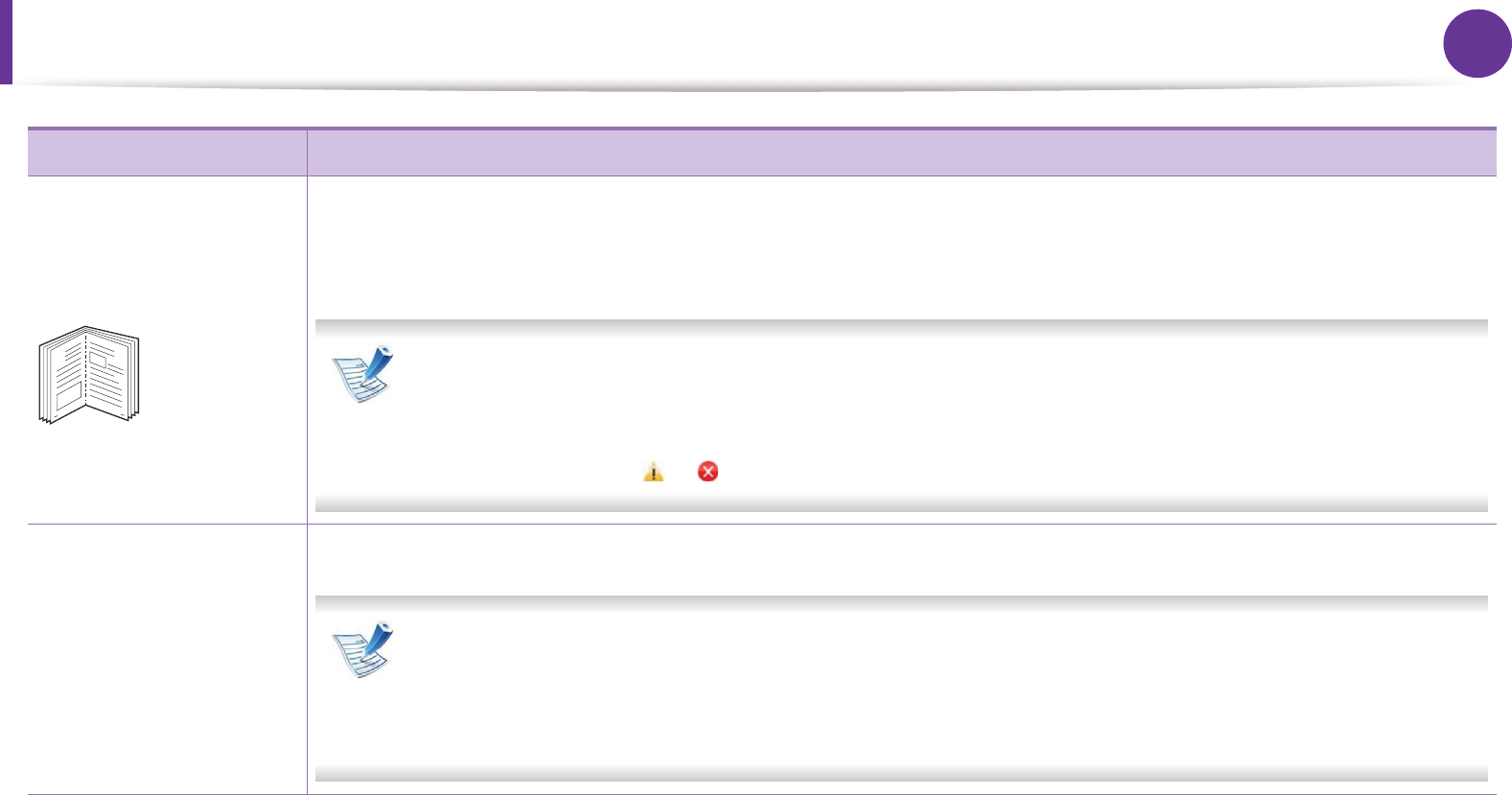
Printing features 97
4. Special features
Booklet Printing
Prints your document on both sides of a sheet of paper and arranges the pages so that the paper can be folded in half
after printing to produce a booklet.
If you want to make a booklet, you need to print on Letter, Legal, A4, US Folio, or Oficio sized print media.
The Booklet Printing option is not available for all paper sizes. Select the available paper Size option under
the Paper tab to see what paper sizes are available.
If you select an unavailable paper size, this option can be automatically canceled. Select only available
paper (paper without or mark).
Double-sided Printing
Print on both sides of a sheet of paper (duplex). Before printing, decide how you want your document oriented.
• You can use this feature with Letter, Legal, A4, US Folio or Oficio sized paper
• If your machine does not have a duplex unit, you should complete the printing job manually. The
machine prints every other page of the document first. After that, a message appears on your computer.
•Skip Blank Pages feature does not work when you select the duplex option.
Item Description
8
9
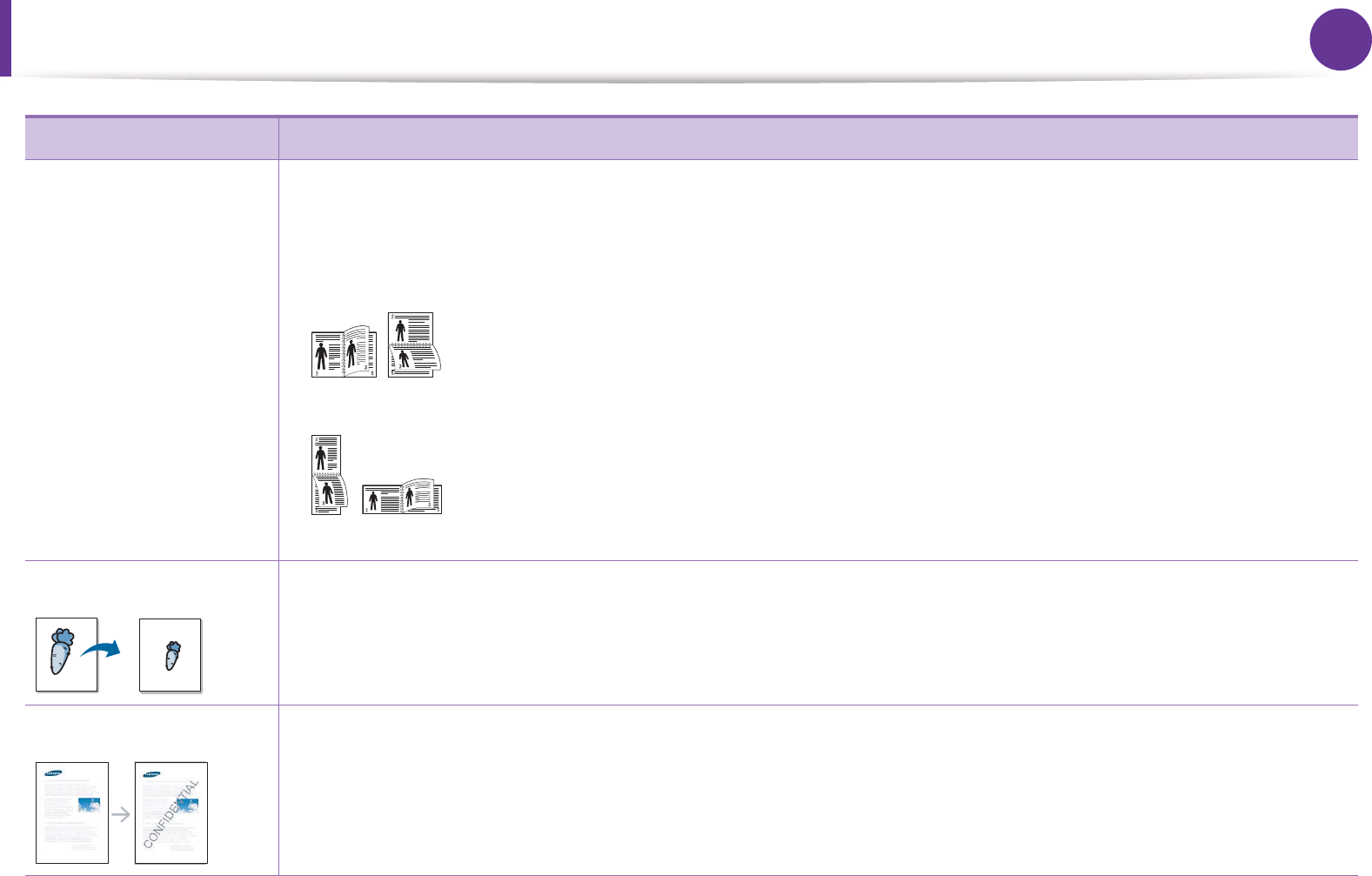
Printing features 98
4. Special features
Double-sided Printing
(continue)
•Printer Default: If you select this option, this feature is determined by the settings you have selected on the
control panel of the machine. This option is available only when you use the PCL/XPS printer driver.
•None: Disables this feature.
•Long Edge: This option is the conventional layout used in bookbinding.
•Short Edge: This option is the conventional layout used in calendars.
•Reverse Double-Sided Printing: Check this option to reverse the print order when duplex printing.
Paper Options Changes the size of a document to appear larger or smaller on the printed page by entering in a percentage by which
to enlarge or decrease the document.
Watermark The watermark option allows you to print text over an existing document. For example, you use it when you want to
have large gray letters reading “DRAFT” or “CONFIDENTIAL” printed diagonally across the first page or all pages of a
document.
Item Description
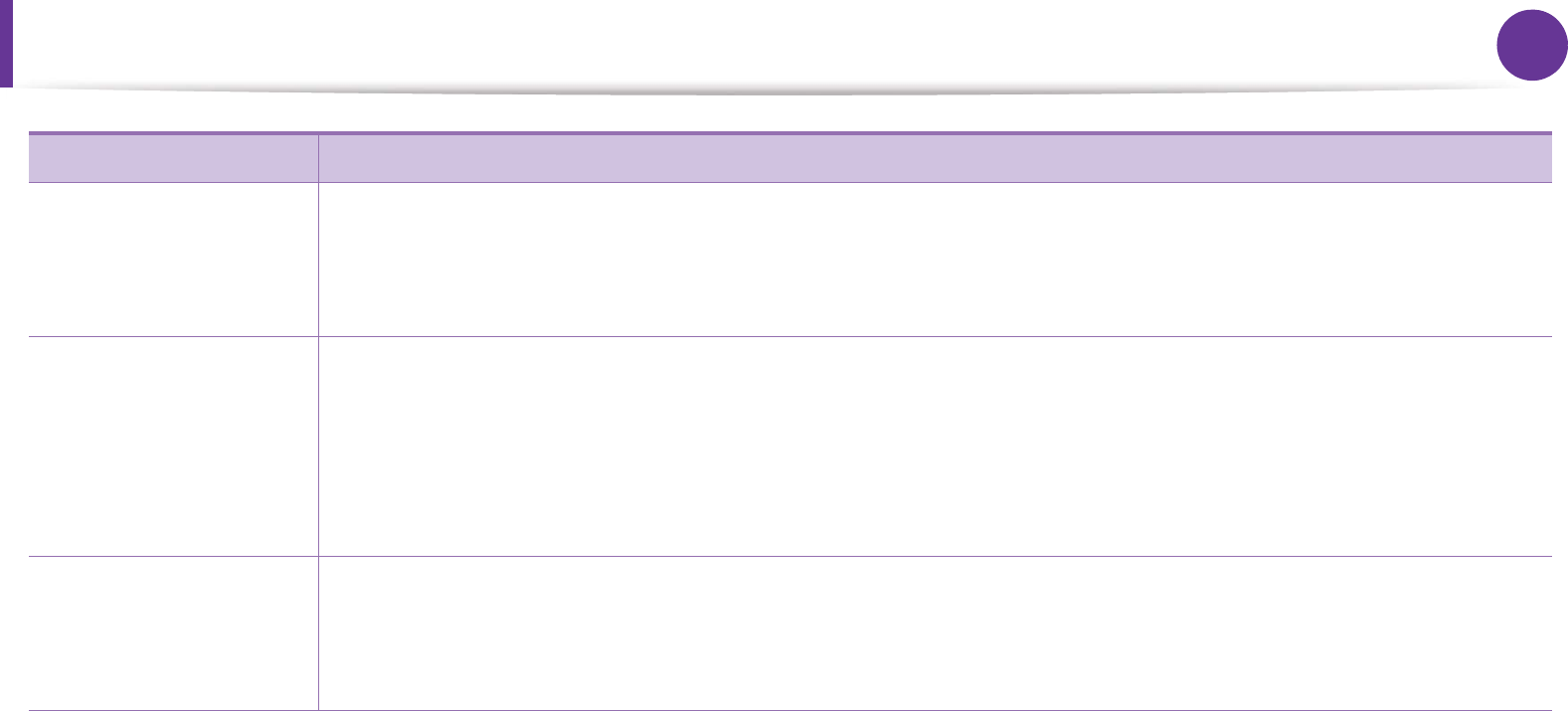
Printing features 99
4. Special features
Watermark
(Creating a watermark)
a To change the print settings from your software application, access Printing Preferences.
b Click the Advanced tab, select Edit from the Watermark drop-down list. The Edit Watermarks window appears.
c Enter a text message in the Watermark Message box.
You can enter up to 256 characters. The message displays in the preview window.
Watermark
(Editing a watermark)
a To change the print settings from your software application, access Printing Preferences.
b Click the Advanced tab, select Edit from the Watermark drop-down list. The Edit Watermarks window appears.
c Select the watermark you want to edit from the Current Watermarks list and change the watermark message and
options.
d Click Update to save the changes.
e Click OK or Print until you exit the Print window.
Watermark
(Deleting a watermark)
a To change the print settings from your software application, access Printing Preferences.
b Click the Advanced tab, select Edit from the Watermark drop-down list. The Edit Watermarks window appears.
c Select the watermark you want to delete from the Current Watermarks list and click Delete.
d Click OK or Print until you exit the Print window.
Item Description
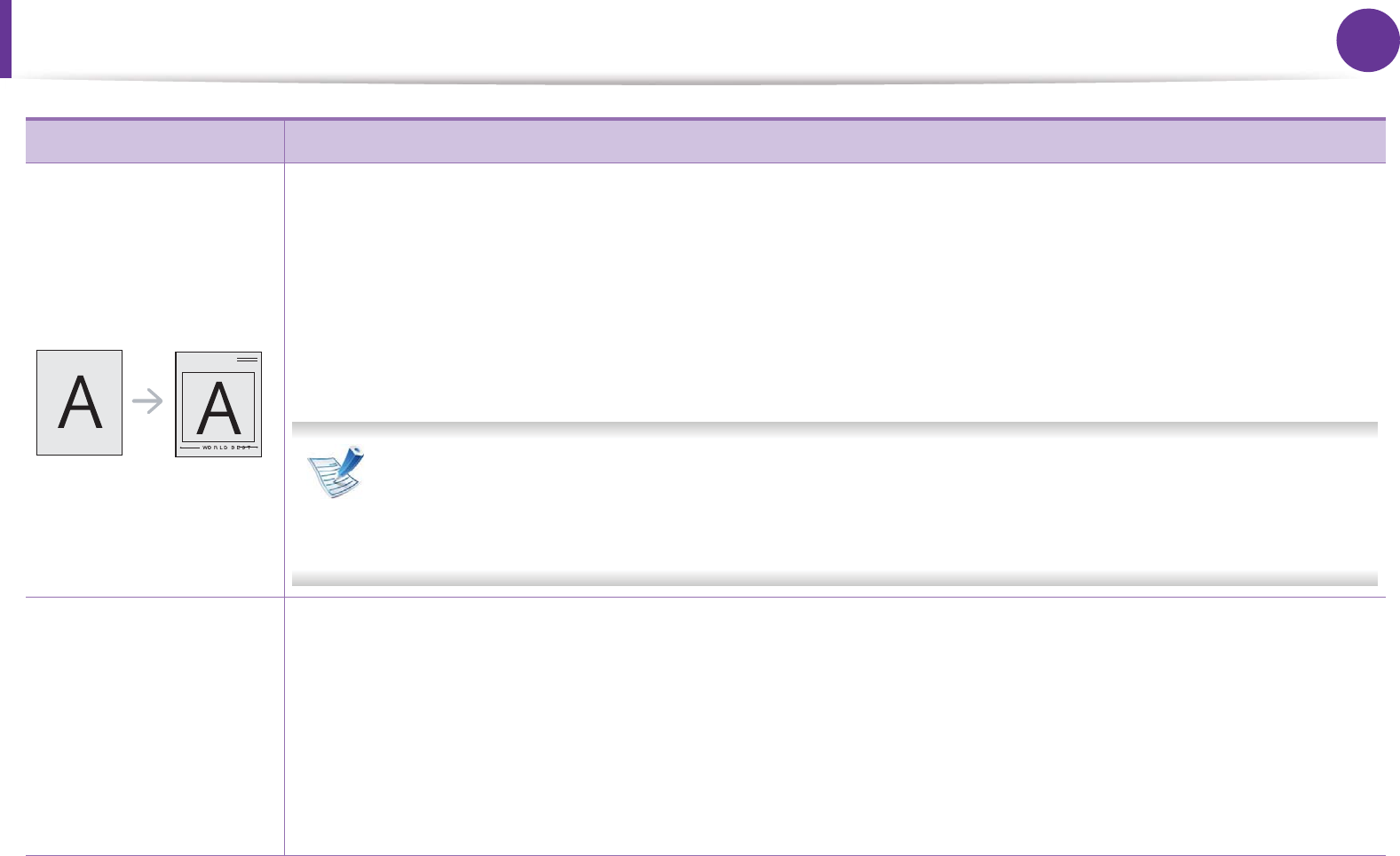
Printing features 100
4. Special features
Overlay
This option is available only when you use the PCL printer driver.
An overlay is text and/or images stored in the computer hard disk drive (HDD) as a special file format that can be
printed on any document. Overlays are often used to take the place of letterhead paper. Rather than using preprinted
letterhead, you can create an overlay containing exactly the same information that is currently on your letterhead. To
print a letter with your company’s letterhead, you do not need to load preprinted letterhead paper in the machine:
just print the letterhead overlay on your document.
To use a page overlay, you must create a new page overlay containing your logo or image.
• The overlay document size must be the same as the document you print with the overlay. Do not create
an overlay with a watermark.
• The resolution of the overlay document must be the same as that of the document you will print with
the overlay.
Overlay
(Creating a new page
overlay)
a To save the document as an overlay, access Printing Preferences.
b Click the Advanced tab, and select Edit from the Text drop-down list. Edit Overlay window appears.
c In the Edit Overlay window, click Create.
d In the Save As window, type a name up to eight characters in the File name box. Select the destination path, if
necessary (The default is C:\Formover).
e Click Save. The name appears on the Overlay List.
f Click OK or Print until you exit the Print window.
The file is not printed. Instead, it is stored on your computer hard disk drive.
Item Description
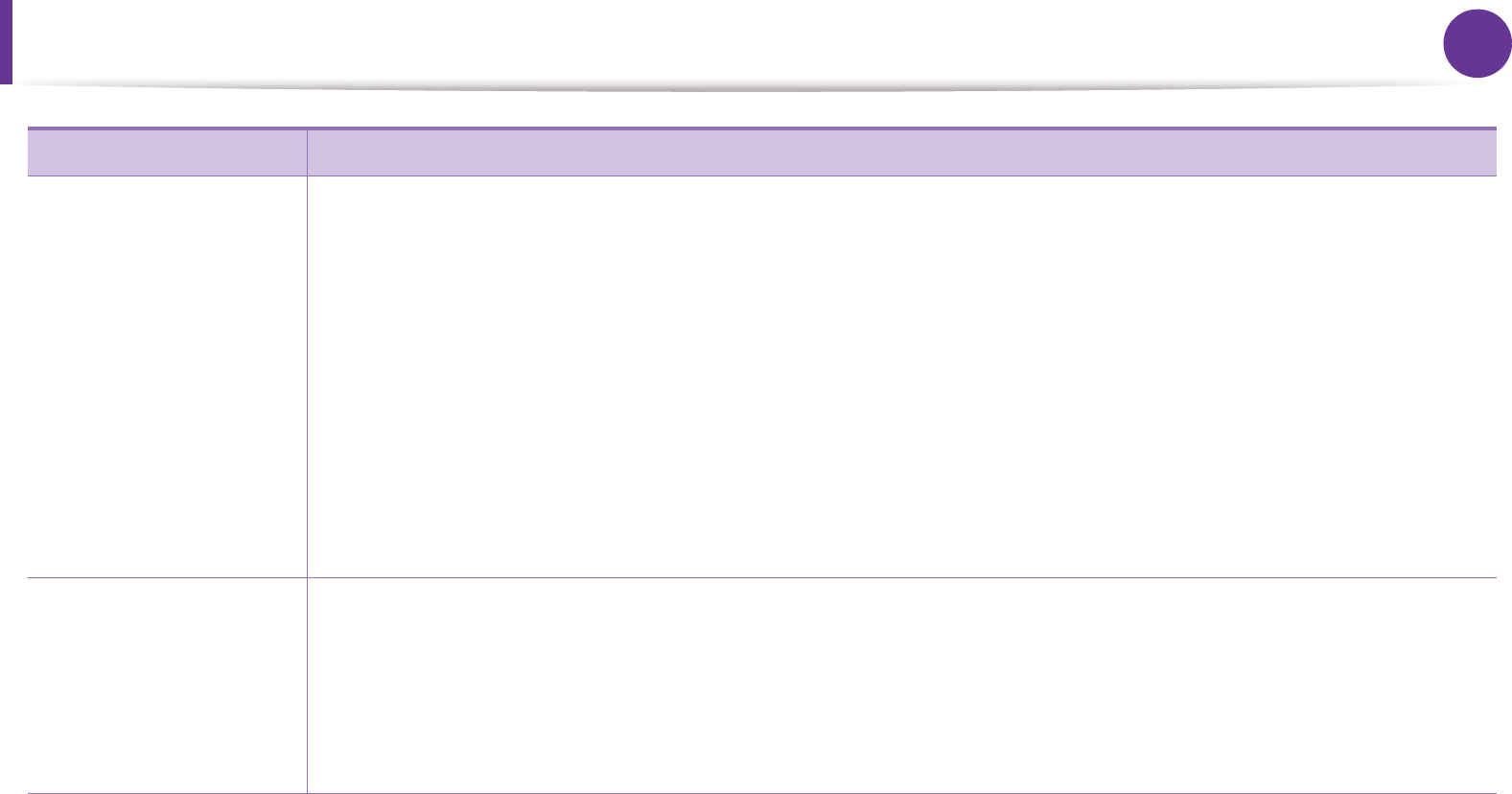
Printing features 101
4. Special features
Overlay
(Using a page overlay)
a Click the Advanced tab.
b Select the desired overlay from the Text drop-down list.
c If the overlay file you want does not appear in the Text drop-down list, select Edit... from the list and click Load.
Select the overlay file you want to use.
If you have stored the overlay file you want to use in an external source, you can also load the file when you access
the Open window.
After you select the file, click Open. The file appears in the Overlay List box and is available for printing. Select the
overlay from the Overlay List box.
d If necessary, check Confirm Page Overlay When Printing box. If this box is checked, a message window appears
each time you submit a document for printing, asking you to confirm printing an overlay on your document.
If this box is not checked and an overlay has been selected, the overlay automatically prints with your document.
e Click OK or Print until you exit the Print window.
Overlay
(Deleting a page
overlay)
a In the Printing Preferences window, click the Advanced tab.
b Select Edit in the Text drop down list.
c Select the overlay you want to delete from the Overlay List box.
d Click Delete.
e When a confirming message window appears, click Yes.
f Click OK or Print until you exit the Print window. You can delete page overlays that you no longer use.
Item Description
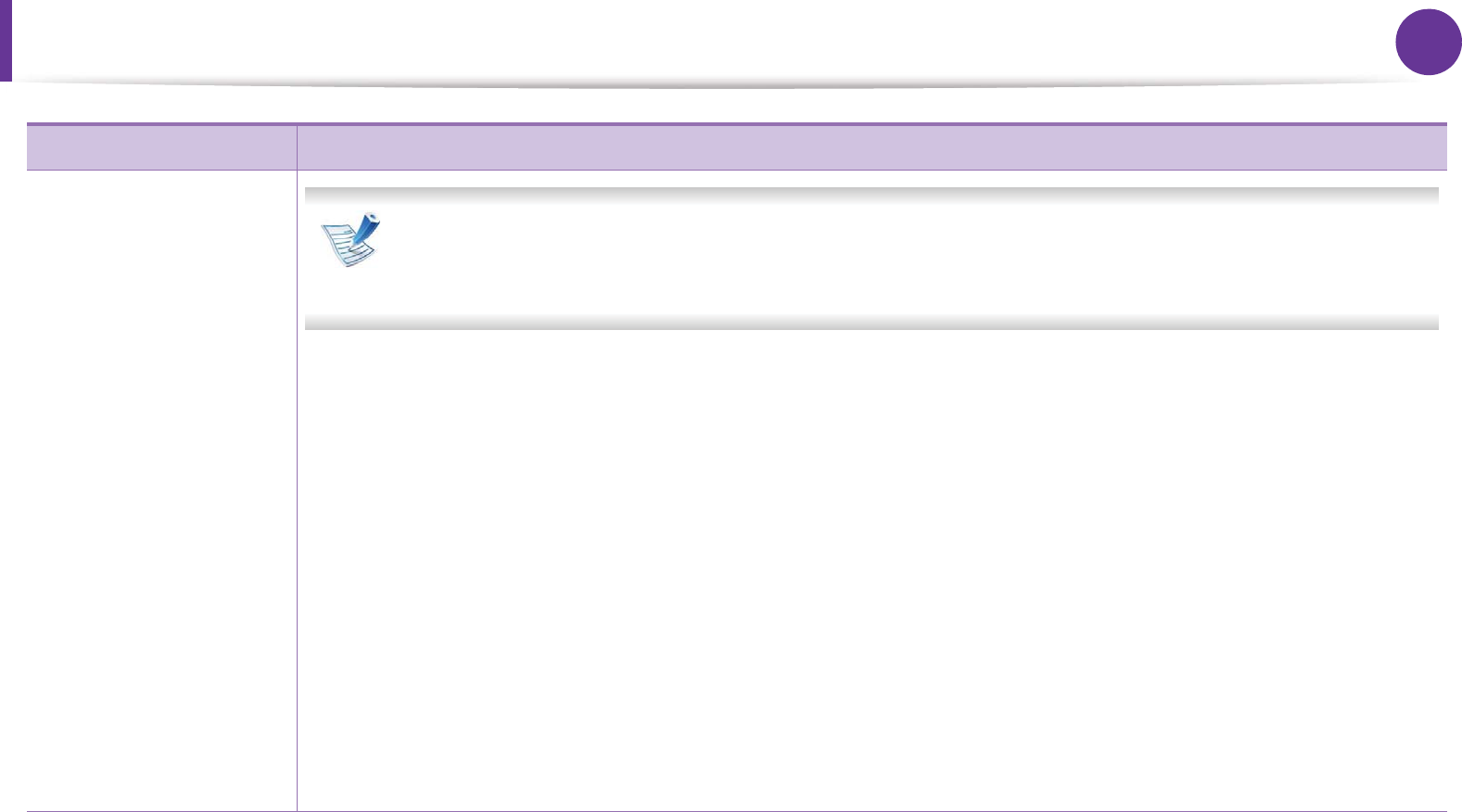
Printing features 102
4. Special features
Print Mode
• This feature is available only if you have installed the optional memory or hard disk, or set the RAM disk.
• Some menus may not appear on the display depending on options or models. If so, it is not applicable
to your machine.
•Print Mode: The default Print Mode is Normal, which is for printing without saving the printing file in the
memory.
-Normal: This mode prints without storing your document in the optional memory.
-Proof: This mode is useful when you print more than one copy. You can print one copy first to check, then print
the rest of the copies later.
-Confidential: This mode is used for printing confidential documents. You need to enter a password to print.
-Store: Select this setting to save a document in the hard disk without printing.
-Store and Print: This mode is used when printing and storing document at the same time.
-Spool: This option can be useful when handling large amounts of data. If you select this setting, the printer
spools the document into the hard disk and then prints it from the hard disk queue, decreasing the computer’s
work load.
-Print Schedule: Select this setting to print the document at a specified time.
•User ID: This option is used when you need to find a saved file using the control panel.
•Job Name: This option is used when you need to find a saved file using the control panel.
Item Description
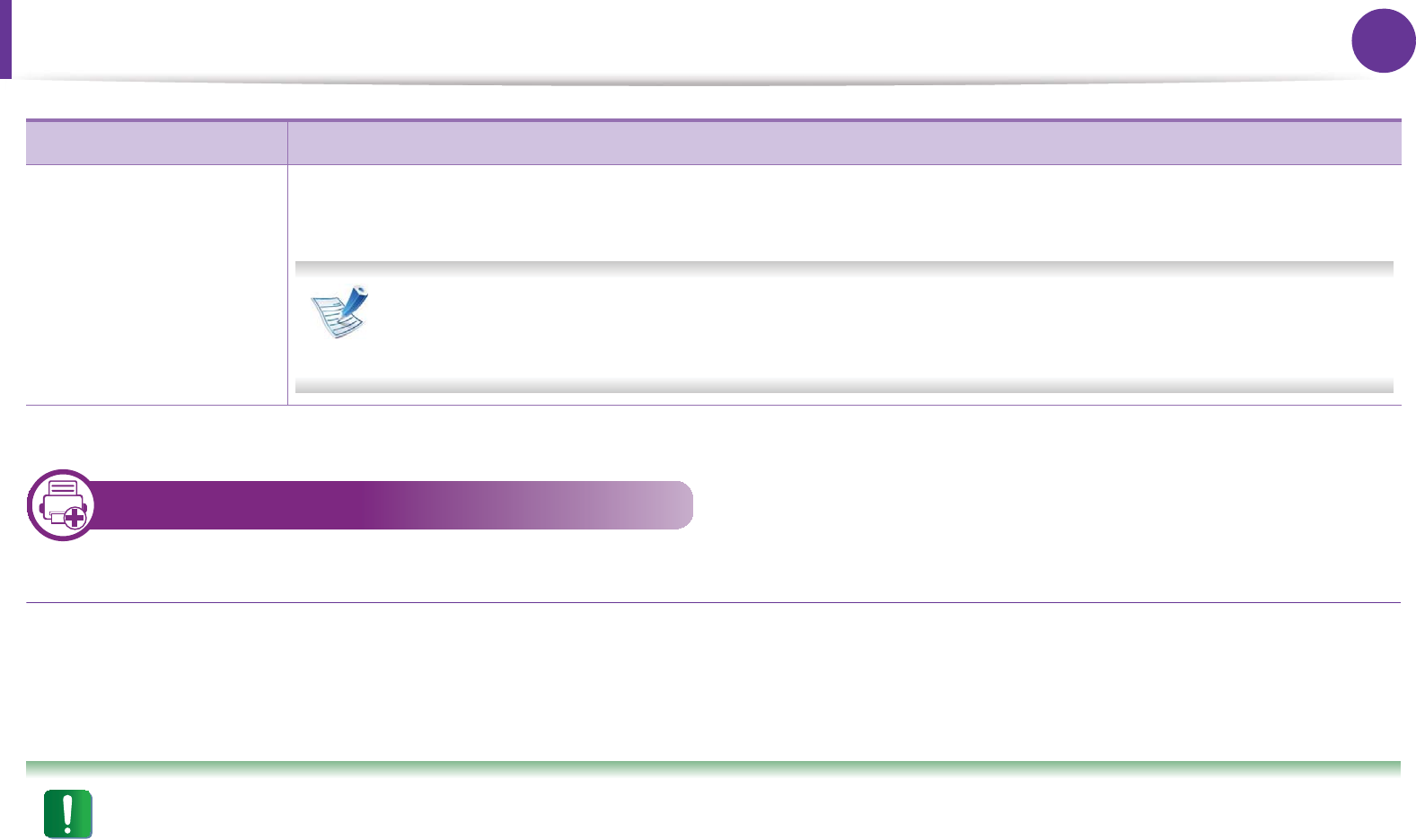
Printing features 103
4. Special features
13
Using Direct Printing Utility (Windows only)
What is Direct Printing Utility?
Direct Printing Utility is a program that sends the PDF files directly to your machine to print without having to opening the file.
To install this program, select Advanced Installation > Custom Installation and put a check mark in this program when you install the
printer driver.
• HDD should be installed on your machine, to print files using this program.
• You cannot print PDF files that are restricted. Deactivate the printing restriction feature and retry printing.
• You cannot print PDF files that are restricted by a password. Deactivate the password feature, and retry printing.
Job Encryption
Encrypts printing data first, and transmits it to the machine. This feature protects the printing information even
though the data is snatched on a network.
Job Encryption feature is enabled only when the hard drive is installed. The hard drive is used to decrypt
the printing data.
Item Description
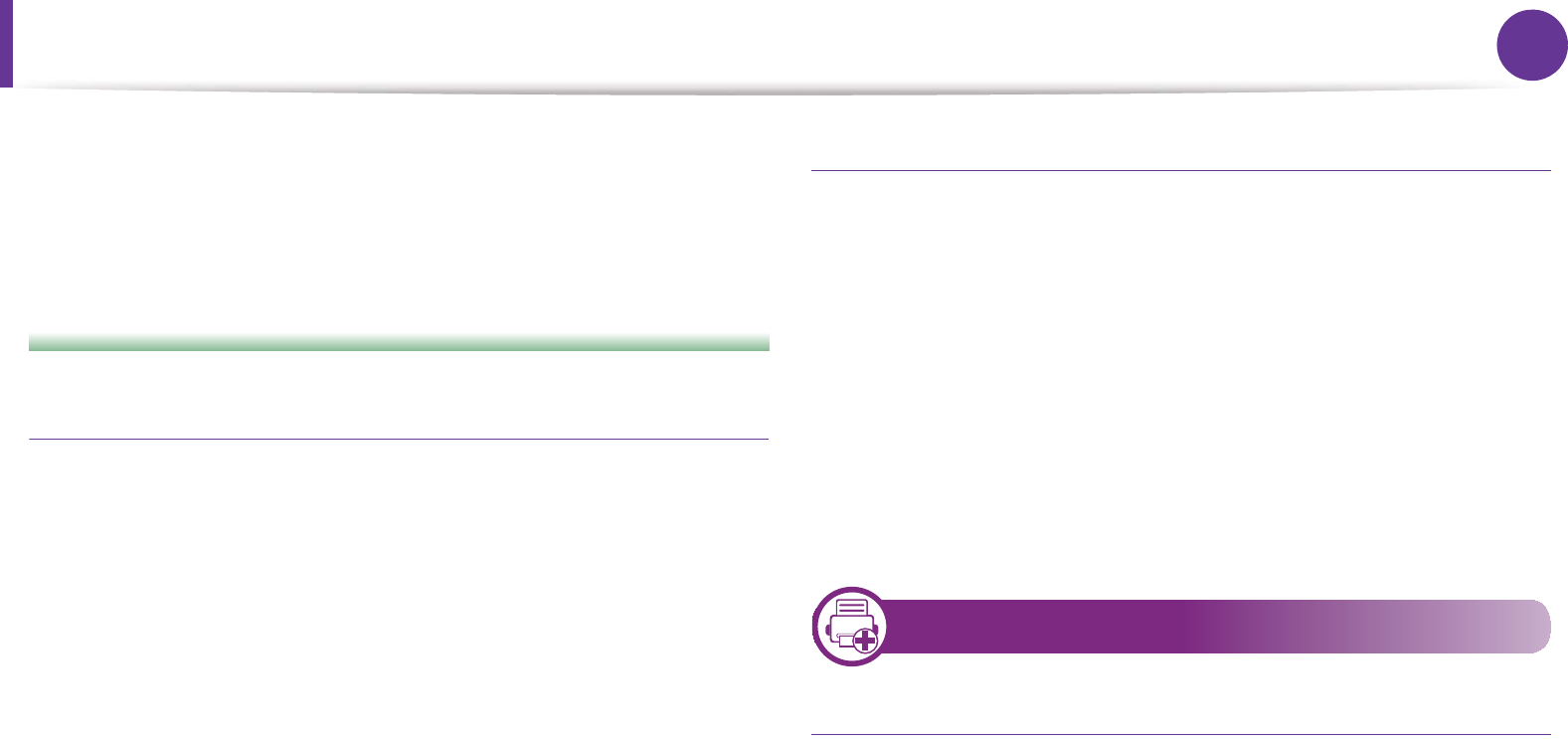
Printing features 104
4. Special features
• Whether or not a PDF file can be printed using the Direct
Printing Utility program depends on how the PDF file was
created.
• The Direct Printing Utility program supports PDF version
1.7 and below. For higher versions, you must open the file
to print it.
Printing
There are several ways you can print using the Direct Printing Utility.
1From the Start menu select Programs or All Programs >
Samsung Printers > Direct Printing Utility > Direct Printing
Utility.
The Direct Printing Utility window appears.
2 Select your machine from the Select Printer drop-down list
and click Browse.
3 Select the file you wish to print and click Open.
The file is added in the Select Files section.
4 Customize the machine settings for your needs.
5 Click Print. The selected PDF file is sent to the machine.
Using the right-click menu
1Right-click on the PDF file to print and select Direct Printing.
The Direct Printing Utility window appears with the PDF file is
added.
2 Select the machine to use.
3 Customize the machine settings.
4 Click Print. The selected PDF file is sent to the machine.
14
Macintosh printing
Printing a document
When you print with a Macintosh, you need to check the printer
driver settings in each application you use. Follow the steps below to
print from a Macintosh:
1Open the document to print.
2 Open the File menu and click Page Setup (Document Setup
in some applications).

Printing features 105
4. Special features
3 Choose your paper size, orientation, scaling, other options,
and make sure that your machine is selected. Click OK.
4 Open the File menu and click Print.
5 Choose the number of copies and indicate which pages to
print.
6 Click Print.
Changing printer settings
You can use advanced printing features when using your machine.
Open an application and select Print from the File menu. The
machine name, which appears in the printer properties window,
may differ depending on the machine in use. Except for the name,
the composition of the printer properties window is similar to the
following.
Printing multiple pages on one sheet
You can print more than one page on a single sheet of paper. This
feature provides a cost-effective way to print draft copies.
1Open an application, and select Print from the File menu.
2 Select Layout from the drop-down list under Orientation. In
the Pages per Sheet drop-down list, select the number of
pages you want to print on one sheet of paper.
3 Select the other options to use.
4 Click Print.
The machine prints the selected number of pages to print on
one sheet of paper.
Printing on both sides of the paper
Before printing in the duplex mode, decide on which edge you will
be binding your finished document. The binding options are, as
follows:
•Long-Edge Binding: This option is the conventional layout used
in book binding.
•Short-Edge Binding: This option is the type often used with
calendars.
1From your Macintosh application, select Print from the File
menu.
2 Select Layout from the drop-down list under Orientation.
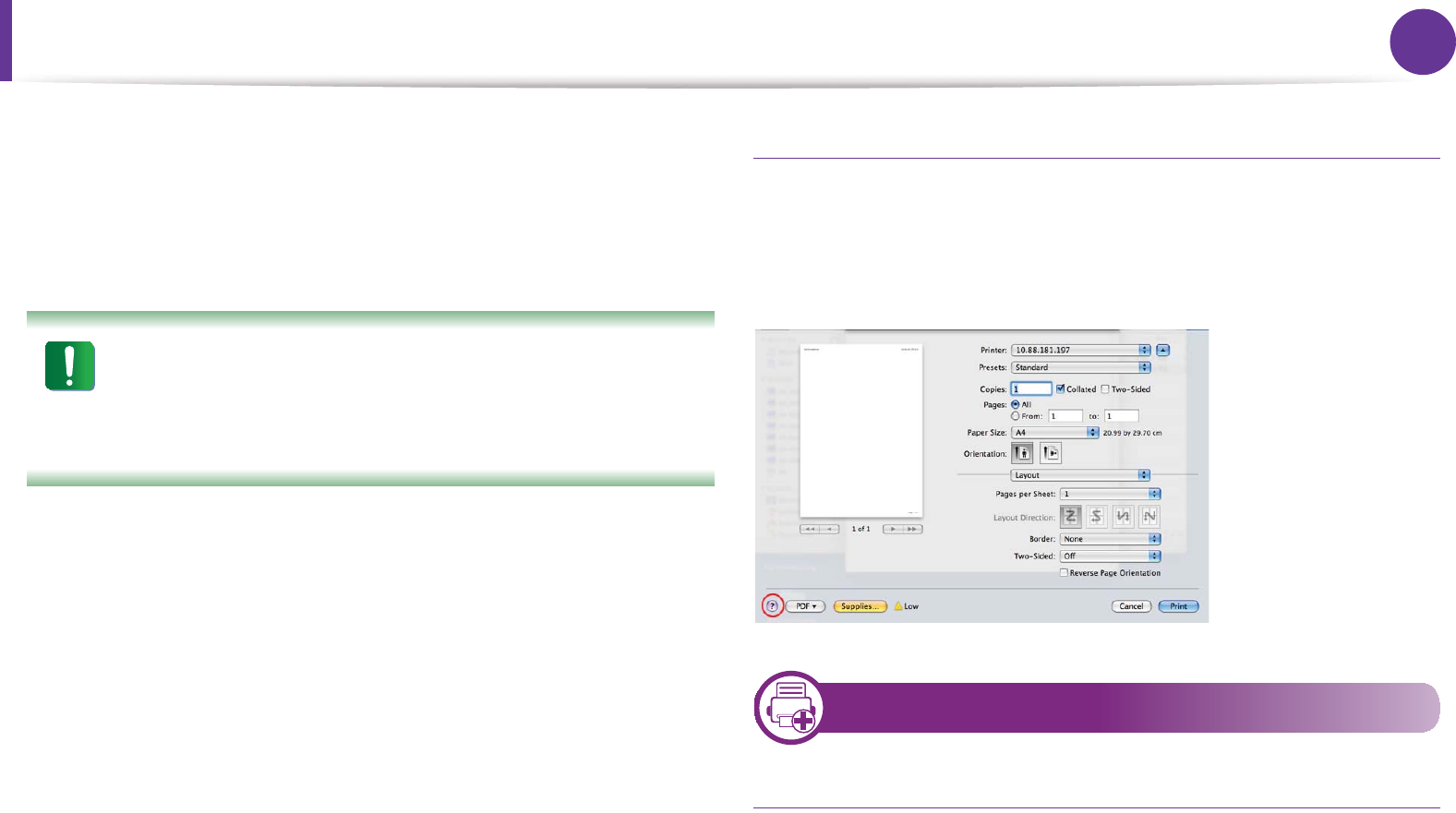
Printing features 106
4. Special features
3 Select a binding orientation from the Two-Sided option.
4 Select the other options to use.
5 Click Print and the machine prints on both sides of the paper.
If you print more than 2 copies, the first copy and the second
copy might print on the same sheet of paper. Avoid printing
on both sides of paper when you are printing more than 1
copy.
Using help
Click the question mark on the bottom-left corner of the window and
click on the topic you want to know about. A pop-up window
appears with information about that option's feature, which is
provided from the driver.
15
Linux printing
Printing from applications
There are a lot of Linux applications that allow you to print using
Common UNIX Printing System (CUPS). You can print on your
machine from any such application.

Printing features 107
4. Special features
1Open an application, and select Print from the File menu
2 Select Print directly using lpr.
3 In the LPR GUI window, select the model name of your
machine from the printer list and click Properties.
4 Change the print job properties using the following four tabs
displayed at the top of the window.
•General: Changes the paper size, the paper type, and the
orientation of the documents. It enables the duplex
feature(if your machine supports it), adds start and end
banners, and changes the number of pages per sheet.
•Text: Specifies the page margins and set the text options,
such as spacing or columns.
•Graphics: Sets image options that are used when printing
image files, such as color options, image size, or image
position.
•Advanced: Sets the print resolution, paper source, and
destination.
5 Click Apply to apply the changes and close the Properties
window.
6 Click OK in the LPR GUI window to start printing.
7 The Printing window appears, allowing you to monitor the
status of your print job.
To abort the current job, click Cancel.
Printing files
You can print many different types of files on your machine using the
standard CUPS, directly from the command line interface. The CUPS
lpr utility allows you to do that, but the driver’s package replaces the
standard lpr tool by a much more user-friendly LPR GUI program.
To print any document file:
1Enter lpr <file_name> from the Linux shell command line and
press Enter. The LPR GUI window appears.
When you type only lpr and press Enter, the Select file(s) to
print window appears first. Just select any files you want to
print and click Open.
2 In the LPR GUI window, select your machine from the list, and
change the print job properties.
3 Click OK to start printing.
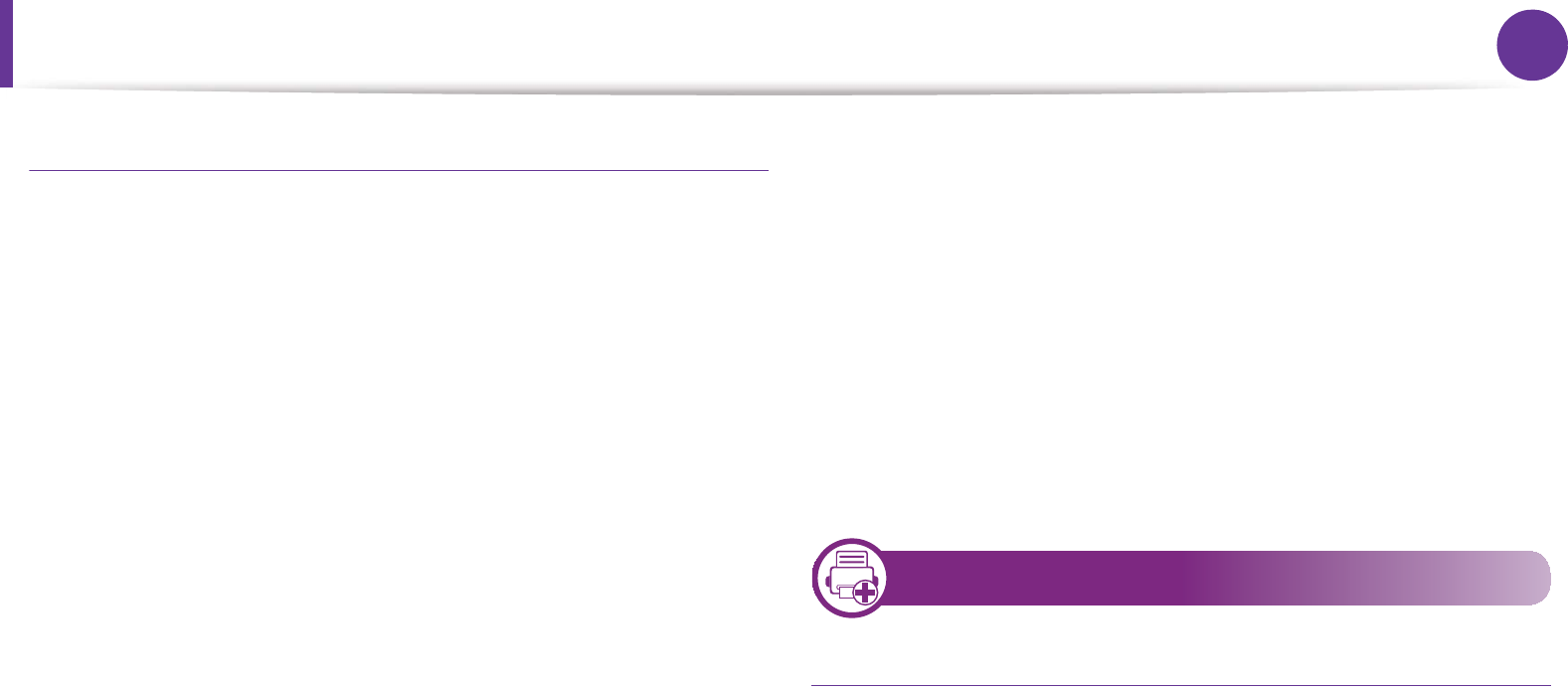
Printing features 108
4. Special features
Configuring Printer Properties
Using the Printer Properties window provided by the Printers
configuration, you can change the various properties for your
machine as a printer.
1Open the Unified Driver Configurator.
If necessary, switch to Printers configuration.
2 Select your machine on the available printers list and click
Properties.
3 The Printer Properties window appears.
The following five tabs display at the top of the window:
•General: Allows you to change the printer location and
name. The name entered in this tab displays on the printer
list in Printers configuration.
•Connection: Allows you to view or select another port. If
you change the machine port from USB to parallel or vice
versa while in use, you must re-configure the machine port
in this tab.
•Driver: Allows you to view or select another machine
driver. By clicking Options, you can set the default device
options.
•Jobs: Shows the list of print jobs. Click Cancel job to cancel
the selected job and select the Show completed jobs
check box to see previous jobs on the job list.
•Classes: Shows the class that your machine is in. Click Add
to Class to add your machine to a specific class or click
Remove from Class to remove the machine from the
selected class.
4 Click OK to apply the changes and close the Printer
Properties window.
16
Unix printing
Proceeding the print job
After installing the printer, choose any of the image, text, PS or HPGL
files to print.
1Execute “printui <file_name_to_print>” command.
For example, if you are printing “document1”
printui document1
This will open the UNIX Printer Driver Print Job Manager in
which the user can select various print options.
2 Select a printer that has been already added.
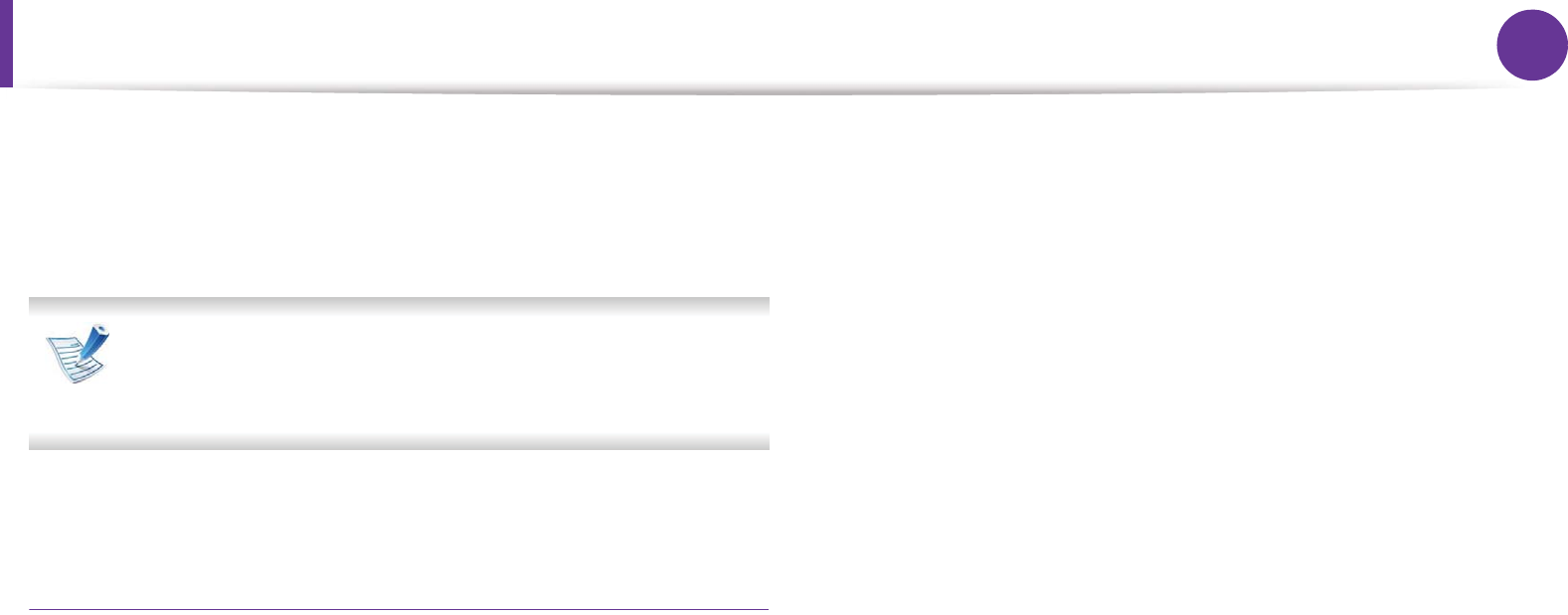
Printing features 109
4. Special features
3 Select the printing options from the window such as Page
Selection.
4 Select how many copies are needed in Number of Copies.
To take advantage of the printer features provided by your
printer driver, press Properties (see "Changing printer
settings" on page 105).
5 Press OK to start the print job.
Changing the machine settings
The UNIX printer driver Print Job Manager in which the user can
select various print options in printer Properties.
The following hot keys may also be used: “H” for Help, “O” for OK, “A”
for Apply, and “C” for Cancel.
ŹGeneral tab
•Paper Size: Set the paper size as A4, Letter, or other paper sizes,
according to your requirements.
•Paper Type: Choose the type of the paper. Options available in
the list box are Printer Default, Plain, and Thick.
•Paper Source: Select from which tray the paper is used. By
default, it is Auto Selection.
•Orientation: Select the direction in which information is printed
on a page.
•Duplex: Print on both sides of paper to save paper.
•Multiple pages: Print several pages on one side of the paper.
•Page Border: Choose any of the border styles (e.g., Single-line
hairline, Double-line hairline)
ŹImage tab
In this tab, you can change the brightness, resolution, or image
position of your document.
ŹText tab
Set the character margin, line space, or the columns of the actual
print output.
ŹHPGL/2 tab
•Use only black pen: To print all graphics in black.
•Fit plot to page: Fit the entire graphic into a single page.

Printing features 110
4. Special features
ŹMargins tab
•Use Margins: Set the margins for the document. By default,
margins are not enabled. The user can change the margin
settings by changing the values in the respective fields. Set by
default, these values depend on the page size selected.
•Unit: Change the units to points, inches, or centimeters.
ŹPrinter-Specific Settings tab
Select various options in the JCL and General frames to customize
various settings. These options are specific to the printer and depend
on the PPD file.

111
4. Special features
Fax features
17
Automatic redialing
When the number you have dialed is busy or there is no answer
when you send a fax, the machine automatically redials the number.
The redial time depends on the country's factory default setting. To
change the time interval between redials and the number of redial
attempts.
When the display shows Retry Redial?, press Start button to redial
the number without waiting. To cancel the automatic redialing,
press (Cancel or Stop/Clear).
18
Redialing the last number
1Press Redial/Pause on the control panel.
2 When an original is loaded in the document feeder, the
machine automatically begins to send.
If an original is placed on the scanner glass, select Yes to add
another page. Load another original and press OK. When you
have finished, select No when Another Page? appears.
19
Receiving manually in Tel mode
You can receive a fax call by pressing On Hook Dial and then
pressing Start when you hear a fax tone.
20
Receiving in Answering Machine/Fax mode
To use this mode, you must attach an answering machine to the EXT
socket on the back of your machine. If the caller leaves a message,
the answering machine stores the message. If your machine detects
a fax tone on the line, it automatically starts to receive the fax.
• If you have set your machine to this mode and your
answering machine is switched off, or no answering
machine is connected to EXT socket, your machine
automatically goes into Fax mode after a predefined
number of rings.
• If the answering machine has a user-selectable ring
counter, set the machine to answer incoming calls within
1 ring.
• If the machine is in Tel mode, disconnect or switch off the
answering machine with the fax machine. Otherwise, the
outgoing message from the answering machine will
interrupt your phone conversation.
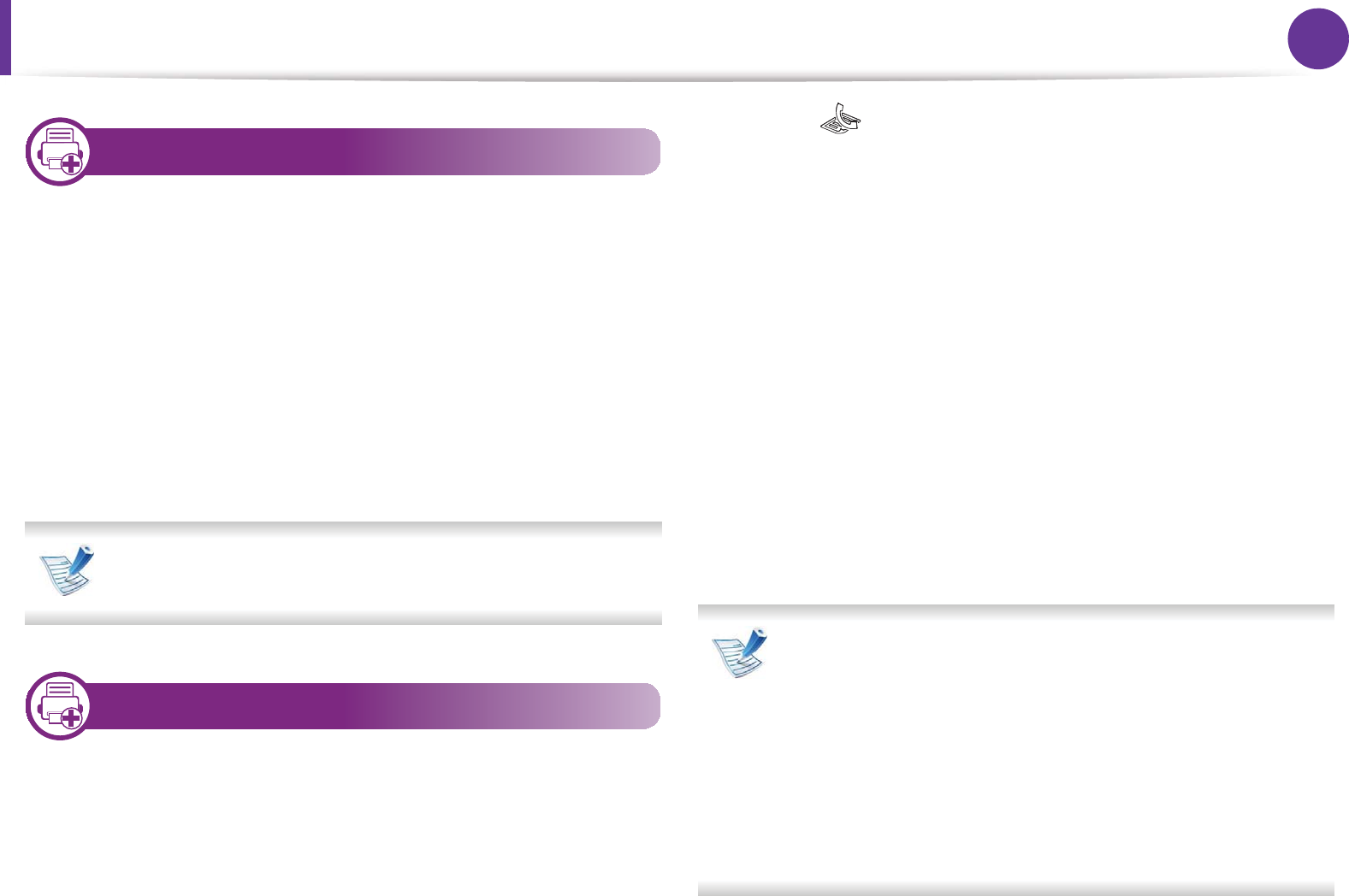
Fax features 112
4. Special features
21
Receiving faxes with an extension telephone
When you are using an extension telephone connected to the EXT
socket, you can receive a fax from someone you are talking to on the
extension telephone, without going to the fax machine.
When you receive a call on the extension phone and hear fax tones,
press the keys *9* on the extension phone. The machine receives the
fax.
*9* is the remote receive code preset at the factory. The first and the
last asterisks are fixed, but you can change the middle number to
whatever you want.
While you are talking over the telephone connected to the
EXT socket, copy and scan features are not available.
22
Receiving faxes using DRPD mode
Distinctive Ring is a telephone company service which enables an
user to use a single telephone line to answer several different
telephone numbers. This feature is often used by answering services
who answer telephones for many different clients and need to know
which number someone is calling in on to properly answer the
phone.
1Select (Fax) > Menu > Fax Setup > Receiving > DRPD
Mode > Waiting Ring on the control panel.
Or select Setup > Machine Setup > Next > Default Setting >
Fax Default > Common > Receive Mode > DRPD on the
touch screen.
2 Call your fax number from another telephone.
3 When your machine begins to ring, do not answer the call. The
machine requires several rings to learn the pattern.
When the machine completes learning, the display shows
Completed DRPD Setup. If the DRPD setup fails, Error DRPD
Ring appears.
4 Press OK when DRPD appears and start over from step 2.
• DRPD must be set up again if you re-assign your fax
number, or connect the machine to another telephone
line.
• After DRPD has been set up, call your fax number again to
verify that the machine answers with a fax tone. Then have
a call placed to a different number assigned to that same
line to be sure the call is forwarded to the extension
telephone or answering machine plugged into the EXT
socket.
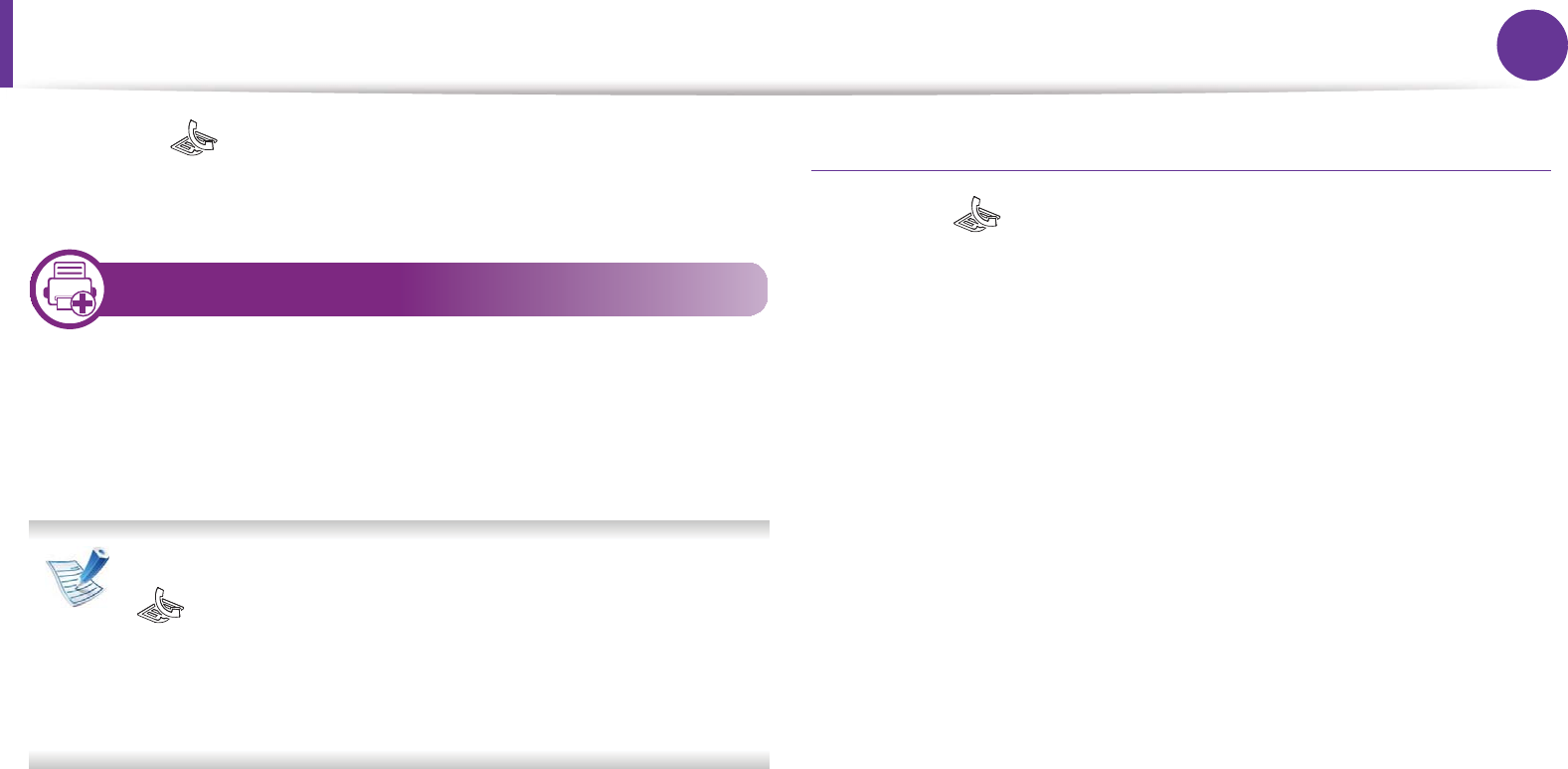
Fax features 113
4. Special features
5 Select (Fax) > Menu > Fax Setup > Receiving > Receive
Mode > DRM mode on the control panel.
23
Receiving in secure receiving mode
You may need to prevent your received faxes from being accessed
by unauthorized people. Turn on secure receiving mode, then all
incoming faxes go into memory. You can print the incoming faxes
with entering the password.
To use the secure receiving mode, activate the menu from
(Fax) > Menu > Fax Feature > Secure Receive on the
control panel.
Or select Setup > Machine Setup > Next > Fax Setup >
Secure Receive on the touch screen.
Printing received faxes
1Select (Fax) > Menu > Fax Feature > Secure Receive >
Print on the control panel.
Or select Setup > Machine Setup > Next > Fax Setup >
Secure Receive > Print on the touch screen.
2 Enter a four-digit password and press OK.
3 The machine prints all of the faxes stored in memory.
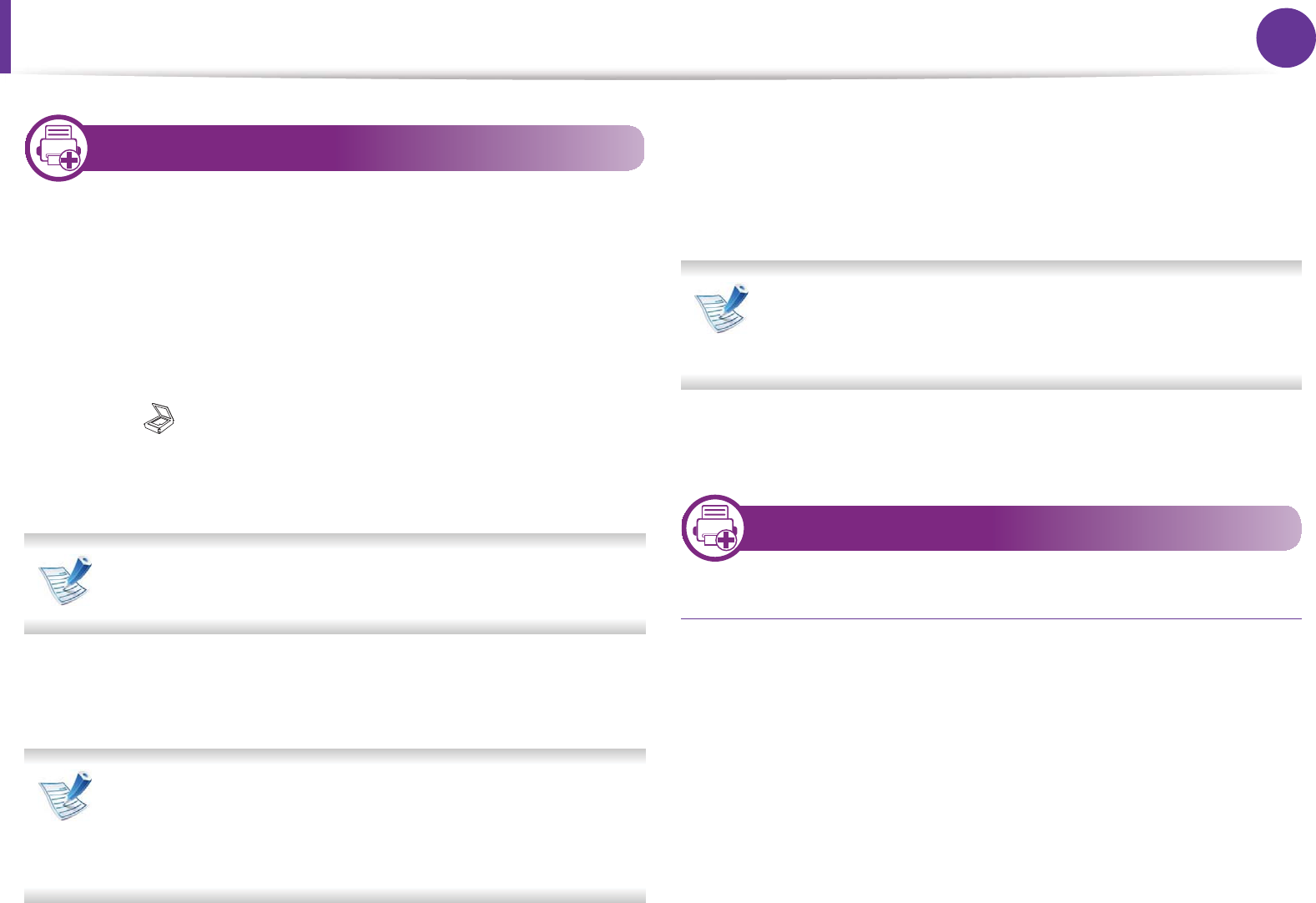
114
4. Special features
Scan features
24
Scanning from network connected machine
Make sure the printer driver is installed on your computer using the
software CD, since the printer driver includes the scan program (see
Basic Guide).
1Place a single document face down on the document glass, or
load the documents face up into the ADF.
2 Select (Scan) > Scan to PC > Network PC on the control
panel.
Or select Scan > Network PC on the touch screen.
If you see Not Available message, check the port
connection.
3 Select your registered computer ID, and enter the Password if
necessary.
•ID is the same ID as the registered Computer ID for
Samsung Easy Printer Manager.
•Password is the 4 digit number registered Password for
Samsung Easy Printer Manager.
4 Select the application program you want and press OK.
Default setting is My Documents.
5 Select the option you want and press OK.
•Scan Format appears only when you selected the Scan
destination to My Documents.
• If you want to scan from the default setting, press Start.
6 Scanning begins.
25
Scanning to email
Setting up an email account
1Access the SyncThru™ Web Service (see "Using SyncThru™
Web Service" on page 130).
2 Select Settings > Network Settings and Outgoing Mail
Server(SMTP).
3 Enter the IP address in dotted decimal notation or as a host
name.
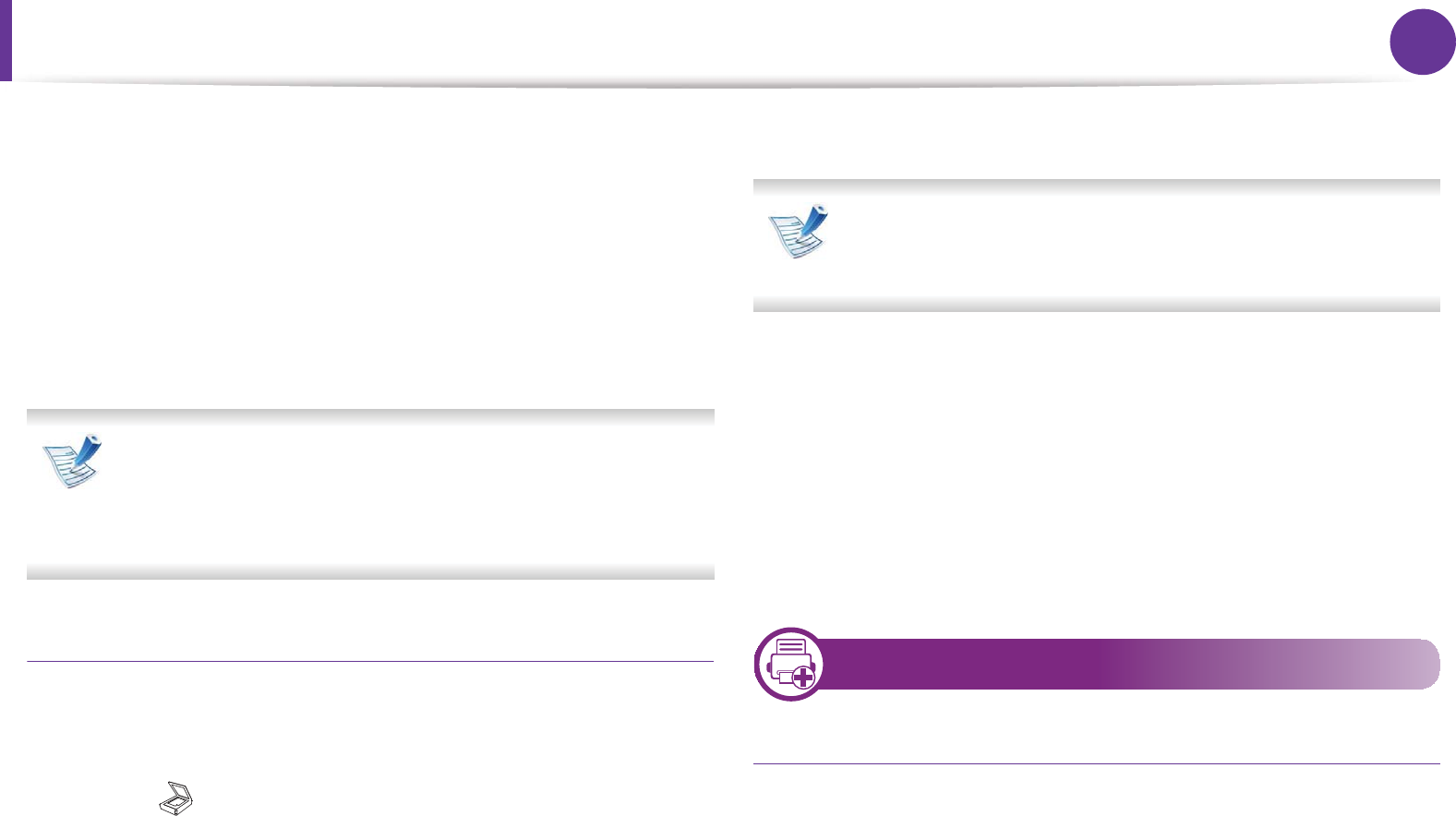
Scan features 115
4. Special features
4 Enter the server port number, from 1 to 65535.
5 Check the box next to SMTP Requires Authentication to
require authentication.
6 Enter the SMTP server login name and password.
7 Press Apply.
• If the authentication method of SMTP server is POP3
before SMTP, put a check mark of SMTP Requires POP
Before SMTP Authentication.
• Enter the IP address and port number.
Scanning and sending an email
1Place a single document face down on the document glass, or
load the documents face up into the ADF.
2 Select (Scan) > Scan to Email on the control panel.
Or select Scan > Send Email on the touch screen.
3 Enter the login name and password if you configured on
SyncThru™ Web Service.
4 Enter the sender’s and recipient’s email address.
• You can send an email to yourself by activating the Auto
Send To Self option in the Settings > Scan > Scan To E-
mail on SyncThru™ Web Service.
5 Enter an email subject and press OK.
6 Select the file format to scan, and press OK.
7 Enter the SMTP server login name and password.
8 The machine begins scanning and then sends the email.
26
Scanning to FTP/SMB server
Setting up an FTP/SMB server
1Access the SyncThru™ Web Service (see "Using SyncThru™
Web Service" on page 130).
2 Select Address Book > Individual > Add.
3 Check the box next to Add FTP or Add SMB.
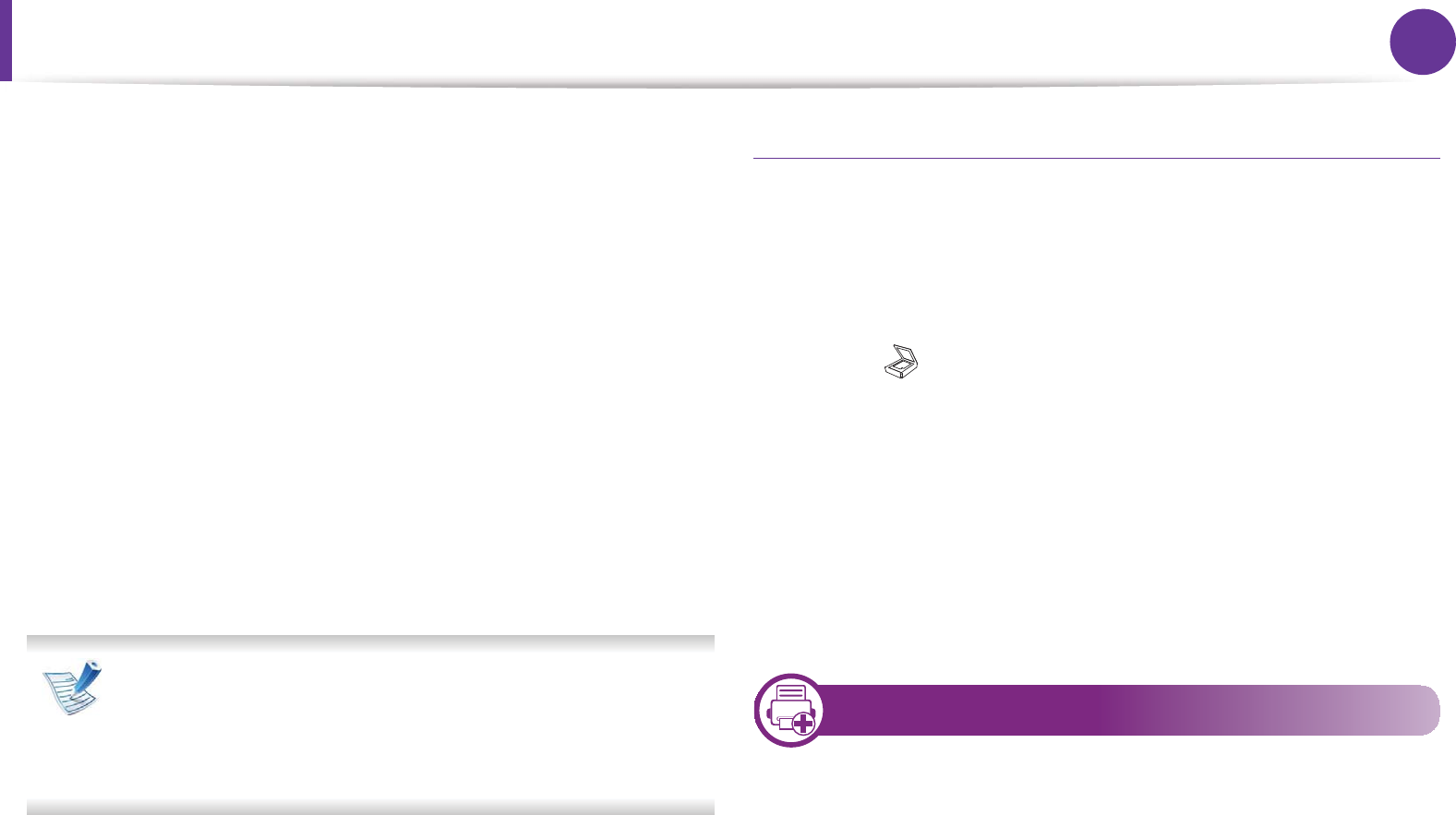
Scan features 116
4. Special features
4 Enter the IP address in dotted decimal notation or as a host
name.
5 Enter the server port number, from 1 to 65535.
6 Check the box next to Anonymous, then the server permits
the access of unauthorized people.
7 Enter the login name and password.
8 Enter the domain name if your server is joined to the certain
domain, otherwise just enter your computer name which is
registered to the SMB server.
9 Enter the path for saving the scanned image.
• The folder to save the scanned image must be on the root.
• The folder properties need to be setup as a share.
• Your user name should have the rights to read and write
the folder.
10 Press Apply.
Scanning and sending to FTP/SMB server
1Make sure that your machine is connected to a network.
2 Place a single document face down on the document glass, or
load the documents face up into the ADF.
3 Select (Scan) > Scan to SMB or Scan to FTP on the control
panel.
Or select Scan > SMB or FTP on the touch screen.
4 Select a server and scan format you want.
5 The machine begins scanning and then sends the scanned
image to the specified server.
27
Scanning from image editing program
You also can scan and import documents at the image editing
software such as Adobe Photoshop, if the software is TWAIN-
compliant. Follow the steps below to scan with TWAIN-compliant
software:
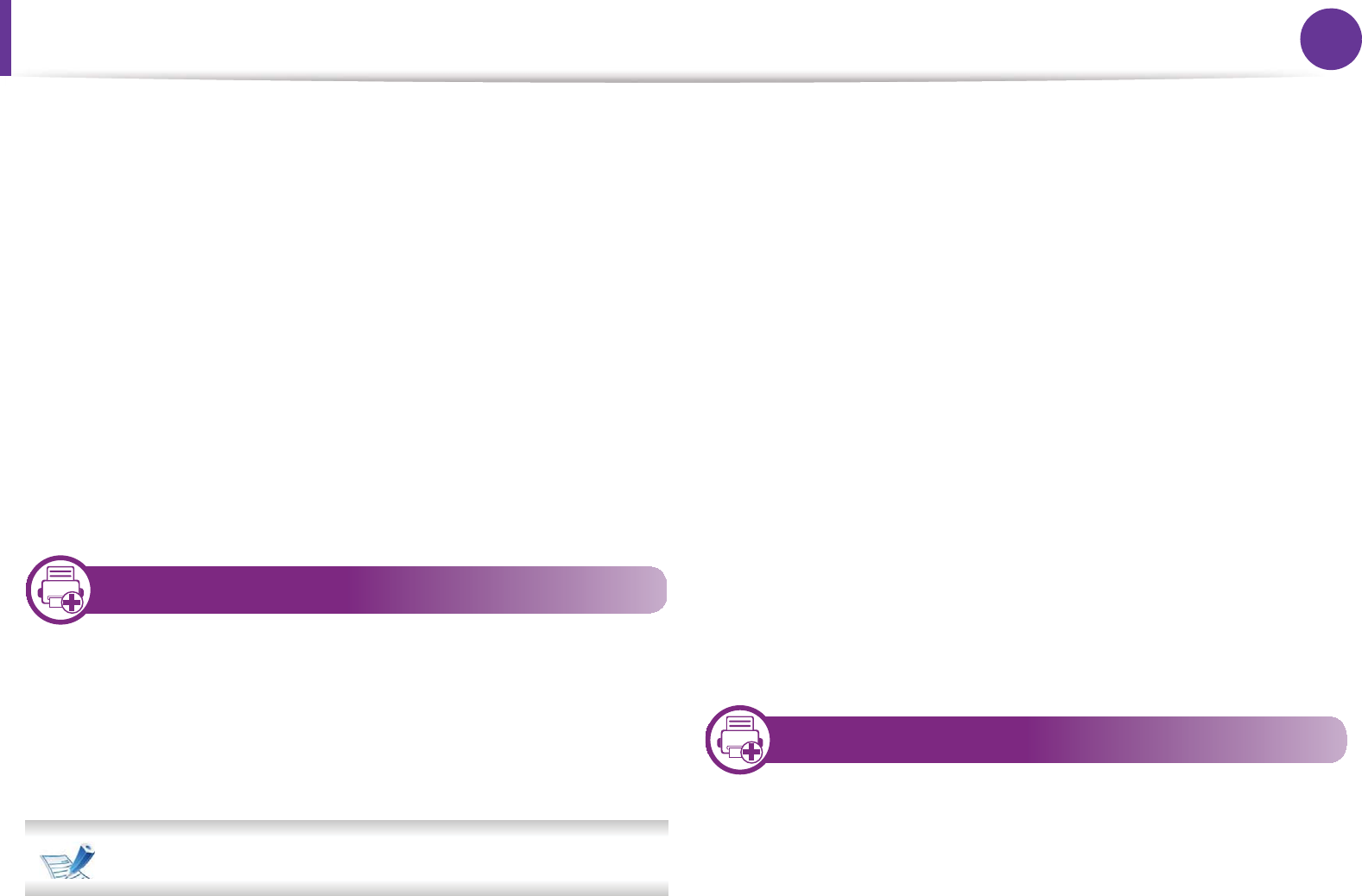
Scan features 117
4. Special features
1Make sure that the machine is connected to your computer
and powered on.
2 Place a single document face down on the document glass, or
load the documents face up into the ADF.
3 Open an application, such as Adobe Photoshop.
4 Click File > Import, and select the scanner device.
5 Set the scan options.
6 Scan and save your scanned image.
28
Scanning using the WIA driver
Your machine also supports the Windows Image Acquisition (WIA)
driver for scanning images. WIA is one of the standard components
provided by Microsoft Windows 7 and works with digital cameras
and scanners. Unlike the TWAIN driver, the WIA driver allows you to
scan and easily adjust images without using additional software:
The WIA driver works only on Windows OS with a USB port.
1Make sure that the machine is connected to your computer
and powered on.
2 Place a single document face down on the document glass, or
load the documents face up into the ADF.
3 Click Start > Control Panel > Hardware and Sound >
Devices and Printers.
4 Right-click on device driver icon in Printers and Faxes > Start
Scan.
5 New Scan application appears.
6 Choose your scanning preferences and click Preview to see
your preferences affect the picture.
7 Scan and save your scanned image.
29
Scanning with Samsung Scan Assistant
1Make sure that the machine is connected to your computer
and powered on.
2 Place a single document face down on the document glass, or
load the documents face up into the ADF.

Scan features 118
4. Special features
3 Click Start > All programs > Samsung Printers, and start
Samsung Scan Assistant.
Click the Help ( ) button from the upper-right corner of the
window and click on any option you want to know about.
4 Set the scan options.
5 Click Scan.
30
Scanning with SmarThru 4
1Make sure that the machine is connected to your computer
and powered on.
2 Place a single document face down on the document glass, or
load the documents face up into the ADF.
3 Double-click the SmarThru 4 icon.
4 The SmarThru appears.
•Scan to: You can scan an image and save it to an
application or folder, email it, or publish it on a web site.
•Image: You can edit an image and send it to a selected
application or folder, email it, or publish it on a web site.
•Print: You can print images you have saved.
Click the Help button from the upper-right corner of the
window and click on any option you want to know about.
5 Click Scan to.
6 Select destination among Application, E-mail, Folder, OCR,
or Web.
7 If needed, click Settings to customize the settings.
8 Click Scan.
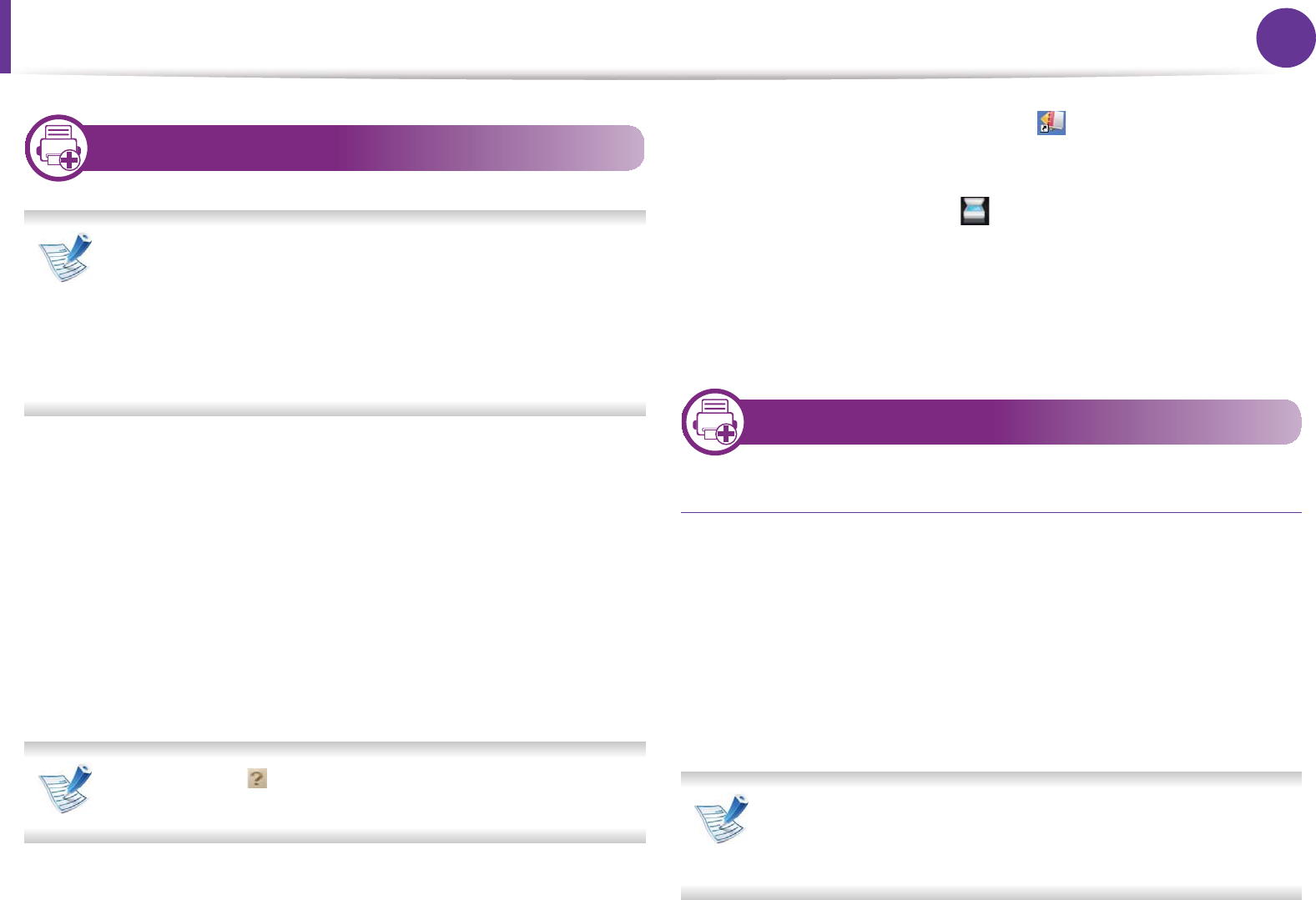
Scan features 119
4. Special features
31
Scanning with SmarThru Office
•To use SmarThru Office, you have to install the program
manually from the supplied CD. Select Advanced
Installation > Custom Installation and choose SmarThru
Office to install.
• You can use the OCR (Optical Character Reader) feature
from SmarThru Office program.
1Make sure that the machine is connected to your computer
and powered on.
2 Place a single document face down on the document glass, or
load the documents face up into the ADF.
3 Double-click the SmarThru Office icon.
4 The SmarThru Office appears.
Click the Help ( ) button from the upper-right corner of the
window and click on any option you want to know about.
5 Click the SmarThru Office icon ( ) in the tray area of the
Windows taskbar to activate the SmarThru Office launcher.
6 Click the scanning icon ( ) to open the scanning window.
7 The Scan Setting window opens.
8 Set scan settings and click Scan.
32
Macintosh scanning
Scanning from USB connected machine
1Make sure that the machine is connected to your computer
and powered on.
2 Place a single document face down on the document glass, or
load the documents face up into the ADF.
3 Start Applications and click Image Capture.
If No Image Capture device connected message appears,
disconnect the USB cable and reconnect it. If the problem
continues, refer to the Image Capture’s help.
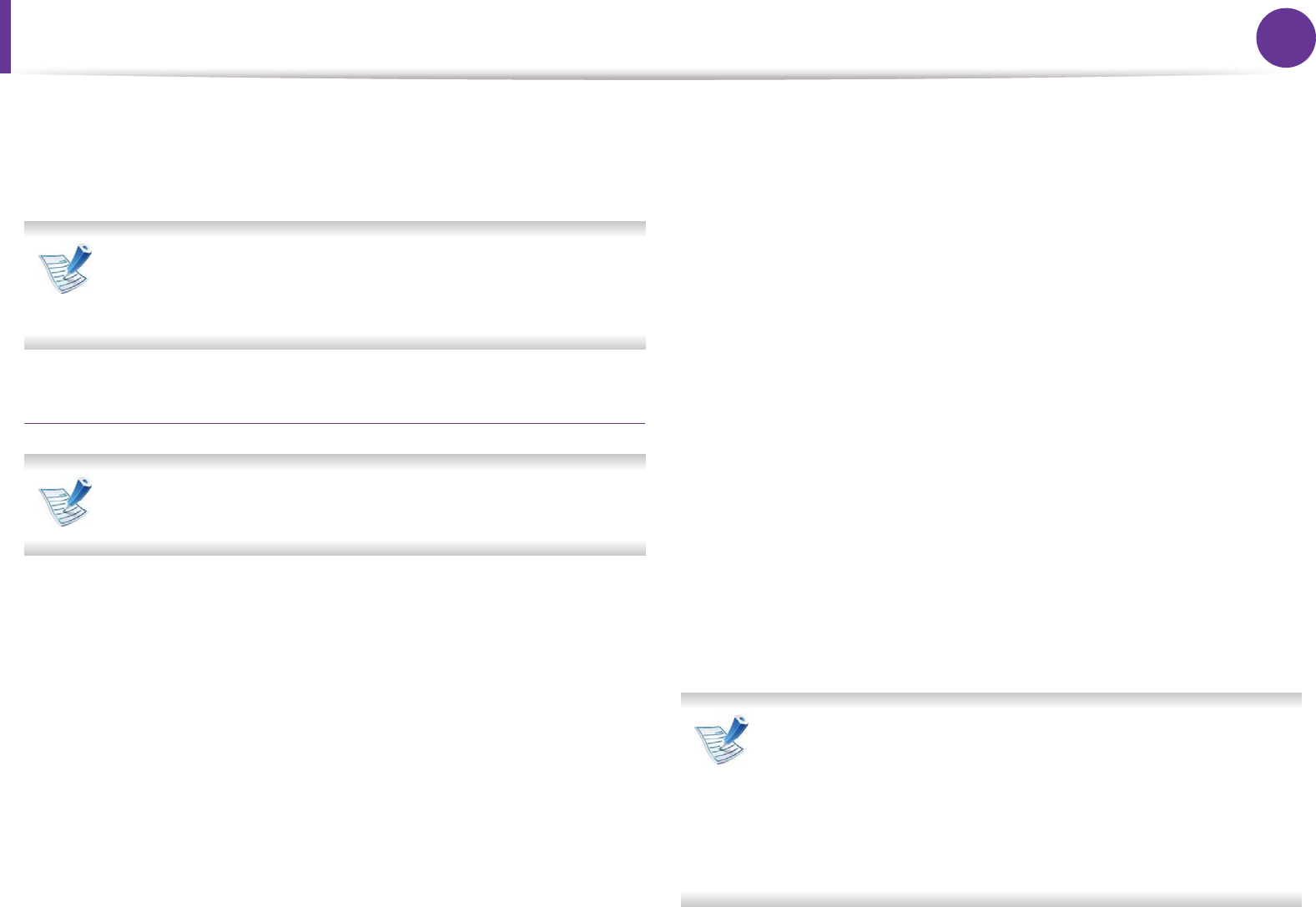
Scan features 120
4. Special features
4 Select the option you want.
5 Scan and save your scanned image.
If scanning does not operate in Image Capture, update Mac
OS to the latest version. Image Capture operates properly in
Mac OS X 10.4.7 or higher.
Scanning from network connected machine
The procedures in this user’s guide are mainly based on Mac
OS X 10.6.
1Make sure that your machine is connected to a network.
2 Place a single document face down on the document glass, or
load the documents face up into the ADF.
3 Start Applications and click Image Capture.
4 According to OS, follow steps below.
•For 10.4
-Click Devices > Browse Devices on Menu bar.
- Select your machine in Twain devices option. Make
sure that Use TWAIN software checkbox is checked.
- Click Connect.
If a warning message appears, click Change Port.. to
select port, or If TWAIN UI appears, click Change Port..
from the Preference tab and select a new port.
• For 10.5
- Click Devices > Browse Devices on Menu bar.
- Make sure that Connected checkbox is checked beside
your machine in Bonjour Devices.
- If you want to scan using TWAIN, refer to the Mac OS
X10.4 steps above.
• For 10.6, select your device below SHARED.
5 Set the scan options on this program.
6 Scan and save your scanned image.
• If scanning does not operate in Image Capture, update
Mac OS to the latest version. Image Capture operates
properly Mac OS X 10.4.7 or higher.
• For more information, refer to the Image Capture’s help.
• You can also scan using TWAIN-compliant software, such
as Adobe Photoshop.
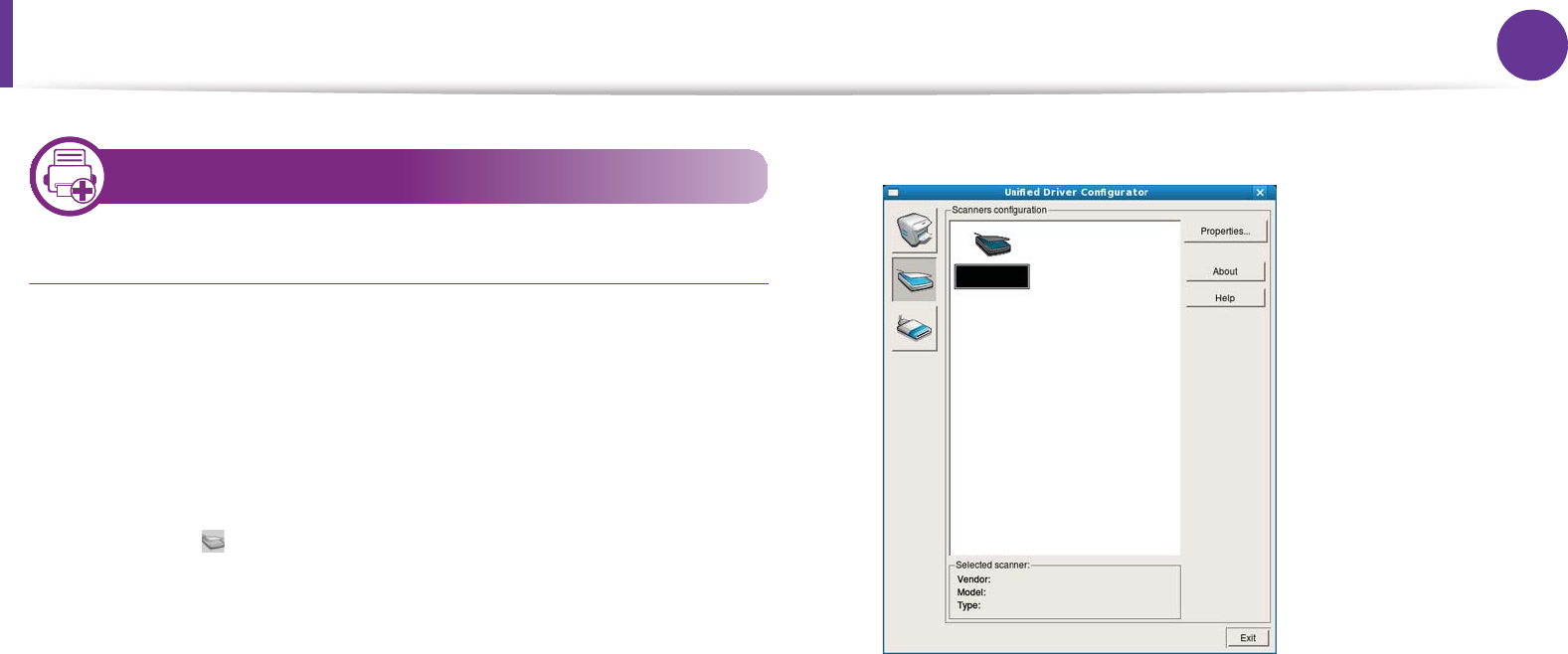
Scan features 121
4. Special features
33
Linux scanning
Scanning
1Make sure that the machine is connected to your computer
and powered on.
2 Double-click the Unified Driver Configurator on your
desktop.
3 Click the button to switch to Scanners Configuration.
4 Select the scanner on the list.
5 Click Properties.
6 Place a single document face down on the document glass, or
load the documents face up into the ADF.
7 From the Scanner Properties window, click Preview.
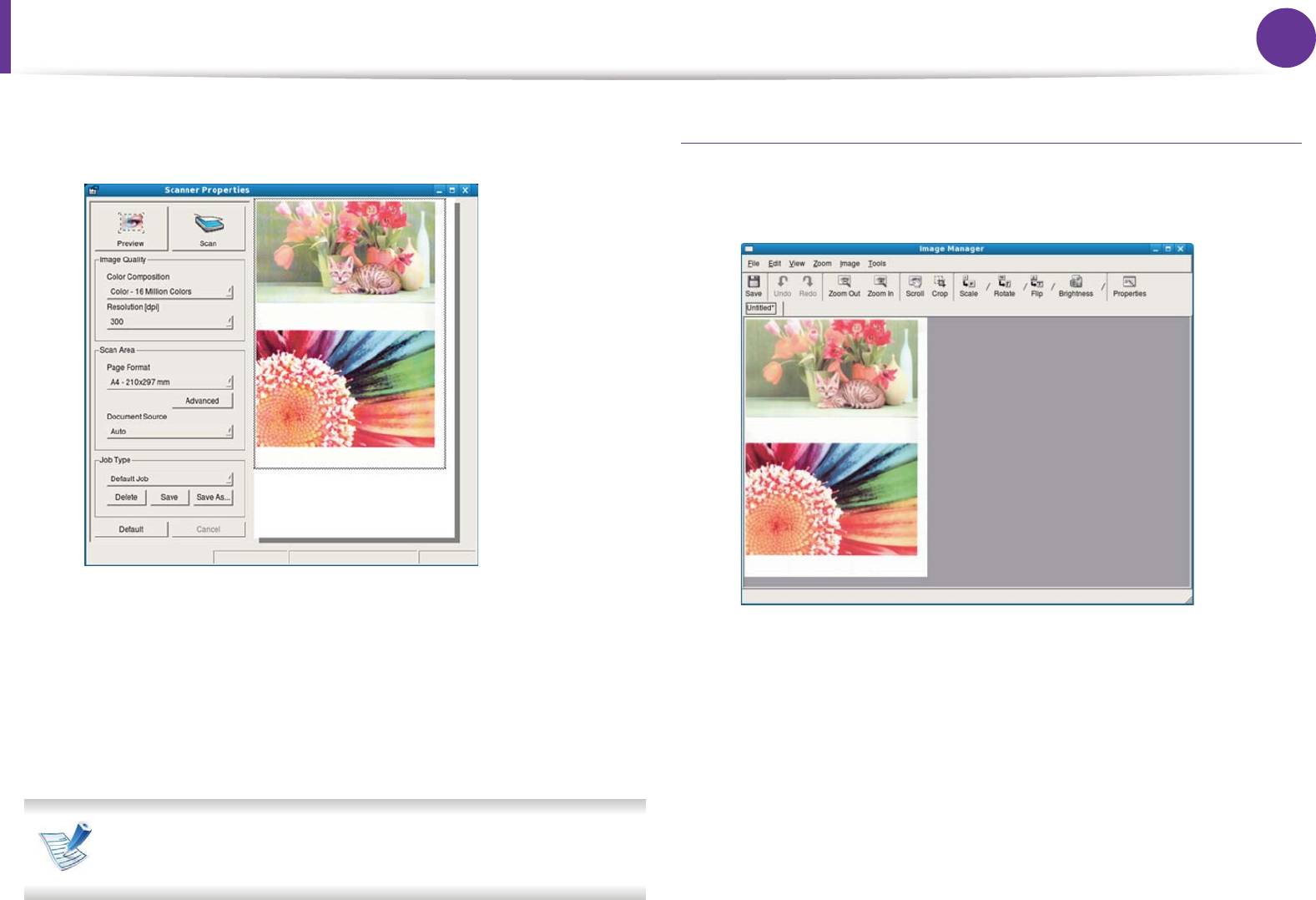
Scan features 122
4. Special features
8 The document is scanned and the image preview appears in
the Preview Pane.
9 Drag the pointer to set the image area to be scanned in the
Preview Pane.
10 Select the option you want.
11 Scan and save your scanned image.
For later use, you can save as your scan settings and add it to
the Job Type drop-down list.
Editing an image with Image Manager
The Image Manager application provides you with menu commands
and tools to edit your scanned image.
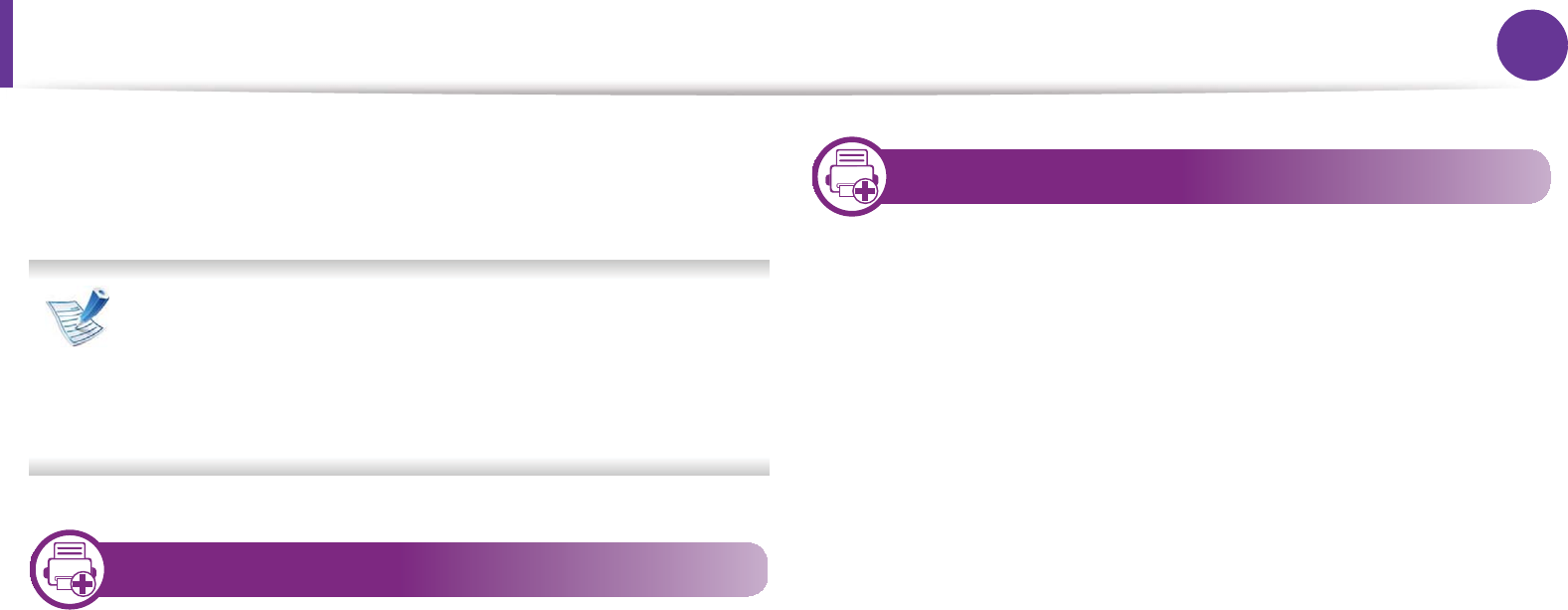
123
4. Special features
Using shared folder features
This feature allows you to use the machine’s memory as a shared
folder. The advantage of this feature is that you can conveniently use
the shared folder through your computer’s window.
• You can use this feature in the models that have a mass
storage device.
• The administrator can set the ID and password to restrict
the user’ s access and also set the maximum number of
simultaneous users.
34
Creating a shared folder
1Open the Windows Explore window from the computer.
2 Enter >>=KRaddress
example:?? in the
address fieldSGand press the Enter key or click Go.
3 Create a new folder under nfsroot directory.
35
Using the shared folder
You can use the shared folder in the same way exactly like the normal
computer. Create, edit and delete the folder or file as a normal
Windows folder. You also store the scanned data in the shared folder.
You can directly print files stored on a the shared folder. You can
print TIFF, BMP, JPEG and PRN files.
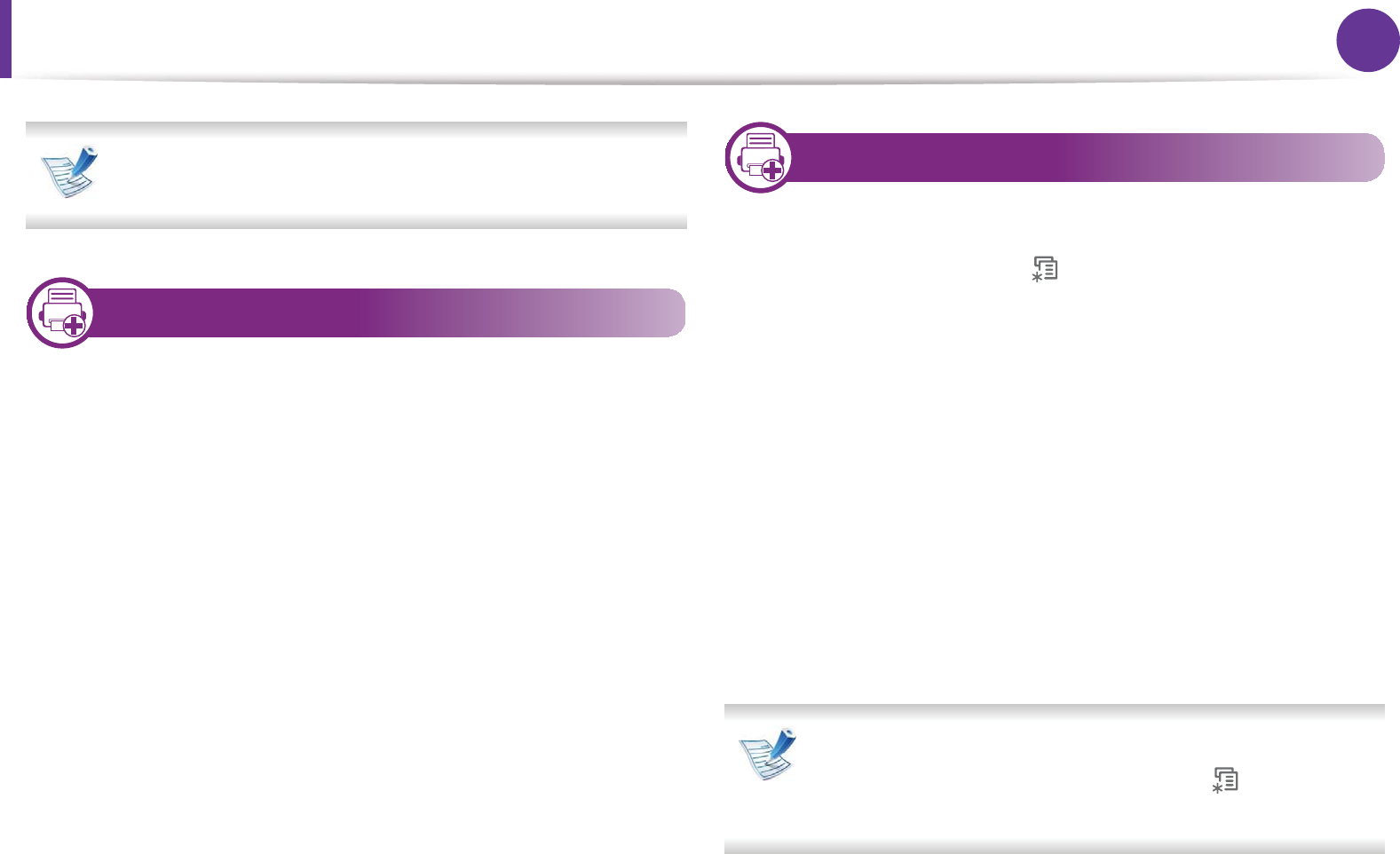
124
4. Special features
Using memory/hard drive features
Some menus may not appear on the display depending on
options or models. If so, it is not applicable to your machine.
36
From the printer driver
After installing the optional memory, you can use advanced printing
features, such as proofing a job and specifying of printing a private
job in the Print window. Select PropertiesorPreference, and
configure the printing mode.
37
From the control panel
If your machine has optional memory or an optional hard drive, you
can use these features from the Menubutton!System Setup
> Job Management.
•Active JobAll of the print jobs waiting to be printed are listed in
the active job queue in the order you sent them to the printer.
You can delete a job from the queue before printing, or promote
a job to print sooner.
•File PolicyYou can choose the file policy for generating file
name before you proceed with the job through optional
memory. If the optional memory already has the same name
when you entered a new file name, you can rename or overwrite
it.
•Stored Job: You can print or delete a stored job.
After installing the hard drive, you can also print the
predefined document templates from the (Menu) button
> System Setup > Form Menu.
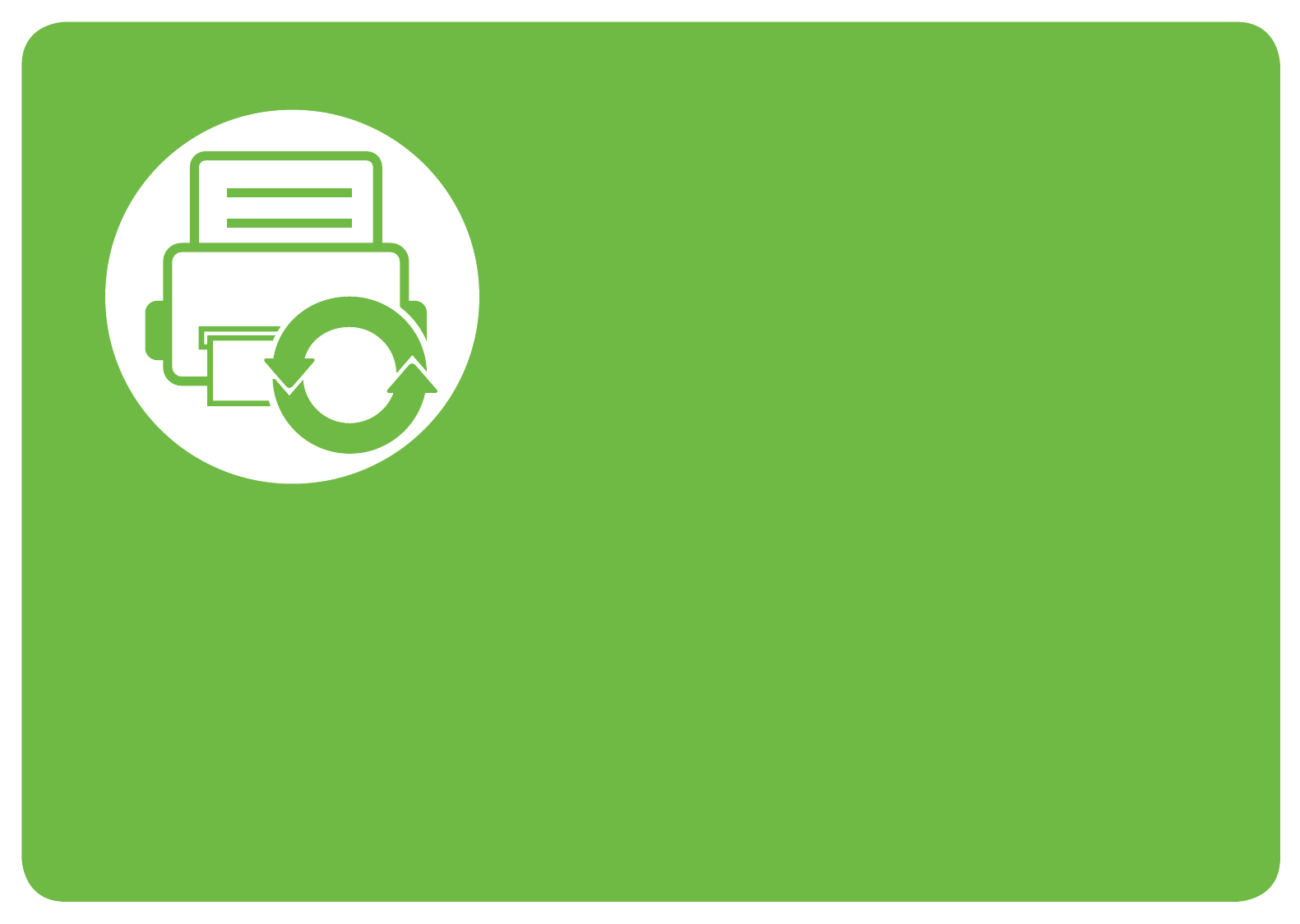
5. Maintenance
This chapter introduces management tools provided to help you make full use
of your machine. It also provides information for maintaining the toner
cartridge.
• Storing the toner cartridge 126
• Tips for moving & storing your machine 128
• Useful management tools 129

126
5. Maintenance
Storing the toner cartridge
Toner cartridges contain components that are sensitive to light,
temperature and humidity. Samsung suggests users follow these
recommendations to ensure optmal performance, highest quality,
and longest life from your new Samsung toner cartridge.
Store this cartridge in the same environment in which the printer will
be used. This should be in controlled temperature and humidity
conditions. The toner cartridge should remain in its original and
unopened package until installation – if original packaging is not
available, cover the top opening of the cartridge with paper and
store in a dark cabinet.
Opening the cartridge package prior to use dramatically shortens its
useful shelf and operating life. Do not store on the floor. If the toner
cartridge is removed from the printer, follow the instructions below
to store the toner cartridge properly.
• Store the cartridge inside the protective bag from the original
package.
• Store lying flat (not standing on end) with the same side facing
up as if it were installed in the machine.
• Do not store consumables in any of the following conditions:
- Temperature greater than 40°C (104°F).
- Humidity range not less than 20% and not greater than 80%.
- An environment with extreme changes in humidity or
temperature.
- Direct sunlight or room light.
-Dusty places.
- A car for a long period of time.
- An environment where corrosive gases are present.
- An environment with salty air.
1
Handling instructions
• Do not touch the surface of the photoconductive drum in the
cartridge.
• Do not expose the cartridge to unnecessary vibrations or shock.
• Never manually rotate the drum, especially in the reverse
direction; this can cause internal damage and toner spillage.
2
Toner cartridge usage
Samsung Electronics does not recommend or approve the use of
non-Samsung brand toner cartridges in your printer including
generic, store brand, refilled, or remanufactured toner cartridges.

Storing the toner cartridge 127
5. Maintenance
Samsung’s printer warranty does not cover damage to the
machine caused by the use of a refilled, remanufactured, or
non-Samsung brand toner cartridges.
3
Estimated cartridge life
Estimated cartridge life (the life of the toner cartridge yield) depends
on the amount of toner that print jobs require. The actual print yield
may vary depending on the print density of the pages you print on,
operating environment, printing interval, media type and/or media
size. For example, if you print a lot of graphics, the consumption of
the toner is higher and you may need to change the cartridge more
often.

128
5. Maintenance
Tips for moving & storing your machine
• When moving the machine, do not tilt or turn it upside down.
Otherwise, the inside of the machine may be contaminated by
toner, which can cause damage to the machine or reduce print
quality.
• When moving the machine, make sure at least two people are
holding the machine securely.

129
5. Maintenance
Useful management tools
4
Easy Capture Manager
Capture your screen and launch Easy Capture Manager by simply
pressing the Print Screen key. Now you can easily print your captured
screen as captured or edited.
5
Samsung AnyWeb Print
This tool helps you screen-capture, preview, scrap, and print
Windows Internet Explorer pages more easily, than when you use an
ordinary program. Click Start > All programs > Samsung Printers
> Samsung AnyWeb Print > Download the latest version to link to
the website where the tool is available for download.
6
Using a fax in your computer
You can send a fax from your computer without going to the
machine.
Sending a fax
To send a fax from your computer, the Samsung Network PC Fax
program must be installed. This program will be installed when you
installed the printer driver.
1Open the document to be sent.
2 Select Print from the File menu.
The Print window will be displayed. It may look slightly
different depending on your application.
3 Select Samsung Network PC Fax from the Print window
4 Click Print or OK.
5 Enter the recipients’ numbers and select the option.
If you want to use a cover page, check Use cover page.
Check Notify me on delivery, when the fax delivered to the
recipients successfully.
6 Click Send.
7
Easy Eco Driver
With the Easy Eco Driver, you can apply Eco features to save paper
and toner before printing. To use this application, Start Easy Eco
Driver before printing job checkbox in the printer properties
should be checked.
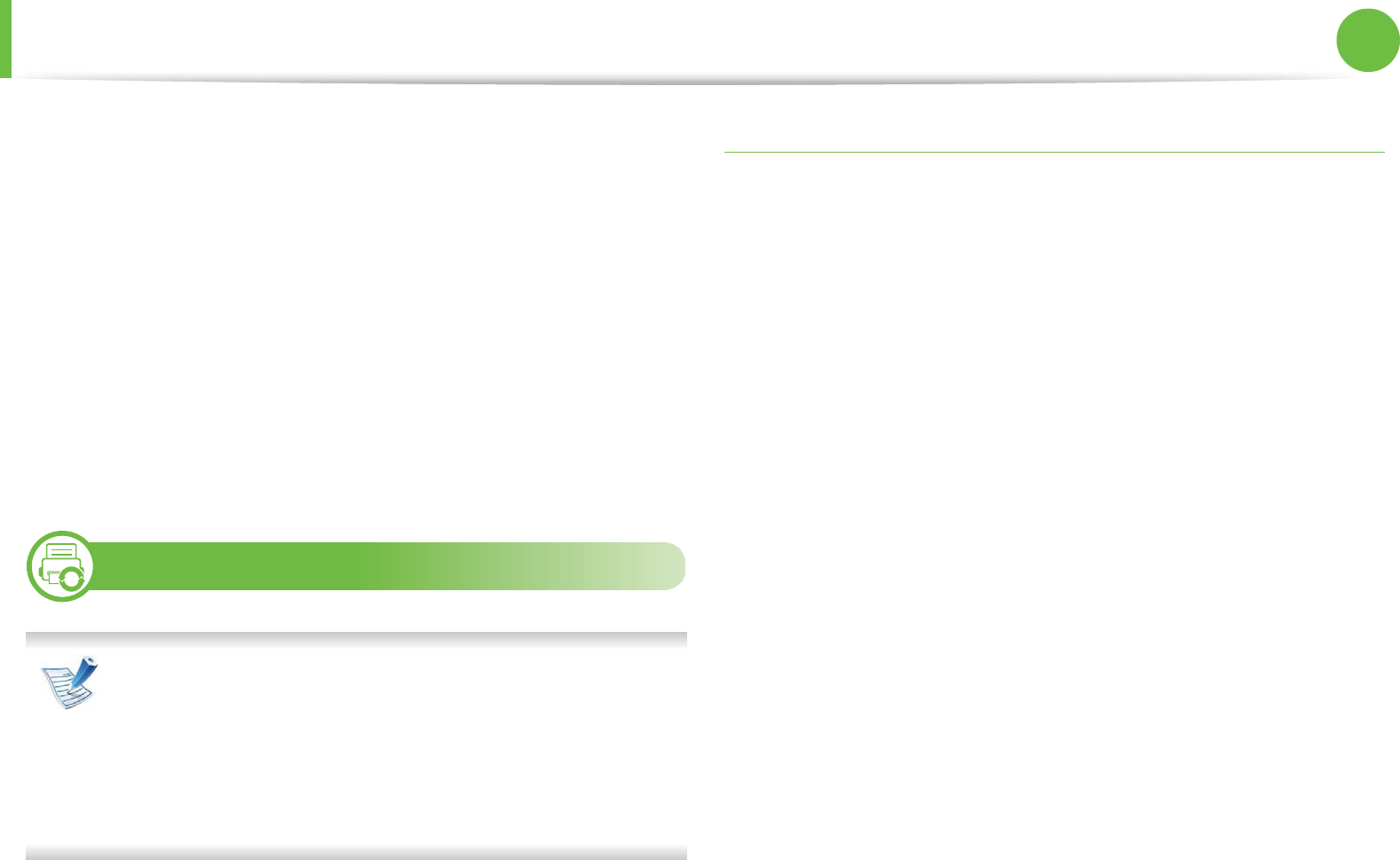
Useful management tools 130
5. Maintenance
Easy Eco Driver also allows you simple editing such as removing
images and texts, changing fonts, and more. You can save frequently
used settings as a preset.
How to use:
1 Open a document to print.
2 Print the document.
A preview window appears.
3 Select the options you want to apply to the document.
You can see the preview of the applied features.
4 Click Print.
8
Using SyncThru™ Web Service
• Internet Explorer 6.0 or higher is the minimum
requirement for SyncThru™ Web Service.
• SyncThru™ Web Service explanation in this user’s guide
may differ from your machine depending on its options or
models.
• Network model only.
Accessing SyncThru™ Web Service
1Access a web browser, such as Internet Explorer, from
Windows.
Enter the machine IP address of your printer (http://
xxx.xxx.xxx.xxx) in the address field and press the Enter key or
click Go.
2 Your machine’s embedded website opens.
ŹLogging into SyncThru™ Web Service
Before configuring options in SyncThru™ Web Service, you need to
log-in as an administrator. You can still use SyncThru™ Web Service
without logging in but you won’t have access to Settings tab and
Security tab.
1Click Login on the upper right of the SyncThru™ Web Service
website.
2 Type in the ID and Password then click Login.
•ID: admin
•Password: sec00000

Useful management tools 131
5. Maintenance
SyncThru™ Web Service overview
Some tabs may not appear depending on your model.
ŹInformation tab
This tab gives you general information about your machine. You can
check things, such as remaining amount of toner. You can also print
reports, such as an error report.
•Active Alerts: Shows the alerts that have occurred in the
machine and their severity.
•Supplies: Shows how many pages are printed and amount of
toner left in the cartridge.
•Usage Counters: Shows the usage count by print types: simplex
and duplex.
•Current Settings: Shows the machine’s and network’s
information.
•Print information: Prints reports such as system related reports,
e-mail address, and font reports.
ŹSettings tab
This tab allows you to set configurations provided by your machine
and network. You need to log-in as an administrator to view this tab.
•Machine Settings tab: Sets options provided by your machine.
•Network Settings tab: Shows options for the network
environment. Sets options such as TCP/IP and network protocols.
ŹSecurity tab
This tab allows you to set system and network security information.
You need to log-in as an administrator to view this tab.
•System Security: Sets the system administrator’s information
and also enables or disables machine features.
•Network Security: Sets settings for HTTPs, IPSec, IPv4/IPv6
filtering, 802.1x, and Authentication servers.
•User Access Control: Classifies users into several groups
according to each user’s role. Each user’s authorization,
authentication and accounting will be controlled by the group’s
role definition.

Useful management tools 132
5. Maintenance
ŹMaintenance tab
This tab allows you to maintain your machine by upgrading firmware
and setting contact information for sending emails. You can also
connect to Samsung website or download drivers by selecting the
Link menu.
•Firmware Upgrade: Upgrade your machine’s firmware.
•Contact Information: Shows the contact information.
•Link: Shows links to useful sites where you can download or
check information.
E-mail notification setup
You can receive emails about your machine’s status by setting this
option. By setting information such as IP address, host name, e-mail
address and SMTP server information, the machine status (toner
cartridge shortage or machine error) will be sent to a certain person's
e-mail automatically. This option may be used more frequently by a
machine administrator.
1Start a web browser, such as Internet Explorer, from Windows.
Enter the machine IP address (http://xxx.xxx.xxx.xxx) in the
address field and press the Enter key or click Go.
2 Your machine’s embedded website opens.
3 From the Settings tab, select Machine Settings > E-mail
Notification.
If you have not configured outgoing server environment, go
to Settings > Network Settings > Outgoing Mail
Server(SMTP) to configure network environment before
setting e-mail notification.
4 Select Enable check box to use the E-mail Notification.
5 Click Add button to add e-mail notification user.
Set the recipient name and e-mail address(es) with
notification items you want to receive an alert for.
6 Click Apply.
If the firewall is activated, the e-mail may not be sent
successfully. In that case, contact the a network
administrator.
Setting the system administrator’s information
This setting is necessary for using the e-mail notification option.
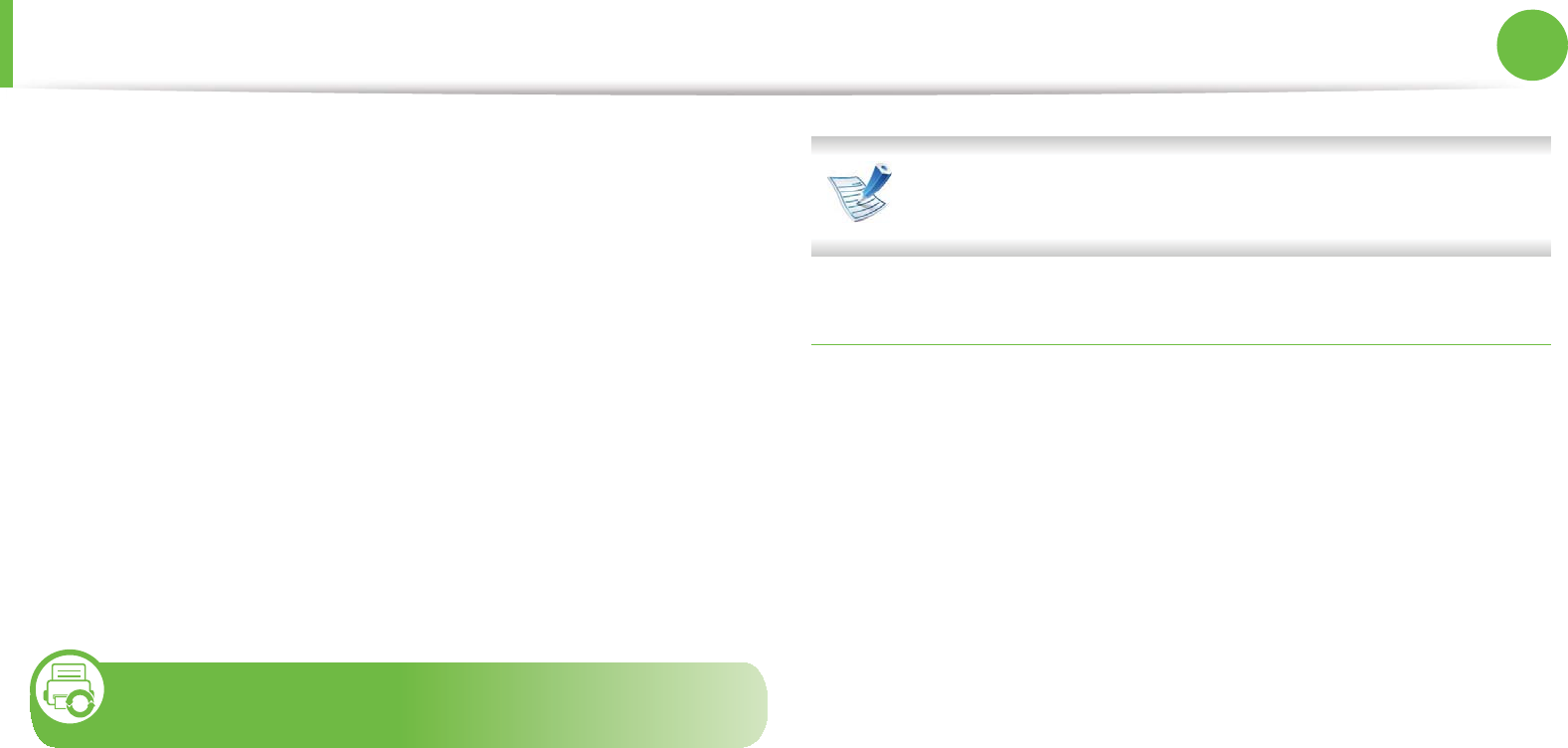
Useful management tools 133
5. Maintenance
1Start a web browser, such as Internet Explorer, from Windows.
Enter the machine IP address (http://xxx.xxx.xxx.xxx) in the
address field and press the Enter key or click Go.
2 Your machine’s embedded website opens.
3 From the Security tab, select System Security > System
Administrator
4 Enter the name of the administrator, phone number, location,
and email address.
5 Click Apply.
9
Using Samsung Easy Printer Manager
(Windows and Macintosh only)
Samsung Easy Printer Manager is an application that combines
Samsung machine settings into one location. Samsung Easy Printer
Manager combines device settings as well as printing environments,
settings/actions and launching. All of these features provide a
gateway to conveniently use your Samsung machine. Samsung Easy
Printer Manager provides two different user interfaces for the user to
choose from: the basic user interface and the advanced user
interface. Switching between the two interfaces is easy: just click a
button.
For Windows, Internet Explorer 6.0 or higher is the minimum
requirement for Samsung Easy Printer Manager.
Understanding Samsung Easy Printer Manager
To open the program:
For Windows,
Select Start > Programs or All Programs > Samsung Printers >
Samsung Easy Printer Manager > Samsung Easy Printer
Manager.
For Macintosh,
Open the Applications folder > Samsung folder > Samsung Easy
Printer Manager.
The Samsung Easy Printer Manager interface is comprised of various
basic sections as described in the table that follows:
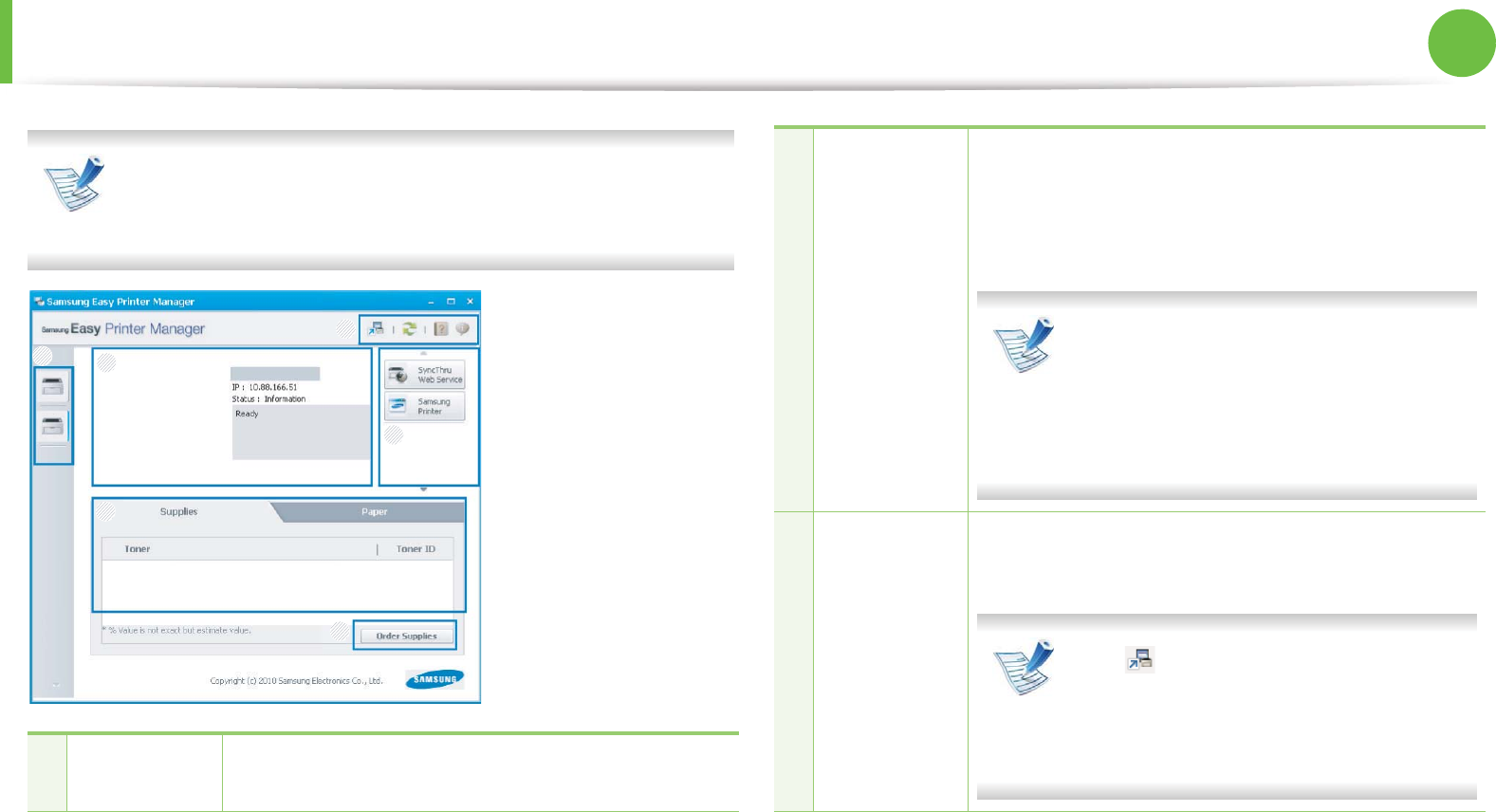
Useful management tools 134
5. Maintenance
The screenshot may differ depending on operating system
you are using.
1Printer list The Printer List displays the installed printer icons
on your computer.
6
3
4
5
2
1
2
Printer
information
This area gives you general information about
your machine. You can check information, such as
the machine’s model name, IP address (or Port
name), and machine status.
Troubleshooting button: This button
opens Troubleshooting Guide when
an error occurs. You can directly open
the necessary section in the user’s
guide.
3
Application
information
Includes links for changing to the advanced
settings, preference, help, and about.
The button is used to change the
user interface to the advanced settings
user interface ( see "Advanced settings
user interface overview" on page 135).
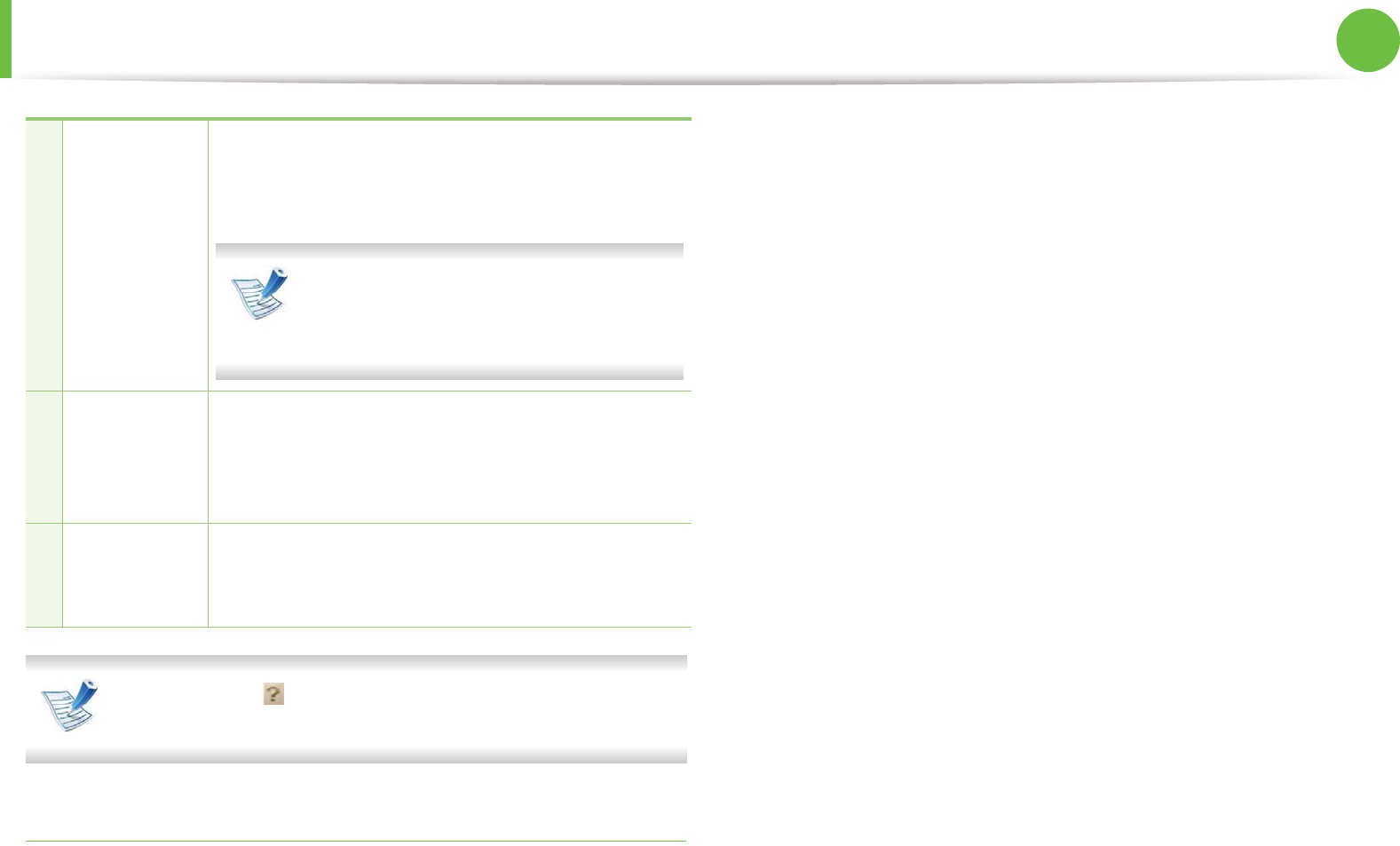
Useful management tools 135
5. Maintenance
Click the Help ( ) button from the upper-right corner of the
window and click on any option you want to know about.
Advanced settings user interface overview
The advanced user interface is intended to be used by the person
responsible for managing the network and machines.
ŹDevice Settings
Click Device Settings > Link to Program button, you can configure
various machine settings.
ŹScan to PC Settings
This menu includes settings to create or delete scan to PC profiles.
•Scan Activation: Determines whether or not scanning is enabled
on the device.
•Profile: Displays the scanning profiles saved on theGselected
device.
•Basic tab: Contains settings related general scan and deviceG
settings.
•Image tab: Contains settings related to image altering.
ŹFax to PC Settings
This menu includes settings related to the basic fax functionality of
the selected device.
•Disable: If Disable is On, incoming faxes will not be received on
this device.
•Enable Fax Receiving from Device: Enables faxing on the
device and allow more options to be set.
4
Quick links Displays Quick links to machine specific
functions. This section also includes links to
applications in the advanced settings.
If you connect your machine to a
network, the SyncThru™ Web Service
window appears.
5
Contents
area
Displays information about the selected machine,
remaining toner level, and paper. The information
will vary based on the machine selected. Some
machines do not have this feature.
6
Order
supplies
Click on the Order button from the supply
ordering window. You can order replacement
toner cartridge(s) from online.
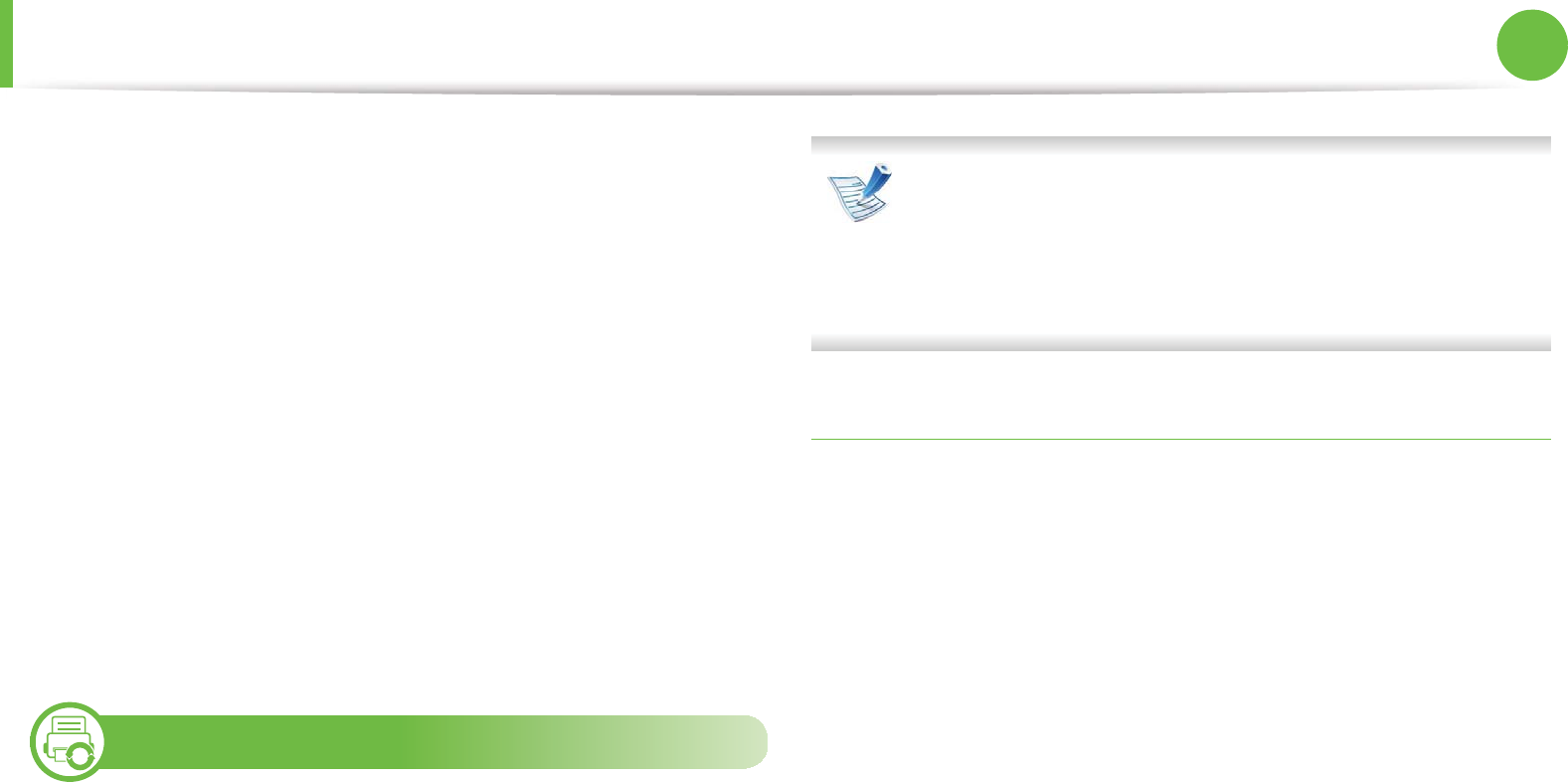
Useful management tools 136
5. Maintenance
ŹAlert Settings(Windows only)
This menu includes settings related to error alerting.
•Printer Alert: Provides settings related to when alerts will be
received.
•Email Alert: Povides options relating to receiving alerts via email.
•Alert History: Provides a history of device and toner related
alerts.
ŹJob Accounting
Provides querying of quota information of the specified job
accounting user. This quota information can be created and applied
to devices by job accounting software such as SyncThru™ or
CounThru™ admin software.
10
Using Samsung Printer Status (Windows only)
The Samsung Printer Status is a program that monitors and informs
you of the machine status.
• The Samsung Printer Status window and its contents
shown in this user’s guide may differ depending on the
machine or operating system in use.
• Check the operating system(s) that are compatible with
your machine (see Basic Guide).
Samsung Printer Status overview
If an error occurs while operating, you can check the error from the
Samsung Printer Status. Samsung Printer Status is installed
automatically when you install the machine software.
You can also launch Samsung Printer Status manually. Go to the
Printing Preferences , click the Basic tab > Printer Status button.
These icons appear on the Windows task bar:
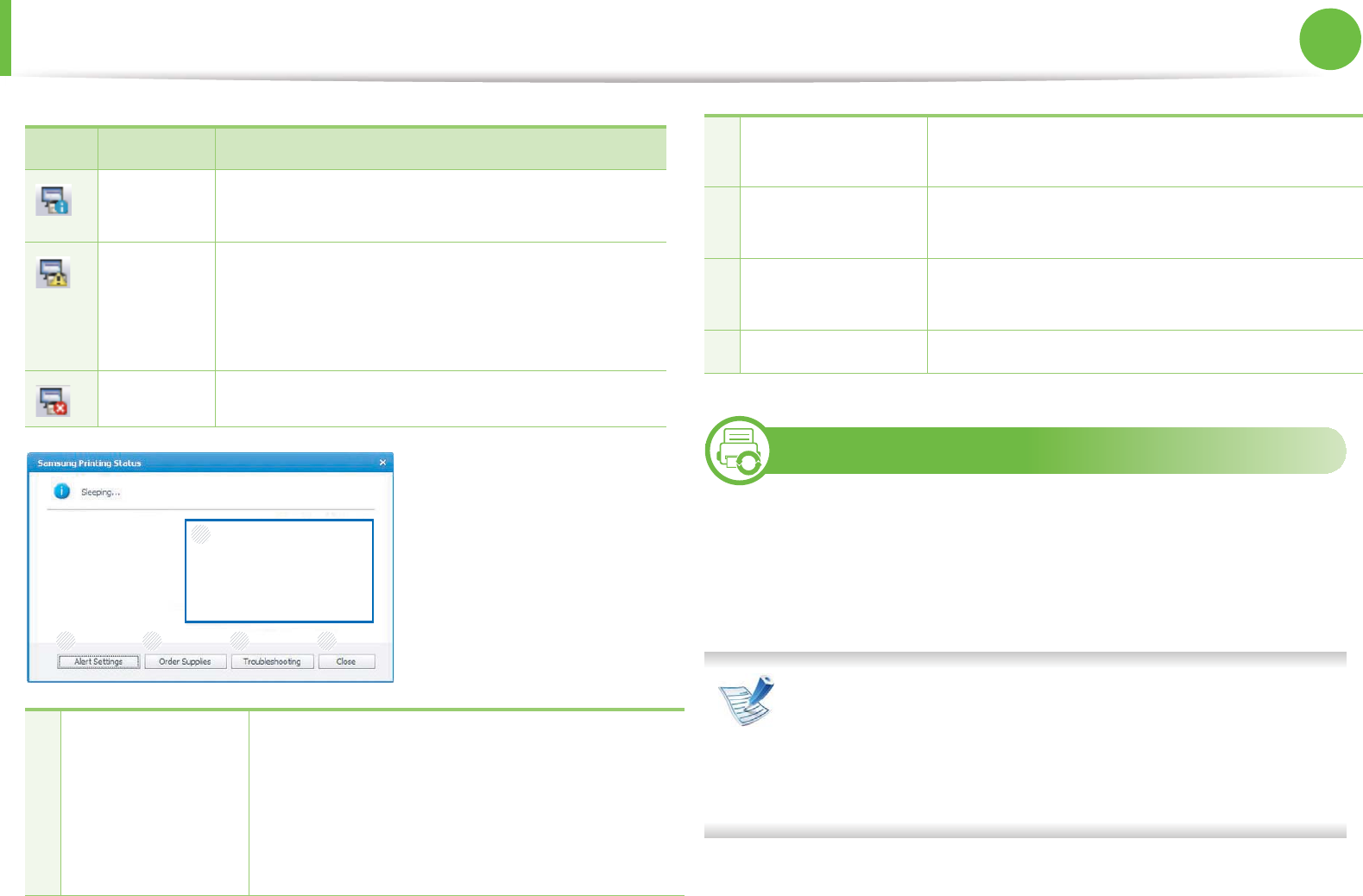
Useful management tools 137
5. Maintenance
11
Using Smart Panel ( Linux only)
Smart Panel is a program that monitors and informs you of the
machine’s status, and allows you to customize the machine’s
settings. You can download Smart Panel from the Samsung website
(see "Installing the Smart Panel" on page 8).
• The Smart Panel window and its contents shown in this
user’s guide may differ depending on the machine or
operating system in use.
• Check the operating system(s) that are compatible with
your machine (see Basic Guide).
Icon Mean Description
Normal The machine is in ready mode and experiencing
no errors or warnings.
Warning The machine is in a state where an error might
occur in the future. For example, it might be in
toner low status, which may lead to toner empty
status.
Error The machine has at least one error.
1
Toner Level You can view the level of toner remaining in
each toner cartridge. The machine and the
number of toner cartridge(s) shown in the
above window may differ depending on the
machine in use. Some machines do not have
this feature.
1
34
2 5
2Alert Settings Select the settings you want from the options
window.
3Order Supplies You can order replacement toner cartridge(s)
from online.
4Troubleshooting You can directly open the troubleshooting
section in the user’s guide.
5Close Close the window.
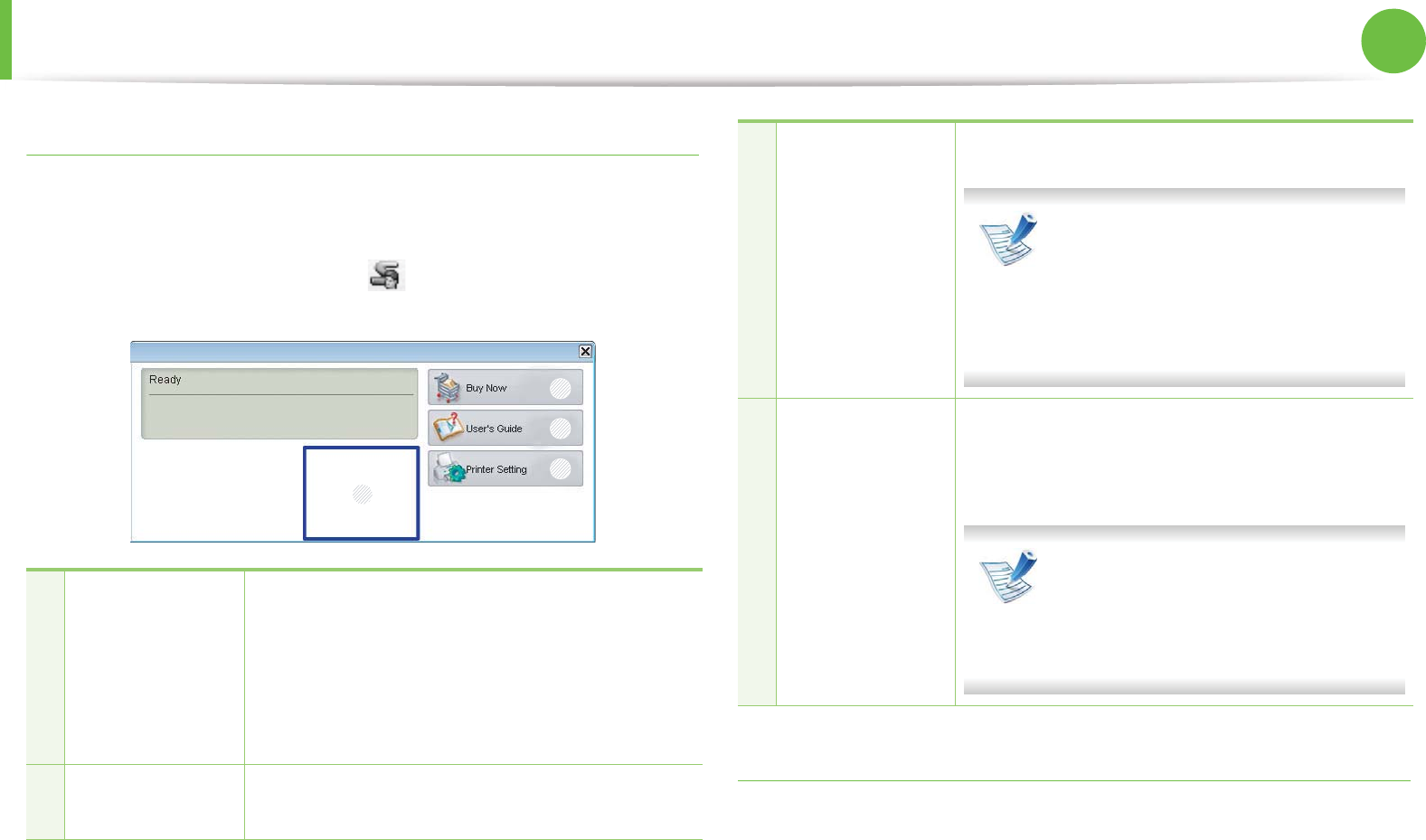
Useful management tools 138
5. Maintenance
Smart Panel overview
If an error occurs while operating, you can check the error from the
Smart Panel. You can also launch Smart Panel manually.
Double-click the Smart Panel icon( ) in the Notification Area.
Changing Smart Panel’s settings
Right-click in Linux on the Smart Panel icon and select Configure
smart panel. Select the settings you want from the Configure smart
panel window.
1
Toner Level You can view the level of toner remaining in
each toner cartridge. The machine and the
number of toner cartridge(s) shown in the
above window may differ depending on the
machine in use. Some machines do not have
this feature.
2Buy Now You can order replacement toner cartridge(s)
from online.
1
2
3
4
3
User’s Guide You can view the online User’s Guide.
This button opens the
Troubleshooting Guide when an
error occurs. You can directly open
the troubleshooting section in the
user’s guide.
4
Printer Setting You can configure various machine settings in
the Printer Settings Utility window. Some
machines do not have this feature.
If you connect your machine to a
network, the SyncThru™ Web
Service window appears instead of
the Printer Settings Utility.
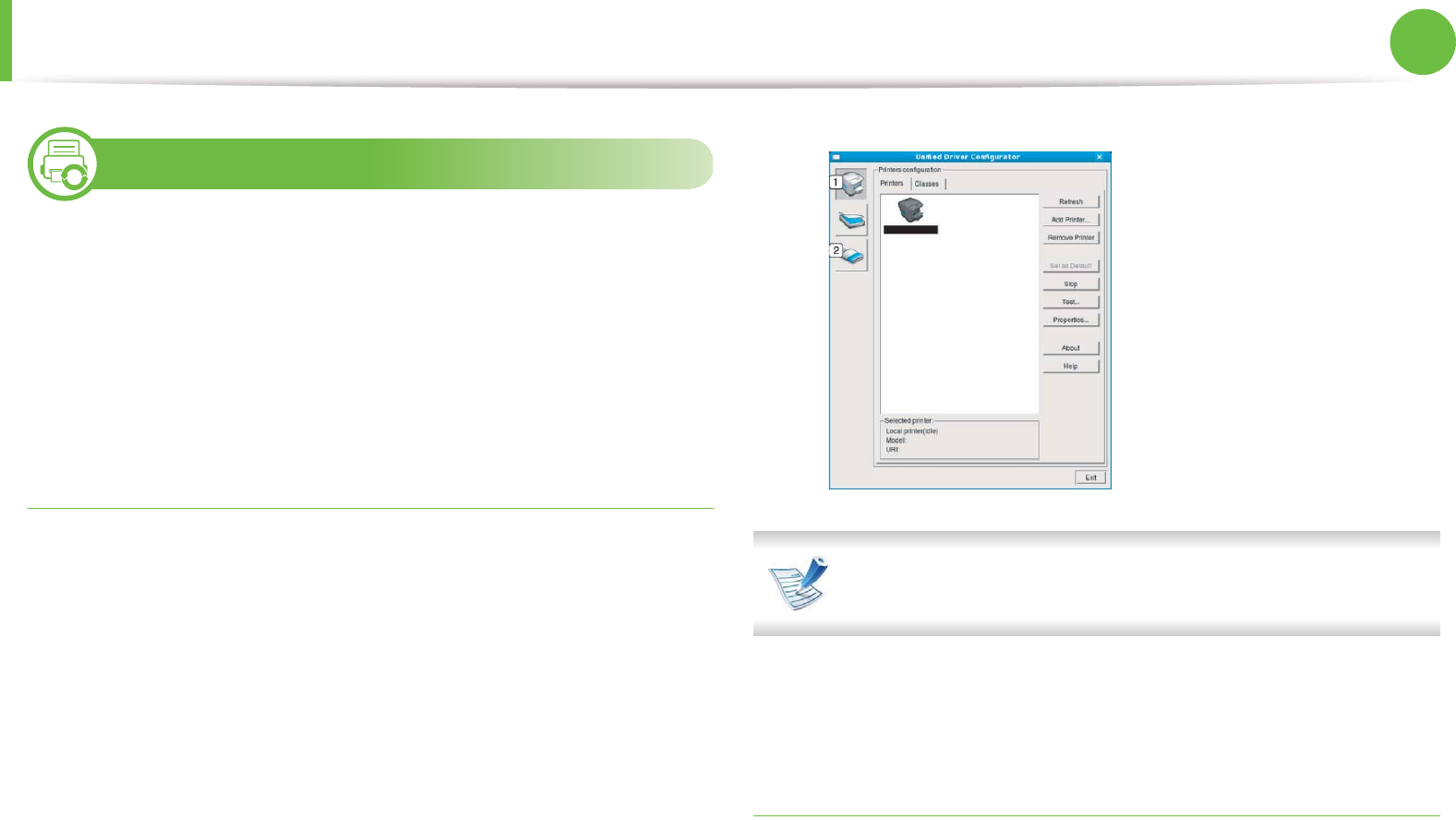
Useful management tools 139
5. Maintenance
12
Using the Linux Unified Driver Configurator
The Unified Driver Configurator is a tool primarily intended for
configuring machine devices. You need to install Unified Linux
Driver to use Unified Driver Configurator (see "Installation for Linux"
on page 8).
After the driver is installed on your Linux system, the Unified Driver
Configurator icon will automatically be created on your desktop.
Opening Unified Driver Configurator
1Double-click the Unified Driver Configurator on the
desktop.
You can also click the Startup Menu icon and select Samsung
Unified Driver > Unified Driver Configurator.
2 Click each button on the left to switch to the corresponding
configuration window.
To use the on screen help, click Help.
3 After changing the configurations, click Exit to close the
Unified Driver Configurator.
Printers configuration
Printers configuration has the two tabs: Printers and Classes.
1Printer Configuration
2Port Configuration
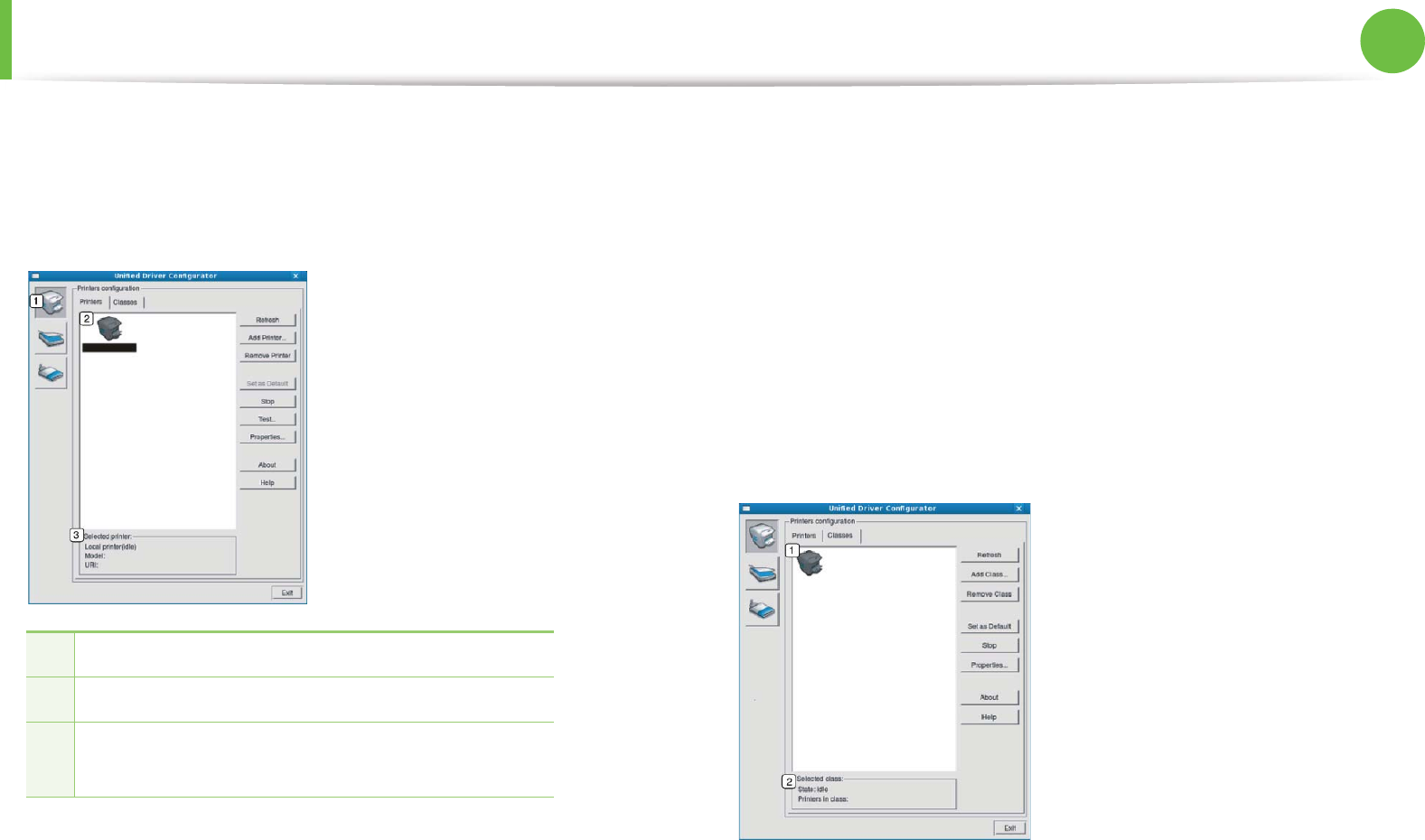
Useful management tools 140
5. Maintenance
ŹPrinters tab
View the current system’s printer configuration by clicking on the
machine icon button on the left side of the Unified Driver
Configurator window.
The printer control buttons are, as follows:
•Refresh: Renews the available machines list.
•Add Printer: Allows you to add a new machines.
•Remove Printer: Removes the selected machine.
•Set as Default: Sets the current selected machine as a default
machine.
•Stop/Start: Stops/starts the machine.
•Test: Allows you to print a test page to ensure the machine is
working properly.
•Properties: Allows you to view and change the printer’s
properties.
ŹClasses tab
The Classes tab shows a list of available machine classes.
1Switches to Printers configuration.
2Shows all of the installed machines.
3Shows the status, model name, and URI of your
machine.
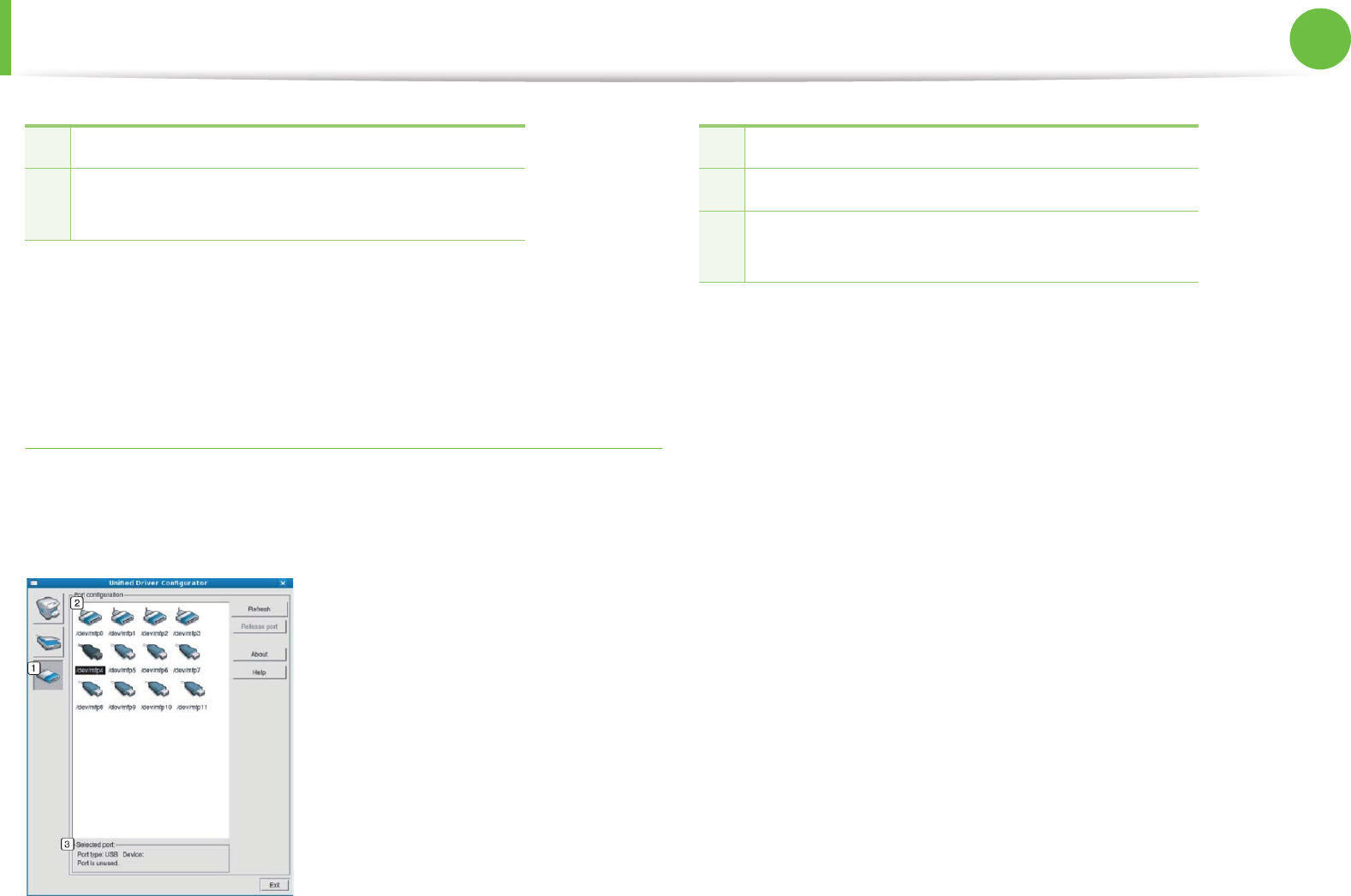
Useful management tools 141
5. Maintenance
•Refresh: Renews the classes list.
•Add Class: Allows you to add a new machine class.
•Remove Class: Removes the selected machine class.
Ports configuration
In this window, you can view the list of available ports, check the
status of each port and release a port that is stalled in a busy state
when its owner has terminated the job for any reason.
•Refresh: Renews the available ports list.
•Release port: Releases the selected port.
1Shows all of the machine classes.
2Shows the status of the class and the number of
machines in the class.
1Switches to Ports configuration.
2Shows all of the available ports.
3Shows the port type, device connected to the
port, and status.
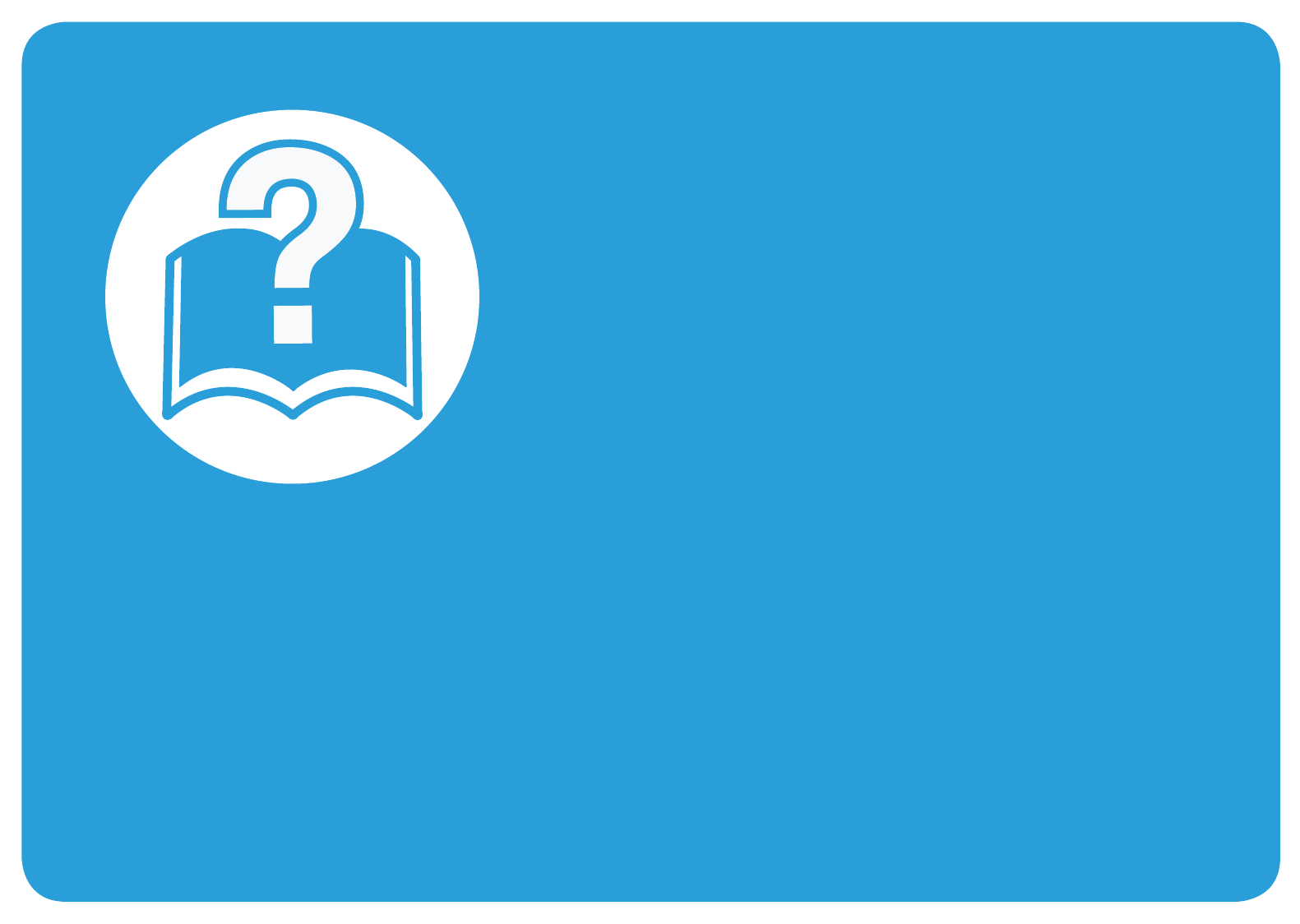
6. Troubleshooting
This chapter gives helpful information for what to do if you encounter an error.
• Paper feeding problems 143
• Power and cable connecting problems 144
• Printing problems 145
• Printing quality problems 149
• Copying problems 157
• Scanning problems 158
• Faxing problems 160
• Operating system problems 162
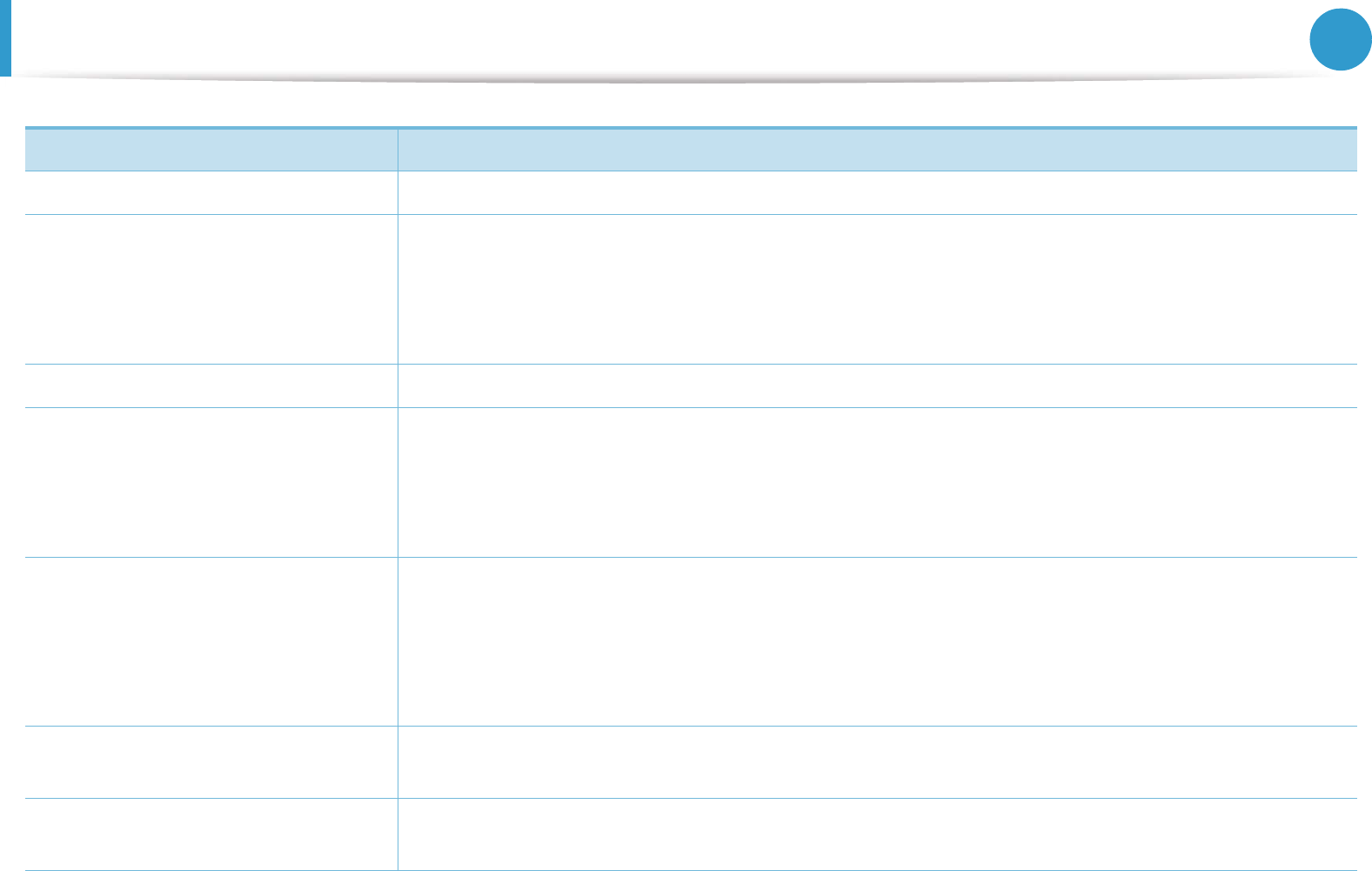
143
6. Troubleshooting
Paper feeding problems
Condition Suggested solutions
Paper jams during printing. Clear the paper jam.
Paper sticks together. • Check the maximum paper capacity of the tray .
• Make sure that you are using the correct type of paper.
• Remove paper from the tray and flex or fan the paper.
• Humid conditions may cause some paper to stick together.
Multiple sheets of paper do not feed. Different types of paper may be stacked in the tray. Load paper of only one type, size, and weight.
Paper does not feed into the
machine.
• Remove any obstructions from inside the machine.
• Paper has not been loaded correctly. Remove paper from the tray and reload it correctly.
• There is too much paper in the tray. Remove excess paper from the tray.
• The paper is too thick. Use only paper that meets the specifications required by the machine.
The paper keeps jamming. • There is too much paper in the tray. Remove excess paper from the tray. If you are printing on special
materials, use the multi-purpose tray (or manual feeder).
• An incorrect type of paper is being used. Use only paper that meets the specifications required by the
machine.
• There may be debris inside the machine. Open the front cover and remove any debris.
Transparencies stick together in the
paper exit.
Use only transparencies specifically designed for laser printers. Remove each transparency as it exits
from the machine.
Envelopes skew or fail to feed
correctly.
Ensure that the paper guides are against both sides of the envelopes.

144
6. Troubleshooting
Power and cable connecting problems
Click this link to open an animation about solving power problems.
Condition Suggested solutions
The machine is not receiving power,
or the connection cable between the
computer and the machine is not
connected properly.
• Connect the machine to the electricity supply first. If the machine has a (Power) button on the
control, press it.
• Disconnect the machine’s cable and reconnect it.
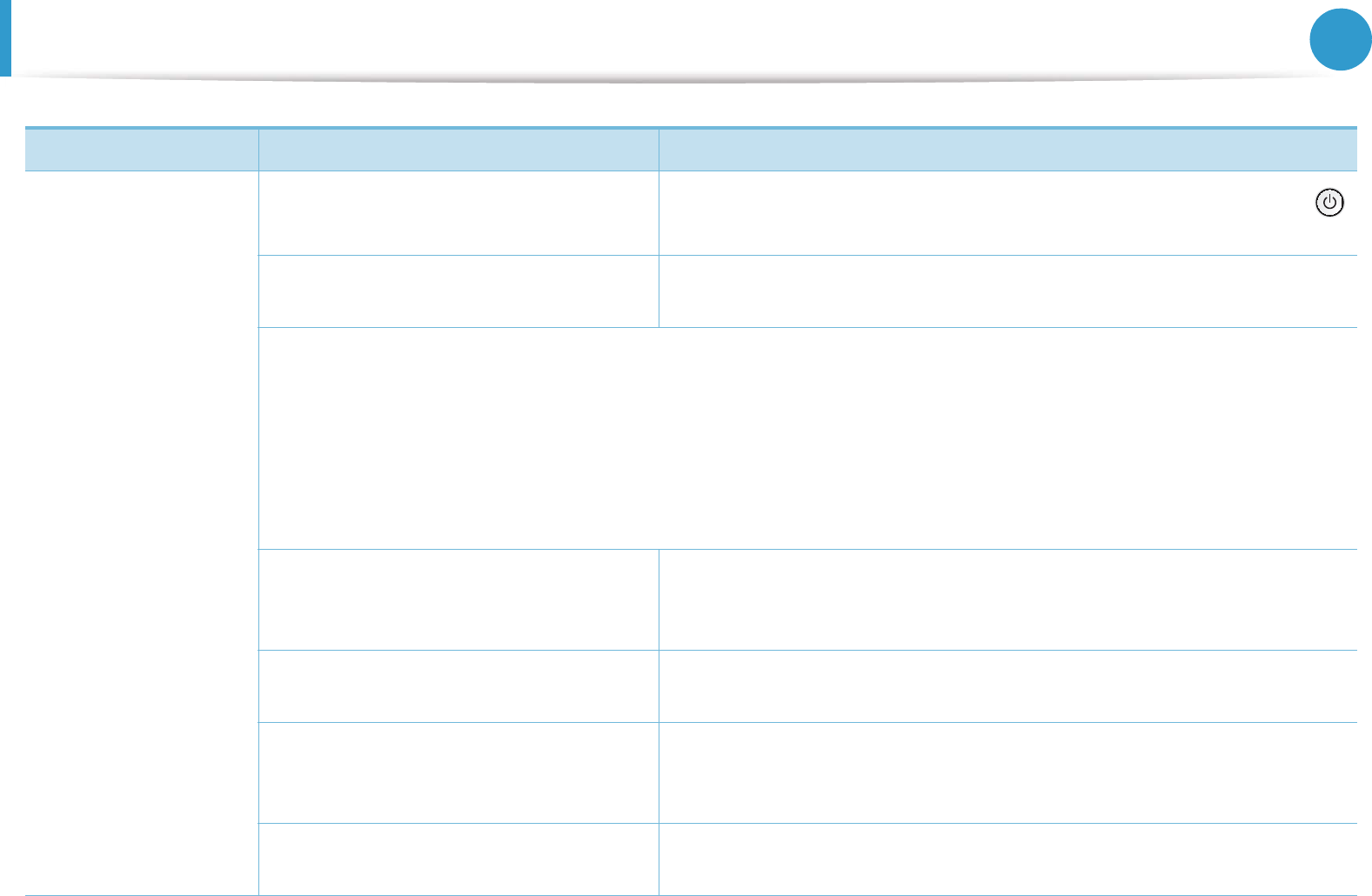
145
6. Troubleshooting
Printing problems
Condition Possible cause Suggested solutions
The machine does not
print.
The machine is not receiving power. Connect the machine to the electricity supply first. If the machine has a
(Power) button on the control, press it.
The machine is not selected as the default
machine.
Select your machine as your default machine in Windows.
Check the machine for the following:
• The front cover is not closed. Close the front cover.
• Paper is jammed. Clear the paper jam.
• No paper is loaded. Load paper.
• The toner cartridge is not installed. Install the toner cartridge.
If a system error occurs, contact your service representative.
The connection cable between the
computer and the machine is not
connected properly.
Disconnect the machine cable and reconnect it.
The connection cable between the
computer and the machine is defective.
If possible, attach the cable to another computer that is working properly
and print a job. You can also try using a different machine cable.
The port setting is incorrect. Check the Windows printer settings to make sure that the print job is sent
to the correct port. If the computer has more than one port, make sure that
the machine is attached to the correct one.
The machine may be configured
incorrectly.
Check the Printing Preferences to ensure that all of the print settings are
correct.

Printing problems 146
6. Troubleshooting
The machine does not
print.
The printer driver may be incorrectly
installed.
Uninstall and reinstall the machine’s driver.
The machine is malfunctioning. Check the display message on the control panel to see if the machine is
indicating a system error. Contact a service representative.
The document size is so big that the hard
disk space of the computer is insufficient
to access the print job.
Get more hard disk space and print the document again.
The output tray is full. Once the paper is removed from the output tray, the machine resumes
printing.
The machine selects
print materials from
the wrong paper
source.
The paper option that was selected in the
Printing Preferences may be incorrect.
For many software applications, the paper source selection is found under
the Paper tab within the Printing Preferences. Select the correct paper
source. See the printer driver help screen.
A print job is
extremely slow.
The job may be very complex. Reduce the complexity of the page or try adjusting the print quality
settings.
Half the page is blank. The page orientation setting may be
incorrect.
Change the page orientation in your application. See the printer driver help
screen.
The paper size and the paper size settings
do not match.
Ensure that the paper size in the printer driver settings matches the paper
in the tray.
Or, ensure that the paper size in the printer driver settings matches the
paper selection in the software application settings you use.
Condition Possible cause Suggested solutions
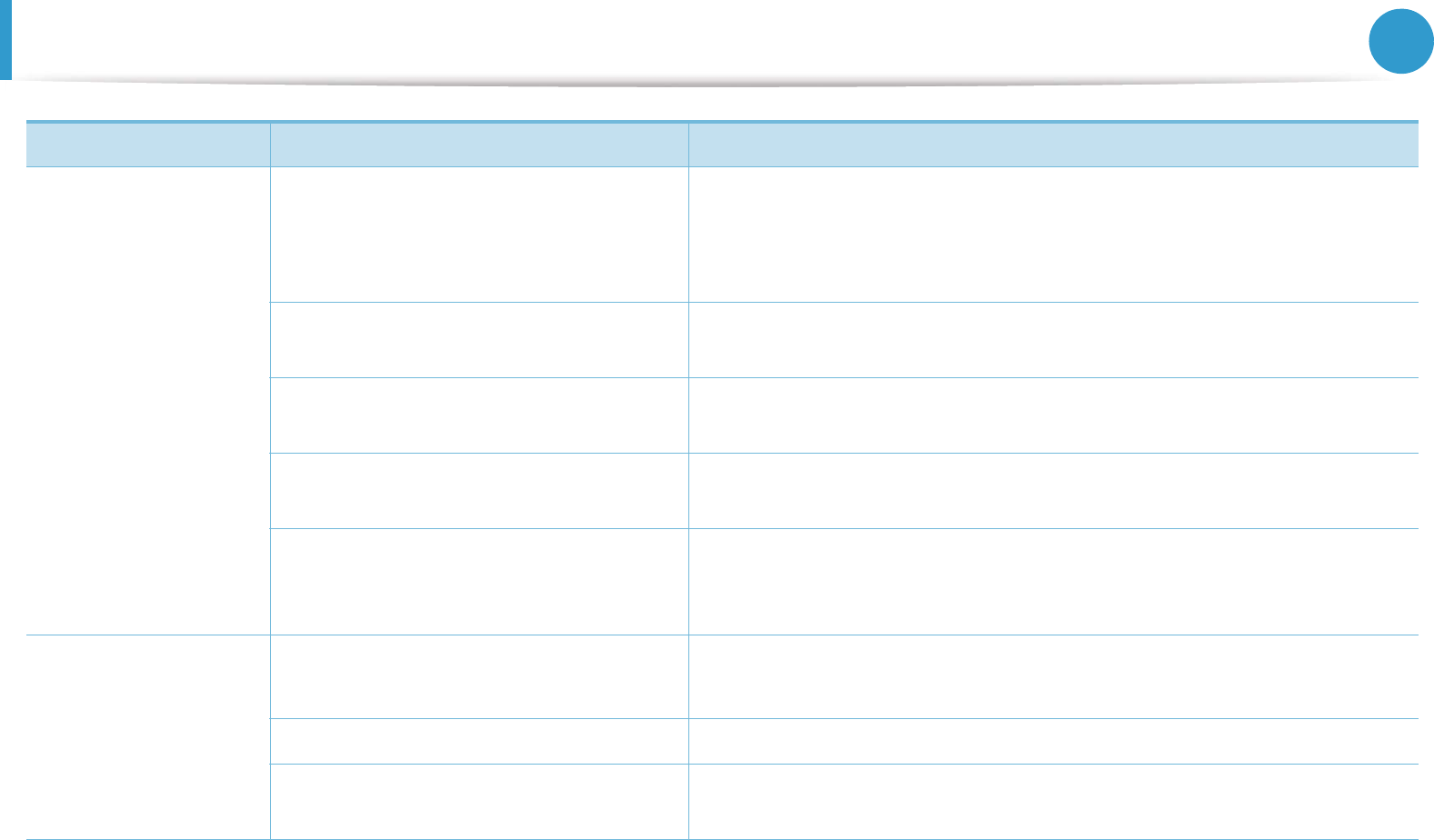
Printing problems 147
6. Troubleshooting
The machine prints,
but the text is wrong,
garbled, or
incomplete.
The machine cable is loose or defective. Disconnect the machine cable and reconnect. Try a print job that you have
already printed successfully. If possible, attach the cable and the machine
to another computer that you know works and try a print job. Finally, try a
new machine cable.
The wrong printer driver was selected. Check the applicatinon’s printer selection menu to ensure that your
machine is selected.
The software application is
malfunctioning.
Try printing a job from another application.
The operating system is malfunctioning. Exit Windows and reboot the computer. Turn the machine off and back on
again.
If you are in a DOS environment, the font
setting for your machine may be set
incorrectly.
See "Changing the font setting" on page 86.
Pages print, but they
are blank.
The toner cartridge is defective or out of
toner.
Redistribute the toner, if necessary.
If necessary, replace the toner cartridge.
The file may have blank pages. Check the file to ensure that it does not contain blank pages.
Some parts, such as the controller or the
board, may be defective.
Contact a service representative.
Condition Possible cause Suggested solutions
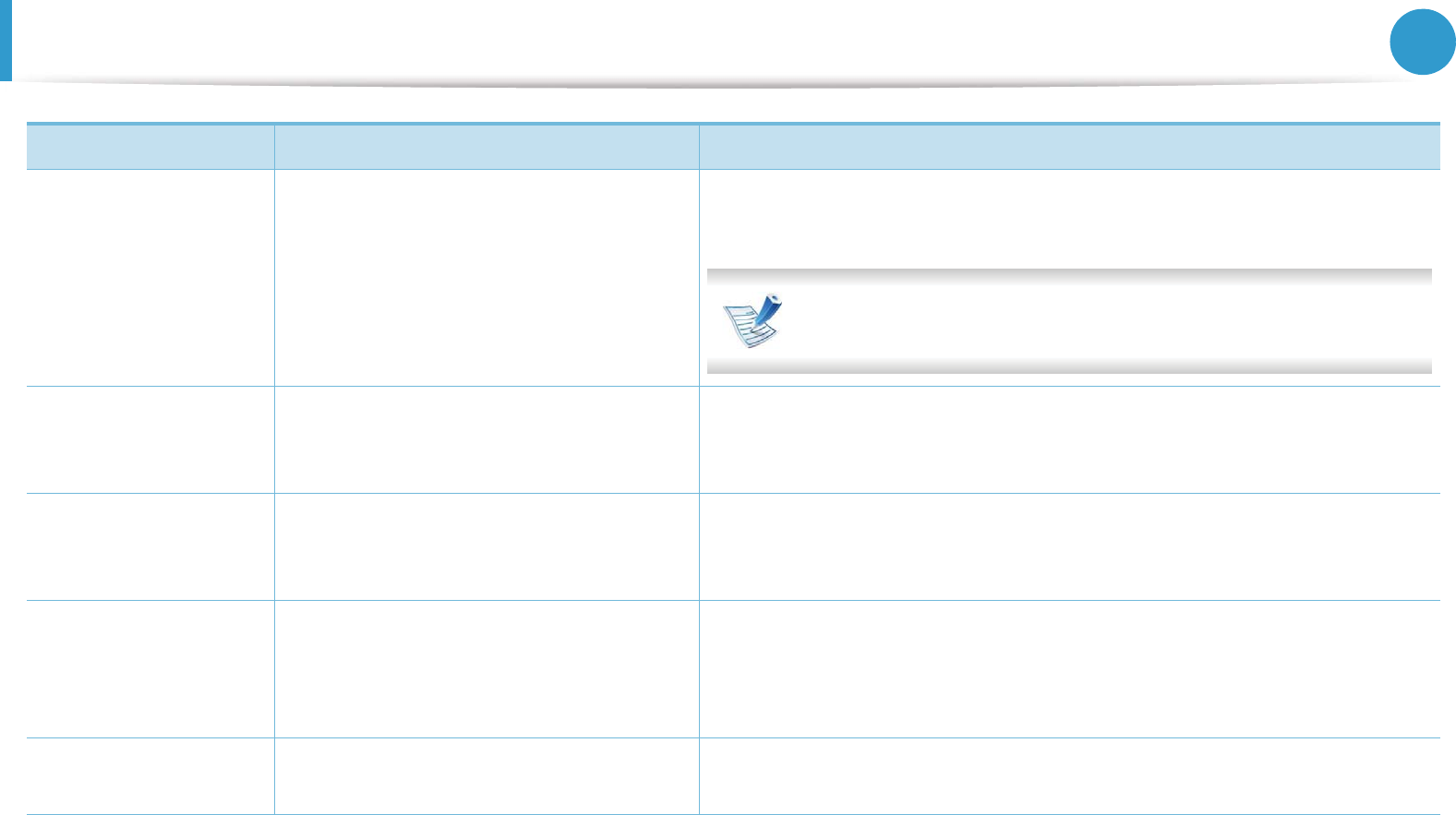
Printing problems 148
6. Troubleshooting
The machine does not
print PDF files
correctly. Some parts
of graphics, text, or
illustrations are
missing.
Incompatibility between the PDF file and
the Acrobat products.
Printing the PDF file as an image may enable the file to print. Turn on Print
As Image from the Acrobat printing options.
It will take longer to print when you print a PDF file as an image.
The print quality of
photos is not good.
Images are not clear.
The resolution of the photo is very low. Reduce the photo size. If you increase the photo size in the software
application, the resolution will be reduced.
Before printing, the
machine emits vapor
near the output tray.
Using damp paper can cause vapor during
printing.
This is not a problem. Just keep printing.
The machine does not
print special-sized
paper, such as billing
paper.
Paper size and paper size setting do not
match.
Set the correct paper size in the Custom in Paper tab in Printing
Preferences.
The printed billing
paper is curled.
The paper type setting does not match. Change the printer option and try again. Go to Printing Preferences , click
Paper tab, and set type to Thick.
Condition Possible cause Suggested solutions
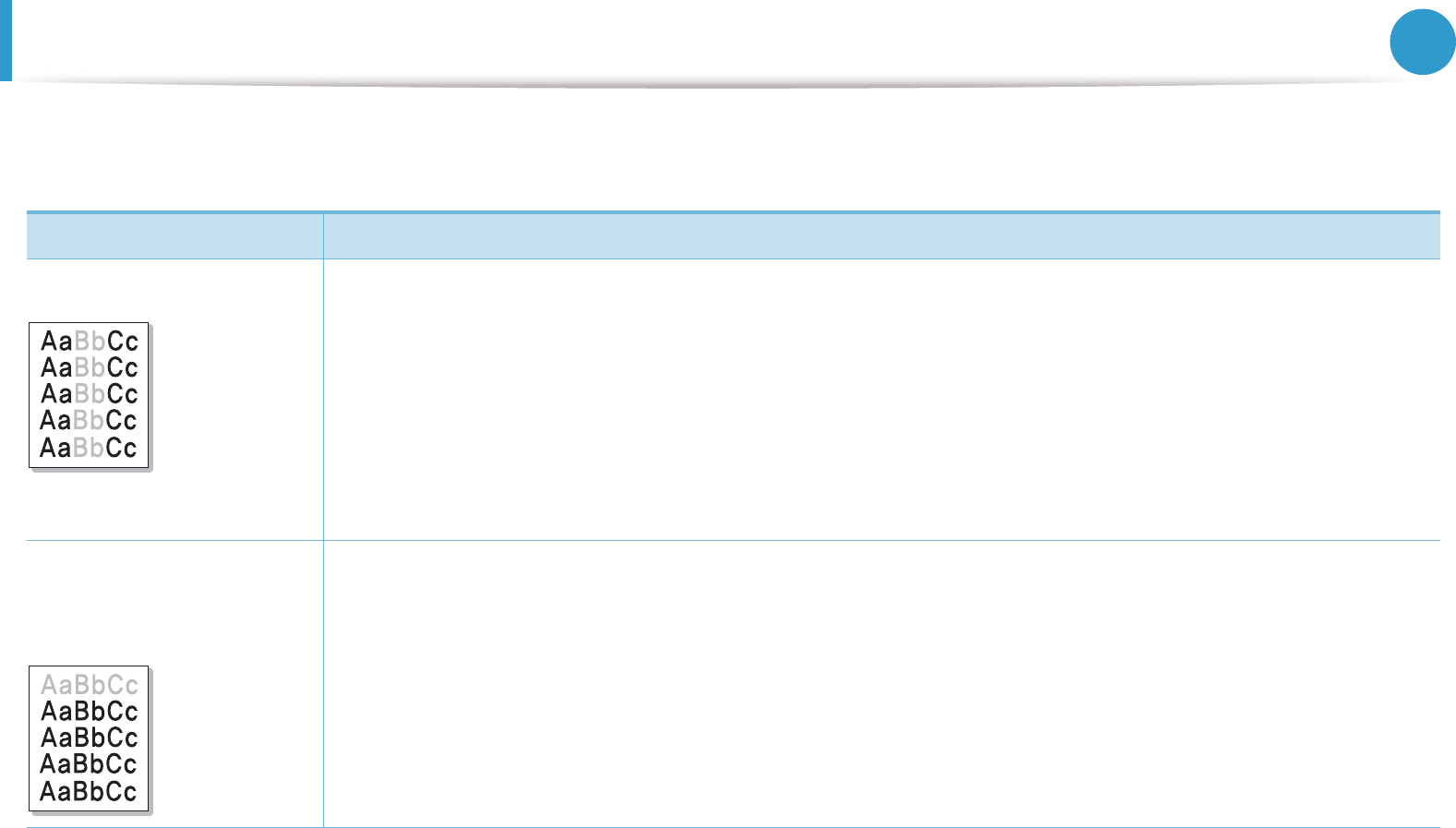
149
6. Troubleshooting
Printing quality problems
If the inside of the machine is dirty or paper has been loaded improperly, there might be a reduction in print quality. See the table below to
clear the problem.
Condition Suggested solutions
Light or faded print • If a vertical white streak or faded area appears on the page, the toner supply is low. Install a new toner cartridge.
• The paper may not meet paper specifications; for example, the paper may be too moist or rough.
• If the entire page is light, the print resolution setting is too low or the toner save mode is on. Adjust the print
resolution and turn the toner save mode off. See the help screen of the printer driver.
• A combination of faded or smeared defects may indicate that the toner cartridge needs cleaning. Clean the
inside of your machine.
• The surface of the LSU part inside the machine may be dirty. Clean the inside of your machine. If these steps do
not correct the problem, contact a service representative.
The top half of the paper is
printed lighter than the
rest of the paper
The toner might not adhere properly to this type of paper.
• Change the printer option and try again. Go to Printing Preferences, click the Paper tab, and set the paper type
to Recycled.
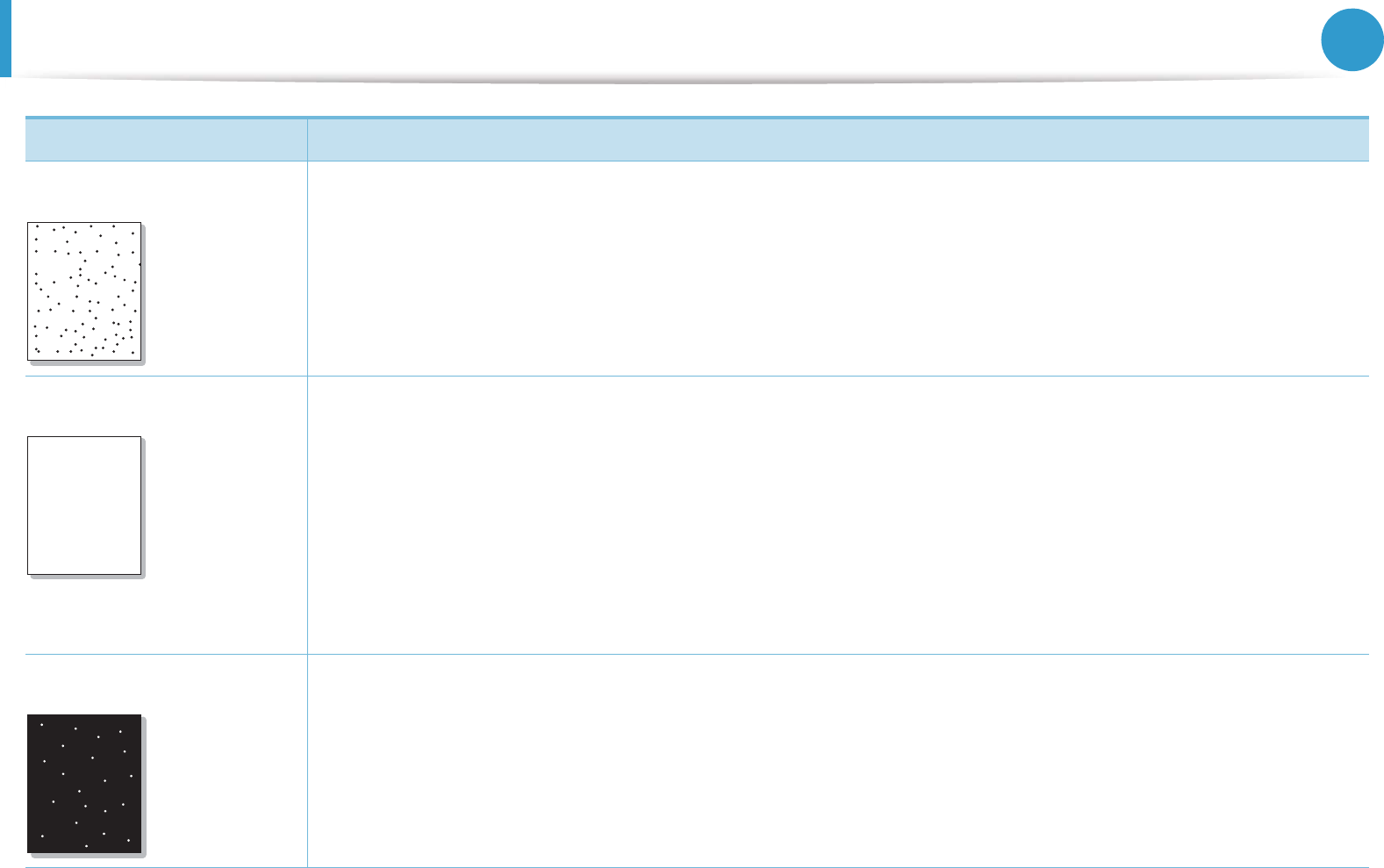
Printing quality problems 150
6. Troubleshooting
Toner specks • The paper may not meet specifications; for example, the paper may be too moist or rough.
• The transfer roller may be dirty. Clean the inside of your machine.
• The paper path may need cleaning. Contact a service representative.
Dropouts If faded areas, generally rounded, occur randomly on the page:
• A single sheet of paper may be defective. Try reprinting the job.
• The moisture content of the paper is uneven or the paper has moist spots on its surface. Try a different brand of
paper.
• The paper lot is bad. The manufacturing processes can cause some areas to reject toner. Try a different kind or
brand of paper.
• Change the printer option and try again. Go to Printing Preferences, click the Paper tab, and set type to Thick.
If these steps do not correct the problem, contact a service representative.
White Spots If white spots appear on the page:
• The paper is too rough and a lot of dirt from paper falls to the inner components within the machine, so the
transfer roller may be dirty. Clean the inside of your machine.
• The paper path may need cleaning. Clean the inside of your machine.
If these steps do not correct the problem, contact a service representative.
Condition Suggested solutions
AaBbCc
AaBbCc
AaBbCc
AaBbCc
AaBbCc
AaBbC
AaBbC
AaBbC
AaBbC
AaBbC
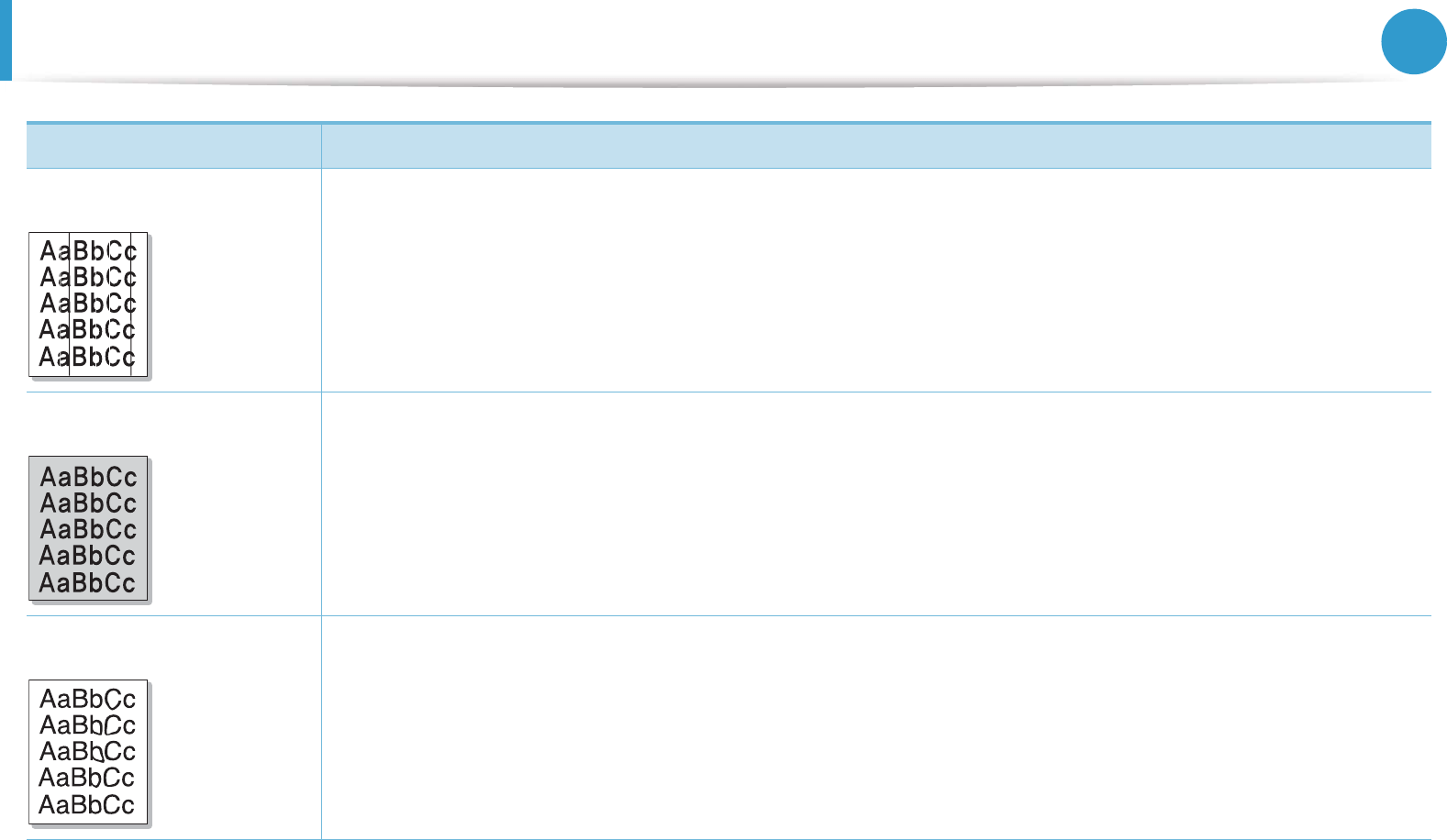
Printing quality problems 151
6. Troubleshooting
Vertical lines If black vertical streaks appear on the page:
• The surface (drum part) of the toner cartridge inside the machine has probably been scratched. Remove the
toner cartridge and install a new one.
If white vertical streaks appear on the page:
• The surface of the LSU part inside the machine may be dirty. Clean the inside of your machine. If these steps do
not correct the problem, contact a service representative.
Black or color background If the amount of background shading becomes unacceptable:
• Change to a lighter weight paper.
• Check the environmental conditions: very dry conditions or a high level of humidity (higher than 80% RH) can
increase the amount of background shading.
• Remove the old toner cartridge and install a new one.
Toner smear • Clean the inside of the machine.
• Check the paper type and quality.
• Remove the toner cartridge and install a new one.
Condition Suggested solutions
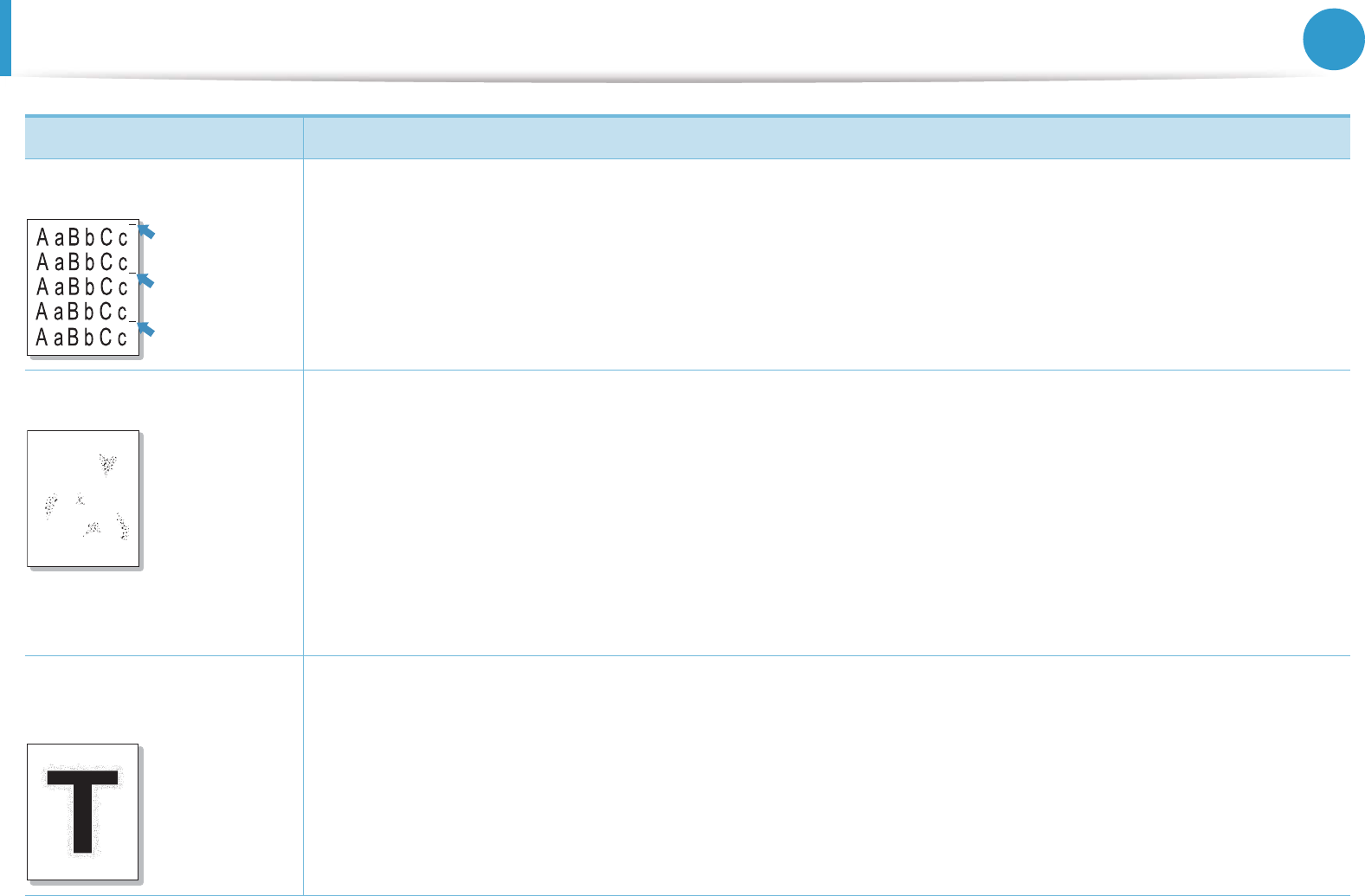
Printing quality problems 152
6. Troubleshooting
Vertical repetitive defects If marks repeatedly appear on the printed side of the page at even intervals:
• The toner cartridge may be damaged. If you still have the same problem, remove the toner cartridge and, install
a new one.
• Parts of the machine may have toner on them. If the defects occur on the back of the page, the problem will
likely correct itself after a few more pages.
• The fusing assembly may be damaged. Contact a service representative.
Background scatter Background scatter results from bits of toner randomly distributed on the printed page.
• The paper may be too damp. Try printing with a different batch of paper. Do not open packages of paper until
necessary so that the paper does not absorb too much moisture.
• If background scatter occurs on an envelope, change the printing layout to avoid printing over areas that have
overlapping seams on the reverse side. Printing on seams can cause problems.
• If background scatter covers the entire surface area of a printed page, adjust the print resolution through your
software application or in Printing Preferences. Ensure the correct paper type is selected. For example: If
Thicker Paper is selected, but Plain Paper actually used, an overcharging can occur causing this copy quality
problem.
Toner particles are around
bold characters or pictures
The toner might not adhere properly to this type of paper.
• Change the printer option and try again. Go to Printing Preferences, click the Paper tab, and set the paper type
to Recycled.
• Ensure the correct paper type is selected. For example: If Thicker Paper is selected, but Plain Paper actually used,
an overcharging can occur causing this copy quality problem.
Condition Suggested solutions
A
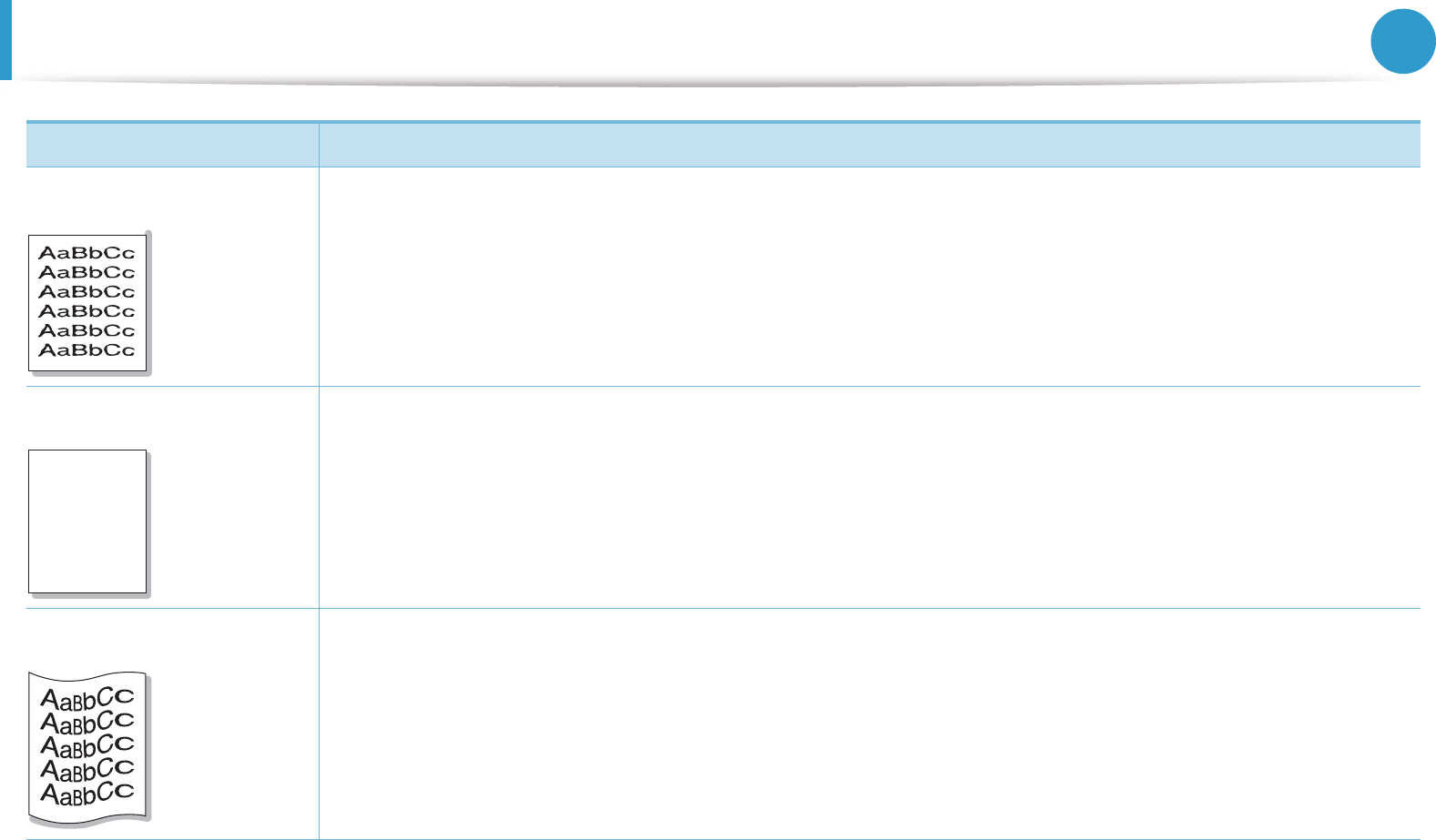
Printing quality problems 153
6. Troubleshooting
Misformed characters • If characters are improperly formed and producing hollow images, the paper stock may be too slick. Try
different paper.
Page skew • Ensure that the paper is loaded properly.
• Check the paper type and quality.
• Ensure that the guides are not too tight or too loose against the paper stack.
Curl or wave • Ensure that the paper is loaded properly.
• Check the paper type and quality. Both high temperature and humidity can cause paper curl.
• Turn the stack of paper over in the tray. Also try rotating the paper 180° in the tray.
Condition Suggested solutions
AaBb
C
AaBb
C
AaBbC
AaBbC
AaBbC
c
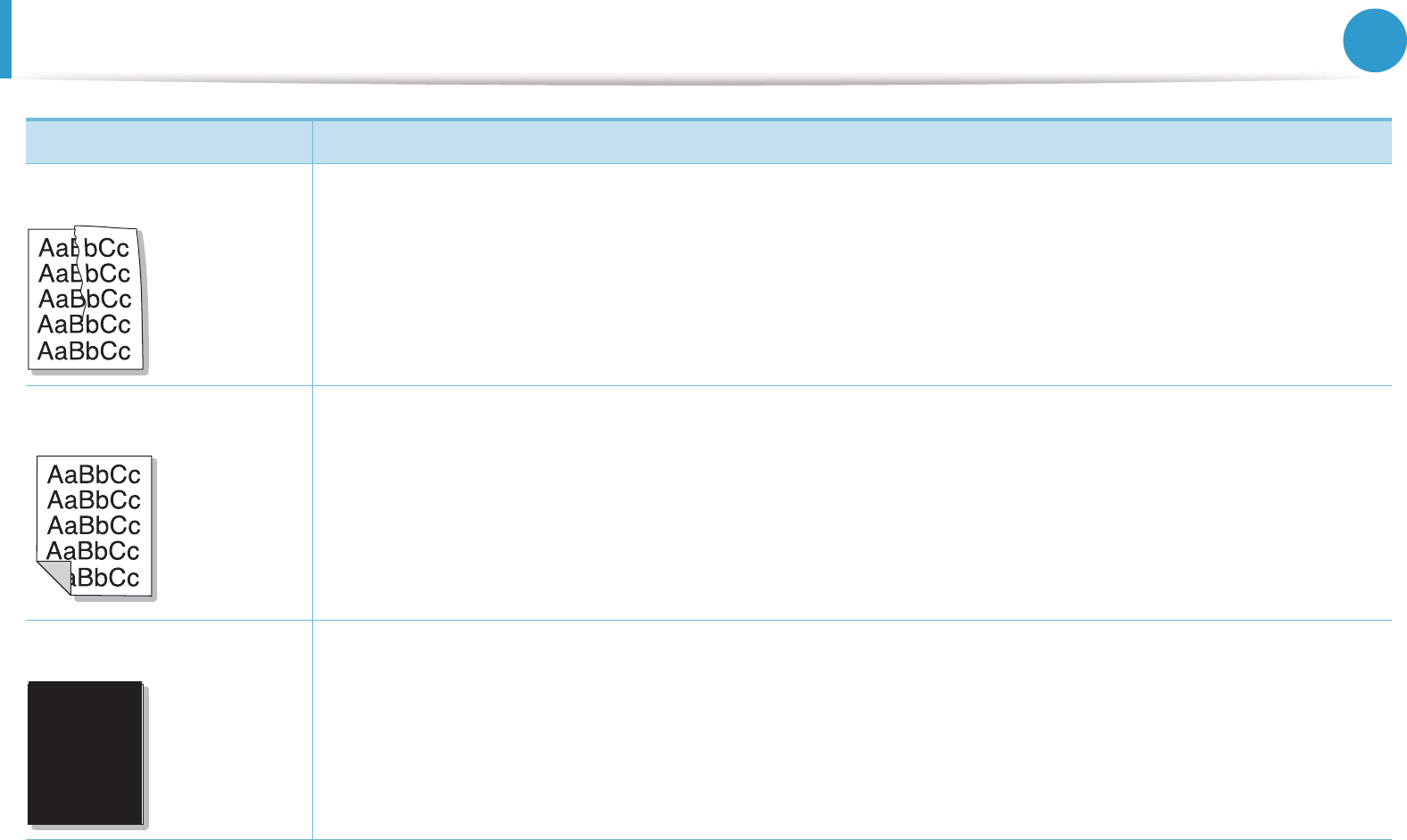
Printing quality problems 154
6. Troubleshooting
Wrinkles or creases • Ensure that the paper is loaded properly.
• Check the paper type and quality.
• Turn the stack of paper over in the tray. Also try rotating the paper 180° in the tray.
Back of printouts are dirty • Check for leaking toner. Clean the inside of the machine.
Solid color or black pages • The toner cartridge may not be installed properly. Remove the cartridge and reinsert it.
• The toner cartridge may be defective. Remove the toner cartridge and install a new one.
• The machine may require repairing. Contact a service representative.
Condition Suggested solutions
A
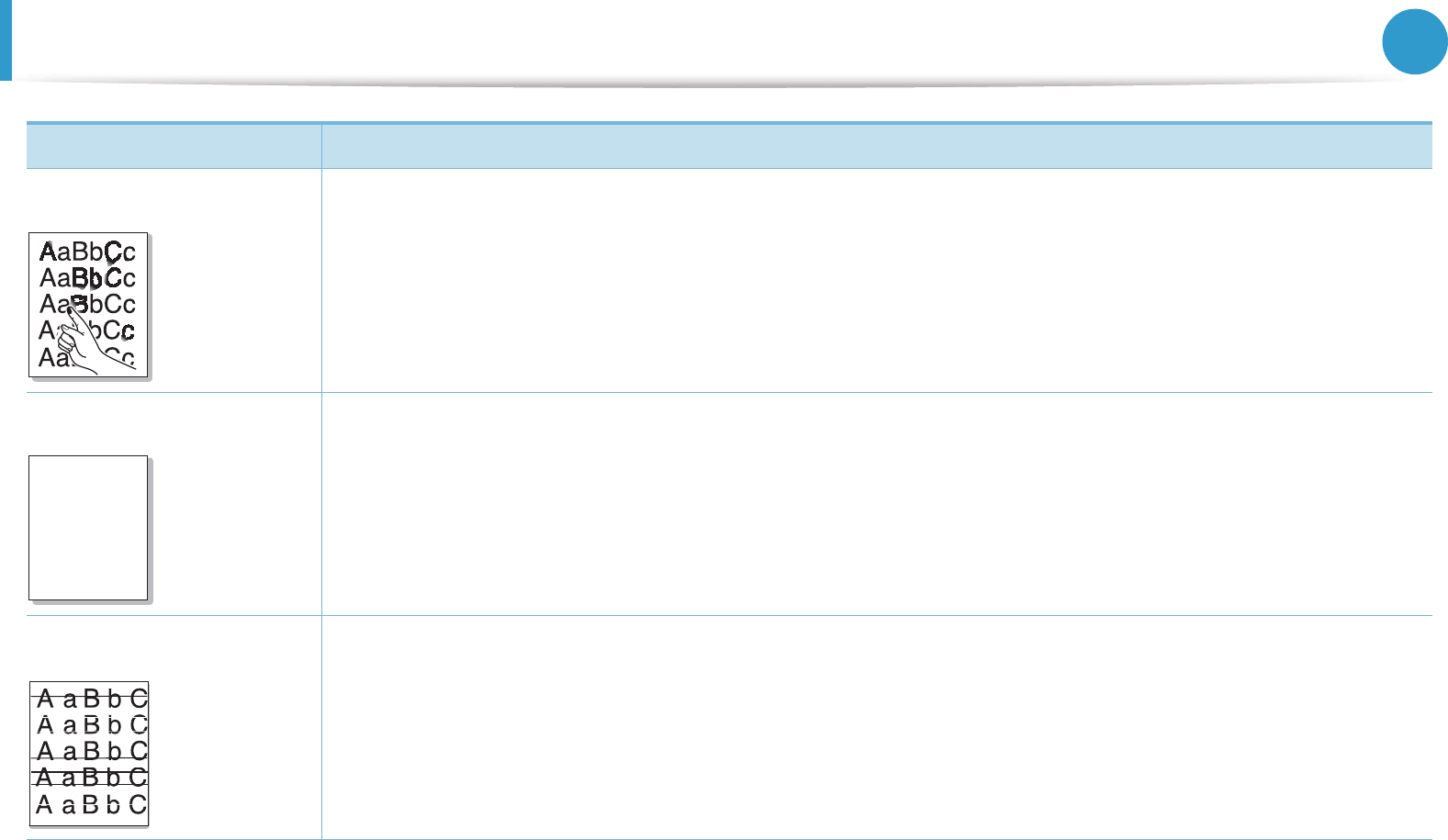
Printing quality problems 155
6. Troubleshooting
Loose toner • Clean the inside of the machine.
• Check the paper type and quality.
• Remove the toner cartridge and then, install a new one.
If the problem persists, the machine may require repair. Contact a service representative.
Character voids Character voids are white areas within parts of characters that should be solid black:
• If you are using transparencies, try another type of transparency. Because of the composition of transparencies,
some character voids are normal.
• You may be printing on the wrong surface of the paper. Remove the paper and turn it around.
• The paper may not meet paper specifications.
Horizontal stripes If horizontally aligned black streaks or smears appear:
• The toner cartridge may be installed improperly. Remove the cartridge and reinsert it.
• The toner cartridge may be defective. Remove the toner cartridge and install a new one.
If the problem persists, the machine may require repairing. Contact a service representative.
Condition Suggested solutions
A
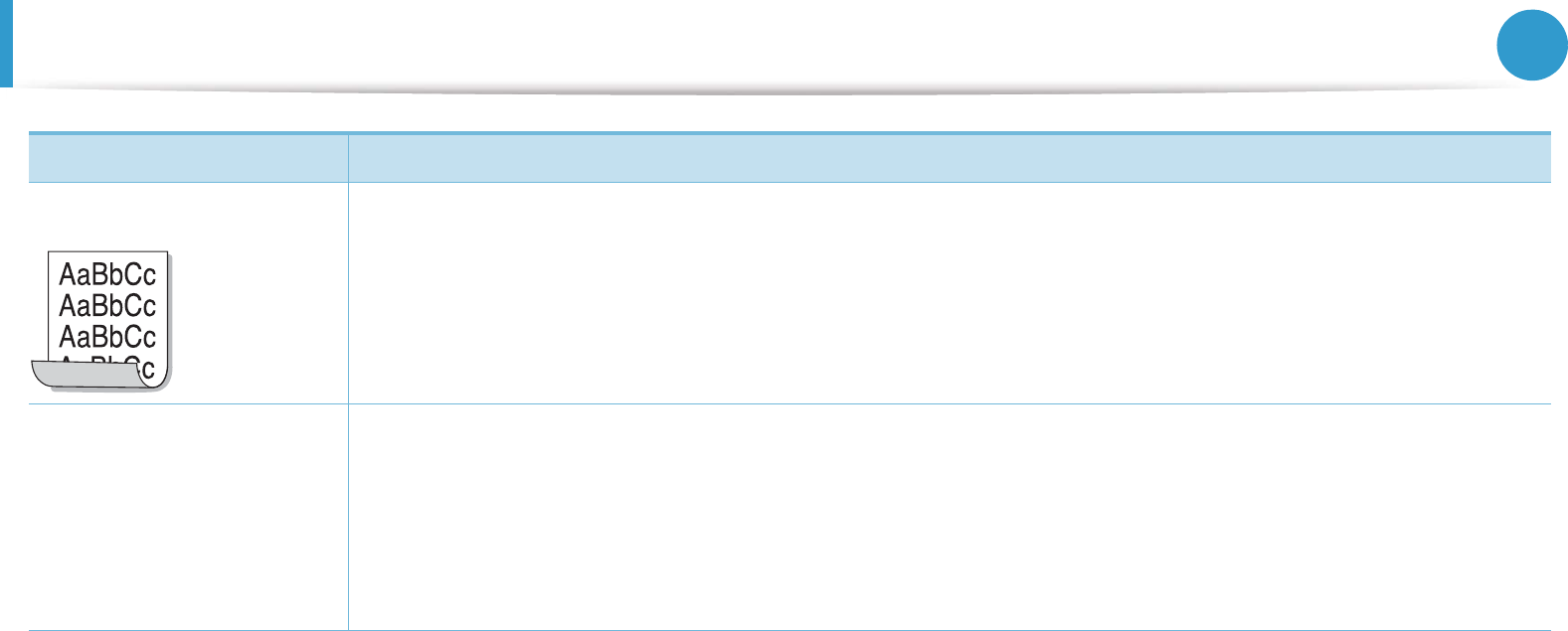
Printing quality problems 156
6. Troubleshooting
Curl If the printed paper is curled or paper does not feed into the machine:
• Turn the stack of paper over in the tray. Also try rotating the paper 180° in the tray.
• Change the printer’s paper option and try again. Go to Printing Preferences, click the Paper tab, and set type
to Thin.
• An unknown image
repetitively appears on a
few sheets
•Loose toner
•Light printGor
contamination occurs
Your machine is probably being used at an altitude of 1,000 m (3,281 ft) or above.
The high altitude may affect the print quality, such as loose toner or light imaging. Change the altitude setting for
your machine (See "Altitude adjustment" on page 85).
Condition Suggested solutions
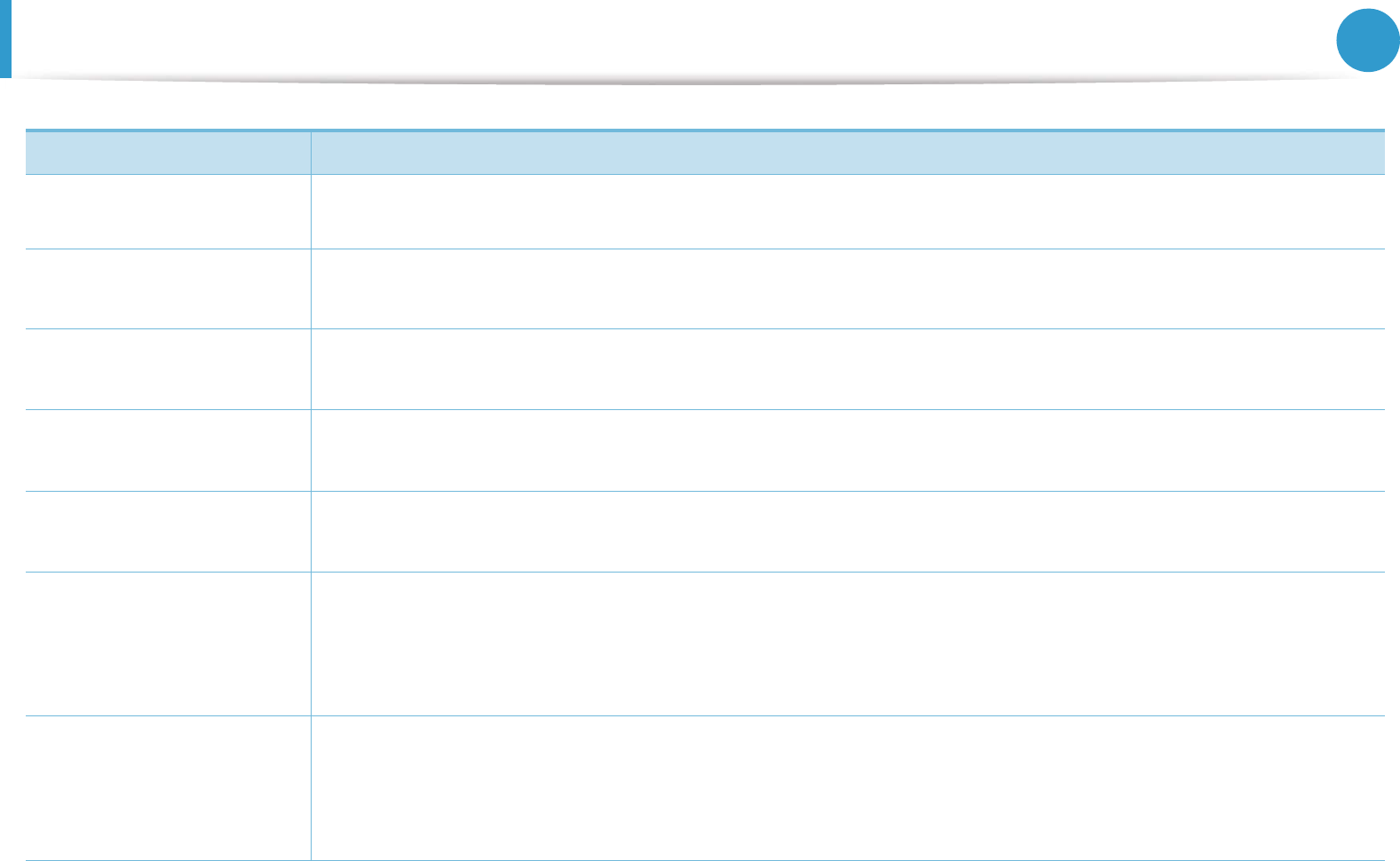
157
6. Troubleshooting
Copying problems
Condition Suggested solutions
Copies are too light or too
dark.
Adjust the darkness in copy feature to lighten or darken the backgrounds of copies.
Smears, lines, marks, or
spots appear on copies.
• If the defects are on the original, adjust darkness in copy feature to lighten the background of your copies.
• If there are no defects on the original, clean the scan unit.
Copy image is skewed. • Ensure that the original is aligned with the registration guide .
• The transfer roller may be dirty. Clean the inside of your machine.
Blank copies print out. Ensure that the original is face down on the scanner glass or face up in the document feeder.
If these steps do not correct the problem, contact a service representative.
Image rubs off the copy
easily.
• Replace the paper in the tray with paper from a new package.
• In high humidity areas, do not leave paper in the machine for extended periods of time.
Frequent copy paper jams
occur.
• Fan the paper, then turn it over in the tray. Replace the paper in the tray with a fresh supply. Check/adjust the
paper guides, if necessary.
• Ensure that the paper is the proper type and weight.
• Check for copy paper or pieces of copy paper remaining in the machine after a paper jam has been cleared.
Toner cartridge produces
fewer copies than
expected before running
out of toner.
• Your originals may contain pictures, solids, or heavy lines. For example, your originals may be forms,
newsletters, books, or other documents that use more toner.
• The scanner lid may be left open while copies are being made.
• Turn the machine off and back on.
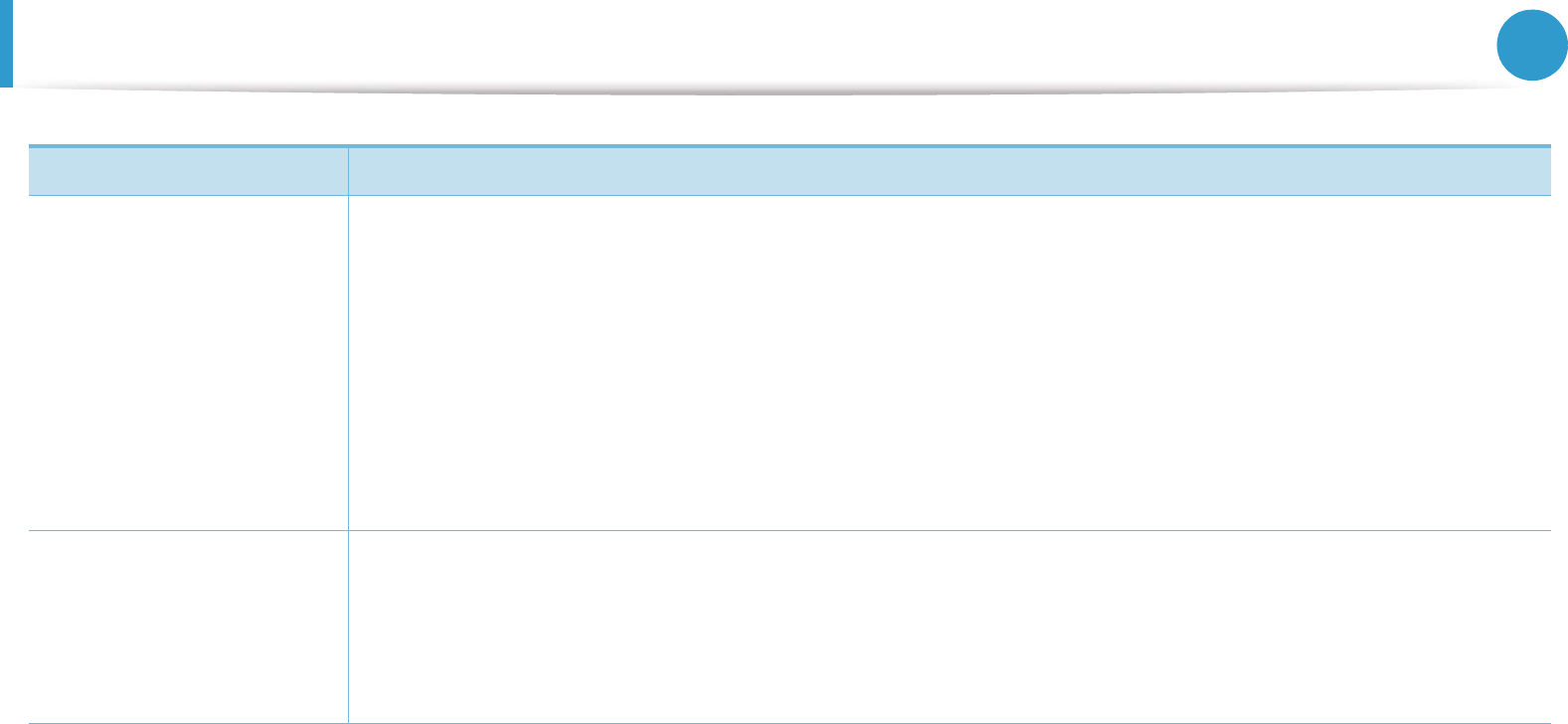
158
6. Troubleshooting
Scanning problems
Condition Suggested solutions
The scanner does not
work.
• Make sure that you place the original to be scanned face down on the scanner glass, or face up in the document
feeder.
• There may not be enough available memory to hold the document you want to scan. Try the Prescan function
to see if that works. Try lowering the scan resolution rate.
• Check that the machine printer cable is connected properly.
• Make sure that the machine printer cable is not defective. Switch the printer cable with a known good cable. If
necessary, replace the printer cable.
• Check that the scanner is configured correctly. Check scan setting in the SmarThru Office or the application you
want to use to make certain that the scanner job is being sent to the correct port (for example, USB001).
The unit scans very slowly. • Check if the machine is printing received data. If so, scan the document after the received data has been printed.
• Graphics are scanned more slowly than text.
• Communication speed slows in scan mode because of the large amount of memory required to analyze and
reproduce the scanned image. Set your computer to the ECP printer mode through BIOS setting. It will help to
increase the speed. For details about how to set BIOS, refer to your computer user’s guide.
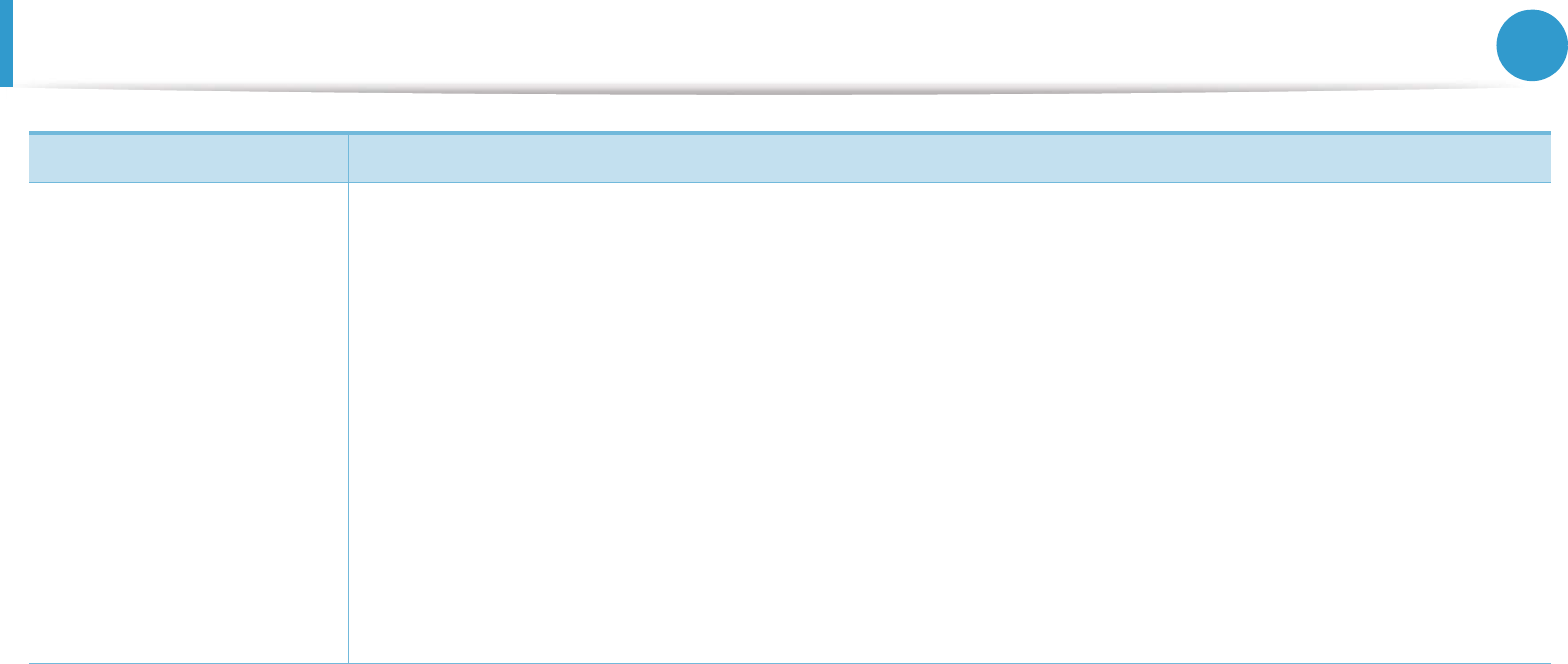
Scanning problems 159
6. Troubleshooting
Message appears on your
computer screen:
• Device can’t be set to the
H/W mode you want.
• Port is being used by
another program.
•Port is disabled.
• Scanner is busy receiving
or printing data. When the
current job is completed,
try again.
• Invalid handle.
• Scanning has failed.
• There may be a copying or printing job in progress. Try your job again when that job is finished.
• The selected port is currently being used. Restart your computer and try again.
• The machine printer cable may be improperly connected or the power may be off.
• The scanner driver is not installed or the operating environment is not set up properly.
• Ensure that the machine is properly connected and the power is on, then restart your computer.
• The USB cable may be improperly connected or the power may be off.
Condition Suggested solutions
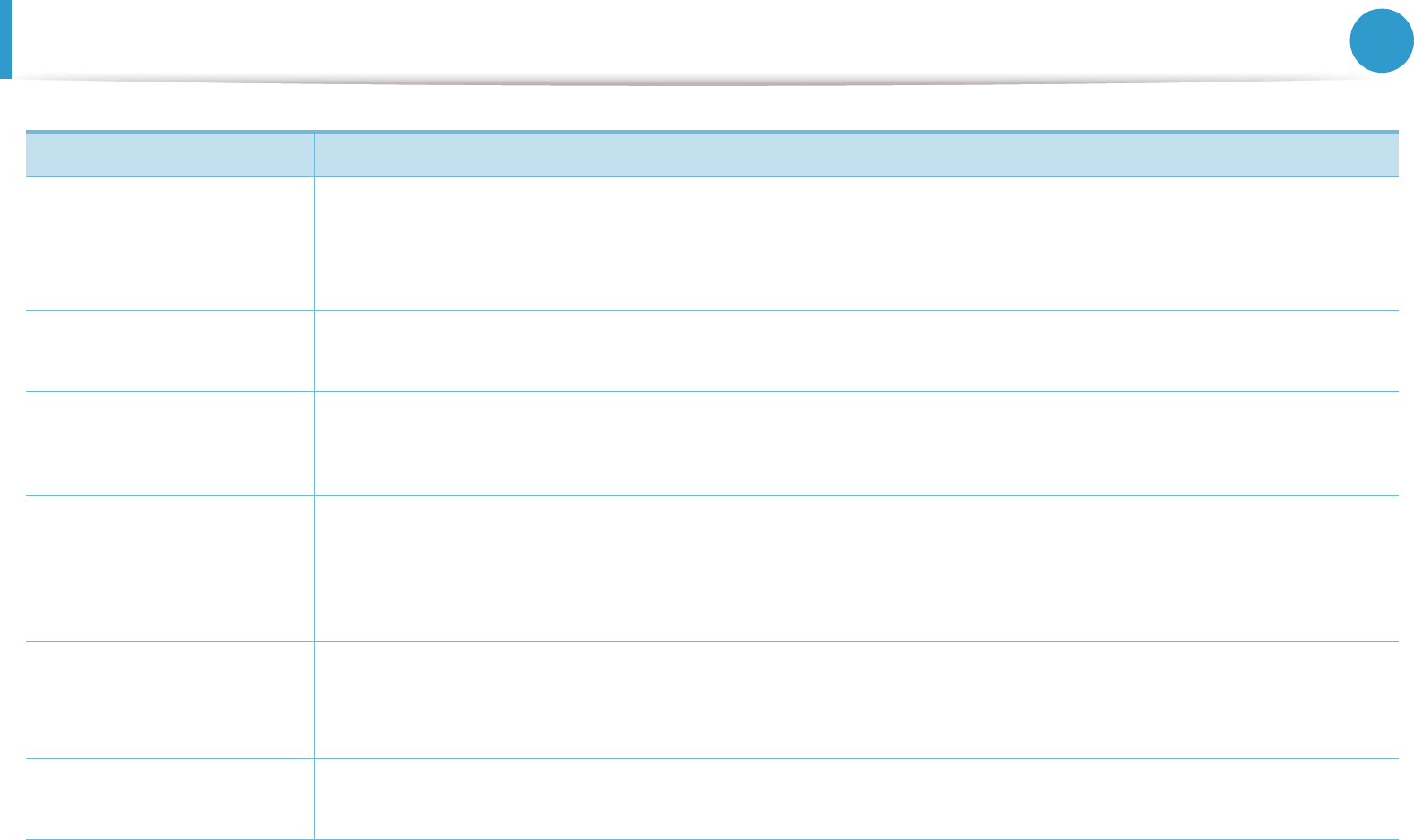
160
6. Troubleshooting
Faxing problems
Condition Suggested solutions
The machine is not
working, there is no
display, or the buttons are
not working.
• Unplug the power cord and plug it in again.
• Ensure that there is power being supplied to the electrical outlet.
• Ensure that the power switch is turned on, and the soft power switch on the control panel is pressed.
No dial tone. • Check that the phone line is properly connected.
• Check that the phone socket on the wall is working by plugging in another phone.
The numbers stored in
memory do not dial
correctly.
Make sure that the numbers are stored in memory correctly. To check that, print an addess book list.
The original does not feed
into the machine.
• Make sure that the paper is not wrinkled and you are inserting it in correctly. Check that the original is the right
size, not too thick or thin.
• Make sure that the document feeder is firmly closed.
• The document feeder rubber pad may need to be replaced. Contact a service representative.
Faxes are not received
automatically.
• The receiving mode should be set to fax.
• Make sure that there is paper in the tray.
• Check to see if the display shows any error message. If it does, clear the problem.
The machine does not
send.
• Make sure that the original is loaded in the document feeder or on the scanner glass.
• Check the fax machine you are sending to, to see if it can receive your fax.
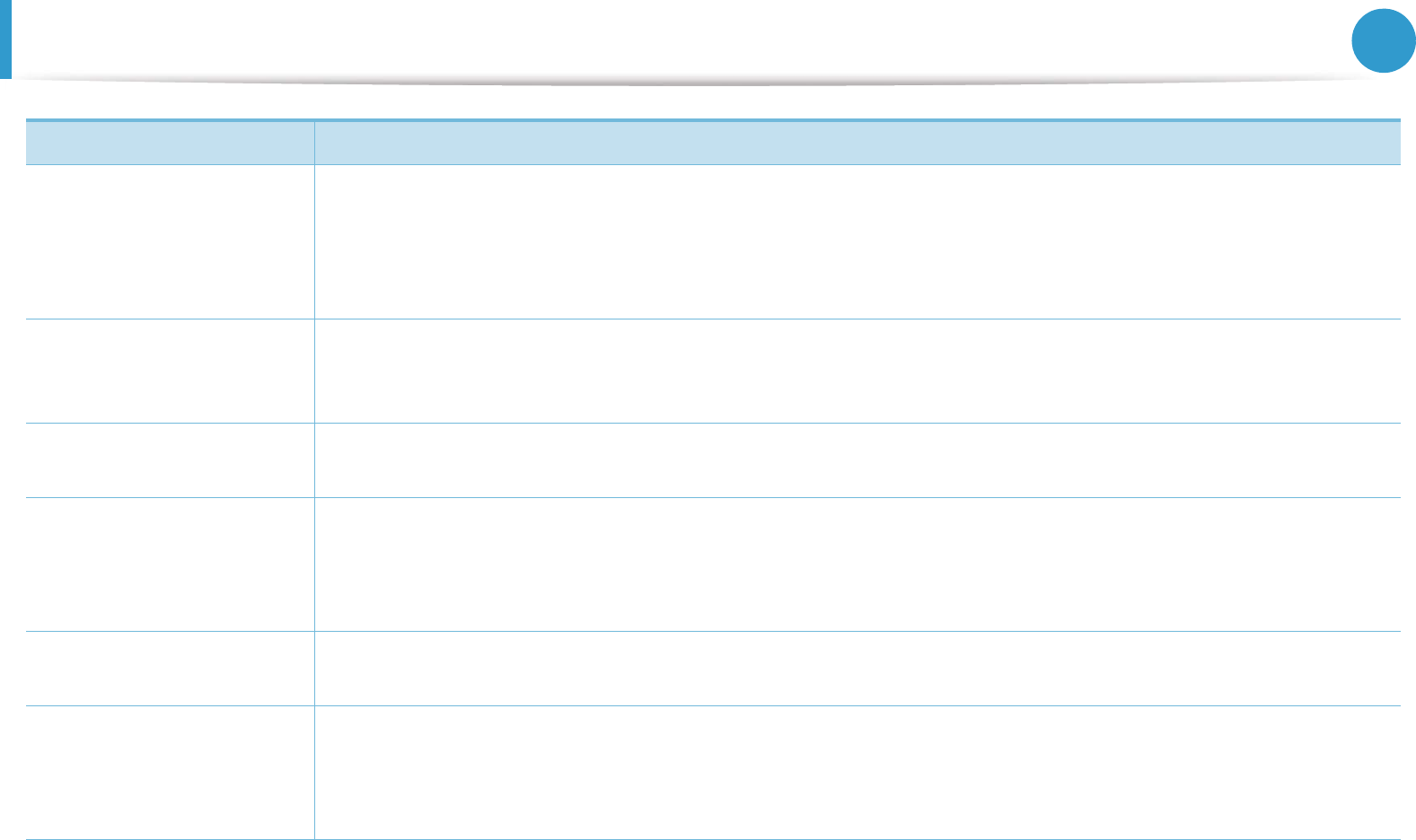
Faxing problems 161
6. Troubleshooting
The incoming fax has
blank spaces or is of poor-
quality.
• The fax machine sending you the fax may be faulty.
• A noisy phone line can cause line errors.
• Check your machine by making a copy.
• A toner cartridge has almost reached its estimated cartridge life. Replace the toner cartridge.
Some of the words on an
incoming fax are
stretched.
The fax machine sending the fax had a temporary document jam.
There are lines on the
originals you sent.
Check your scan unit for marks and clean it.
The machine dials a
number, but the
connection with the other
fax machine fails.
The other fax machine may be turned off, out of paper, or cannot answer incoming calls. Speak with the other
machine operator and ask them to solve the problem on their side.
Faxes do not store in
memory.
There may not be enough memory space to store the fax. If the display indicating the memory status shows, delete
any faxes you no longer need from the memory, and then try to store the fax again. Call for service.
Blank areas appear at the
bottom of each page or on
other pages, with a small
strip of text at the top.
You may have chosen the wrong paper settings in the user option setting. Check the paper size and type again.
Condition Suggested solutions
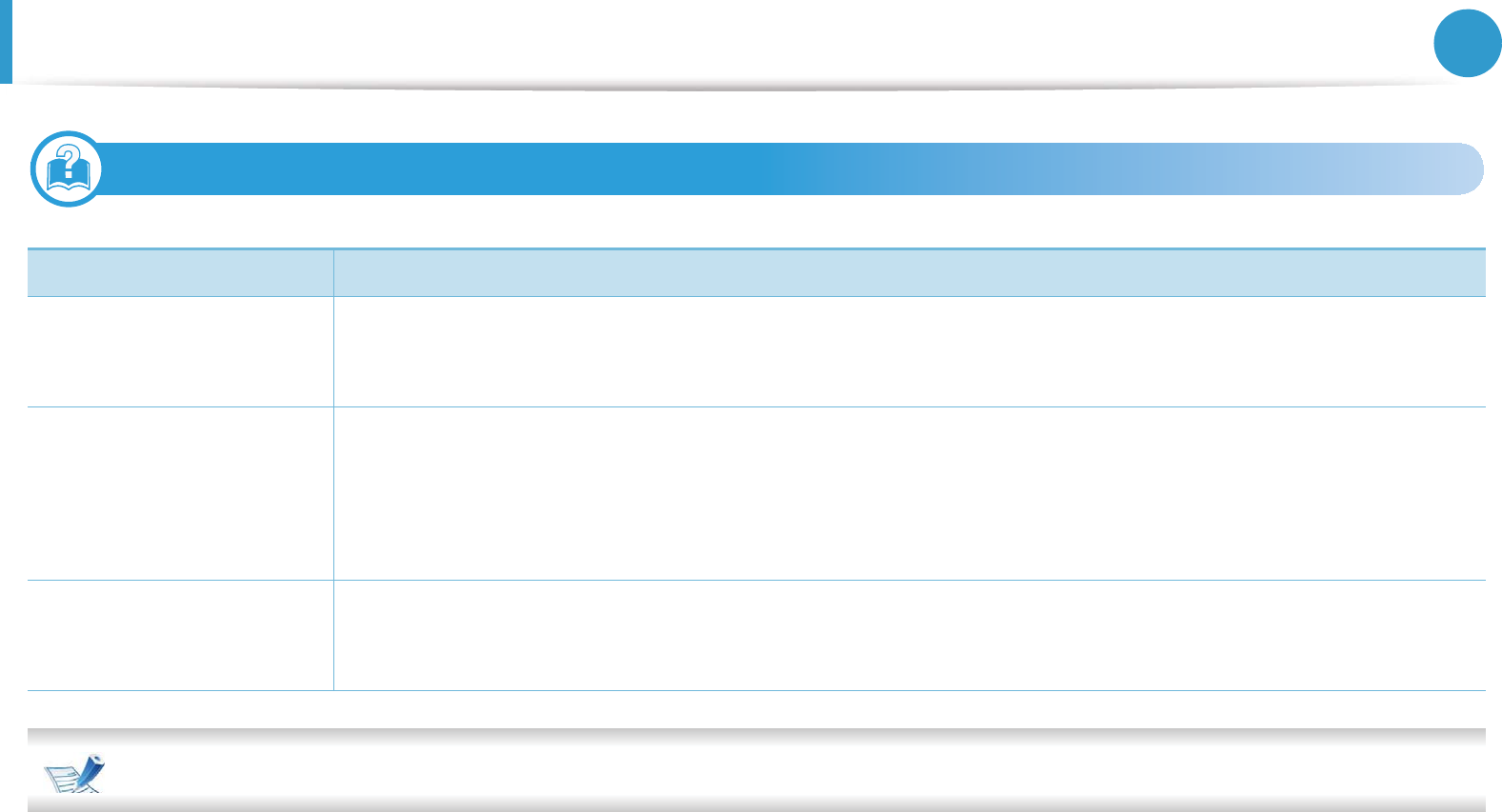
162
6. Troubleshooting
Operating system problems
1
Common Windows problems
Refer to the Microsoft Windows User’s Guide that came with your computer for further information on Windows error messages.
Condition Suggested solutions
“File in Use” message
appears during
installation.
Exit all software applications. Remove all software from the startup group, then restart Windows. Reinstall the
printer driver.
“General Protection
Fault”, “Exception OE”,
“Spool 32”, or “Illegal
Operation” messages
appear.
Close all other applications, reboot Windows and try printing again.
“Fail To Print”, “A printer
timeout error occurred”
message appear.
These messages may appear during printing. Just keep waiting until the machine finishes printing. If the message
appears in ready mode or after printing has completed, check the connection and/or whether an error has
occurred.
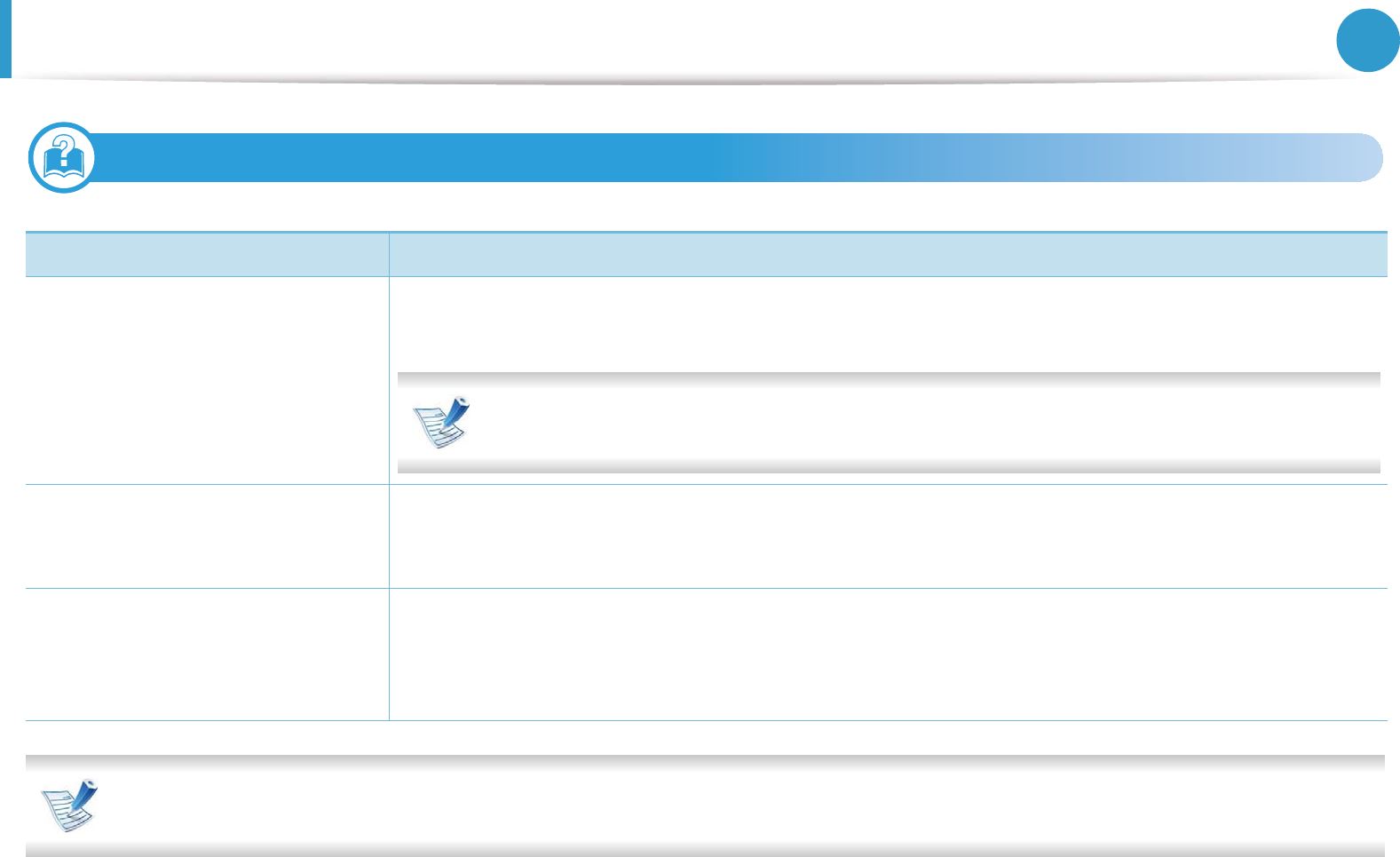
Operating system problems 163
6. Troubleshooting
2
Common Macintosh problems
Refer to the Macintosh User’s Guide that came with your computer for further information on Macintosh error messages.
Condition Suggested solutions
The machine does not print PDF
files correctly. Some parts of
graphics, text, or illustrations are
missing.
Printing the PDF file as an image may enable the file to print. Turn on Print As Image from the Acrobat
printing options.
It will take longer to print when you print a PDF file as an image.
Some letters are not displayed
normally during cover page
printing.
Mac OS cannot create the font while printing the cover page. The English alphabet and numbers are
displayed normally on the cover page.
When printing a document in
Macintosh with Acrobat
Reader 6.0 or higher, colors print
incorrectly.
Make sure that the resolution setting in your machine driver matches the one in Acrobat Reader.
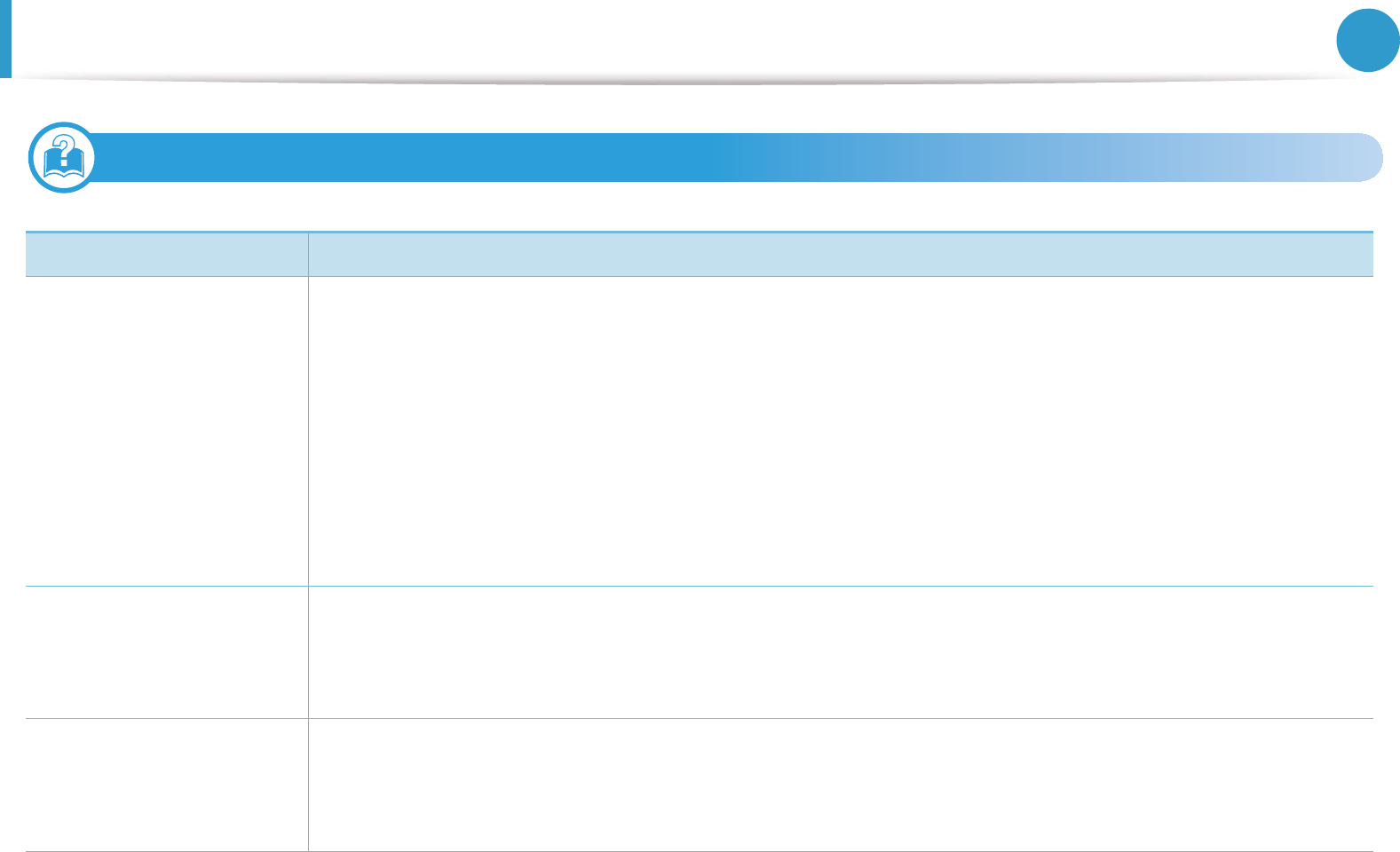
Operating system problems 164
6. Troubleshooting
3
Common Linux problems
Condition Suggested solutions
The machine does not
print.
• Check if the printer driver is installed in your system. Open Unified Driver Configurator and switch to the
Printers tab in the Printers configuration window to look at the list of available machines. Make sure that
your machine is displayed on the list. If not, open Add new printer wizard to set up your device.
• Check if the machine is started. Open Printers configuration and select your machine from the printers list.
Look at the description in the Selected printer pane. If its status contains Stopped, press the Start button.
Normal operation of the machine should be restored. The “stopped” status might be activated when some
problems in printing occur.
• Check if your application has special print options such as “-oraw”. If “-oraw” is specified in the command line
parameter, then remove it to print properly. For Gimp front-end, select “print” -> “Setup printer” and edit the
command line parameter in the command item.
Some color images come
out all black.
This is a known bug in Ghostscript (until GNU Ghostscript version 7.05) when the base color space of the
document is indexed color space and it is converted through CIE color space. Because Postscript uses CIE color
space for Color Matching System, you should upgrade Ghostscript on your system to at least GNU Ghostscript
version 7.06 or later. You can find recent Ghostscript versions at www.ghostscript.com.
Some color images come
out in unexpected color.
This is a known bug in Ghostscript (until GNU Ghostscript version 7.xx) when the base color space of the
document is indexed RGB color space and it is converted through CIE color space. Because Postscript uses CIE
color space for Color Matching System, you should upgrade Ghostscript on your system to at least GNU
Ghostscript version 8.xx or later. You can find recent Ghostscript versions at www.ghostscript.com.
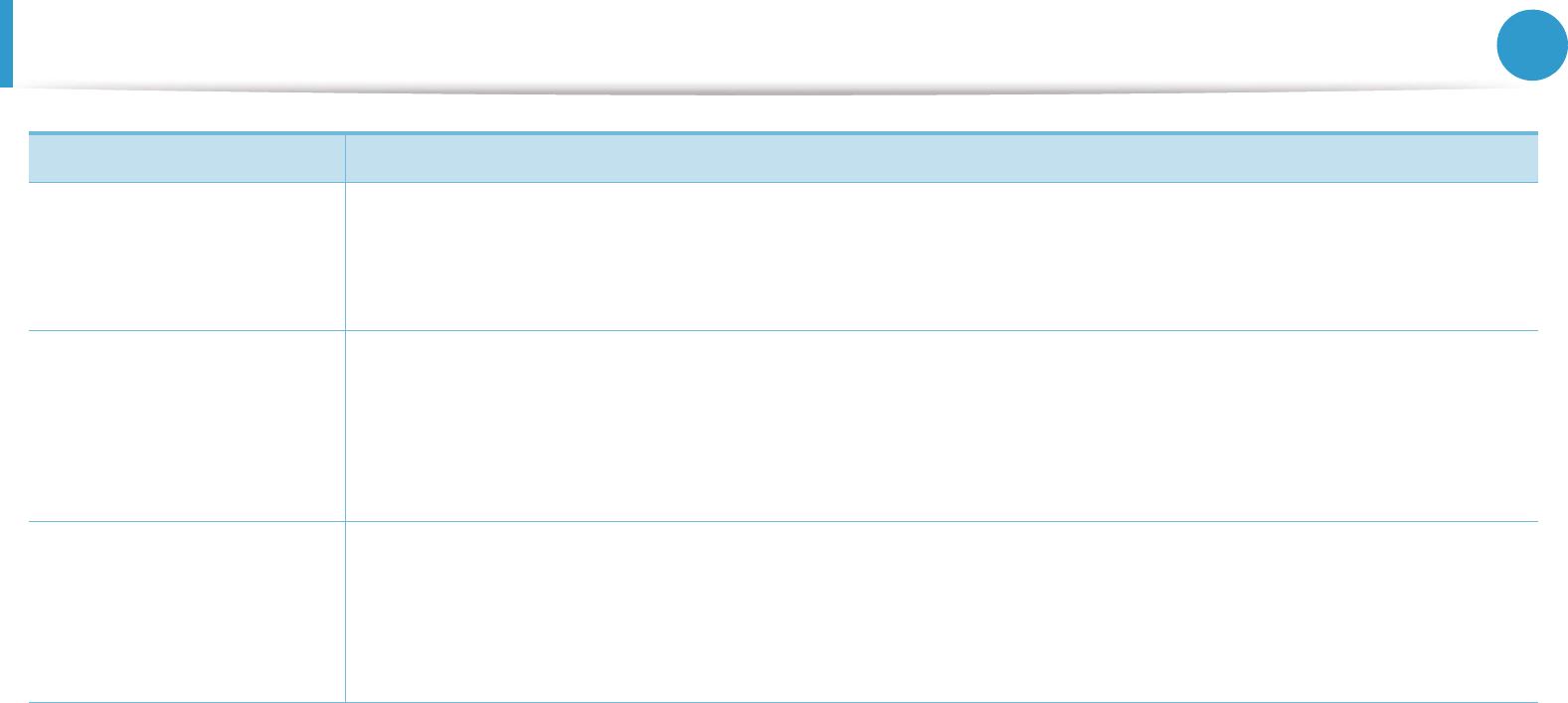
Operating system problems 165
6. Troubleshooting
The machine does not
print whole pages, and
output is printed on half
the page.
It is a known problem that occurs when a color machine is used on version 8.51 or earlier of Ghostscript, 64-bit
Linux OS, and has been reported to bugs.ghostscript.com as Ghostscript Bug 688252.The problem is solved in
AFPL Ghostscript v. 8.52 or above. Download the latest version of AFPL Ghostscript from http://sourceforge.net/
projects/ghostscript/ and install it to solve this problem.
I cannot scan via Gimp
Front-end.
Check if Gimp Front-end has Xsane:Device dialog. on the Acquire menu. If not, you should install Xsane plug-in
for Gimp on the your computer. You can find Xsane plug-in package for Gimp on Linux distribution CD or Gimp
home page. For the detailed information, refer to the Help for Linux distribution CD or Gimp Front-end
application.
If you wish to use another kind of scan application, refer to application’s Help.
“Cannot open port device
file” error message
appears when printing a
document.
Avoid changing print job parameters (e.q., via LPR GUI) while a print job is in progress. Known versions of CUPS
server break the print job whenever print options are changed and then try to restart the job from the beginning.
Since Unified Linux Driver locks the port while printing, the abrupt termination of the driver keeps the port locked
and unavailable for subsequent print jobs. If this situation occurs, try to release the port by selecting Release port
in the Port configuration window.
Condition Suggested solutions
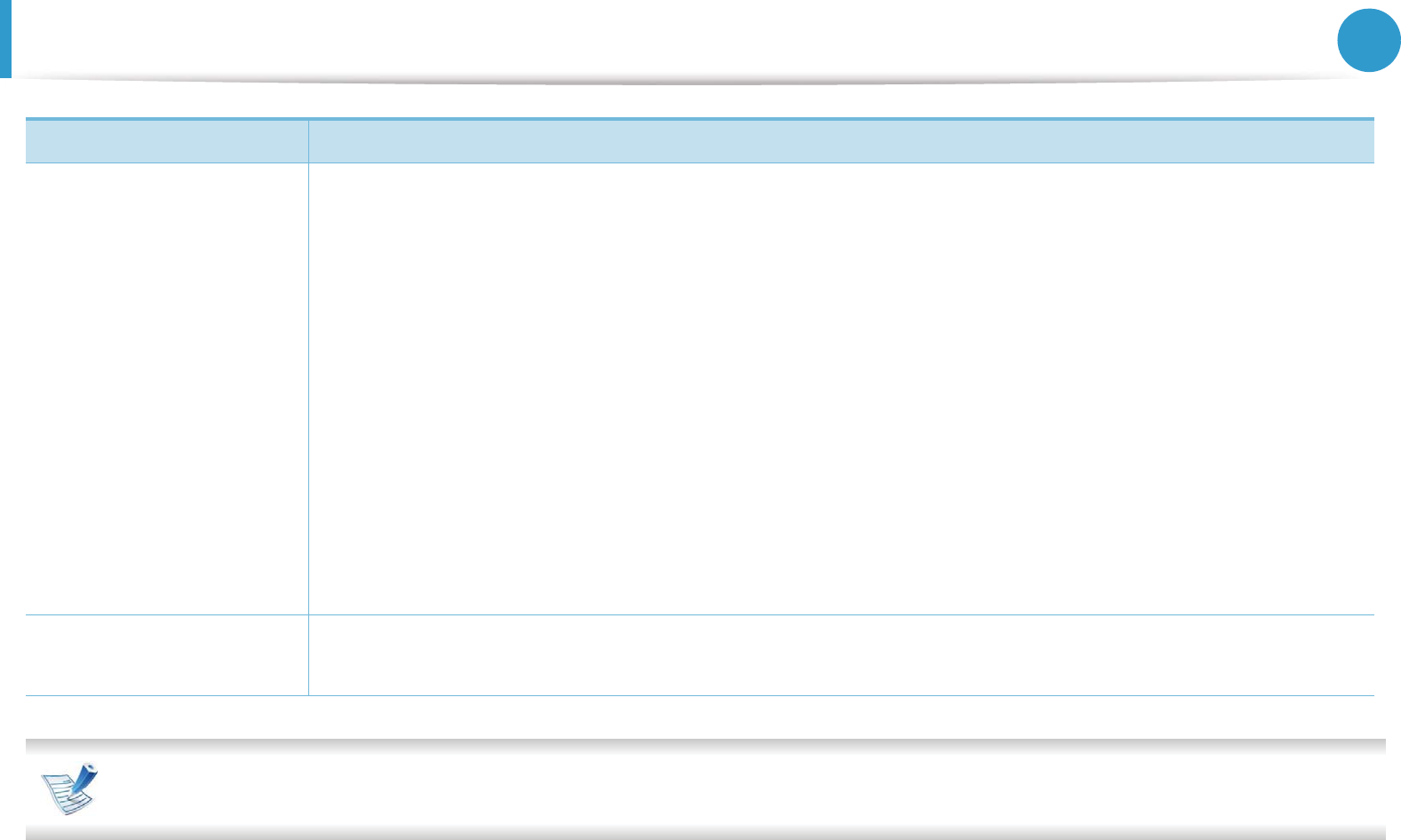
Operating system problems 166
6. Troubleshooting
Refer to the Linux User’s Guide that came with your computer for further information on Linux error messages.
The machine does not
appear on the scanners
list.
• Ensure your machine is attached to your computer, connected properly via the USB port, and is turned on.
• Ensure the scanner driver for your machine is installed in your system. Open Unified Linux Driver configurator,
switch to Scanners configuration, then press Drivers. Make sure that driver with a name corresponding to your
machine's name is listed in the window.
• Ensure the port is not busy. Since functional components of machine (printer and scanner) share the same I/O
interface (port), the situation of simultaneous access of different user applications to the same port is possible.
To avoid possible conflicts, only one of them at a time is allowed to gain control over the device. The other user
will encounter “device busy” response. This usually happens when starting a scan procedure. An appropriate
message box appears.
To identify the source of the problem, open the Ports configuration and select the port assigned to your
scanner, port's symbol /dev/mfp0 corresponds to LP:0 designation displayed in the scanners’ options, /dev/
mfp1 relates to LP:1, and so on. USB ports start at /dev/mfp4, so scanner on USB:0 relates to /dev/mfp4
respectively and so forth sequentially. In the Selected port pane, you can see if the port is occupied by another
application. If this is the case, you should either wait for completion of the current job or press the Release port
button, if you are sure that the present port applicaton is not functioning properly.
The machine does not
scan.
• Ensure a document is loaded into the machine, ensure your machine is connected to the computer.
• If there is an I/O error while scanning.
Condition Suggested solutions
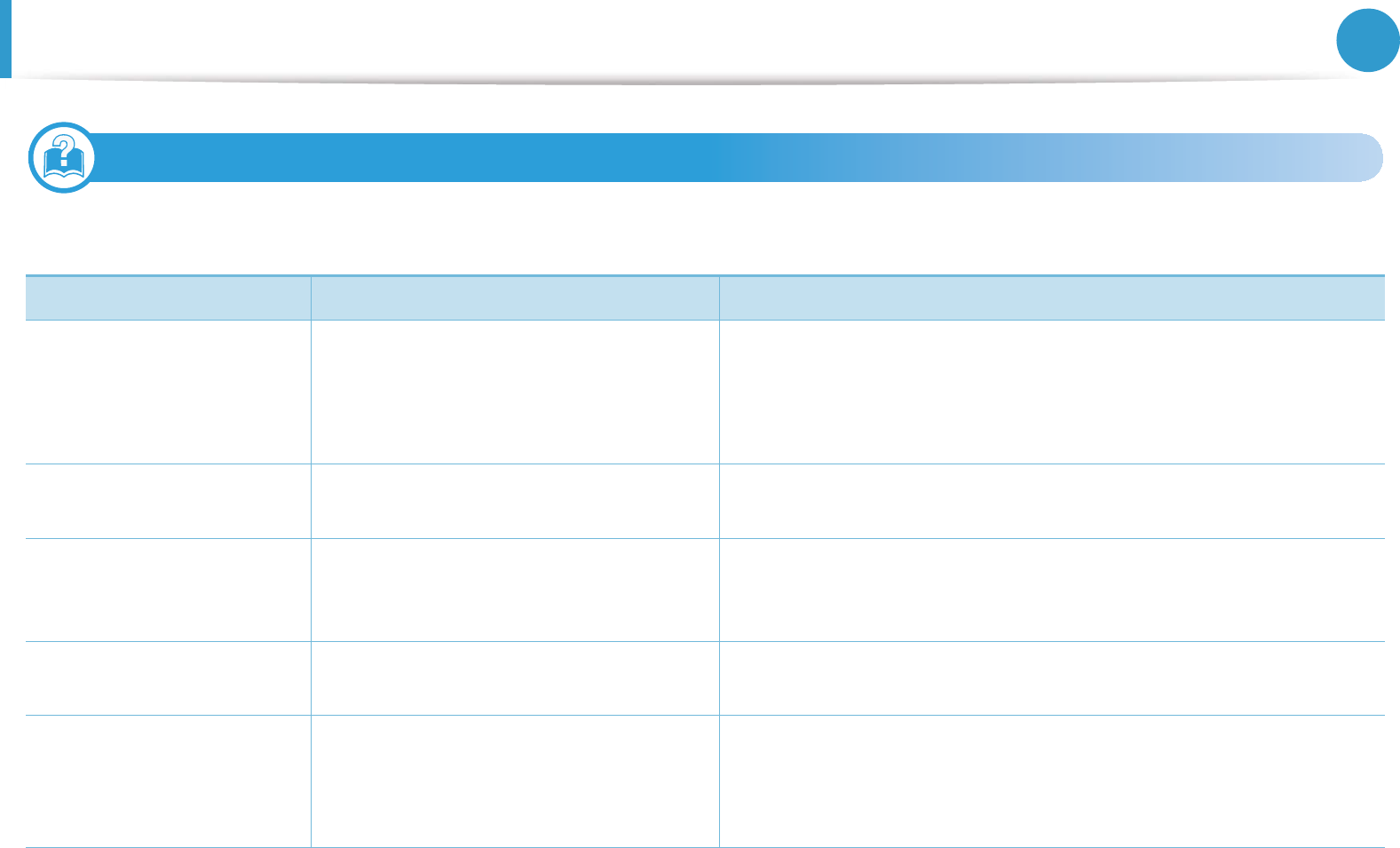
Operating system problems 167
6. Troubleshooting
4
Common PostScript problems
The following situations are PS language specific and may occur when several printer languages are used.
Problem Possible cause Solution
The PostScript file cannot
be printed
The PostScript driver may not be installed
correctly.
• Install the PostScript driver (see "Software installation" on page 4).
• Print a configuration page and verify that the PS version is available
for printing.
• If the problem persists, contact a service representative.
Limit Check Error report
prints
The print job was too complex. You might need to reduce the complexity of the page or install more
memory.
A PostScript error page
prints
The print job may not be PostScript. Make sure that the print job is a PostScript job. Check to see whether
the software application expected a setup or PostScript header file to
be sent to the machine.
The optional tray is not
selected in the driver
The printer driver has not been
configured to recognize the optional tray.
Open the PostScript driver properties, select the Device Options tab,
and set the tray option.
When printing a document
in Macintosh with Acrobat
Reader 6.0 or higher,
colors print incorrectly
The resolution setting in the printer driver
may not be matched with the one in
Acrobat Reader.
Make sure that the resolution setting in your printer driver matches
the one in Acrobat Reader.
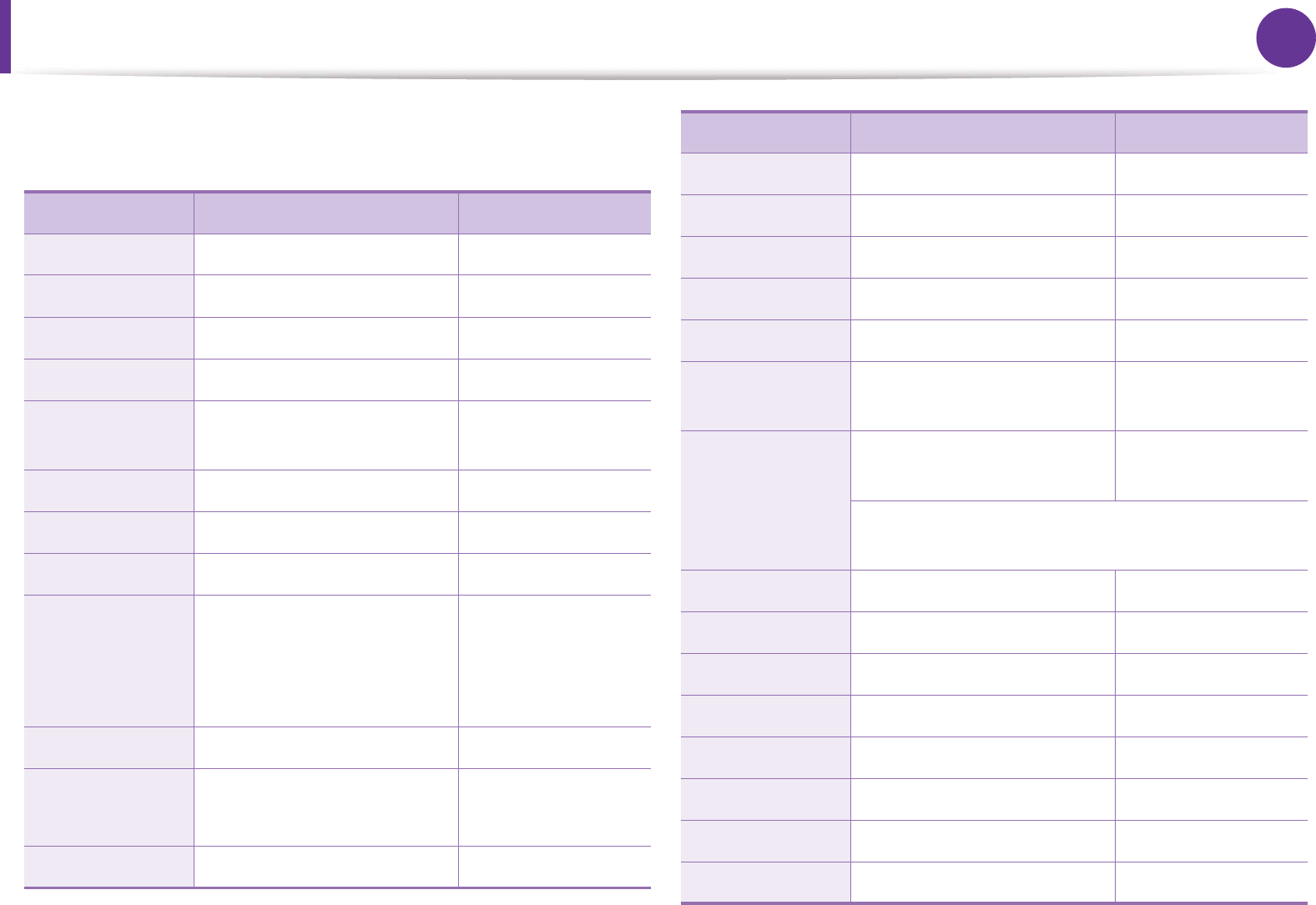
168
Contact SAMSUNG worldwide
If you have any comments or questions regarding Samsung
products, contact the Samsung customer care center.
Country/Region Customer Care Center Web Site
ALBANIA 42 27 5755
ARGENTINE 0800-333-3733 www.samsung.com
ARMENIA 0-800-05-555
AUSTRALIA 1300 362 603 www.samsung.com
AUSTRIA 0810-SAMSUNG (7267864, €
0.07/min)
www.samsung.com
AZERBAIJAN 088-55-55-555
BAHRAIN 8000-4726 www.samsung.com
BELARUS 810-800-500-55-500
BELGIUM
02-201-24-18 www.samsung.com
/be (Dutch)
www.samsung.com
/be_fr (French)
BOSNIA 05 133 1999
BRAZIL 0800-124-421
4004-0000
www.samsung.com
BULGARIA 07001 33 11 www.samsung.com
CANADA 1-800-SAMSUNG (726-7864) www.samsung.com
CHILE 800-SAMSUNG (726-7864) www.samsung.com
CHINA 400-810-5858 www.samsung.com
COLOMBIA 01-8000112112 www.samsung.com
COSTA RICA 0-800-507-7267 www.samsung.com
CROATIA 062 SAMSUNG (062 726
7864)
www.samsung.com
CZECH
REPUBLIC
800-SAMSUNG (800-
726786)
www.samsung.com
Samsung Zrt., česká organizační složka, Oasis
Florenc, Sokolovská394/17, 180 00, Praha 8
DENMARK 70 70 19 70 www.samsung.com
DOMINICA 1-800-751-2676 www.samsung.com
ECUADOR 1-800-10-7267 www.samsung.com
EGYPT 0800-726786 www.samsung.com
EIRE 0818 717100 www.samsung.com
EL SALVADOR 800-6225 www.samsung.com
ESTONIA 800-7267 www.samsung.com
FINLAND 030-6227 515 www.samsung.com
Country/Region Customer Care Center Web Site
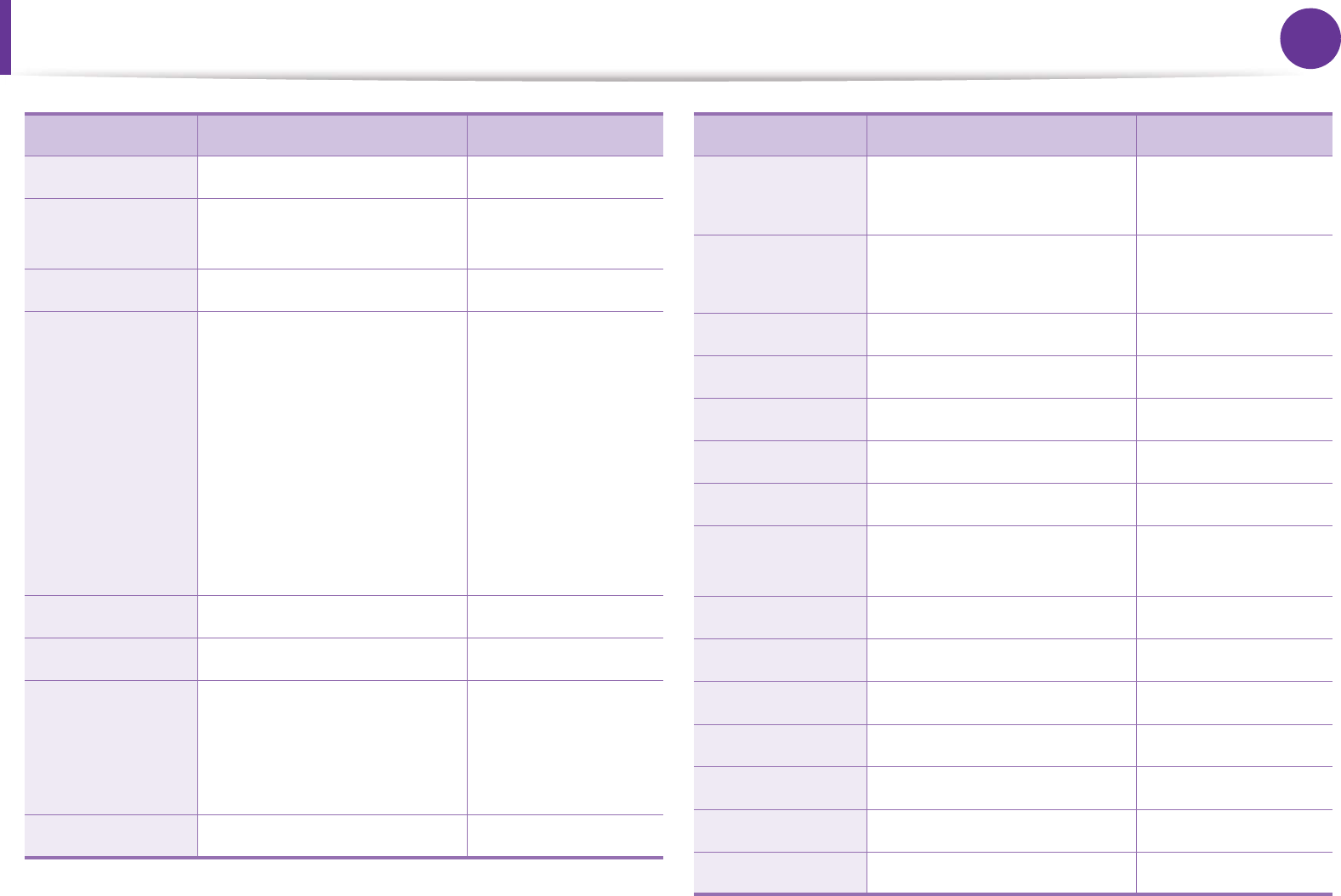
Contact SAMSUNG worldwide 169
FRANCE 01 48 63 00 00 www.samsung.com
GERMANY 01805 - SAMSUNG (726-
7864 € 0,14/min)
www.samsung.com
GEORGIA 8-800-555-555
GREECE
IT and Mobile : 80111-
SAMSUNG (80111 7267864)
from land line, local charge/
from mobile, 210 6897691
Cameras, Camcorders,
Televisions and Household
Appliances
From mobile and fixed
2106293100
www.samsung.com
GUATEMALA 1-800-299-0013 www.samsung.com
HONDURAS 800-27919267 www.samsung.com
HONG KONG
(852) 3698-4698 www.samsung.com
/hk
www.samsung.com
/hk_en/
HUNGARY 06-80-SAMSUNG (726-7864) www.samsung.com
Country/Region Customer Care Center Web Site
INDIA 3030 8282
1800 3000 8282
www.samsung.com
INDONESIA 0800-112-8888
021-5699-7777
www.samsung.com
IRAN 021-8255 www.samsung.com
ITALY 800-SAMSUNG (726-7864) www.samsung.com
JAMAICA 1-800-234-7267 www.samsung.com
JAPAN 0120-327-527 www.samsung.com
JORDAN 800-22273 www.samsung.com
KAZAKHSTAN 8-10-800-500-55-500
(GSM:7799)
www.samsung.com
KOSOVO +381 0113216899
KUWAIT 183-2255 www.samsung.com
KYRGYZSTAN 00-800-500-55-500 www.samsung.com
LATVIA 8000-7267 www.samsung.com
LITHUANIA 8-800-77777 www.samsung.com
LUXEMBURG 261 03 710 www.samsung.com
MALAYSIA 1800-88-9999 www.samsung.com
Country/Region Customer Care Center Web Site
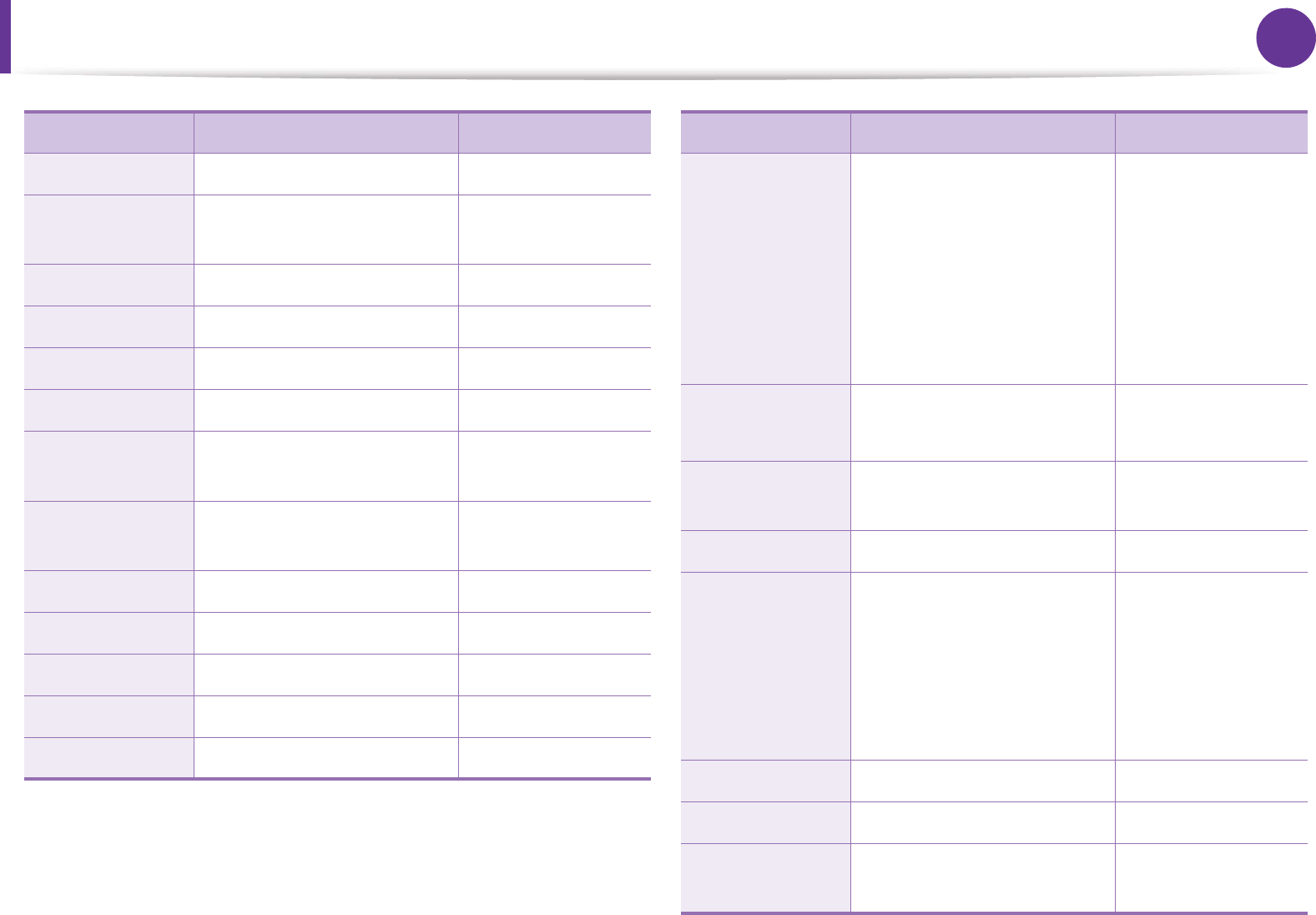
Contact SAMSUNG worldwide 170
MACEDONIA 023 207 777
MEXICO 01-800-SAMSUNG (726-
7864)
www.samsung.com
MOLDOVA 00-800-500-55-500
MONTENEGRO 020 405 888
MOROCCO 080 100 2255 www.samsung.com
NIGERIA 080-SAMSUNG(726-7864) www.samsung.com
NETHERLANDS 0900-SAMSUNG (0900-
7267864) (€ 0,10/min)
www.samsung.com
NEW ZEALAND 0800 SAMSUNG (0800 726
786)
www.samsung.com
NICARAGUA 00-1800-5077267 www.samsung.com
NORWAY 815-56 480 www.samsung.com
OMAN 800-SAMSUNG (726-7864) www.samsung.com
PANAMA 800-7267 www.samsung.com
PERU 0-800-777-08 www.samsung.com
Country/Region Customer Care Center Web Site
PHILIPPINES
1800-10-SAMSUNG (726-
7864)
1-800-3-SAMSUNG (726-
7864)
1-800-8-SAMSUNG (726-
7864)
02-5805777
www.samsung.com
POLAND 0 801 1SAMSUNG (172678)
022-607-93-33
www.samsung.com
PORTUGAL 80820-SAMSUNG (726-
7864)
www.samsung.com
PUERTO RICO 1-800-682-3180 www.samsung.com
RUMANIA
08010 SAMSUNG (08010
726 7864) only from
landline, local network
Romtelecom - local tariff /
021 206 01 10 for landline
and mobile, normal tariff.
www.samsung.com
RUSSIA 8-800-555-55-55 www.samsung.com
SAUDI ARABIA 9200-21230 www.samsung.com
SERBIA 0700 SAMSUNG (0700 726
7864)
www.samsung.com
Country/Region Customer Care Center Web Site

Contact SAMSUNG worldwide 171
SINGAPORE 1800-SAMSUNG (726-7864) www.samsung.com
SLOVAKIA 0800-SAMSUNG (726-7864) www.samsung.com
SOUTH AFRICA 0860 SAMSUNG (726-7864) www.samsung.com
SPAIN 902-1-SAMSUNG(902 172
678)
www.samsung.com
SWEDEN 0771 726 7864 (SAMSUNG) www.samsung.com
SWITZERLAND
0848-SAMSUNG (7267864,
CHF 0.08/min)
www.samsung.com
/ch
www.samsung.com
/ch_fr/
TADJIKISTAN 8-10-800-500-55-500 www.samsung.com
TAIWAN 0800-329-999 www.samsung.com
THAILAND 1800-29-3232
02-689-3232
www.samsung.com
TRINIDAD &
TOBAGO
1-800-SAMSUNG (726-7864) www.samsung.com
TURKEY 444 77 11 www.samsung.com
U.A.E 800-SAMSUNG (726-7864) www.samsung.com
U.K 0330 SAMSUNG (726-7864) www.samsung.com
Country/Region Customer Care Center Web Site
U.S.A 1-800-SAMSUNG (726-7864) www.samsung.com
UKRAINE
0-800-502-000 www.samsung.ua
www.samsung.com
/ua_ru
UZBEKISTAN 8-10-800-500-55-500 www.samsung.com
VENEZUELA 0-800-100-5303 www.samsung.com
VIETNAM 1 800 588 889 www.samsung.com
Country/Region Customer Care Center Web Site
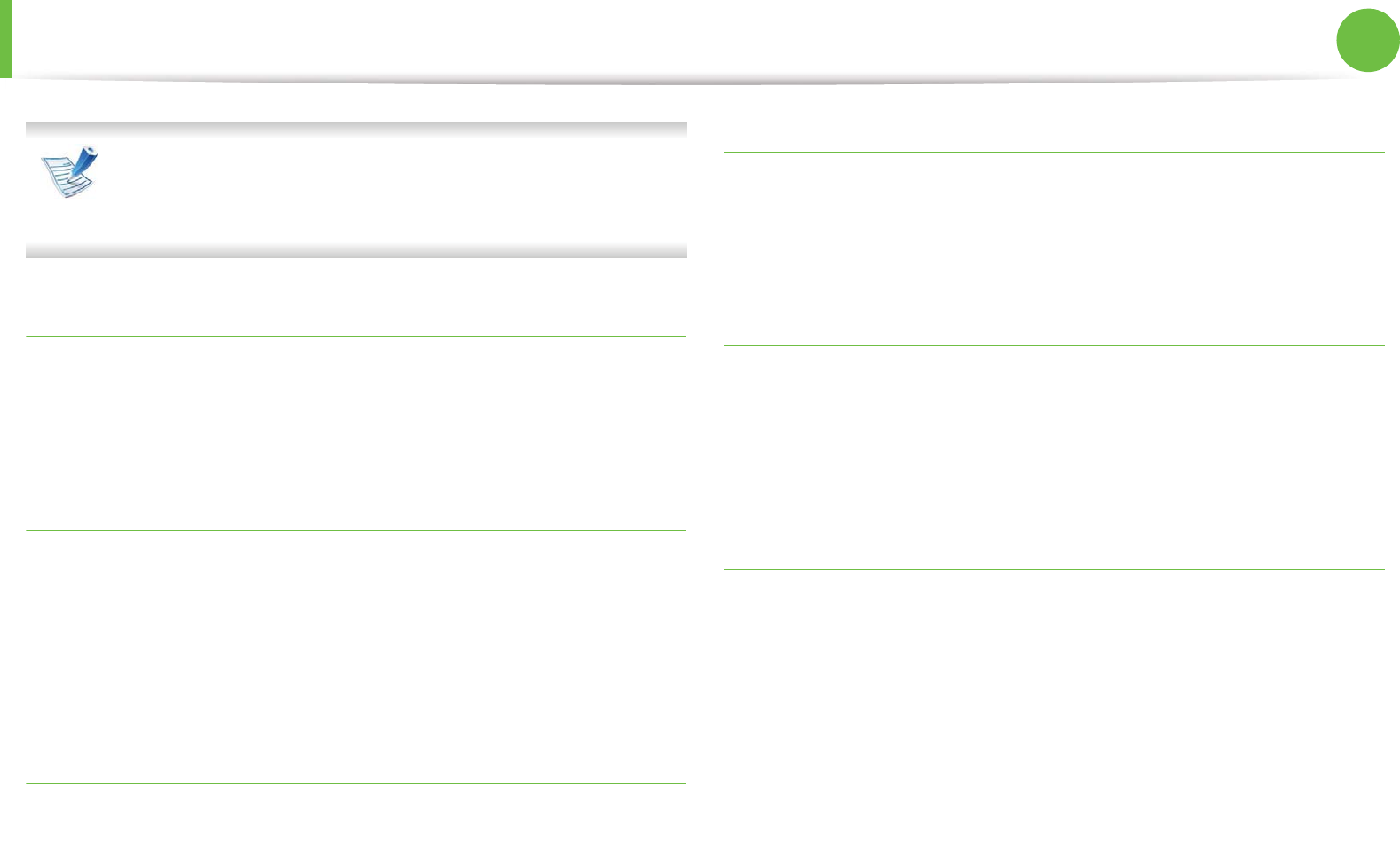
172
Glossary
The following glossary helps you get familiar with the
product by understanding the terminologies commonly
used with printing as well as mentioned in this user’s guide.
802.11
802.11 is a set of standards for wireless local area network (WLAN)
communication, developed by the IEEE LAN/MAN Standards
Committee (IEEE 802).
802.11b/g/n
802.11b/g/n can share same hardware and use the 2.4 GHz band.
802.11b supports bandwidth up to 11 Mbps, 802.11n supports
bandwidth up to 150 Mbps. 802.11b/g/n devices may occasionally
suffer interference from microwave ovens, cordless telephones, and
Bluetooth devices.
Access point
Access Point or Wireless Access Point (AP or WAP) is a device that
connects wireless communication devices together on wireless local
area networks (WLAN), and acts as a central transmitter and receiver
of WLAN radio signals.
ADF
An Automatic Document Feeder (ADF) is a scanning unit that will
automatically feed an original sheet of paper so that the machine
can scan some amount of the paper at once.
AppleTalk
AppleTalk is a proprietary suite of protocols developed by Apple, Inc
for computer networking. It was included in the original Macintosh
(1984) and is now deprecated by Apple in favor of TCP/IP
networking.
BIT Depth
A computer graphics term describing the number of bits used to
represent the color of a single pixel in a bitmapped image. Higher
color depth gives a broader range of distinct colors. As the number
of bits increases, the number of possible colors becomes
impractically large for a color map. 1-bit color is commonly called as
monochrome or black and white.
BMP
A bitmapped graphics format used internally by the Microsoft
Windows graphics subsystem (GDI), and used commonly as a simple
graphics file format on that platform.

Glossary 173
BOOTP
Bootstrap Protocol. A network protocol used by a network client to
obtain its IP address automatically. This is usually done in the
bootstrap process of computers or operating systems running on
them. The BOOTP servers assign the IP address from a pool of
addresses to each client. BOOTP enables 'diskless workstation'
computers to obtain an IP address prior to loading any advanced
operating system.
CCD
Charge Coupled Device (CCD) is a hardware which enables the scan
job. CCD Locking mechanism is also used to hold the CCD module to
prevent any damage when you move the machine.
Collation
Collation is a process of printing a multiple-copy job in sets. When
collation is selected, the device prints an entire set before printing
additional copies.
Control Panel
A control panel is a flat, typically vertical, area where control or
monitoring instruments are displayed. They are typically found in
front of the machine.
Coverage
It is the printing term used for a toner usage measurement on
printing. For example, 5% coverage means that an A4 sided paper
has about 5% image or text on it. So, if the paper or original has
complicated images or lots of text on it, the coverage will be higher
and at the same time, a toner usage will be as much as the coverage.
CSV
Comma Separated Values (CSV). A type of file format, CSV is used to
exchange data between disparate applications. The file format, as it
is used in Microsoft Excel, has become a de facto standard
throughout the industry, even among non-Microsoft platforms.
DADF
A Duplex Automatic Document Feeder (DADF) is a scanning unit that
will automatically feed and turn over an original sheet of paper so
that the machine can scan on both sides of the paper.
Default
The value or setting that is in effect when taking a printer out of its
box state, reset, or initialized.

Glossary 174
DHCP
A Dynamic Host Configuration Protocol (DHCP) is a client-server
networking protocol. A DHCP server provides configuration
parameters specific to the DHCP client host requesting, generally,
information required by the client host to participate on an IP
network. DHCP also provides a mechanism for allocation of IP
addresses to client hosts.
DIMM
Dual Inline Memory Module (DIMM), a small circuit board that holds
memory. DIMM stores all the data within the machine like printing
data, received fax data.
DLNA
The Digital Living Network Alliance (DLNA) is a standard that allows
devices on a home network to share information with each other
across the network.
DNS
The Domain Name Server (DNS) is a system that stores information
associated with domain names in a distributed database on
networks, such as the Internet.
Dot Matrix Printer
A dot matrix printer refers to a type of computer printer with a print
head that runs back and forth on the page and prints by impact,
striking an ink-soaked cloth ribbon against the paper, much like a
typewriter.
DPI
Dots Per Inch (DPI) is a measurement of resolution that is used for
scanning and printing. Generally, higher DPI results in a higher
resolution, more visible detail in the image, and a larger file size.
DRPD
Distinctive Ring Pattern Detection. Distinctive Ring is a telephone
company service which enables a user to use a single telephone line
to answer several different telephone numbers.
Duplex
A mechanism that will automatically turn over a sheet of paper so
that the machine can print (or scan) on both sides of the paper. A
printer equipped with a Duplex Unit can print on both sides of paper
during one print cycle.

Glossary 175
Duty Cycle
Duty cycle is the page quantity which does not affect printer
performance for a month. Generally the printer has the lifespan
limitation such as pages per year. The lifespan means the average
capacity of print-outs, usually within the warranty period. For
example, if the duty cycle is 48,000 pages per month assuming 20
working days, a printer limits 2,400 pages a day.
ECM
Error Correction Mode (ECM) is an optional transmission mode built
into Class 1 fax machines or fax modems. It automatically detects
and corrects errors in the fax transmission process that are
sometimes caused by telephone line noise.
Emulation
Emulation is a technique of one machine obtaining the same results
as another.
An emulator duplicates the functions of one system with a different
system, so that the second system behaves like the first system.
Emulation focuses on exact reproduction of external behavior,
which is in contrast to simulation, which concerns an abstract model
of the system being simulated, often considering its internal state.
Ethernet
Ethernet is a frame-based computer networking technology for local
area networks (LANs). It defines wiring and signaling for the physical
layer, and frame formats and protocols for the media access control
(MAC)/data link layer of the OSI model. Ethernet is mostly
standardized as IEEE 802.3. It has become the most widespread LAN
technology in use during the 1990s to the present.
EtherTalk
A suite of protocols developed by Apple Computer for computer
networking. It was included in the original Macintosh (1984) and is
now deprecated by Apple in favor of TCP/IP networking.
FDI
Foreign Device Interface (FDI) is a card installed inside the machine
to allow a third party device such as a coin operated device or a card
reader. Those devices allow the pay-for-print service on your
machine.
FTP
A File Transfer Protocol (FTP) is a commonly used protocol for
exchanging files over any network that supports the TCP/IP protocol
(such as the Internet or an intranet).

Glossary 176
Fuser Unit
The part of a laser printer that fuses the toner onto the print media.
It consists of a heat roller and a pressure roller. After toner is
transferred onto the paper, the fuser unit applies heat and pressure
to ensure that the toner stays on the paper permanently, which is
why paper is warm when it comes out of a laser printer.
Gateway
A connection between computer networks, or between a computer
network and a telephone line. It is very popular, as it is a computer or
a network that allows access to another computer or network.
Grayscale
A shades of gray that represent light and dark portions of an image
when color images are converted to grayscale; colors are
represented by various shades of gray.
Halftone
An image type that simulates grayscale by varying the number of
dots. Highly colored areas consist of a large number of dots, while
lighter areas consist of a smaller number of dots.
HDD
Hard Disk Drive (HDD), commonly referred to as a hard drive or hard
disk, is a non-volatile storage device which stores digitally-encoded
data on rapidly rotating platters with magnetic surfaces.
IEEE
The Institute of Electrical and Electronics Engineers (IEEE) is an
international non-profit, professional organization for the
advancement of technology related to electricity.
IEEE 1284
The 1284 parallel port standard was developed by the Institute of
Electrical and Electronics Engineers (IEEE). The term "1284-B" refers
to a specific connector type on the end of the parallel cable that
attaches to the peripheral (for example, a printer).
Intranet
A private network that uses Internet Protocols, network connectivity,
and possibly the public telecommunication system to securely share
part of an organization's information or operations with its
employees. Sometimes the term refers only to the most visible
service, the internal website.

Glossary 177
IP address
An Internet Protocol (IP) address is a unique number that devices use
in order to identify and communicate with each other on a network
utilizing the Internet Protocol standard.
IPM
The Images Per Minute (IPM) is a way of measuring the speed of a
printer. An IPM rate indicates the number of single-sided sheets a
printer can complete within one minute.
IPP
The Internet Printing Protocol (IPP) defines a standard protocol for
printing as well as managing print jobs, media size, resolution, and
so forth. IPP can be used locally or over the Internet to hundreds of
printers, and also supports access control, authentication, and
encryption, making it a much more capable and secure printing
solution than older ones.
IPX/SPX
IPX/SPX stands for Internet Packet Exchange/Sequenced Packet
Exchange. It is a networking protocol used by the Novell NetWare
operating systems. IPX and SPX both provide connection services
similar to TCP/IP, with the IPX protocol having similarities to IP, and
SPX having similarities to TCP. IPX/SPX was primarily designed for
local area networks (LANs), and is a very efficient protocol for this
purpose (typically its performance exceeds that of TCP/IP on a LAN).
ISO
The International Organization for Standardization (ISO) is an
international standard-setting body composed of representatives
from national standards bodies. It produces world-wide industrial
and commercial standards.
ITU-T
The International Telecommunication Union is an international
organization established to standardize and regulate international
radio and telecommunications. Its main tasks include
standardization, allocation of the radio spectrum, and organizing
interconnection arrangements between different countries to allow
international phone calls. A -T out of ITU-T indicates
telecommunication.

Glossary 178
ITU-T No. 1 chart
Standardized test chart published by ITU-T for document facsimile
transmissions.
JBIG
Joint Bi-level Image Experts Group (JBIG) is an image compression
standard with no loss of accuracy or quality, which was designed for
compression of binary images, particularly for faxes, but can also be
used on other images.
JPEG
Joint Photographic Experts Group (JPEG) is a most commonly used
standard method of lossy compression for photographic images. It is
the format used for storing and transmitting photographs on the
World Wide Web.
LDAP
The Lightweight Directory Access Protocol (LDAP) is a networking
protocol for querying and modifying directory services running over
TCP/IP.
LED
A Light-Emitting Diode (LED) is a semiconductor device that
indicates the status of a machine.
MAC address
Media Access Control (MAC) address is a unique identifier associated
with a network adapter. MAC address is a unique 48-bit identifier
usually written as 12 hexadecimal characters grouped in pairs (e. g.,
00-00-0c-34-11-4e). This address is usually hard-coded into a
Network Interface Card (NIC) by its manufacturer, and used as an aid
for routers trying to locate machines on large networks.
MFP
Multi Function Peripheral (MFP) is an office machine that includes
the following functionality in one physical body, so as to have a
printer, a copier, a fax, a scanner and etc.

Glossary 179
MH
Modified Huffman (MH) is a compression method for decreasing the
amount of data that needs to be transmitted between the fax
machines to transfer the image recommended by ITU-T T.4. MH is a
codebook-based run-length encoding scheme optimized to
efficiently compress white space. As most faxes consist mostly of
white space, this minimizes the transmission time of most faxes.
MMR
Modified Modified READ (MMR) is a compression method
recommended by ITU-T T.6.
Modem
A device that modulates a carrier signal to encode digital
information, and also demodulates such a carrier signal to decode
transmitted information.
MR
Modified Read (MR) is a compression method recommended by ITU-
T T.4. MR encodes the first scanned line using MH. The next line is
compared to the first, the differences determined, and then the
differences are encoded and transmitted.
NetWare
A network operating system developed by Novell, Inc. It initially used
cooperative multitasking to run various services on a PC, and the
network protocols were based on the archetypal Xerox XNS stack.
Today NetWare supports TCP/IP as well as IPX/SPX.
OPC
Organic Photo Conductor (OPC) is a mechanism that makes a virtual
image for print using a laser beam emitted from a laser printer, and
it is usually green or rust colored and has a cylinder shape.
An imaging unit containing a drum slowly wears the drum surface by
its usage in the printer, and it should be replaced appropriately since
it gets worn from contact with the cartridge development brush,
cleaning mechanism, and paper.
Originals
The first example of something, such as a document, photograph or
text, etc, which is copied, reproduced or translated to produce
others, but which is not itself copied or derived from something else.

Glossary 180
OSI
Open Systems Interconnection (OSI) is a model developed by the
International Organization for Standardization (ISO) for
communications. OSI offers a standard, modular approach to
network design that divides the required set of complex functions
into manageable, self-contained, functional layers. The layers are,
from top to bottom, Application, Presentation, Session, Transport,
Network, Data Link and Physical.
PABX
A private automatic branch exchange (PABX) is an automatic
telephone switching system within a private enterprise.
PCL
Printer Command Language (PCL) is a Page Description Language
(PDL) developed by HP as a printer protocol and has become an
industry standard. Originally developed for early inkjet printers, PCL
has been released in varying levels for thermal, dot matrix printer,
and laser printers.
PDF
Portable Document Format (PDF) is a proprietary file format
developed by Adobe Systems for representing two dimensional
documents in a device independent and resolution independent
format.
PostScript
PostScript (PS) is a page description language and programming
language used primarily in the electronic and desktop publishing
areas. - that is run in an interpreter to generate an image.
Printer Driver
A program used to send commands and transfer data from the
computer to the printer.
Print Media
The media like paper, envelopes, labels, and transparencies which
can be used in a printer, a scanner, a fax or, a copier.

Glossary 181
PPM
Pages Per Minute (PPM) is a method of measurement for
determining how fast a printer works, meaning the number of pages
a printer can produce in one minute.
PRN file
An interface for a device driver, this allows software to interact with
the device driver using standard input/output system calls, which
simplifies many tasks.
Protocol
A convention or standard that controls or enables the connection,
communication, and data transfer between two computing
endpoints.
PS
See PostScript.
PSTN
The Public-Switched Telephone Network (PSTN) is the network of
the world's public circuit-switched telephone networks which, on
industrial premises, is usually routed through the switchboard.
RADIUS
Remote Authentication Dial In User Service (RADIUS) is a protocol for
remote user authentication and accounting. RADIUS enables
centralized management of authentication data such as usernames
and passwords using an AAA (authentication, authorization, and
accounting) concept to manage network access.
Resolution
The sharpness of an image, measured in Dots Per Inch (DPI). The
higher the dpi, the greater the resolution.
SMB
Server Message Block (SMB) is a network protocol mainly applied to
share files, printers, serial ports, and miscellaneous communications
between nodes on a network. It also provides an authenticated Inter-
process communication mechanism.

Glossary 182
SMTP
Simple Mail Transfer Protocol (SMTP) is the standard for e-mail
transmissions across the Internet. SMTP is a relatively simple, text-
based protocol, where one or more recipients of a message are
specified, and then the message text is transferred. It is a client-
server protocol, where the client transmits an email message to the
server.
SSID
Service Set Identifier (SSID) is a name of a wireless local area network
(WLAN). All wireless devices in a WLAN use the same SSID in order to
communicate with each other. The SSIDs are case-sensitive and have
a maximum length of 32 characters.
Subnet Mask
The subnet mask is used in conjunction with the network address to
determine which part of the address is the network address and
which part is the host address.
TCP/IP
The Transmission Control Protocol (TCP) and the Internet Protocol
(IP); the set of communications protocols that implement the
protocol stack on which the Internet and most commercial networks
run.
TCR
Transmission Confirmation Report (TCR) provides details of each
transmission such as job status, transmission result and number of
pages sent. This report can be set to print after each job or only after
failed transmissions.
TIFF
Tagged Image File Format (TIFF) is a variable-resolution bitmapped
image format. TIFF describes image data that typically come from
scanners. TIFF images make use of tags, keywords defining the
characteristics of the image that is included in the file. This flexible
and platform-independent format can be used for pictures that have
been made by various image processing applications.

Glossary 183
Toner Cartridge
A kind of bottle or container used in a machine like a printer which
contains toner. Toner is a powder used in laser printers and
photocopiers, which forms the text and images on the printed paper.
Toner can be fused by by a combination of heat/pressure from the
fuser, causing it to bind to the fibers in the paper.
TWAIN
An industry standard for scanners and software. By using a TWAIN-
compliant scanner with a TWAIN-compliant program, a scan can be
initiated from within the program. It is an image capture API for
Microsoft Windows and Apple Macintosh operating systems.
UNC Path
Uniform Naming Convention (UNC) is a standard way to access
network shares in Window NT and other Microsoft products. The
format of a UNC path is: \\<servername>\<sharename>\<Additional
directory>
URL
Uniform Resource Locator (URL) is the global address of documents
and resources on the Internet. The first part of the address indicates
what protocol to use, the second part specifies the IP address or the
domain name where the resource is located.
USB
Universal Serial Bus (USB) is a standard that was developed by the
USB Implementers Forum, Inc., to connect computers and
peripherals. Unlike the parallel port, USB is designed to concurrently
connect a single computer USB port to multiple peripherals.
Watermark
A watermark is a recognizable image or pattern in paper that
appears lighter when viewed by transmitted light. Watermarks were
first introduced in Bologna, Italy in 1282; they have been used by
papermakers to identify their product, and also on postage stamps,
currency, and other government documents to discourage
counterfeiting.

Glossary 184
WEP
Wired Equivalent Privacy (WEP) is a security protocol specified in IEEE
802.11 to provide the same level of security as that of a wired LAN.
WEP provides security by encrypting data over radio so that it is
protected as it is transmitted from one end point to another.
WIA
Windows Imaging Architecture (WIA) is an imaging architecture that
is originally introduced in Windows Me and Windows XP. A scan can
be initiated from within these operating systems by using a WIA-
compliant scanner.
WPA
Wi-Fi Protected Access (WPA) is a class of systems to secure wireless
(Wi-Fi) computer networks, which was created to improve upon the
security features of WEP.
WPA-PSK
WPA-PSK (WPA Pre-Shared Key) is special mode of WPA for small
business or home users. A shared key, or password, is configured in
the wireless access point (WAP) and any wireless laptop or desktop
devices. WPA-PSK generates a unique key for each session between
a wireless client and the associated WAP for more advanced security.
WPS
The Wi-Fi Protected Setup (WPS) is a standard for establishing a
wireless home network. If your wireless access point supports WPS,
you can configure the wireless network connection easily without a
computer.
XPS
XML Paper Specification (XPS) is a specification for a Page
Description Language (PDL) and a new document format, which has
benefits for portable document and electronic document,
developed by Microsoft. It is an XML-based specification, based on a
new print path and a vector-based device-independent document
format.
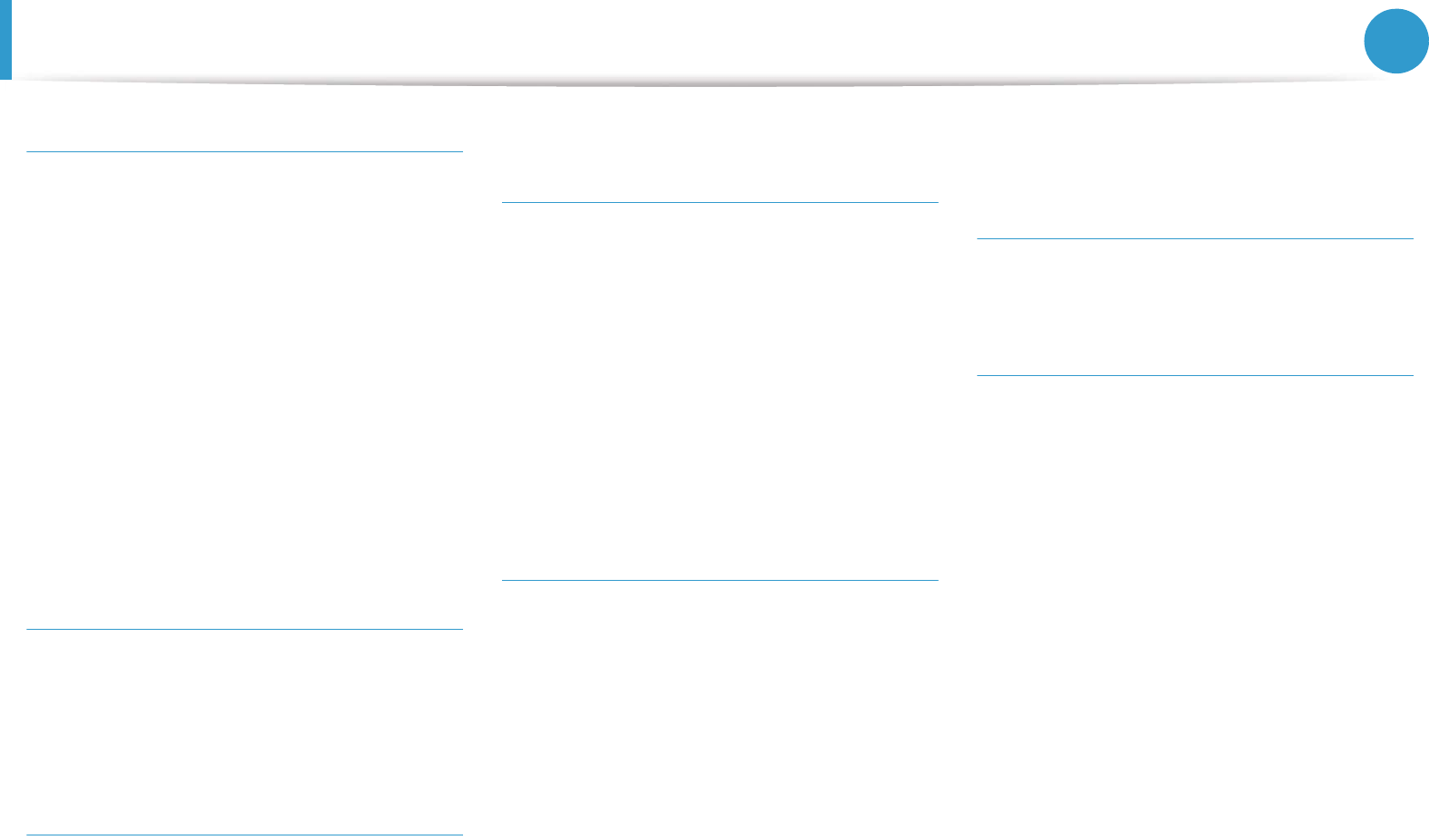
185
Index
A
address book
editingG91
general setupG80
group editingG92
group registeringG91
registeringG90
usingG90
address book setupG90
administrator’s setupG82
AnyWeb PrintG129
authorized users
registeringG93
C
ChangingG86
copy
general setupG61
custom setupG83
D
direct printing utilityG103
document boxG80
general setupG80
driver installation
UnixG25
E
email
general setupG79
email addressG87
searchingG87
storingG87
emulation
general setupG79
Emulation setupG79
entering characterG89
F
fax
automatic redialingG111
general setupG66
receiving in Answering Machine modeG111
receiving in DRPD modeG112
receiving in Fax modeG111
receiving in secure modeG113
receiving in Tel modeG111
receiving with ext. telephoneG112
redialing the last numberG111
fax featureG111
features
machine featuresG59
font settingG86
G
general settingsG71
glossaryG172
L
LCD display
browsing the machine statusG61SG65SG66SG69SG
75
Linux
common Linux problemsG164
driver installation for network connectedG23
driver installation for USB cable connectedG
8
driver reinstallation for USB cable connectedG
10
printer propertiesG108
printingG106
scanningG121
unifled driver configuratorG139
using SetIPG15
Linux scanningG121
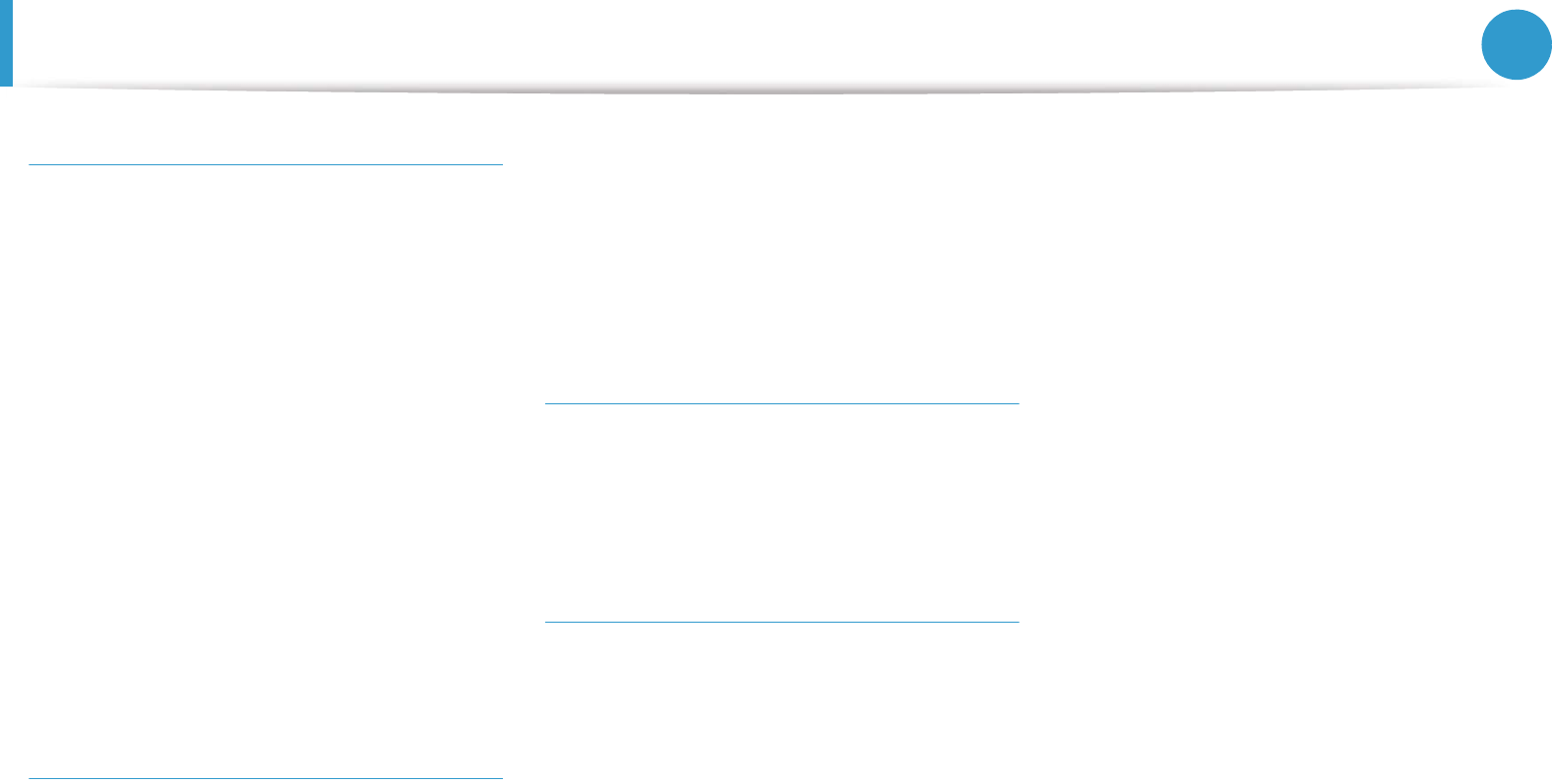
Index 186
M
machine informationG61SG65SG66SG69SG75
machine setup
machine statusG61SG65SG66SG69SG75
Macintosh
common Macintosh problemsG163
driver installation for network connectedG22
driver installation for USB cable connectedG
5
driver reinstallation for USB cable connectedG
7
printingG104
scanningG119
using SetIPG14
Macintosh scanningG119
memory/hard drive featureG123SG124
N
network
driver installation
LinuxG23
MacintoshG22
UNIXG25
WindowsG17
general setupG80
introducing network programsG12
IPv6 configurationG28
SetIP programG13SG14SG15SG53
wired network setupG13
wireless network setupG31
N-up printing
MacintoshG105
O
overlay printing
createG100
deleteG101
printG101
P
placing a machine
adjusting the altitudeG85
PostScript driver
troubleshootingG167
print
general setupG60
Print MenuG60
print resolution set
LinuxG107
printer preferences
LinuxG108
Printer Status
general informationG136SG137
printing
changing the default print settingsG94
LinuxG106
MacintoshG104
multiple pages on one sheet of paper
MacintoshG105
printing on both sides of paper
MacintoshG105
printing to a fileG95
setting as a default machineG94
special printer featuresG95
UNIXG108
using direct printing utilityG103
printing a document
LinuxG106
MacintoshG104
UNIXG108
printing featureG94
problem
operating system problemsG162
problems
copying problemsG157
faxing problemsG160
paper feeding problemsG143

Index 187
power problemsG144
printing problemsG145
printing quality problemsG149
scanning problemsG158
R
reports
machine informationG61SG66SG67SG68SG70SG71SG
72SG75SG76
S
Samsung Printer StatusG136
scan
general setupG69
Scan AssitantG117
scan featureG114
Scanning
Scanning with Samsung Scan AssitantG117
Scanning with SmarThru 4G118
scanning
Linux scanningG121
Macintosh scanningG119
Scanning from image editing programG116
Scanning from network connected machineG
114
Scanning to emailG114
Scanning to FTP/SMB serverG115
Scanning using the WIA driverG117
Scanning with SmarThru OfficeG119
service contact numbersG168
SetIP programG13SG53
SmarThru 4G118
SmarThru OfficeG119
Special featuresG84
StoringG87
supplies
estimated toner cartridge lifeG127
SyncThru Web Service
general informationG130
SyncThru™ Web ServiceG130
T
toner cartridge
estimated lifeG127
handling instructionsG126
non-Samsung and refilledG126
storingG126
U
UNIX
driver installation for network connectedG25
printingG108
usbG79
general setupusbG79
USB cable
driver installationG5SG8
driver reinstallationG7SG10
using helpG106
W
watermark
createG99
deleteG99
editG99
Windows
common Windows problemsG162
driver installation for network connectedG17
using SetIPG13SG53
wireless
ad hoc modeG31
computerG31
control panelG31
Infrastructure modeG31
installationG31
USB cableG38
WPS
disconnectiongG34

Index 188
PBC modeG33
WPS (the machine does not have a display
screen)
PBCG34
PING35
wireless network
network cableG52